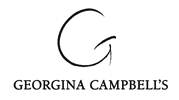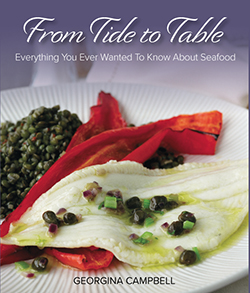Article AN IRISH CHEF IN FRANCE
An Irish Chef in France
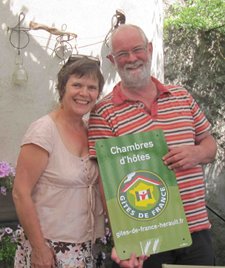
 Euro-Toques chef Martin Dwyer, much missed in Ireland since he and his wife Sile sold their eponymous restaurant in Waterford and moved to France, begins a fascinating column about their new life in the Languedoc
Euro-Toques chef Martin Dwyer, much missed in Ireland since he and his wife Sile sold their eponymous restaurant in Waterford and moved to France, begins a fascinating column about their new life in the Languedoc
Whenever we went to France on holidays there were two books which we always consulted. For eating we always checked with the Michelin Red Guide, not so much to eat in restaurants with Stars - normally much too expensive for us - but to find the more inexpensive options indicated by the symbol of two coins or, on special occasions, to eat at restaurants which had the Bib Gourmand symbol, which indicated a good quality restaurant, but moderately priced.
For our overnight stays there was no doubt that our bible was the Guide de Gites de France this organisation was the one which governed the standards in Bed and Breakfast establishments (Chambres d'Hôtes) and we never stayed in an establishment which was in that guide which fell below par.
But let me explain about the French concept of a Chambre d’Hôte; Chambres d’Hotes which serve evening meals become, officially, Tables d’Hôtes or Maisons d’Hôtes and this category of hospitality carry some traditions which make it different from the Irish B&B or Guest House.
The Table d’Hôte is a long standing tradition in France and long precedes the concept of a restaurant. In a Table d’Hôte the hosts eat dinner with the guests, everyone at the same table, and the price must be Compris – that is including all drinks. Profits from this are subject to taxation in the normal way but are not subject to VAT and the kitchen is not inspected by the health inspector - presumably on the sensible notion that you are eating the same food as the guests. We are however subject to a Taxe de Sejour of 50 cent per client which is paid directly to the local tourist office.
This year we felt confident enough to apply ourselves to Gites de France for inclusion. In March, of this year, they arrived for the inspection. They warned us in advance that there would be quite a few of them, there were. There were the two inspectors from the Gites de France, there was also a member of the board of that organisation who owned and ran a Chambre d'Hôte, and there was a young apprentice. Accompanying this posse was the local tourism representative for the village and the lady who ran the local regional tourist office. (It's a big deal as you can see). The inspection took two hours and was extremely thorough.
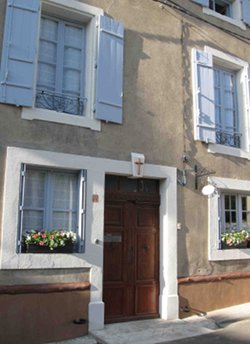 We had, we were warned, to have a full breakfast laid out for two on their arrival. We had set our table with freshly squeezed orange juice, compote of dried fruit and dates and bowl of vanilla and honey scented fromage frais. I produced my two homemade breads, little brown yeast rolls made with Howards Oneway (which I bring in specially) and my Pompe à l'Huile; a fruit and olive oil brioche, as well as the normal baguette and croissants from the village baker. With these I offered best Breton butter and five different jams, all faites maison. (Cherry, greengage, lemon with ginger and fig for the interested). Judging from their expressions they were impressed with this.
We had, we were warned, to have a full breakfast laid out for two on their arrival. We had set our table with freshly squeezed orange juice, compote of dried fruit and dates and bowl of vanilla and honey scented fromage frais. I produced my two homemade breads, little brown yeast rolls made with Howards Oneway (which I bring in specially) and my Pompe à l'Huile; a fruit and olive oil brioche, as well as the normal baguette and croissants from the village baker. With these I offered best Breton butter and five different jams, all faites maison. (Cherry, greengage, lemon with ginger and fig for the interested). Judging from their expressions they were impressed with this.
They then started on the bedrooms, all were measured as were the bathrooms, the beds were stripped and also measured, the quality of the sheets and indeed under sheets, and then the mattresses were minutely examined, as were the pillows and their covers, indeed even the under-covers of the pillows. Under the beds and on top of the wardrobes were carefully examined for dust, the very hangers in the wardrobes were inspected (They are all wooden, this is good, metal ones are not approved of).
They clucked disapprovingly at some things, the unevenness of some of our old floor tiles, the size of one of our wash hand basins, but mainly they seemed to approve, you could see they thought everything displayed proper taste and respect for the age of the house.
They had one outright demand, two of our bedrooms on the first floor at the front of the house needed safety guards as they were lower than regulation height and deemed unsafe for children. Then the eight of us sat down to coffee while they wrote out their reports.
These would then be put before the Board of Commissioners and, if we were fortunate enough to be accepted into this prestigious group, we would be sent all the necessary forms to fill in. We then waited for about six weeks for their judgement; it was a bit like waiting for the leaving cert results.
In the meantime we contacted a local artisan Ferronnier who made us a pair of beautiful wrought iron guards for the windows which looked as if they had been in situ for ever.
After about four weeks consideration we were telephoned by Madame, the Chief Inspector, who was delighted to tell us that we were accepted , she arrived chez nous the following day and made the formal presentation of the plaque.
So now we are properly a French Chambre d’Hôte – does it make a huge difference? The first plus was that the local correspondent for our daily paper, Le Midi-Libre did a little piece on us, and we have had quite a few enquiries from potential customers, but, I must confess the principal beneficiary is my own vanity; I get a terrific kick out of seeing the plaque on my wall!
-------------
Martin Dwyer started cooking professionally over 40 years ago in the legendary “Snaffles Restaurant” in Dublin. After a time in a Relais Chateau in Anjou and in “The Wife of Bath” in Kent he opened his own much acclaimed restaurant, “Dwyers”, in Waterford in 1989. In 2004 he sold this and moved south to France where he and his wife Síle bought and restored an old presbytery in a village in the Languedoc. They now run Le Presbytère as a French style Chambre d’Hôte. Martin however is far too passionate about food to give up cooking so they now enjoy serving dinner to their customers on the terrace of Le Presbytère on warm summer evenings. Martin runs occasional cookery courses in Le Presbytère and Síle’s brother Colm does week long Nature Strolls discovering the Flora and Fauna of the Languedoc.
Le Presbytère can be seen at: www.lepresbytere.net;
email: martin@lepresbytere.net
An Irish Chef in France
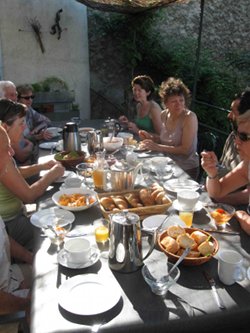
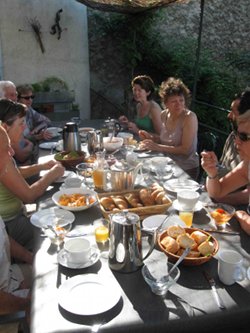 Euro-Toques chef Martin Dwyer, much missed in Ireland since he and his wife Sile sold their eponymous restaurant in Waterford and moved to France, describes how they came to find Le Presbytère, which became the centre of their new life in the Languedoc
Euro-Toques chef Martin Dwyer, much missed in Ireland since he and his wife Sile sold their eponymous restaurant in Waterford and moved to France, describes how they came to find Le Presbytère, which became the centre of their new life in the Languedoc
As a restaurateur in Ireland it often happened that a customer would shyly come up to one and confide that they “Always had an ambition to run a restaurant”. This was always a moment which required supreme tact. Without somehow giving the idea that one was a total martyr to the cause I always felt obliged to deliver the message that the restaurant business is not at all the glamorous one that people imagine. It requires large measures of stamina, tact, stoicism as well as the more expected flair for entertaining and genius in the kitchen.
It is a bit the same out here in France, everyone seems to have bought into the “Year in Provence” dream and to be confident that with a small down payment and a few hours absorbing the culture they will be sipping pastis in the local café with the locals - there is in fact rather more to it than that.
We had a couple of advantages starting out in our late career change out here. My trump card was without doubt my wife Sile. As a teenager she had gone on several exchanges to a family in Brittany and learned the language, she had afterwards done a degree in French and, just after our marriage in the early seventies, we had both worked together in a Relais Chateau in Anjou - where we had determined that at some stage in our lives we would return to work and live in France.
We never quite lost sight of this goal through all our years of restaurant life in Ireland. Holidays only ever happened in France and, despite appearances to the contrary, we always had half an eye on the area we were holidaying in, checking it out to see if it would one day be graced with our presence.
My language skills, while not equal to Sile’s are passable, my experiences in Anjou gave me good kitchen French and an ability to swear with a certain amount of fluency and, for the last 7 or 8 years before we actually retired I was a weekly attendee at my local Alliance Francais classes in Waterford.
To put it in a nutshell, moving to France is more about honing your language skills that anything else. Of course having spent many years of holidays/research we were far from decided where we would eventually end up so, the summer after we sold the restaurant, we moved to La Belle France for a whole six weeks determined to make the decision as to where we would settle.
Our preferred regions were, The Loire, Burgundy, The Auvergne and The Languedoc. Normandy and Brittany we had already ruled out because they didn’t have enough sun. The Dordogne was, we decided, too British, Provence was too expensive. So we spent a most pleasant six weeks researching.
Both The Loire and Burgundy turned to be also too far north to provide the standards of sun we demanded, so were reluctantly abandoned. The Auvergne, although very appealing and very French was, we felt too inaccessible for Irish clients for a chambre d’hote. This left us with the Languedoc.
As Sile was still teaching at this stage and I was extremely involved in being commissioner general of Euro-Toques we then abandoned the search until the following summer. The summer of 2006 found us in a campsite in Trebes, on the river Aude just outside the city of Carcassonne, preparing to spend the next six weeks searching for the dream home.
We had a list of boxes to tick, it had to have at least six bedrooms, be in the centre of a village, have a certain age (modern French houses are, we soon discovered, as charmless as their counterparts in Ireland) and have a garden capable of fitting a Piscine. It also had to be within a hundred kilometres of Carcassonne which has direct flights to Ireland - this to facilitate our guests and also ourselves on visits home to see our daughters and our grandsons.
We soon discovered that French Estate Agents did not listen to our demands and would show us wildly inappropriate properties which ticked none of our boxes. After a month of discouraging viewings we came across an estate agent in the village of St. Genies de Fontadet who seemed to be listening with some attention to our demands.
Charles had gone to college in England so spoke perfect English, I think that was the reason why we actually showed him our check list. Once he had seen this Charles gathered up all the papers of the properties he was going to show us and put all but two to one side.
“This one” he said holding up one paper, “I will show you for comparison only. This one” holding up the second “Is the one you will buy”. Then he brought us to the first one which seemed to tick the boxes but had no appeal to either of us. The second was in the village of Thezan Les Beziers, an old presbytery which had been unoccupied for several years. He brought us in, it was dark (the shutters being closed) and smelly.
“But this house” he said “has something not on your list which I think you will want after you have seen it”. He went down to the end of the old kitchen and threw open the shutters there. Behind was a large terrace and a garden with a huge tree, the doors faced due south so the sun streamed in and from the terrace there was a beautiful view down the valley of the Orb.
Charles was right, we had found our Chambre d’Hote.
-------------
Martin Dwyer started cooking professionally over 40 years ago in the legendary “Snaffles Restaurant” in Dublin. After a time in a Relais Chateau in Anjou and in “The Wife of Bath” in Kent he opened his own much acclaimed restaurant, “Dwyers”, in Waterford in 1989. In 2004 he sold this and moved south to France where he and his wife Síle bought and restored an old presbytery in a village in the Languedoc. They now run Le Presbytère as a French style Chambre d’Hôte. Martin however is far too passionate about food to give up cooking so they now enjoy serving dinner to their customers on the terrace of Le Presbytère on warm summer evenings. Martin runs occasional cookery courses in Le Presbytère and Síle’s brother Colm does week long Nature Strolls discovering the Flora and Fauna of the Languedoc.
Le Presbytère can be seen at: www.lepresbytere.net;
email: martin@lepresbytere.net
An Irish Chef in France
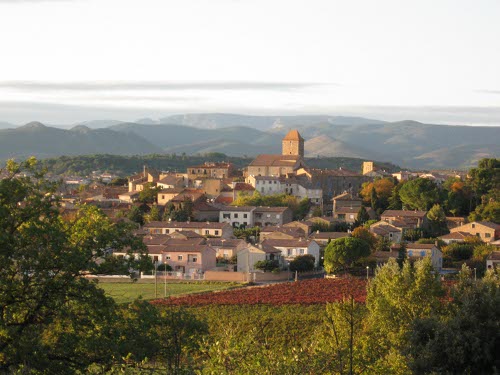
.jpg) Euro-Toques chef Martin Dwyer, much missed in Ireland since he and his wife Sile sold their eponymous restaurant in Waterford and moved to France, describes how they landed on their feet when they decided to live in the Languedoc
Euro-Toques chef Martin Dwyer, much missed in Ireland since he and his wife Sile sold their eponymous restaurant in Waterford and moved to France, describes how they landed on their feet when they decided to live in the Languedoc
We may well have settled on the Languedoc for practical reasons but soon realised that it is a very special area indeed. It has a unique climate; our village of Thezan les Beziers is about 15 kilometres from the beaches on the Mediterranean Sea to the south and about the same distance from the Monts d’Espinouse, which are the continuation of the Montagnes Noires, to the North.
These mountains are in fact the foothills of France’s great internal plateau, the Massif Central so we, in its shelter enjoy a mild Mediterranean climate, with the soft wind called Le Marin blowing from the South East and only occasional blasts from the Tramontane which carries colder winds from the Pyrenees.
The land is almost 100% given over to the production of wines, and, even though there are many wonderful vintages produced by small boutique vineyards, historically the great bulk of wines produced here were lowest common denominator: Vins de Pays. This has now placed the whole region at an advantage.
As these warhorse vines are being uprooted and replaced with modern named varieties Languedoc is heading the posse in France for producing varietal wines, as they do in the new world, and as the modern vine drinker expects. This is why they call Languedoc France’s new world wine producer. From a wine drinker’s point of view it means that the wines of the area are as yet (with a few exceptions) very competitively priced and it is not at all strange for us to be able to buy excellent wines En Vrac ( a bring your own bottle to the vineyard system) for as little as a Euro a litre.
As well as the exciting times which are happening on the wine front Languedoc has always had its own cuisine, quite distinct from its neighbours in Provence and Gascony.
Languedoc boasts its own large fishing port in Sete which has produced a great classic of French cuisine La Bourride, this dish certainly rivals and in my opinion is better and more refined than the Provençal Bouillabaisse.
Away from the sea the thrifty farmers of the Languedoc have come up with one of the most delicious of their peasant stews in the Cassoulet. This combines using the preserved Confit of duck or goose (a by-product, in fact, of the Foie Gras industry) with various discarded parts of the pig or lamb butchery, some local sausage and a hearty quantity of beans to stitch them all together.
Just to the south of us is the saltwater internal lake of the Etang de Thau which is awash with Mussel and Oyster farms, revered by the cognoscenti for the high salinity which makes them particularly prized.
The spring here is full of blossom, particularly Cherry, which thrives along the slopes of the mountains to the north but also we get early peaches and apricots and superb plums from up the road in Agen.
This is not a land of cheeses (although I do love a local fresh goat’s cheese, especially when eaten for breakfast with Honey and Walnuts) but it is not too far to Roquefort, arguably Frances premier Blue Cheese which is made from Sheep’s milk, or its close cousin, Blue d’Auvergne which is made from the milk of cows.
But having decided that this was the right place for us we also then had to determine that the people of Thezan thought we were the right people for them.
On our first year in Thezan Síle noticed that the village was looking for a posse of volunteers to spend a day cleaning up the village. Now this seemed to us an ideal opportunity for us to integrate and even ingratiate ourselves into village life. There were about 26 of us, of all ages and stations who gathered at the Mediatheque that morning and we were furnished with yellow jackets, protective gloves and long tweezers to pick up the rubbish, and black sacks to put it in.
It was a tough day’s work, and some of it fairly disgusting (France has fly-tippers too) but it had its rewards. One was we got to meet a whole heap of new people, all local and all delighted to welcome us in.
In the middle of the day we were given lunch and it was a very good one, aperitifs, terrine, couscous, grilled sausages and cheese and coffee. Plenty of wine was drunk by all, including the Mayor who joined us for lunch. Without doubt the best part of the day for the Dwyers was when the Mayor addressed us directly and said "Well, do you think you made the right decision to move to Thezan?" Síle made the perfect reply; "We are delighted, we love it here "
This was greeted with huge beams from everyone (including the Mayor) and a surprising round of applause. It seemed we had started to be part of the village...
-------------
 Martin Dwyer started cooking professionally over 40 years ago in the legendary “Snaffles Restaurant” in Dublin. After a time in a Relais Chateau in Anjou and in “The Wife of Bath” in Kent he opened his own much acclaimed restaurant, “Dwyers”, in Waterford in 1989. In 2004 he sold this and moved south to France where he and his wife Síle bought and restored an old presbytery in a village in the Languedoc. They now run Le Presbytère as a French style Chambre d’Hôte. Martin however is far too passionate about food to give up cooking so they now enjoy serving dinner to their customers on the terrace of Le Presbytère on warm summer evenings. Martin runs occasional cookery courses in Le Presbytère and Síle’s brother Colm does week long Nature Strolls discovering the Flora and Fauna of the Languedoc.
Martin Dwyer started cooking professionally over 40 years ago in the legendary “Snaffles Restaurant” in Dublin. After a time in a Relais Chateau in Anjou and in “The Wife of Bath” in Kent he opened his own much acclaimed restaurant, “Dwyers”, in Waterford in 1989. In 2004 he sold this and moved south to France where he and his wife Síle bought and restored an old presbytery in a village in the Languedoc. They now run Le Presbytère as a French style Chambre d’Hôte. Martin however is far too passionate about food to give up cooking so they now enjoy serving dinner to their customers on the terrace of Le Presbytère on warm summer evenings. Martin runs occasional cookery courses in Le Presbytère and Síle’s brother Colm does week long Nature Strolls discovering the Flora and Fauna of the Languedoc.
Le Presbytère can be seen at: www.lepresbytere.net;
email: martin@lepresbytere.net
An Irish Chef in France
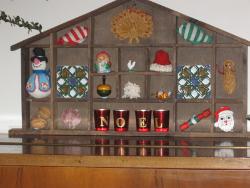
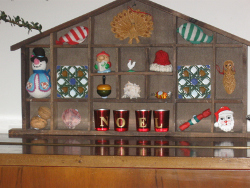 Euro-Toques chef Martin Dwyer, much missed in Ireland since he and his wife Sile sold their eponymous restaurant in Waterford and moved to France. They now live in the Languedoc, where they take guests - and feed them very well. This was their first Christmas in France...
Euro-Toques chef Martin Dwyer, much missed in Ireland since he and his wife Sile sold their eponymous restaurant in Waterford and moved to France. They now live in the Languedoc, where they take guests - and feed them very well. This was their first Christmas in France...
Even though we have been living full time out here for four or five years and spending a lot of time here before that, this turned out to be the first time we have spent Christmas out here, not just that but we persuaded the full family, daughters, sons in and out of law and the totally precious grandsons to come here for the holiday also.
Even though we haven’t been here for Christmas itself we have been here for the pre-Christmas shopping season for long enough to observe the gradual Americanisation of Christmas. The shops and department stores are piped with exactly the sort of music you would hear in Ireland, “Jingle Bells”, “Santa Claus is coming to town” etc.
However one thing which the French and I thoroughly agree on, is that Christmas is really about food. Their principal meal of Christmas is held on Christmas eve - traditionally after midnight mass and is a real shell fish affair, oysters, mussels prawns and lobsters finished off with the traditional Thirteen Desserts (not quite as intimidating as it sounds as many of the desserts are just different pieces of preserved fruits).
Being keen to keep a foot in both camps I decided to take the Irish solution to this problem and do a fish dinner on Christmas Eve and the full Irish, roast stuffed turkey, sprouts, cranberries and all the trimmings on Christmas day.
As we had decided to close the chambre d’hote for December we had more than enough time to get the house ready and to decorate it to within an inch of its life, and I also had time to cook shell and freeze some prawns and lobsters for the Christmas Eve feast and to order both a goose and a turkey from my butcher for the Day itself (the Turkey for Christmas day, the Goose for a few days after- a greedy Irishman’s solution to choice of Christmas fowl).
On the 23rd we had to collect both our Christmas turkey and goose from the butchers and our family from the airport in Carcassonne. So at 7.30 (this is France) down I headed:
The shop was en fete pour La Noel, where previously lurked the pork chops and lambs liver now were Ballotines and Galantines, Boned stuffed Pheasant, Pates en Croute, Foie Gras of every variety, Bouchees de La Reine, beautiful salads in Renaissance colours, and proudly Monsieur Boutonnière showed me this year’s speciality, tiny éclairs stuffed with Pate de Foi Gras.
I had to back my car to the door then to collect the boxes and when I got back to the shop they were all at the door ready to pack me into the car, and while other traffic waited patiently, hugs, handshakes and kisses were exchanged with cries of Bonnes Fetes and Joyeux Noel. I was beginning to feel a lot like Christmas in France!
Then we went to the airport in Carcassonne to collect our six visitors for the Christmas - we had hired an extra car for the occasion. Now Carcassonne airport is very small and the area next to the luggage turntable is immediately accessible to the outside - covered with warnings about how NO WAY one is allowed access.
But as always the minute the first person passes through we all crowd in to greet the arrivals. We can then see them through a window queuing up at the immigration counter. As soon as our lot rounded the corner we spotted them, they were holding the two small lads aloft and they spotted us, I could see (but not hear) them shrieking our names. Síle took one look at me "Don't you dare cry" she hissed. I tried hard not to.
And then they were through and Fionn the four year old leaped up on me and hugged.
My eye was caught by a French man just next to us staring unashamedly, a beatific beam on his face and his eyes full of tears.
It was a great Christmas.
-------------
 Martin Dwyer started cooking professionally over 40 years ago in the legendary “Snaffles Restaurant” in Dublin. After a time in a Relais Chateau in Anjou and in “The Wife of Bath” in Kent he opened his own much acclaimed restaurant, “Dwyers”, in Waterford in 1989. In 2004 he sold this and moved south to France where he and his wife Síle bought and restored an old presbytery in a village in the Languedoc. They now run Le Presbytère as a French style Chambre d’Hôte. Martin however is far too passionate about food to give up cooking so they now enjoy serving dinner to their customers on the terrace of Le Presbytère on warm summer evenings. Martin runs occasional cookery courses in Le Presbytère and Síle’s brother Colm does week long Nature Strolls discovering the Flora and Fauna of the Languedoc.
Martin Dwyer started cooking professionally over 40 years ago in the legendary “Snaffles Restaurant” in Dublin. After a time in a Relais Chateau in Anjou and in “The Wife of Bath” in Kent he opened his own much acclaimed restaurant, “Dwyers”, in Waterford in 1989. In 2004 he sold this and moved south to France where he and his wife Síle bought and restored an old presbytery in a village in the Languedoc. They now run Le Presbytère as a French style Chambre d’Hôte. Martin however is far too passionate about food to give up cooking so they now enjoy serving dinner to their customers on the terrace of Le Presbytère on warm summer evenings. Martin runs occasional cookery courses in Le Presbytère and Síle’s brother Colm does week long Nature Strolls discovering the Flora and Fauna of the Languedoc.
Le Presbytère can be seen at: www.lepresbytere.net;
email: martin@lepresbytere.net
An Irish Chef in France
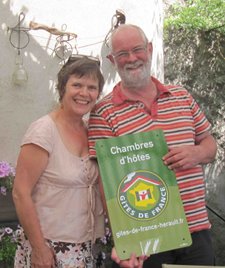
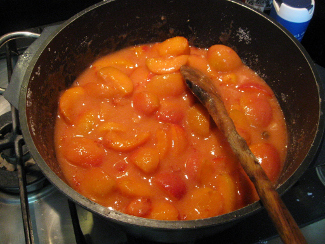 Euro-Toques chef Martin Dwyer, much missed in Ireland since he and his wife Sile sold their eponymous restaurant in Waterford and moved to France. They now live in the Languedoc, where they take guests - and feed them very well. Here’s his Day in the Life of a Maison d’Hote...
Euro-Toques chef Martin Dwyer, much missed in Ireland since he and his wife Sile sold their eponymous restaurant in Waterford and moved to France. They now live in the Languedoc, where they take guests - and feed them very well. Here’s his Day in the Life of a Maison d’Hote...
I suppose the best way to give you an idea of our new life is to give you a typical day in the life.
Morning sees us out of bed usually by about 7.30, this for a 9.00 breakfast. We had made the decision before we opened that our breakfast was going to be a French one.
Many years before on our way south on holiday we had stopped in a restaurant with rooms near Bourges which had a Michelin star. Our breakfast there had to us been perfection, we had been offered two kinds of fruit, fresh and cooked, some vanilla flavoured fromage frais to eat with it, and plenty of fresh bread, brioche and croissants to eat with our tea (for Sile) and coffee (for me) accompanied by a good range of home made jams and jellies.
A cooked breakfast, in the Irish tradition was something we decided would be both inappropriate and totally unsuitable to the climate. I make two different types of bread myself but we do realise that in integral part of the French breakfast experience is the fresh crisp baguette and croissant.
Therefore our first job each morning (we take this in turns) was to go down to the village baker for these. Then we set the table (usually on the terrace) with the fruits which are in season and my own jams (I am a compulsive jam maker so we always have at least 6 varieties on the go). In deference to our experience in the Michelin starred restaurant we also serve a bowl of vanilla flavoured fromage frais to eat with the fruit.
The French as a nation we found, even in hotels where we had eaten an excellent dinner, do not set a lot of store by breakfast. Somewhat to our surprise our French customers are often taken aback by the lavishness of our breakfast spread – “Ah you do breakfast in the English fashion “, an early French family said to us, and this without a rasher or sausage in sight.
My one concession to our background is that I usually manage to offer some homemade brown bread (I bring the flour in from Ireland) and always offer my own home made marmalade made from Bigarades (the French for a Seville orange) which we eventually tracked down in a village in Minerve.
Breakfast on the terrace, we discovered, is capable of becoming quite a social occasion and we have seen it stretch on to 11.00, a good two hours after the customers sat down first. It is just as well we decided early on that lunch was not going to be offered; else I would have found it difficult to ever get out of the kitchen.
 Usually after breakfast I shop for the day, we have a small market which runs two days in the village, a superb butcher, an excellent supermarket also in the village and just down the road is a large co-operative farm shop called La Ferme Bitteroise.
Usually after breakfast I shop for the day, we have a small market which runs two days in the village, a superb butcher, an excellent supermarket also in the village and just down the road is a large co-operative farm shop called La Ferme Bitteroise.
Shopping, as is nearly always the case in France is pain free. Normally I spend the rest of the morning preparing for the dinner while Sile is in charge of the bedrooms. The afternoon is our time off, this means we can choose to head to the coast for a swim, to the mountains for a stroll or a swim in the river or even have a few hours siesta.
Dinner starts on the terrace usually about 7.00 with an aperitif of some of the sparkling wine from Limoux, just south of us, this we usually flavour with some one of the excellent local liqueurs, blackcurrant cassis is the classic but Peche and even chestnut are my current favourites.
Before anyone arrives I will have asked them, as they make their booking, if there are any foods they have a problem with, either an allergy or a dislike. With this much information under my belt I can then always be sure that my customers will eat what I have prepared.
The dinner is not really in any way like one which one would eat in a restaurant. The service is altogether more relaxed and, of course as Sile and I eat (and indeed drink) with the customers the night always takes on the air of a dinner party rather than a restaurant meal.
As is the custom in Maison d’Hotes who serve evening meals the cost of the drinks are included in the costs of the meal. To our relief we have discovered that the more abstemious French customers do tend to compensate for the more profligate Irish.
The meal (after the cheese and dessert and coffee) usually finishes with one of my homemade liqueurs – the making of which is another passion of mine. Living in the centre of a French village, in very close proximity to our neighbours, means that we have (during the working week at any rate) to be careful of our neighbours sleep times so we have a self-imposed curfew for terrace entertainments of 11.00. (Mind you we can always withdraw into the living room and shut the doors) and considering the early start in the morning this is probably just as well - and also explains to some extent why we sometimes make use of that marvellous southern custom: the siesta.
-------------
 Martin Dwyer started cooking professionally over 40 years ago in the legendary “Snaffles Restaurant” in Dublin. After a time in a Relais Chateau in Anjou and in “The Wife of Bath” in Kent he opened his own much acclaimed restaurant, “Dwyers”, in Waterford in 1989. In 2004 he sold this and moved south to France where he and his wife Síle bought and restored an old presbytery in a village in the Languedoc. They now run Le Presbytère as a French style Chambre d’Hôte. Martin however is far too passionate about food to give up cooking so they now enjoy serving dinner to their customers on the terrace of Le Presbytère on warm summer evenings. Martin runs occasional cookery courses in Le Presbytère and Síle’s brother Colm does week long Nature Strolls discovering the Flora and Fauna of the Languedoc.
Martin Dwyer started cooking professionally over 40 years ago in the legendary “Snaffles Restaurant” in Dublin. After a time in a Relais Chateau in Anjou and in “The Wife of Bath” in Kent he opened his own much acclaimed restaurant, “Dwyers”, in Waterford in 1989. In 2004 he sold this and moved south to France where he and his wife Síle bought and restored an old presbytery in a village in the Languedoc. They now run Le Presbytère as a French style Chambre d’Hôte. Martin however is far too passionate about food to give up cooking so they now enjoy serving dinner to their customers on the terrace of Le Presbytère on warm summer evenings. Martin runs occasional cookery courses in Le Presbytère and Síle’s brother Colm does week long Nature Strolls discovering the Flora and Fauna of the Languedoc.
Le Presbytère can be seen at: www.lepresbytere.net;
email: martin@lepresbytere.net
An Irish Chef in France
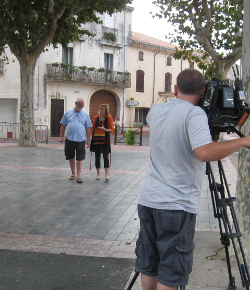
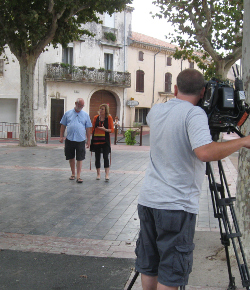
Le Presbytère was recently filmed by RTE Nationwide for a feature about the Irish in France. Post transmission (6/3/13) the programme can be viewed on RTE Player. Image shows Martin and Mary Kennedy being filmed on the square at Thezan.
This month Martin reflects on an essential difference between the way the Irish and the French behave: La Politesse
I think that the question most often asked of us by Irish people here on holidays is as to how well we fit in with the village and its people here in France. There is always a preconceived attitude that the French are both arrogant and unfriendly. We have not found that to be the case, but there are differences between how the French and the Irish behave. The French put great store in politeness.
Politeness is an essential oil for living in village France.
We live in the old part of the village and no-one there would dream of passing you in the street without a “Bonjour” or “Bonsoir”.
In the flat of the town, where the shops are, this is not so rigidly maintained, but never would a greeting go unanswered.
On entering a shop one always says “Bonjour Messieurs Dames” to all present and “Au revoir Messieurs Dames” as you go, having already politely thanked the shopkeeper for their kindness in serving you.
They have a greeting for all occasions, on our trips to campsites no-one passed, if one was eating, without saying “Bon Appetit” (and this included children.)
“Bonne Soirée” is “Have a good evening” and is used between 6.00 and 8.00 only.
“Bon Weekend” is used on Friday evenings.
A waitress, having wished one “Bon Appetit” before the first course will wish you “Bonne Continuation” as she serves the second.
As we pulled up in front of the house on one of our house moving visits and started to unpack a neighbour drove by and stuck his head out the window to wish us “Bon Installation” and inevitably as we pack to go we will be wished “Bon Retour”. (“Bon Retour” is interesting because it does not mean, as I thought, and was gently corrected by a neighbour, “Welcome back” but rather something more like “Safe Home”)
Such politeness is not, of course, easily learned.
Walking through the village if you see a parent or (more likely) a grandparent walking out with a toddler you say “Bonjour” to the adult and then another “Bonjour” (traditionally accompanied by an ingratiating smirk) to the child. Woe Betide the child who doesn’t give the appropriate response. The French have no shame in public displays of corporal punishment.
It is only recently that I am beginning to realise that this politesse can have its drawbacks. There is a polite rule in France that when you are dealing with one person (in a shop let us say) you do not acknowledge any other person.
Thus in the supermarket if one is next in line to the checkout and one should inadvertently catch the eye of the cashier one’s eyes glaze over and you do not smile, even though you know that the very second the previous customer has departed you will be greeted with a welcoming "Bon Jour".
Now in the supermarket situation this usually liveable with, but let us take another example.
Sometime ago we went down to the Mairie to pay for an advertisement we put in the village organ, Le Bassin. (a transaction which would take about one and a half minutes ). The lady ahead of us was taxing a mobilette for one of her children and had several long forms to fill out.
There was only one lady assistant behind the counter. Madame the mother was not the quickest and so she spent possibly fifteen minutes with her tongue firmly gripped between her teeth filling out this form while Madame behind the counter looked on politely and we fumed silently in the queue.
It would have been a total breach of politeness were the assistant to excuse herself from Madame and deal with us (as we would have done in Ireland) and so let us say if you see 10 people in front of you in a queue in the Mairie, or in the Post Office, or elsewhere you can anticipate that you will probably be waiting at least a half hour before you are served, with the Irish system the shop would be empty in ten minutes.
Now moving to a new country one always has to accept their way of doing things but here we have a situation which is rapidly driving our blood pressure through the roof.
Buying a stamp can take three days as one first checks and counts the queue in the post office before finding a window when the whole transaction might take only ten to fifteen minutes. I now consciously try to do my shopping in (one of the few) supermarkets which is open during lunchtime when the French don't ever shop and one is spared discovering that the lady in front of you in the queue is a sister to the cashier and they haven’t met (plainly) in ten years so they have a lot of catching up to do.
I once was in a supermarket in (French) Corsica where the ladies before me (an elderly lady and her ancient mother) had a trolley full of different brands of adult incontinence devices. The merits of all brands were eagerly discussed by all parties (and the rejected ones put back on the shelf by the younger) until a decision was made and a mere 25 minutes later I was permitted to pass my groceries through the till.
I really don't suppose I will ever manage to change this so I must learn to relax in queues, breathe deeply, write novels in my head and - above all- keep taking my blood- pressure tablets.
-------------
 Martin Dwyer started cooking professionally over 40 years ago in the legendary “Snaffles Restaurant” in Dublin. After a time in a Relais Chateau in Anjou and in “The Wife of Bath” in Kent he opened his own much acclaimed restaurant, “Dwyers”, in Waterford in 1989. In 2004 he sold this and moved south to France where he and his wife Síle bought and restored an old presbytery in a village in the Languedoc. They now run Le Presbytère as a French style Chambre d’Hôte. Martin however is far too passionate about food to give up cooking so they now enjoy serving dinner to their customers on the terrace of Le Presbytère on warm summer evenings. Martin runs occasional cookery courses in Le Presbytère and Síle’s brother Colm does week long Nature Strolls discovering the Flora and Fauna of the Languedoc.
Martin Dwyer started cooking professionally over 40 years ago in the legendary “Snaffles Restaurant” in Dublin. After a time in a Relais Chateau in Anjou and in “The Wife of Bath” in Kent he opened his own much acclaimed restaurant, “Dwyers”, in Waterford in 1989. In 2004 he sold this and moved south to France where he and his wife Síle bought and restored an old presbytery in a village in the Languedoc. They now run Le Presbytère as a French style Chambre d’Hôte. Martin however is far too passionate about food to give up cooking so they now enjoy serving dinner to their customers on the terrace of Le Presbytère on warm summer evenings. Martin runs occasional cookery courses in Le Presbytère and Síle’s brother Colm does week long Nature Strolls discovering the Flora and Fauna of the Languedoc.
Le Presbytère can be seen at: www.lepresbytere.net;
email: martin@lepresbytere.net
An Irish Chef in France
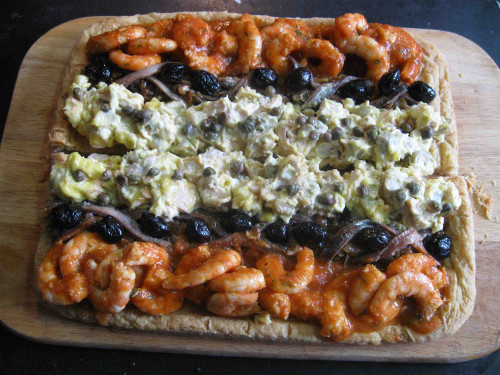
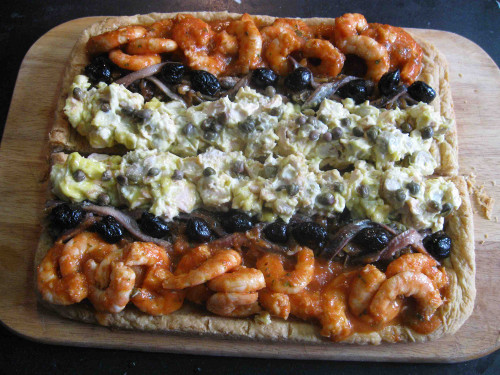 Euro-Toques chef Martin Dwyer, much missed in Ireland since he and his wife Sile sold their eponymous restaurant in Waterford and moved to France. They now live in the Languedoc, where they take guests - and feed them very well.
Euro-Toques chef Martin Dwyer, much missed in Ireland since he and his wife Sile sold their eponymous restaurant in Waterford and moved to France. They now live in the Languedoc, where they take guests - and feed them very well.
This month Martin shares a very special recipe with us: Tranche St Remy
Last year I had a special dinner on my terrace for twelve people and I decided I wanted to produce a killer starter. I had a memory of an extremely delicious hors d’oeuvre which we used to produce in The Wife of Bath in Kent where I worked in the seventies under chef Michael Waterfield.
I had a very strong feeling that it came from an original recipe by Elizabeth David, Michael Waterfield was as big a fan of hers as I was/am. (We actually fed her there once, on her way to a channel ferry, but that’s another story). I scoured her French Cookbook indices, French Provincial Cooking, French Country Cooking and Mediterranean Food but without a sign at all of Le Tranche St. Remy. I decided we would try and construct it from memory.
It was a large rectangular tart with three different fillings along its length, the base I remembered was puff pastry, one of the fillings was prawns in a tomato sauce, and one tuna (canned in ´70s England ) with green olives and the third, as served in The Wife of Bath, was Mushrooms, quickly fried in butter and mixed with Chicken liver paté. I thought that I could easily skip this last one which sounded too rich for the other fillings so I agreed to try it out just with the other two.
Convinced that I had found the recipe somewhere in Elizabeth David I took her to bed with me before I settled on the final version. (The internet had proved singularly useless, nothing at all came up under Tranche St Remy). But all was not lost. In French Provincial Cooking, under Hot Hors- d’Œuvres, and called Tartlettes À La Provençale, at last I found it.
Coming indeed from “the dusty sleepy town of St. Remy” wrote Mrs. David in 1960 (St. Remy is now a trendy lively tourist trap). “It consists of little open pastry cases with three different varieties of fillings: an onion and black olive mixture as described above (a recipe for Pissaladière ), one of mushrooms and tomatoes and a third with prawns and green olives.”
So we clearly had another scenario on our hands. All in all I think I preferred Michael Waterfield’s version of the dish but I now had a third filling from Mrs. David, the onion, and olive one, in through which I would certainly introduce some anchovies.
Having just a few weeks ago made myself a Salade Niçoise with fresh tuna instead of tinned, and very much enjoyed the result, I was determined to include this in the Tranche and decided to add a bit of zing to this mixture by adding green olives and capers.
For the base I decided to use my new found skill in making Rough Puff Pastry, a recipe I had pinched from Michel Roux on the internet but simplified by doing the rubbing in the food processor.
The end result was, I thought better than any commercial pastry I might buy.
La Tranche St Remy
This will give you enough for 12 as a generous starter, I don’t think I would go through all the palaver for less.
You will need a baking tray which will take a piece of pastry 25cm by 35cm (an old Swiss roll tin will do fine)
Pastry:
300g strong flour
300g cold butter diced into little cubes
good pinch salt
120ml ice cold water.
Filling One:
500g prawns cooked and peeled
2 med onions
500g ripe tomatoes
handful basil
teaspoon sugar
teaspoon vinegar
salt and pepper.
Filling Two:
500g fresh tuna
14 green olives (stoned)
1 tablespoon capers
175g mayonnaise (make your own if possible)
Filling Three:
400g peeled sliced onions
olive oil
12 anchovy fillets
12 stoned black olives.
First make the pastry:
Put the flour and the butter in the processor and process.
Check every few seconds, the pieces of butter should still be about the size of small peas.
Now add the water and whizz briefly to amalgamate.
Tip this mixture out on a floured board and pull together to bind. Do not knead or work.
Tip this into a plastic bag and chill for a half hour in the fridge..
Take out and roll into a piece roughly 25cm by 12 cm. Fold this into three and give it a quarter turn, roll again into a 25 by 12 rectangle and then fold in three again and chill in a bag in the fridge for 30 minutes.
Repeat this process after 30 minutes and then leave for another 30 minutes before using.
For the Tranche:
Roll this out to a piece 25 cm by 35 cm and bake blind (cover and weight down) at 175ºC, 350ºF , Gas 4 for about 20 to 30 minutes until brown and crisp.
Leave this cool on a rack.
Filling One:
Cook the Onion in a little olive oil in a covered pan until soft.
Add the tomatoes, sliced, and continue cooking until these melt.
Liquidise these (or push through a sieve) and season with salt, pepper, sugar and vinegar and the chopped basil.
Put this into a pot with the prawns, bring to a simmer, take off the heat and cool in the fridge.
Filling Two:
Take the tuna off the bone and skin. Cut into little dice. Heat some oil in a hot pan and sear the piece quickly on all sides. Cool in the fridge.
Mix these with the halved olives (I used some stoned Spanish ones which are stuffed with anchovies) the capers and the mayonnaise.
Filling Three:
Cook the sliced onions in some oil in a lidded pan on a gentle heat until very soft.
Now take off the lid and increase the heat until they go brown, do not let them burn.
Season these with salt and pepper and chill.
To assemble (about an hour before service):
Cut the cooked pastry piece into two long strips.
Down the middle of each strip put a line of the onion.
Cross the anchovies down this line and put black olives in the spaces.
Spoon the prawn mixture on one side and the tuna mixture on the other.
Serve in slices like a custard slice. A lotta work but very much worthwhile.
-------------
 Martin Dwyer started cooking professionally over 40 years ago in the legendary “Snaffles Restaurant” in Dublin. After a time in a Relais Chateau in Anjou and in “The Wife of Bath” in Kent he opened his own much acclaimed restaurant, “Dwyers”, in Waterford in 1989. In 2004 he sold this and moved south to France where he and his wife Síle bought and restored an old presbytery in a village in the Languedoc. They now run Le Presbytère as a French style Chambre d’Hôte. Martin however is far too passionate about food to give up cooking so they now enjoy serving dinner to their customers on the terrace of Le Presbytère on warm summer evenings. Martin runs occasional cookery courses in Le Presbytère and Síle’s brother Colm does week long Nature Strolls discovering the Flora and Fauna of the Languedoc.
Martin Dwyer started cooking professionally over 40 years ago in the legendary “Snaffles Restaurant” in Dublin. After a time in a Relais Chateau in Anjou and in “The Wife of Bath” in Kent he opened his own much acclaimed restaurant, “Dwyers”, in Waterford in 1989. In 2004 he sold this and moved south to France where he and his wife Síle bought and restored an old presbytery in a village in the Languedoc. They now run Le Presbytère as a French style Chambre d’Hôte. Martin however is far too passionate about food to give up cooking so they now enjoy serving dinner to their customers on the terrace of Le Presbytère on warm summer evenings. Martin runs occasional cookery courses in Le Presbytère and Síle’s brother Colm does week long Nature Strolls discovering the Flora and Fauna of the Languedoc.
Le Presbytère can be seen at: www.lepresbytere.net;
email: martin@lepresbytere.net
An Irish Chef in France
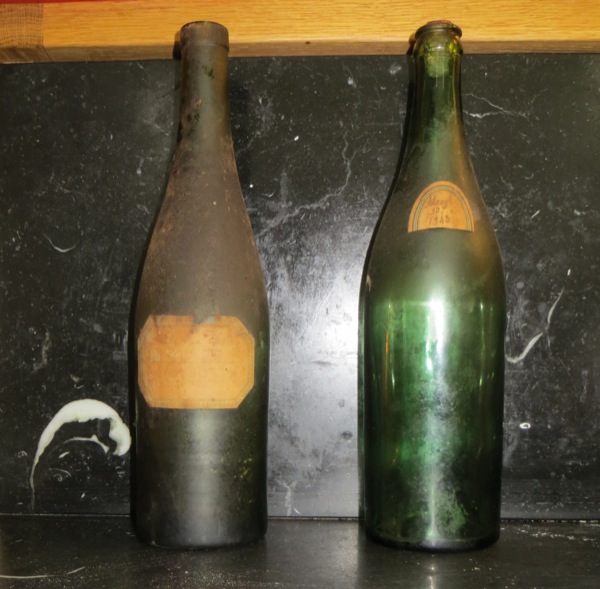
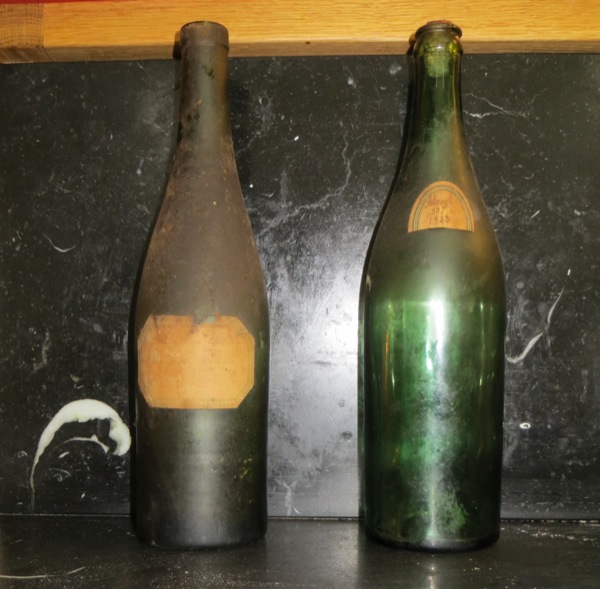
This month Martin shares a recipe for a very special drink with us: Vin de Noix
My love affair with Vin de Noix started about six summers ago here in Thezan when a couple with a house in the village, Patrick and Anne-Marie, who had befriended us, invited us to their house for apero's.
Their house had originally been a Maison de Vigneron for a vineyard belonging to her family so the original cave, now abandoned for many years lay untouched underneath. They showed us around this treasure trove and on one shelf I spotted a very dusty but still full bottle of (we thought) wine.
When we brought it out to the light of day we discovered it was a bottle of Vin de Noix with a date of 1895 still just about legible through the grime. The minute Patrick touched the cork with a corkscrew it dissolved into breadcrumbs so, he strained it through a muslin and we tasted it. It was totally delicious.
Like the generous Frenchman that he is he strained the nectar into two Perrier bottles, and gave us one and the original bottle (comme souvenir) as we were going. The Vin we brought back to Ireland with us and there, certain selected friends were allowed teaspoonfuls of this drink of the gods if they were particularly good. But, like all good things, it soon came to an end.
A few summers later Patrick and Anne-Marie again joined us for an Apero in Thezan. Patrick produced a bottle from a bag which he presented to me. It was labelled Eau de Vie, 90% , 1943. Patrick said he reckoned that it was being put aside to turn into some sort of Vin Spiritueux when the wine production stopped. He said (glancing at my stack of bottles of various home-made liqueurs) that I might manage to find a use for it. Er... em... Yes.
Now I continued to wonder for a long time what I should add to this spirit. It surely must be graced with a flavour of great quality to match the venerable age and indeed strength of the Eau de Vie.
We went on an outing to St. Guillhem le Desert about a month later.
There in the bookshop of the Cathedral I found a book of recipes for home-made liqueurs, and, while we ate crepes in the restaurant under the huge plane tree in the square, I came across a recipe for Vin de Noix.
But of course, the obvious solution was to use the alcohol as they probably originally intended and turn this relic of a former age into Vin de Noix. Fate obviously highly approved of this as, when we went back to the car park, what happened to be growing there but a walnut tree, covered by green under-ripe nuts. We helped ourselves to about 15.
The only rule that was mentioned about the Vin de Noix was that the green walnuts should be picked before St. John's Eve, so , as this was about ten days before, we reckoned all of the gods would be propitiated (we are after all practically in Catalan country where St John's Eve is celebrated with Bonfires on Mount Canigou).
Then I had merely to assemble all my ingredients, the following day, I had my alcohol and walnuts, bought my sugar and orange and selected which three litres of red wine I was going to honour with mixing with the holy Eau de Vie (I eventually gave the honour to our house Red, a St. Chinian from Roquebrun).
It got tasted for the first time a few weeks later (a little before its official 40 days were up it is true) it was indeed the finest nectar. It has since been sampled with great approval by Irish, American, Swiss and French Taste Buds.
Should you be lucky enough to find a walnut tree in Ireland I think you would still have a couple of week’s leeway.
For my Eau de Vie my best solution would be some cheap Vodka or Rum from the German supermarkets.
Here is the recipe I adapted, you could of course make it in smaller quantities (but you may end up regretting it)
Vin de Noix
3 litres Bon Vin Rouge
15 (or so) Green Walnuts
1 Orange
1 kg. Sugar
75 cl Eau de Vie (Vodka or some other spirit)
The story here is that the walnuts for Vin de Noix should be picked before St John’s Eve (June 23rd) but I reckon in Irish terms that gives you another fortnight.
Crush coarsely the whole walnuts in a pestle and mortar. (Or bash in a solid bowl with the end of a rolling pin). Quarter the whole orange.
Put everything into a large container with a lid and cover and leave for 40 days. (Stir from time to time to make sure the sugar has dissolved)
After 40 days you can filter and bottle off.
The French like it as an aperitif, to me it is much better as a digestif.
-------------
 Martin Dwyer started cooking professionally over 40 years ago in the legendary “Snaffles Restaurant” in Dublin. After a time in a Relais Chateau in Anjou and in “The Wife of Bath” in Kent he opened his own much acclaimed restaurant, “Dwyers”, in Waterford in 1989. In 2004 he sold this and moved south to France where he and his wife Síle bought and restored an old presbytery in a village in the Languedoc. They now run Le Presbytère as a French style Chambre d’Hôte. Martin however is far too passionate about food to give up cooking so they now enjoy serving dinner to their customers on the terrace of Le Presbytère on warm summer evenings. Martin runs occasional cookery courses in Le Presbytère and Síle’s brother Colm does week long Nature Strolls discovering the Flora and Fauna of the Languedoc.
Martin Dwyer started cooking professionally over 40 years ago in the legendary “Snaffles Restaurant” in Dublin. After a time in a Relais Chateau in Anjou and in “The Wife of Bath” in Kent he opened his own much acclaimed restaurant, “Dwyers”, in Waterford in 1989. In 2004 he sold this and moved south to France where he and his wife Síle bought and restored an old presbytery in a village in the Languedoc. They now run Le Presbytère as a French style Chambre d’Hôte. Martin however is far too passionate about food to give up cooking so they now enjoy serving dinner to their customers on the terrace of Le Presbytère on warm summer evenings. Martin runs occasional cookery courses in Le Presbytère and Síle’s brother Colm does week long Nature Strolls discovering the Flora and Fauna of the Languedoc.
Le Presbytère can be seen at: www.lepresbytere.net;
email: martin@lepresbytere.net
An Irish Chef in France
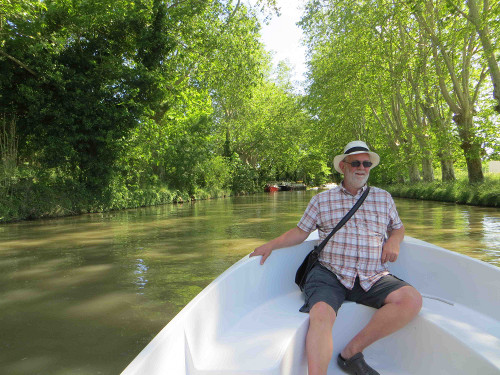
 Euro-Toques chef Martin Dwyer, much missed in Ireland since he and his wife Sile sold their eponymous restaurant in Waterford and moved to France. They now live in the Languedoc, where they take guests - and feed them very well.
Euro-Toques chef Martin Dwyer, much missed in Ireland since he and his wife Sile sold their eponymous restaurant in Waterford and moved to France. They now live in the Languedoc, where they take guests - and feed them very well.
This month Martin takes time out from his enjoyment of food and drink and, instead, revels in the great engineering feat that is the The Canal du Midi - and the entertainment that it can provide.
We are lucky here in the Languedoc to be close to a world heritage site, and one of the most beautiful waterways in France; The Canal du Midi. This canal has quite a heritage, it was long mooted as a short cut between the Atlantic and the Mediterranean which would cut off the long voyage around Spain, which routinely took a full month, and also avoid the Barbary pirates which were adept at picking off unwary voyagers through the Straits of Gibraltar.
In the sixteenth century the work had been started when, based on a plan by none other than Leonardo Da Vinci, a canal was built between Bordeaux and Toulouse. In 1662 Jean Paul Riquet, a local man from Beziers, set about solving the huge problems of providing water for the rest of the canal’s journey to the Med, which he did by building vast reservoirs of water in the Montagnes Noires. He completed the whole immense project in 1692, an incredible 300 plus years ago, and it is still running along its 240 kilometre length successfully today.
In the 1830’s as horse power took over from sail the banks were planted with Plane trees, which give shade to the horses as well as stabilizing the banks with their roots - and also gave the entire length a green dappled beauty. These trees are unfortunately in trouble today as they have developed a Wilt Disease, brought over from the USA in ammunition boxes during World War 2 and it is reckoned that all of the trees will have to be replaced in the next 20 to 30 years.
The canal is now mainly used for tourism with cabin cruisers heading up and down through the locks during the summer, small electric boats for hire between the locks and the tow paths make great cycle tracks. Near us in Fonserune, close to Beziers, there is a series of seven locks where it is a Sunday treat for the citizens of the town to watch the unseamanlike antics of the hirers of the Canal barges as they struggle up and down these locks.
In fact in 2010, while Sile and I were by the canal, on a bench on the bank at the bottom of the locks, an ascent started and several boats started to file into the bottom lock to start their long climb up the stairway. A large boat, manned by half a dozen middle aged ladies and gents, obviously not experienced sailors, were the last to try and fit in but were turned away by the lock keeper who reckoned the lock was too full to contain them.
Disappointed, they then decided to do something strange. Instead of reversing back and mooring they decided to turn their barge in the canal. Their barge was in fact just about exactly the same length as the width of the canal and so, shortly, the inevitable happened, and they became wedged laterally across the Canal du Midi.
The man at the wheel then performed heroic actions with his engine, sending up clouds of steam and burning lots of engine oil but to no avail. Then the decision was made and very shamefaced, (the barge now had become the attraction of the locks) five of the party, men and women, scrambled down from the back of the barge on the dry land.
Then the man at the tiller tied a rope on to the bow of the boat and, after throwing it into the water several times, one of the women went on board and carried it back to the team on the bank. The shore team now lined themselves along the rope rather like a tug of war team and while the skipper continued to rev the engine heroically, they proceeded to try and dislodge the barge from its transverse position.
They weren’t enjoying any obvious success. The boat remained in the same position. Then the captain had a eureka moment and with a shout of joy he found a bit of equipment which he had not seen before. Triumphantly he pulled this lever and the boat just as suddenly started to turn, but unfortunately in the opposite direction of the tug of war team, and with such power that they were all dragged several yards on their tummies, protesting loudly towards the canal.
I must confess that I was so obviously enjoying the proceedings at this stage that Sile grabbed me firmly by the elbow and steered me towards the car.
To the best of my knowledge none of the team was actually deposited in the water but they were all left in a tangled heap on the bank while the skipper, unaware of their condition gazed around in triumph at, what he saw as his successful solving of the problem.
-------------
 Martin Dwyer started cooking professionally over 40 years ago in the legendary “Snaffles Restaurant” in Dublin. After a time in a Relais Chateau in Anjou and in “The Wife of Bath” in Kent he opened his own much acclaimed restaurant, “Dwyers”, in Waterford in 1989. In 2004 he sold this and moved south to France where he and his wife Síle bought and restored an old presbytery in a village in the Languedoc. They now run Le Presbytère as a French style Chambre d’Hôte. Martin however is far too passionate about food to give up cooking so they now enjoy serving dinner to their customers on the terrace of Le Presbytère on warm summer evenings. Martin runs occasional cookery courses in Le Presbytère and Síle’s brother Colm does week long Nature Strolls discovering the Flora and Fauna of the Languedoc.
Martin Dwyer started cooking professionally over 40 years ago in the legendary “Snaffles Restaurant” in Dublin. After a time in a Relais Chateau in Anjou and in “The Wife of Bath” in Kent he opened his own much acclaimed restaurant, “Dwyers”, in Waterford in 1989. In 2004 he sold this and moved south to France where he and his wife Síle bought and restored an old presbytery in a village in the Languedoc. They now run Le Presbytère as a French style Chambre d’Hôte. Martin however is far too passionate about food to give up cooking so they now enjoy serving dinner to their customers on the terrace of Le Presbytère on warm summer evenings. Martin runs occasional cookery courses in Le Presbytère and Síle’s brother Colm does week long Nature Strolls discovering the Flora and Fauna of the Languedoc.
Le Presbytère can be seen at: www.lepresbytere.net;
email: martin@lepresbytere.net
An Irish Chef in France
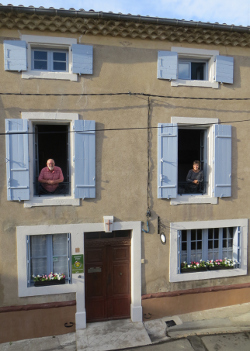
 Euro-Toques chef Martin Dwyer, much missed in Ireland since he and his wife Sile sold their eponymous restaurant in Waterford and moved to France. They now live in the Languedoc, where they take guests - and feed them very well.
Euro-Toques chef Martin Dwyer, much missed in Ireland since he and his wife Sile sold their eponymous restaurant in Waterford and moved to France. They now live in the Languedoc, where they take guests - and feed them very well.
This month Martin revels in the pleasure of favourite fruit grown in the right climate - and the perfect Greenhouse Salad
When I was growing up we lived in a very special house in the suburbs of Cork. This house, which was called Tree Tops, was on a hill over the city and there was a wonderful view from the garden of the river Lee flowing eastwards out or the city to the harbour with Blackrock Castle in the distance.
My mother’s pride and joy (and a contribution towards the household economy) was a huge greenhouse at the very top of the garden. In this she principally grew two of the most beautifully scented fruits I know; tomatoes and white peaches.
The perfume in the greenhouse when both of these intense fruits were ripe was quite intoxicating.
In one of Elizabeth David’s cookery books she talks of an autumn spent in Spain where every day they ate for lunch a simple salad of tomatoes, warm from the vine and dressed in olive oil, a meal she claims it would be hard to better.
My other kitchen goddess, Myrtle Allen, in her book about the food of Ballymaloe says that she has tried for many years to make the perfect tomato soup; she feels it should taste of the juices left in the bowl after a fresh tomato salad.
In another of Elizabeth David’s books, I think Summer Cooking; she gives a recipe from Italy, for a salad of tomatoes and peaches. I remember trying this out and being so impressed with the taste and the wonderful way both fruits brought out each other’s flavours that I put it on the menu on the restaurant. While it was never a best seller, those that tried it grew strangely addicted.
In my old friend Michael Waterfield’s new edition of his great great aunt Janet Ross’s book “Leaves from our Tuscan Kitchen” there at the bottom of a long list of various ways of dressing tomatoes for salad a throwaway recipe for a salad of Tomatoes and Italian Peaches.
Now that we have a small garden here in the south of France I have set about growing these two fruits and now have a white peach tree and some baby cherry tomatoes growing there.
Ironically, because we now live in a so much milder climate we no longer need a greenhouse to encourage these two fruits to grow.
But still, in memory of my mother’s heroic efforts growing these fruits out of their best environment I call the salad ; La Salade de La Serre- Greenhouse Salad.
La Salade de La Serre
3 Large Ripe tomatoes
2 Large Ripe White Peaches (yellow peaches or nectarines will do at a pinch)
1 teaspoon caster Sugar (in Ireland only, not needed in the south where the fruit sweetens naturally in the sun)
1 Energetic grinding of black pepper
1 large pinch of Maldon Sea Salt (crushed lightly in your fingers as you scatter)
1 tablespoon balsamic vinegar
3 tablespoons of fruity olive oil
6 to 8 leaves of fresh Basil
1 crisp fresh French loaf or ciabatta
Peel the peaches (by plunging in boiling water if needed)
Slice into eight of ten segments off the stone and then halve these.
Cut the tomatoes into similar sized pieces, discarding the core near the stem.
Sprinkle over the sugar (if using) the pepper, salt, oil and vinegar tear the basil leaves over, and toss together with a spoon.
Leave for about ten minutes to blend, then eat, on its own, or with some cold meats.
When the tomatoes are finished (and this is the best bit) finish off the tomatoey peachy vinaigrette by dipping pieces of the bread into these juices.
The gods probably lived on food like this.
-------------
 Martin Dwyer started cooking professionally over 40 years ago in the legendary “Snaffles Restaurant” in Dublin. After a time in a Relais Chateau in Anjou and in “The Wife of Bath” in Kent he opened his own much acclaimed restaurant, “Dwyers”, in Waterford in 1989. In 2004 he sold this and moved south to France where he and his wife Síle bought and restored an old presbytery in a village in the Languedoc. They now run Le Presbytère as a French style Chambre d’Hôte. Martin however is far too passionate about food to give up cooking so they now enjoy serving dinner to their customers on the terrace of Le Presbytère on warm summer evenings. Martin runs occasional cookery courses in Le Presbytère and Síle’s brother Colm does week long Nature Strolls discovering the Flora and Fauna of the Languedoc.
Martin Dwyer started cooking professionally over 40 years ago in the legendary “Snaffles Restaurant” in Dublin. After a time in a Relais Chateau in Anjou and in “The Wife of Bath” in Kent he opened his own much acclaimed restaurant, “Dwyers”, in Waterford in 1989. In 2004 he sold this and moved south to France where he and his wife Síle bought and restored an old presbytery in a village in the Languedoc. They now run Le Presbytère as a French style Chambre d’Hôte. Martin however is far too passionate about food to give up cooking so they now enjoy serving dinner to their customers on the terrace of Le Presbytère on warm summer evenings. Martin runs occasional cookery courses in Le Presbytère and Síle’s brother Colm does week long Nature Strolls discovering the Flora and Fauna of the Languedoc.
Le Presbytère can be seen at: www.lepresbytere.net;
email: martin@lepresbytere.net
An Irish Chef in France
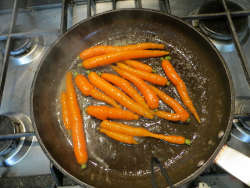
 Euro-Toques chef Martin Dwyer, much missed in Ireland since he and his wife Sile sold their eponymous restaurant in Waterford and moved to France. They now live in the Languedoc, where they take guests - and feed them very well.
Euro-Toques chef Martin Dwyer, much missed in Ireland since he and his wife Sile sold their eponymous restaurant in Waterford and moved to France. They now live in the Languedoc, where they take guests - and feed them very well.
This month Martin reveals ‘A Day in the Life…’
One of the things people are curious about our life here is how we manage our days, especially in the heat; the average temperatures here at the moment are bordering the early thirties.
The true answer is we manage them with some care. One of the most frequent remarks delivered to this couple is from people who say “My God, you are living the dream”. If it is, then we live this dream very gingerly; we would hate to turn it into a nightmare.
Our day begins quite early, the church which is just outside our window, begins its hourly chiming with a reveille at 7.00 - no need for alarm clocks - and as it is quite likely that we will have been entertaining ourselves and our guests until around midnight there will be the usual round of morning groans as we haul ourselves out of the bed.
First job of the morning (and this we take in turns) is to buy the baguettes and croissants in the village for the guests; this involves a pleasant stroll down to the Boulanger and a stiff climb back with the spoils. Then the breakfast has to be sorted.
This will usually comprise of two sorts of fruit - at the moment poached apricots and also a melon and grapefruit salad, the bread from the baker along with my brioche – Pompe a l’Huile - made with olive oil and fruits, or occasionally my own brown bread made from smuggled in Howards Oneway.
We will also offer a homemade Granola, bowls of Fromage Frais and of course my homemade jams, at the moment Yellow Cherry, Apricot, Rhubarb and Ginger and two sorts of Marmalade. Nota bene - we do not serve any cooked breakfast and are constantly grateful to the French for not having included it in their Repetoire de Petit Dejeuner.
Breakfast, we have discovered, can be almost as social an affair as dinner and guests frequently dally over the dishes while imbibing several cups of coffee.
As they dally I decide my menu for the night’s dinner. First thing is to check if there are any difficulties with the guests, vegetarianism, food allergies or dislikes and make sure I don’t include these in the menu.
The system here in the Table d’Hote is much closer to giving a dinner party than running a restaurant. We offer no choices and ourselves join the guests for dinner. (The French authorities in their wisdom have decided that this would be safeguard enough against food poisoning and so we are immune from visitations from environmental health officers).
My next job is to do my shopping - this usually involves a visit to a farmers co-operative down the road which provides wonderful fruits and vegetables, a visit to the butcher in the village for the meats and then a trip to the supermarket, also in the village, for everything else. In this country at these temperatures a daily shopping expedition is essential.
Usually I try to get all of my preparations done by lunchtime so we can have the afternoons free - it doesn’t always work though, especially in the high heat when everything happens at a slower pace.
While I tackle the kitchen, Sile is organising any change over days in the bedroom - fortunately she won’t permit me to help her too much in this as she considers my standards much too low.
The afternoon is our time off and will frequently see one or other of us enjoying the excellent tradition of a siesta.
The evening starts with an aperitif (always known as an apero here) on the terrace, usually a sparkling Kir made with Blanquette de Limoux accompanied by various anchovy, olive nibbles. The meal itself is usually a large one but served with plenty of time between the courses while I busy myself in the kitchen and it will often be touching 11.00 before we clear the cheese and serve dessert.
Now as we eat and drink with the guests this turns out to be a totally different meal from that in a restaurant and can become very convivial indeed. (Did I mention that wine is also included - at the discretion of a very indiscreet host.)
So that’s our day and then to answer the questions.
We do work hard sometimes, as in the present, in very hot weather. We have extremely long days but we also have marvellous rewards.
I love cooking the amazing foods of the Mediterranean, the fruit and vegetables are a joy. It is also a remarkably convivial life and the nightly parties on the terrace can be wonderful international soirées with jokes and discussions flying about in many languages.
I am fairly sure we made the right decision to finish off our working lives here.
-------------
 Martin Dwyer started cooking professionally over 40 years ago in the legendary “Snaffles Restaurant” in Dublin. After a time in a Relais Chateau in Anjou and in “The Wife of Bath” in Kent he opened his own much acclaimed restaurant, “Dwyers”, in Waterford in 1989. In 2004 he sold this and moved south to France where he and his wife Síle bought and restored an old presbytery in a village in the Languedoc. They now run Le Presbytère as a French style Chambre d’Hôte. Martin however is far too passionate about food to give up cooking so they now enjoy serving dinner to their customers on the terrace of Le Presbytère on warm summer evenings. Martin runs occasional cookery courses in Le Presbytère and Síle’s brother Colm does week long Nature Strolls discovering the Flora and Fauna of the Languedoc.
Martin Dwyer started cooking professionally over 40 years ago in the legendary “Snaffles Restaurant” in Dublin. After a time in a Relais Chateau in Anjou and in “The Wife of Bath” in Kent he opened his own much acclaimed restaurant, “Dwyers”, in Waterford in 1989. In 2004 he sold this and moved south to France where he and his wife Síle bought and restored an old presbytery in a village in the Languedoc. They now run Le Presbytère as a French style Chambre d’Hôte. Martin however is far too passionate about food to give up cooking so they now enjoy serving dinner to their customers on the terrace of Le Presbytère on warm summer evenings. Martin runs occasional cookery courses in Le Presbytère and Síle’s brother Colm does week long Nature Strolls discovering the Flora and Fauna of the Languedoc.
Le Presbytère can be seen at: www.lepresbytere.net;
email: martin@lepresbytere.net
An Irish Chef in France
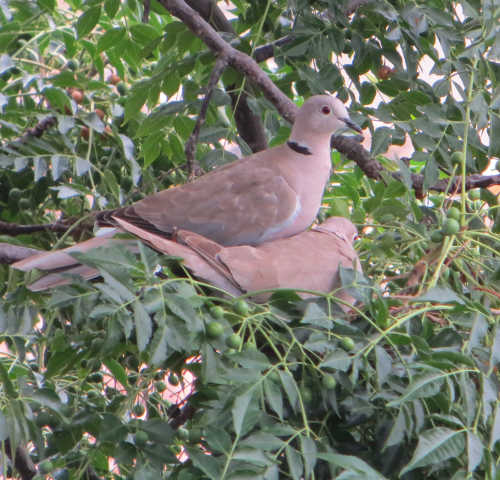
 Euro-Toques chef Martin Dwyer, much missed in Ireland since he and his wife Sile sold their eponymous restaurant in Waterford and moved to France. They now live in the Languedoc, where they take guests - and feed them very well.
Euro-Toques chef Martin Dwyer, much missed in Ireland since he and his wife Sile sold their eponymous restaurant in Waterford and moved to France. They now live in the Languedoc, where they take guests - and feed them very well.
Another Terrace Morning
This morning is one of the very few mornings we have woken up to a guest free house this summer and I imagined I would luxuriate in the bed until a sinful 8 or 9 o clock before going to the kitchen, in the dressing gown, for coffee. I woke however at 6.45 as usual, just before the bells start ringing in at seven, and the thought of drinking coffee in the cool of the terrace before the sun warmed it from the east seemed far more attractive than another snooze.
It was, and furthermore nature conspired to reward me for my early rising. There is so much happening now in the garden and beyond. Our grapes are now ripe, overripe in fact and if I am just too lazy to bother picking them, not so for the sparrows. If I stay very still they will come right in under the canopy of the vine and gorge on the grapes - one small movement from me and they are gone in a flash.
Columbine our resident Mother Dove, is still sitting and looking remarkably dishevelled on her nest. She now flutters off every so often and then sticks her head down into the nest where I can only assume she is disgorging the contents of her crop to the open beaks below. So far, even with the aid of a pair of binoculars, I haven’t spotted any sign of the young.
Beyond Columbine, Canigou is a dark grey silhouette against the horizon. She has been visible now for the last few days; this, the locals tell us is a sign of rain.
Closer than Canigou and in the foothills of the Corbières is Le Mont d’Alairic. Just south of Carcassonne, which we can always see, and which at one time, and quite lately, was home to one of the bears which they had re-introduced to the Pyrenees. This particular young male had, to the consternation of the sheep farmers on Alairic, decided that the living was easier on the Corbieres.
Also from the terrace can be seen the small hill on which is the Oppidum of Ensurune, a settlement originially colonised by the Greeks and then the Romans which now houses a wonderful museum of Greek and Roman pottery.
This I know I can see from the terrace as from the same Oppidum, with a friend’s powerful binoculars, we were able to pick out our tree in the centre of Thezan.
We got a letter from a lovely American lady last night who stayed here with her husband last year. Her first sentence was “How are you two getting on in your little piece of Heaven?” Very well thanks.
-------------
 Martin Dwyer started cooking professionally over 40 years ago in the legendary “Snaffles Restaurant” in Dublin. After a time in a Relais Chateau in Anjou and in “The Wife of Bath” in Kent he opened his own much acclaimed restaurant, “Dwyers”, in Waterford in 1989. In 2004 he sold this and moved south to France where he and his wife Síle bought and restored an old presbytery in a village in the Languedoc. They now run Le Presbytère as a French style Chambre d’Hôte. Martin however is far too passionate about food to give up cooking so they now enjoy serving dinner to their customers on the terrace of Le Presbytère on warm summer evenings. Martin runs occasional cookery courses in Le Presbytère and Síle’s brother Colm does week long Nature Strolls discovering the Flora and Fauna of the Languedoc.
Martin Dwyer started cooking professionally over 40 years ago in the legendary “Snaffles Restaurant” in Dublin. After a time in a Relais Chateau in Anjou and in “The Wife of Bath” in Kent he opened his own much acclaimed restaurant, “Dwyers”, in Waterford in 1989. In 2004 he sold this and moved south to France where he and his wife Síle bought and restored an old presbytery in a village in the Languedoc. They now run Le Presbytère as a French style Chambre d’Hôte. Martin however is far too passionate about food to give up cooking so they now enjoy serving dinner to their customers on the terrace of Le Presbytère on warm summer evenings. Martin runs occasional cookery courses in Le Presbytère and Síle’s brother Colm does week long Nature Strolls discovering the Flora and Fauna of the Languedoc.
Le Presbytère can be seen at: www.lepresbytere.net;
email: martin@lepresbytere.net
An Irish Chef in France
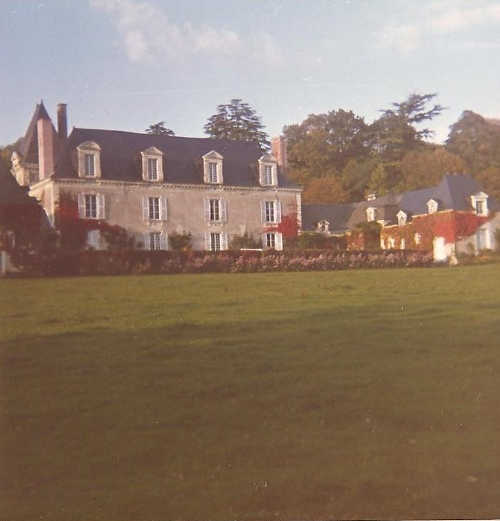
 Euro-Toques chef Martin Dwyer, much missed in Ireland since he and his wife Sile sold their eponymous restaurant in Waterford and moved to France. They now live in the Languedoc, where they take guests - and feed them very well.
Euro-Toques chef Martin Dwyer, much missed in Ireland since he and his wife Sile sold their eponymous restaurant in Waterford and moved to France. They now live in the Languedoc, where they take guests - and feed them very well.
This month Martin recalls their connections over four decades with Chateau de Teildras, near Angers.
This adventure in France which Sile and I are involved in at the moment was not our first. In 1974, a year after we were married we decided to give up all - I was a chef in Snaffles restaurant in Dublin, Sile a primary school teacher in Dublin’s Basin Lane - and move to France.
I had this notion that to have any credence as a chef I would have to spend some time working in France. With this in mind I decided to write to two of my food heroines at the time and look for advice as to how to get some experience in a French kitchen; Elizabeth David and Theodora FitzGibbon.
I got a very pleasant reply from Ms. David (I still have the letter) basically saying that she was now out of touch with kitchens in France. Ms. FitzGibbon however came up with the goods and advised me to contact Madame Graves in Ballylickey House Hotel. They were, she explained, members of the prestigious Relais de Campagne group which had members all over France.
Sure enough Madame Graves put me in touch with the head office of the Relais who were able to offer us a job immediately in Anjou in the Loire area. I was to be a commis chef in the kitchen and Sile to act as a chambermaid and also Au Pair to baby Clementine, granddaughter of Le Comte et Comtesse de Bernard, proprietors of Le Chateau de Teildras in the village of Cheffes sur Sarthe near the town of Angers in the Loire.
With a certain amount of foolhardiness and some courage we set off by boat and train to the town of Anjou where we were picked up by M. Le Comte and brought to the Chateau, which was very beautiful and wore its great age well.
So we settled into our respective roles, I wish I could say that I learned great tricks of the trade from the Chef but truth to tell he reserved all the rough work for me and slyly made all the exciting stuff, the brioches, the puff pastry in the afternoons when I was off.
I do remember becoming very fast at dicing vegetables in tiny even dice for Potage Paysann and also learning always to peel a potato Comme une gousse d’ail that is with six convex sides and one concave- which is still, nerd that I am, the way I peel them to this day.
I actually learned much more on the chef’s day off when Madame ruled in the kitchen and was prepared to take the time to teach me some cookery. Sile didn’t realise it at the time but in fact the standards of cleaning - a bath had to be washed thoroughly, rinsed, dried and then polished - also stayed with her and are those she applies in Le Presbytère today.
However, after a couple of months we decided that this was not going to be the most stimulating life choice of a job, so we decided to head home to Ireland and regroup, but with a firm intention to head back to France at some stage in our lives. We didn’t realise then that it would take quite so long.
About twenty years ago, coming back from our holidays in Le Lot, we stopped by the village and met the Charcutier with whom we had stayed all those years ago. The Count and Countess had long since died and the chateau was sold to the famous Cointreau family who were using it as a country home.
Last year, nearly forty years since our stay in Teildras I got a lovely email from Clementine, the baby Sile had occasionally minded. She had found and read a description of Comtesse de Bernard teaching me how to make Raspberry Jam in the kitchen on the chef’s day off, which I had blogged some years ago. She said it was a lovely reminder of a grandmother of whom she had been extremely fond.
-------------
 Martin Dwyer started cooking professionally over 40 years ago in the legendary “Snaffles Restaurant” in Dublin. After a time in a Relais Chateau in Anjou and in “The Wife of Bath” in Kent he opened his own much acclaimed restaurant, “Dwyers”, in Waterford in 1989. In 2004 he sold this and moved south to France where he and his wife Síle bought and restored an old presbytery in a village in the Languedoc. They now run Le Presbytère as a French style Chambre d’Hôte. Martin however is far too passionate about food to give up cooking so they now enjoy serving dinner to their customers on the terrace of Le Presbytère on warm summer evenings. Martin runs occasional cookery courses in Le Presbytère and Síle’s brother Colm does week long Nature Strolls discovering the Flora and Fauna of the Languedoc.
Martin Dwyer started cooking professionally over 40 years ago in the legendary “Snaffles Restaurant” in Dublin. After a time in a Relais Chateau in Anjou and in “The Wife of Bath” in Kent he opened his own much acclaimed restaurant, “Dwyers”, in Waterford in 1989. In 2004 he sold this and moved south to France where he and his wife Síle bought and restored an old presbytery in a village in the Languedoc. They now run Le Presbytère as a French style Chambre d’Hôte. Martin however is far too passionate about food to give up cooking so they now enjoy serving dinner to their customers on the terrace of Le Presbytère on warm summer evenings. Martin runs occasional cookery courses in Le Presbytère and Síle’s brother Colm does week long Nature Strolls discovering the Flora and Fauna of the Languedoc.
Le Presbytère can be seen at: www.lepresbytere.net;
email: martin@lepresbytere.net
An Irish Chef in France

 Euro-Toques chef Martin Dwyer, much missed in Ireland since he and his wife Sile sold their eponymous restaurant in Waterford and moved to France. They now live in the Languedoc, where they take guests - and feed them very well.
Euro-Toques chef Martin Dwyer, much missed in Ireland since he and his wife Sile sold their eponymous restaurant in Waterford and moved to France. They now live in the Languedoc, where they take guests - and feed them very well.
This month Martin recounts their first proper holiday since they set up business in France - A Fortnight in Italy
When we moved to France and therefore onto the Continent of Europe I imagined that we would be popping into the car every weekend we had free and tripping down the road to Italy, or Germany or Switzerland.
I mean all we had to do was drive, no ferries, no planes, no baggage restrictions, and furthermore we could carry back just what we wanted, the wines, oils and vinegars without fear of confiscation.
Things never work out as planned and after the bones of seven years in France we find that other than tours within the Hezagone to other spots in the South from Marseilles to Bayonne the only other continental country we have visited (and this is hardly a major voyage as we can see the Pyrenees, the border effectually, from our terrace) was to make several trips to Spain.
This was to all change this Autumn however as we decided that we now had worked hard enough to have a proper grown up holiday, one that started on a Friday evening and finished on a Sunday two weeks later, and Italy (about five hours to the border) was the country we decided to visit.
This was not our first time to go to Italy. We had taken the children to Tuscany in the nineties and had a most memorable tour of the Parma area with Euro-Toques in ’06, so we knew how good it could be.
This time we decided to spend a week exploring the Lunigiana which is the most northerly part of Tuscany (and the most rural) and the second week in Fiesole (see “Room with a View”) a village perched above and overlooking Florence.
In Lunigiana the place we had to visit was the Fortezza de Brunella in Aulla. (See picture above) This castle had been owned by the Waterfield family for whom we had worked in Kent many years before and had been the subject of a marvellous autobiography A Tuscan Childhood by Kinta Beevor, an aunt of my ex-boss Michael Waterfield. Michael himself had brought up to date his Great-Great-Aunt Janet Ross’s seminal work on Italian vegetable cookery: Leaves from a Tuscan Kitchen- still in print after 114 years!
Our best meal of the fortnight happened without doubt when we were en route between Aulla and Florence. There, in Montecatini Alto, we ate in a restaurant recommended by Michelin, Ristorante La Torre, a beautiful old room perched on the side of a mountain over the town of Montecatini.
Sile had Fettunata Porcini, delicious buttery Ceps on toasted Ciabatta, to start while I fulfilled a lifetime ambition and ate Lardo, paper thin cured slices of, yes, Pork fat, which had been cured in marble vats from nearby Carrera and literally melted on my tongue ( a French family dining near us were both amazed and envious!).
Delicious as this was, Sile's Secondi of a Crespelini stuffed with Ricotta and Spinach and scattered with shaved white truffles got the prize for Best Course, beating my superb Tagliatelli of Porcini with Cream. Total cost of this feast? : €59, a bargain for such quality.
Our week in Florence was to be a total culture immersion but to speak truly after the first few days we were suffering from overload, so we decided to head north of Fiesole, avoiding the Florence traffic, and see where the road would take us.
First stop was Scarperia, a little gem of a town with a strong tradition of making knives and with an impressive knife museum. It was 12 when we left there so we just decided to head north through the Apennines, through some spectacular roads, and stop wherever lunch time brought us.
This happened in a one horse town called Firenzuola which seemed uniquely involved in the production of Pietra Serena, a building stone, and was as modern as a new pin having been bombed out in 1945. The only eatery was a not madly inviting hotel, but, beggars and choosers that we were we went in.
Three faults were immediately evident, the place was cold, God knows how, it was quite mild outside.There was a loud couple with a dog in one corner and the lady of the house had a small child dogging her every step whom it was evident we were meant to ogle. (We did) The food however wasn't bad at all.
Garlicky bruschetta of Tomato, and Tortellini filled with potato, sauced with ragu Bolognaise (just a few miles up the road). The table next to us filled up with a business meeting of four men and women. The elder (in his forties) was a regular and greeted with much joy by the patronne with cries of Michele!
As we finished we asked Madame for the bill, and she, looking slightly wounded at us not taking coffee or desserts, arrived back shortly with two slices of a strudel type cake for us. As she passed the table she asked Michele to tell her how to say "Complimentary" to us.
"Tell them it is on the House" he said. And yes, we could hear a faint touch of Ireland in his English! “Where are you from? “he immediately asked us. His delight when we said Ireland was palpable. "My Mother was born in Ireland,” he said. "What on Earth brings you to Firenzuola"?
I wish I could say that we then ended up chewing the fat and exchanging stories for an hour but he was after all at a meeting! As we passed out though I dropped him a card for Le Presbytere, he looked delighted, I hope we may see him again and hear his story.
-------------
 Martin Dwyer started cooking professionally over 40 years ago in the legendary “Snaffles Restaurant” in Dublin. After a time in a Relais Chateau in Anjou and in “The Wife of Bath” in Kent he opened his own much acclaimed restaurant, “Dwyers”, in Waterford in 1989. In 2004 he sold this and moved south to France where he and his wife Síle bought and restored an old presbytery in a village in the Languedoc. They now run Le Presbytère as a French style Chambre d’Hôte. Martin however is far too passionate about food to give up cooking so they now enjoy serving dinner to their customers on the terrace of Le Presbytère on warm summer evenings. Martin runs occasional cookery courses in Le Presbytère and Síle’s brother Colm does week long Nature Strolls discovering the Flora and Fauna of the Languedoc.
Martin Dwyer started cooking professionally over 40 years ago in the legendary “Snaffles Restaurant” in Dublin. After a time in a Relais Chateau in Anjou and in “The Wife of Bath” in Kent he opened his own much acclaimed restaurant, “Dwyers”, in Waterford in 1989. In 2004 he sold this and moved south to France where he and his wife Síle bought and restored an old presbytery in a village in the Languedoc. They now run Le Presbytère as a French style Chambre d’Hôte. Martin however is far too passionate about food to give up cooking so they now enjoy serving dinner to their customers on the terrace of Le Presbytère on warm summer evenings. Martin runs occasional cookery courses in Le Presbytère and Síle’s brother Colm does week long Nature Strolls discovering the Flora and Fauna of the Languedoc.
Le Presbytère can be seen at: www.lepresbytere.net;
email: martin@lepresbytere.net
An Irish Chef in France
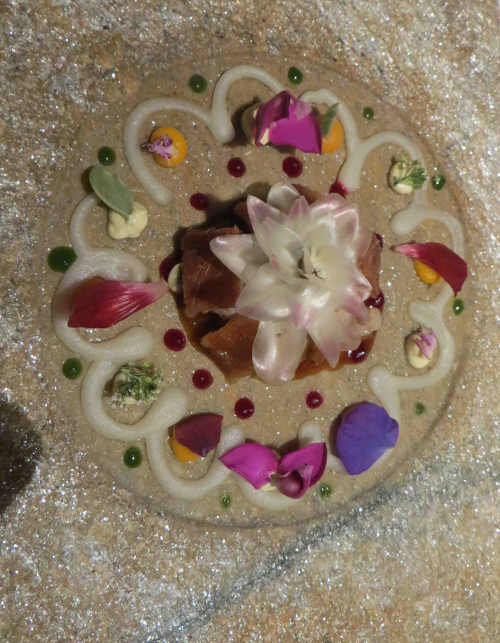
Euro-Toques chef Martin Dwyer, much missed in Ireland since he and his wife Sile sold their eponymous restaurant in Waterford and moved to France. They now live in the Languedoc, where they take guests - and feed them very well.
This month Martin recounts a very special experience: Dinner in El Celler de Can Roca
It was a chance remark thrown out at a dinner party last Christmas here in our village in the south of France which started this particular ball rolling.
“Do you know” I said, “that the number two restaurant in the world is only two hours down the road”. That was quite enough for our extremely organised neighbour, we got a phone call from her within a few days. She had phoned the restaurant and had been offered two possible dates in the following November, which one would suit us best?
This is how we ended up last Thursday going to have dinner in El Celler de can Roca in Girona which had, since the booking had been made, leap frogged over Noma in Copenhagen, and was now rated number one in the world.
The Roca brothers, Joan (head chef, centre in image above) Josep (sommelier) and Jordi were reared in restaurants and the family restaurant, founded by their grandfather and now run by their mother, still serves meals in Girona, just next door to El Celler.
The brothers have run their own restaurant since 1986 and have earned three stars from Michelin since 2009.
I must confess that I was a little nervous when I we got to the front door at 9.00 for our booking but the service from the moment we got in the door was impeccable, no swish no pretention just warmth and welcome.
There were two menu choices, the Tasting Menu or the Tasting Feast but there was no stopping us, we went for the feast - 22 courses (I actually counted 25) all brought seamlessly and smoothly to the table.
My wife Sile’s protests that she would never manage that much food proved unfounded. Some of the courses were indeed tiny, a sliver of moist rich artichoke omelette on a teaspoon, a single langoustine steamed at the table in Manzanilla over hot rocks which you then dipped in bisque and sherry caramel.
It would take an entire volume for me to go through all the courses so I will just mention some which were particularly stunning. As one of the starters we were given what they modestly called an Asparagus Vienetta, which did indeed visually resemble a slice of that product. There the comparison ended, it was a smooth creamy, richly savoury essence of white asparagus with a taste bomb of truffle powder which filled the mouth. Utterly unforgettable, I would have happily had this for all the courses.
Around the middle of the evening we were given what I suppose roughly corresponded to the main course. I will give you El Celler’s own description of this:
Spicy Mandala of Artichoke Flower , milk fed lamb belly, lamb sweetbreads, curry yoghurt, beetroot, spinach, turnip, lemon tangerine, sweet potato, leaves and flowers.
Sound fussy? Well it wasn’t. Every morsel on the plate was evident and edible, from the crisp lamb belly, to the tiny bouquet of shiny artichoke leaflets, to the ring of sweet potato. The curry yoghurt nodded to the name of the dish and its amazing flower like presentation.
The desserts were astounding taste sensations, a bright red caramel apple which burst on the spoon to reveal apple ice-cream inside, a sourdough ice-cream studded with meringues no bigger than smarties with a tongue tingling fried lychee.
Tipped off by JP Mc Mahon, who had been there the week before, we asked could we see the kitchen. This was no problem at all to our charming waitress who brought us into the coal face itself where I shook hands with Joan, the chef brother.
I had a restaurant myself in Ireland for many years I told him, but never more than two chefs in the kitchen. He laughed, “Tonight I have 34!”
At the end of that true feast it was interesting to note that none of us were feeling the least bloated, Sile for all her protests managed to tuck into some of the Petits Fours.
As it was November, my month for abstinence, I left the wine tasting to the other three. The choice was a selection by Josep of a different wine with each course or a dip into their wine list. This was in fact a dictionary sized volume of the 60,000 wines stocked in the cellar. They chose the house selection and were charmed with the choice which included glasses from Germany and France as well as Spain and even a glass of Sake from Japan and a sweet cider from Normandy with the apple dessert.
There were two dinner menus on offer, the Tasting cost €155 per head, the Feast €195. The voluminous wine lists offered quite a few wines under €30 a bottle (and many more way more than that) but the tasting selection of 14 different wines offered with the Feast menu cost €90 a head and my dinner companions thought it well worth the cost and that the pairing was chosen with terrific skill.
I am already trying to think up an excuse to go back.
-------------
 Martin Dwyer started cooking professionally over 40 years ago in the legendary “Snaffles Restaurant” in Dublin. After a time in a Relais Chateau in Anjou and in “The Wife of Bath” in Kent he opened his own much acclaimed restaurant, “Dwyers”, in Waterford in 1989. In 2004 he sold this and moved south to France where he and his wife Síle bought and restored an old presbytery in a village in the Languedoc. They now run Le Presbytère as a French style Chambre d’Hôte. Martin however is far too passionate about food to give up cooking so they now enjoy serving dinner to their customers on the terrace of Le Presbytère on warm summer evenings. Martin runs occasional cookery courses in Le Presbytère and Síle’s brother Colm does week long Nature Strolls discovering the Flora and Fauna of the Languedoc.
Martin Dwyer started cooking professionally over 40 years ago in the legendary “Snaffles Restaurant” in Dublin. After a time in a Relais Chateau in Anjou and in “The Wife of Bath” in Kent he opened his own much acclaimed restaurant, “Dwyers”, in Waterford in 1989. In 2004 he sold this and moved south to France where he and his wife Síle bought and restored an old presbytery in a village in the Languedoc. They now run Le Presbytère as a French style Chambre d’Hôte. Martin however is far too passionate about food to give up cooking so they now enjoy serving dinner to their customers on the terrace of Le Presbytère on warm summer evenings. Martin runs occasional cookery courses in Le Presbytère and Síle’s brother Colm does week long Nature Strolls discovering the Flora and Fauna of the Languedoc.
Le Presbytère can be seen at: www.lepresbytere.net;
email: martin@lepresbytere.net
An Irish Chef in France
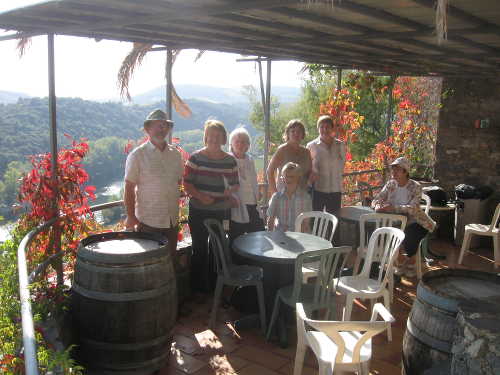
 Euro-Toques chef Martin Dwyer, is much missed in Ireland since he and his wife Sile sold their eponymous restaurant in Waterford and moved to France. They now live in the Languedoc, where they take guests - and feed them very well.
Euro-Toques chef Martin Dwyer, is much missed in Ireland since he and his wife Sile sold their eponymous restaurant in Waterford and moved to France. They now live in the Languedoc, where they take guests - and feed them very well.
This month Martin whets our appetite for a visit to the Languedoc with an introduction to their strolling breaks, “A Taste of Languedoc Nature”.
My wife Sile’s family have always been much more aware of nature than I ever was. One of my first memories of when I was first in their house, over 40 years ago now, was her mother remarking that the wind had changed.
All her family inherited this remarkable affinity with nature but none more than her younger brother Colm. Colm is a qualified horticulturist but also passionate about animal life and contributes to learned magazines papers on such esoteric topics as the habits of dragon flies and solitary wasps.
Going for a walk in the country with Colm was always part stroll and part lesson on natural history, every short while he would pause to listen to some birdsong which he would then identify, or for him to find a plant on the way (which I would certainly have trodden on) and tell us it was rare trefoil or orchid.
One of the constant surprises for us of living in the Languedoc is the great richness of the plants and flowers here. Plants that are cultivated, nurtured and treasured in sheltered gardens and hot houses in Ireland here grow happily, untended in the wild.
At the moment the countryside is awash with great frothy trees full of almond blossom, very soon any tilled earth will be scarlet with poppies. There are wonderful carpets of sweetly scented white flowers (which I need Colm to identify) which have sprung up overnight between the vines and soon the hills to the north of us will be covered with cherry blossom which, unlike the Irish varieties, will actually produce harvests of cherries in May and June . (there is a particular yellow variety called Napoleons which have higher acidity than the reds and make a wonderful jam)
It must have been about three years ago that I got the idea of Colm running short nature appreciation courses out here in the Languedoc. It is a very simple formula, he takes the group off for their stroll in nature every morning, here we are blessed with a great variety of habitats living as we do between the high hills of the North Languedoc which form the beginning of the Massive Central and the Mediterranean which is about fifteen minutes to the south.
Colm’s courses, we call them “A Taste of Languedoc Nature” are very much more strolls than hikes and have proved remarkably popular, so much so that people keep coming back to repeat them and this year we are running four of these courses, two in May, which is the best time for the beautiful wild flowers of the Midi to be in bloom and another two in Autumn when the fruits and nuts of the hedgerows are ripe.
These strolling holidays are not of course all devoted to the appreciation of nature, as our strollers come home each evening and enjoy a dinner of the produce of the area, fish from the Mediterranean and mountain lamb from the Aveyron, the excellent wines of the Languedoc and even occasionally some Samphire from the shores of the Med or some Pomegranates from the hedgerows.
All the information on these courses and on some occasional cookery ones which I run myself are on our website: www.lepresbytere.net
-------------
 Martin Dwyer started cooking professionally over 40 years ago in the legendary “Snaffles Restaurant” in Dublin. After a time in a Relais Chateau in Anjou and in “The Wife of Bath” in Kent he opened his own much acclaimed restaurant, “Dwyers”, in Waterford in 1989. In 2004 he sold this and moved south to France where he and his wife Síle bought and restored an old presbytery in a village in the Languedoc. They now run Le Presbytère as a French style Chambre d’Hôte. Martin however is far too passionate about food to give up cooking so they now enjoy serving dinner to their customers on the terrace of Le Presbytère on warm summer evenings. Martin runs occasional cookery courses in Le Presbytère and Síle’s brother Colm does week long Nature Strolls discovering the Flora and Fauna of the Languedoc.
Martin Dwyer started cooking professionally over 40 years ago in the legendary “Snaffles Restaurant” in Dublin. After a time in a Relais Chateau in Anjou and in “The Wife of Bath” in Kent he opened his own much acclaimed restaurant, “Dwyers”, in Waterford in 1989. In 2004 he sold this and moved south to France where he and his wife Síle bought and restored an old presbytery in a village in the Languedoc. They now run Le Presbytère as a French style Chambre d’Hôte. Martin however is far too passionate about food to give up cooking so they now enjoy serving dinner to their customers on the terrace of Le Presbytère on warm summer evenings. Martin runs occasional cookery courses in Le Presbytère and Síle’s brother Colm does week long Nature Strolls discovering the Flora and Fauna of the Languedoc.
Le Presbytère can be seen at: www.lepresbytere.net;
email: martin@lepresbytere.net
An Irish Chef in France


This month Martin finds amusement in on the way things in another country can sometimes get lost in translation.
The most difficult thing of moving to a new country in one’s sixties is, without doubt, learning the new language.
I had a lot of help when I made my move to France a few years ago. For one thing I had always had a great love for all things French, the songs, the literature and of course the food. Sile and I had worked in France in a Relais de Campagne in the seventies so I had a fairly good smattering of kitchen French (most of it not repeatable in polite society) but the most important card I held was having the good fortune to be accompanied by a wife fluent in the language.
Sile had learned French at the proper age, in her early teens, and had gone several times to France as an exchange school student and as an au pair and had later done a degree in French in UCD (while I was wasting my time studying English and History.) This was also a disadvantage, having a fluent wife who could sort out major problems has made me lazy about picking it up.
This, of course, has not stopped me managing to make quite a few howlers. I remember my amazement when I asked at the box office when the next shuttle bus was due the man behind the glass laughed so hard that he handed me on to his colleague who also dissolved into giggles when I made my request. It turned out that I had asked them when the next turnip was due, navet being the French for turnip which I had requested instead of a navette, a shuttle.
It worked outside France too, not having the most mechanical of minds I brought the car to a garage in France when, one holiday, it was difficult to start in the morning. They told me that my automatic choke (starter automatique) was sticking and showed me where to kick it to get it unstuck. Back in Ireland I explained to my own garage in Waterford that my automatic starter was they problem. That left him bewildered.
Mind you the French themselves don’t always get things quite right. I was in Brussels at a Euro-Toques food conference a few years ago in the European Parliament (not the main chamber, a little one in the same building). The conference was principally in French but we were being given spontaneous translation by a group of three translators in a glass booth.
At one stage I heard an English speaking delegate say that "We must always insist that our vegetables are served in season." The translation, in French (to which I was listening as an exercise to relieve boredom) said that " Nos légumes doivent toujours être bien assaisonneé" which means that our vegetables should be always well seasoned with salt and pepper. (Then that same translator probably went down stairs to the main chamber and started an international crisis.)
The French also have quite a few English words which they get a little wrong, they translate a dinner jacket as Le Smoking, a savoury soda bread as Le Cake and a large wardrobe as Le Dressing.
We on the other hand frequently use “French” words which are not used the same way here. A street without continuation is an “Impasse” never a “Cul de Sac” and a “Gateau” refers usually to a plain cake or biscuit.
Sometimes one can actually see two mis-translations working together in tandem. On the Ferry Boats which shuttle across the Channel the cheaper of the two restaurants on board is called (in French) “Le Self Service”, and in English “The Buffet”.
There is however one aspect of Irish life which translates exactly in France ; they love to take the mick. This was brought home to me recently when I returned to my car in the supermarket carpark only to find an identical Renault Megane parked next to it. While I looked at both (trying to decide which was mine) an earnest Frenchman of my age ran up proffering keys. “Why don’t you take mine and I take yours,” he said. “Then we can also swap houses and even wives.” At the look of profound disbelief on my face he just cracked up laughing. I had to join him - he was, I suddenly realised, just taking the mick.
-------------
 Martin Dwyer started cooking professionally over 40 years ago in the legendary “Snaffles Restaurant” in Dublin. After a time in a Relais Chateau in Anjou and in “The Wife of Bath” in Kent he opened his own much acclaimed restaurant, “Dwyers”, in Waterford in 1989. In 2004 he sold this and moved south to France where he and his wife Síle bought and restored an old presbytery in a village in the Languedoc. They now run Le Presbytère as a French style Chambre d’Hôte. Martin however is far too passionate about food to give up cooking so they now enjoy serving dinner to their customers on the terrace of Le Presbytère on warm summer evenings. Martin runs occasional cookery courses in Le Presbytère and Síle’s brother Colm does week long Nature Strolls discovering the Flora and Fauna of the Languedoc.
Martin Dwyer started cooking professionally over 40 years ago in the legendary “Snaffles Restaurant” in Dublin. After a time in a Relais Chateau in Anjou and in “The Wife of Bath” in Kent he opened his own much acclaimed restaurant, “Dwyers”, in Waterford in 1989. In 2004 he sold this and moved south to France where he and his wife Síle bought and restored an old presbytery in a village in the Languedoc. They now run Le Presbytère as a French style Chambre d’Hôte. Martin however is far too passionate about food to give up cooking so they now enjoy serving dinner to their customers on the terrace of Le Presbytère on warm summer evenings. Martin runs occasional cookery courses in Le Presbytère and Síle’s brother Colm does week long Nature Strolls discovering the Flora and Fauna of the Languedoc.
Le Presbytère can be seen at: www.lepresbytere.net;
email: martin@lepresbytere.net
An Irish Chef in France
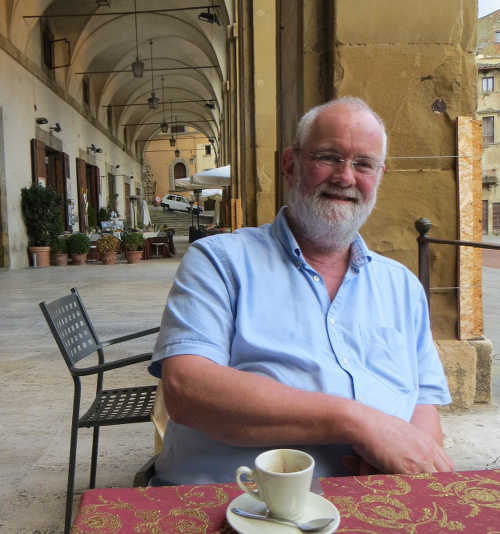
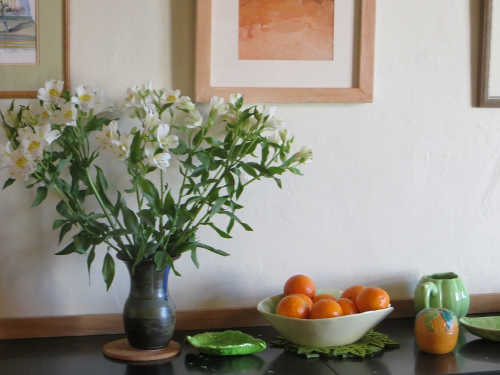 Euro-Toques chef Martin Dwyer, is much missed in Ireland since he and his wife Sile sold their eponymous restaurant in Waterford and moved to France. They now live in the Languedoc, where they take guests - and feed them very well.
Euro-Toques chef Martin Dwyer, is much missed in Ireland since he and his wife Sile sold their eponymous restaurant in Waterford and moved to France. They now live in the Languedoc, where they take guests - and feed them very well.
This month Martin, observing the ways of his adopted country with amused delight as ever, lets us in on his Twenty things which say you are in France.
1 Old men:- (I’m talking three score and ten [and over] here) whizzing on racing bikes through the countryside in day-glo lycra.
2 Ladies of a certain age:- Totally convinced that dyed red hair gives them style- unfortunately as genuine red hair is rare here the resulting orange shade still startles.
3 Cars with Suntans:- Yes ! If cars get too much sun after a certain time they start to peel (a phenomenom unknown in Ireland)
4 Paper Roses :- This is a polite term for plastic flowers which the French happily use even in quite sophisticated restaurants.
5 Pollarded Trees:- Sometime in Autumn the council workers pollard trees to within an inch of their lives, however, each summer, despite my anxieties, they return in full leaf.
6 Total lack of “Open Fires” or indeed Coal:-In all my time here I have never seen any direct heat except from an enclosed stove.
7 Wearing of Winter Clothes in the very beginning of autumn:- Even if the sun is splitting the stones custom demands that one’s clothes should change with the change of season. (I have been publicly rebuked for still wearing shorts in September.)
8 Old people:- They seem much more evident here, creeping to the shops every day or sitting outside their front doors (often in groups) in the evenings.
9 Inferior Brown Bread:-Their idea of brown bread has absolutely no texture, it tastes just the same as their white. I have discovered that millers discard the bran.
10 Shut Shutters:- The French shut their shutters against the cold (November to April) and the heat (May to September)
11 Three Course Lunches:- the French have never got the idea of a light lunch. Lunch is much as dinner and frequently includes a glass of wine.
12 Margarines or Butter “Substitutes”:- Thank God they have never caught on here.
13 Websites with Muzak:- All you want are the opening hours of the museum and your ears are smothered with Montovani and his Music of the Mountains.
14 Coloured Vans:- It is obvious that the French equivalent of Henry Ford decreed that they could have vans of any colour so long as they were white.
15 Kissing:- This happens everywhere. Three restaurants I frequent require me to kiss Madame before I get served and sometimes getting through the supermarket involves large amounts of osculation.
16 Drunkeness:- I am sure it exists but is rarely seen. To our shock the French drink with their food, rarely afterwards.
17 Second Hand:- The French and I adore a bargain and are not in the least against buying stuff in the local Vide Grenier (literally Empty Attic) where you will see very smartly dressed people fingering racks of hand-me-downs
18 Bad Television:- I don’t believe that the French think of the television as a form of culture, they stuff it with talking heads and strange quizzes.
19 Divorcees:- Most of the French customers who visit seem to have enormously complicated marital histories. Frequently two or more partners will be mentioned in the course of Dinner.
20 Bon Jours:- Must always said to the company when you enter a shop or restaurant and their sex must be correctly noted as in Bon Jour M’sieurs, Bon Jour Mesdames or indeed Bon Jour M’sieurs, ‘Dames.
-------------
 Martin Dwyer started cooking professionally over 40 years ago in the legendary “Snaffles Restaurant” in Dublin. After a time in a Relais Chateau in Anjou and in “The Wife of Bath” in Kent he opened his own much acclaimed restaurant, “Dwyers”, in Waterford in 1989. In 2004 he sold this and moved south to France where he and his wife Síle bought and restored an old presbytery in a village in the Languedoc. They now run Le Presbytère as a French style Chambre d’Hôte. Martin however is far too passionate about food to give up cooking so they now enjoy serving dinner to their customers on the terrace of Le Presbytère on warm summer evenings. Martin runs occasional cookery courses in Le Presbytère and Síle’s brother Colm does week long Nature Strolls discovering the Flora and Fauna of the Languedoc.
Martin Dwyer started cooking professionally over 40 years ago in the legendary “Snaffles Restaurant” in Dublin. After a time in a Relais Chateau in Anjou and in “The Wife of Bath” in Kent he opened his own much acclaimed restaurant, “Dwyers”, in Waterford in 1989. In 2004 he sold this and moved south to France where he and his wife Síle bought and restored an old presbytery in a village in the Languedoc. They now run Le Presbytère as a French style Chambre d’Hôte. Martin however is far too passionate about food to give up cooking so they now enjoy serving dinner to their customers on the terrace of Le Presbytère on warm summer evenings. Martin runs occasional cookery courses in Le Presbytère and Síle’s brother Colm does week long Nature Strolls discovering the Flora and Fauna of the Languedoc.
Le Presbytère can be seen at: www.lepresbytere.net;
email: martin@lepresbytere.net
An Irish Chef in France
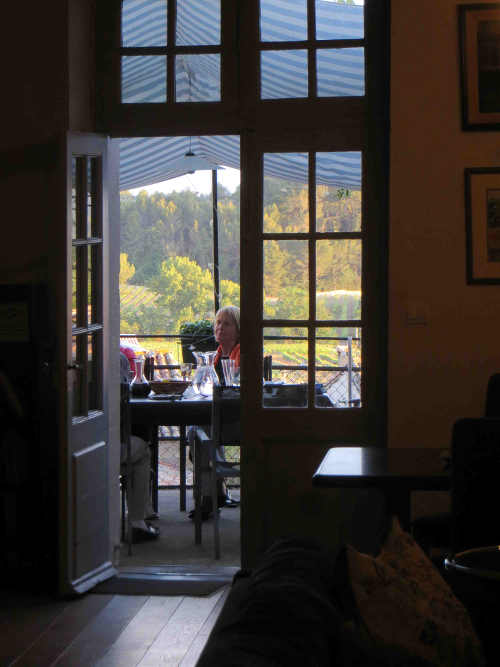
 Euro-Toques chef Martin Dwyer, is much missed in Ireland since he and his wife Sile sold their eponymous restaurant in Waterford and moved to France. They now live in the Languedoc, where they take guests - and feed them very well.
Euro-Toques chef Martin Dwyer, is much missed in Ireland since he and his wife Sile sold their eponymous restaurant in Waterford and moved to France. They now live in the Languedoc, where they take guests - and feed them very well.
This month Martin extols the virtues of an under-rated region, The Languedoc.
The Languedoc is not a region of France which has instant recognition from people outside the area. When I say I’m now living here I have to back it up with saying that we are just 100km from the Spanish borders and about 20km north of the Mediterranean.
There are various regions of France which immediately conjure up pictures in the minds of strangers, the yachts and beaches of the Cote d’Azur, the timbered barns of Normandy, the castles of the Loire but the Languedoc doesn’t really have an image which it projects abroad.
This has possibly something to do with its history and its farming tradition, the Languedoc has for a long time been the largest producer of wine in France and has only got around to developing its tourist potential in the last fifty years or so, or roughly about the time when the competition for the quantity over quality policies of the wine growers of the area started to have serious competition from wine producers in Africa, South America and Australia.
Languedoc has got its act together in both of these areas since then. As a wine growing area there was, with some exceptions, not a great history of quality wine making; but now, less shackled by tradition than the better known areas, they are able to use modern scientific methods and materials to produce wines of true quality and at a fraction of the cost compared to those areas relying on Terroir and a more rigid regime of classification.
It is not unknown for, instance, for wines from the Languedoc to actually name the grapes used on the label, a fact not always visible on the labels of other wines from France. But, as their reliance of large productions of cheap wines became undermined, so have the people of the Languedoc turned, late in the day, to tourism to bolster their incomes.
This fact is, of course, of great advantage to us as our Chambre d’Hote is right in the middle of an area previously unknown to visitors from Ireland and England - and indeed Scandanavian visitors, people from Holland and Belgium and even, not exceptionally, French visitors from the North of the country.
One of our daily jobs here, after breakfast, is to advise and guide people on holiday with us on ways to enjoy their stay. We can send them on tours of the beautiful and unspoilt villages in the Haute Languedoc, villages like Roquebrun and Olargues, or slightly further afield to St. Guilhem le Desert, which was founded by Charlemagne, or to Minerve which was a Cathar stronghold and able to withstand for some time the assault of the crusade against them.
For those who like cities, Montpellier and Carcassonne are both beautiful and completely different, and within an hour away, as indeed are Perpignan and Beziers.
A half hour drive to the south of us leads to a dazzling array of sandy beaches comparable to those of the Riviera but without the same amount of close packed bodies. On the Mediterranean also are beautiful little ports like Collioure and Agde, and the larger port of Sete.
As you can see we are spoiled for choices here in the Languedoc and our visitors constant refrain is “Why have we never heard of these places before ?”
Inevitably people staying with us don’t manage to see all the wonders of the area before they leave. This of course gives us an excuse to suggest that a return visit might be in order.
-------------
 Martin Dwyer started cooking professionally over 40 years ago in the legendary “Snaffles Restaurant” in Dublin. After a time in a Relais Chateau in Anjou and in “The Wife of Bath” in Kent he opened his own much acclaimed restaurant, “Dwyers”, in Waterford in 1989. In 2004 he sold this and moved south to France where he and his wife Síle bought and restored an old presbytery in a village in the Languedoc. They now run Le Presbytère as a French style Chambre d’Hôte. Martin however is far too passionate about food to give up cooking so they now enjoy serving dinner to their customers on the terrace of Le Presbytère on warm summer evenings. Martin runs occasional cookery courses in Le Presbytère and Síle’s brother Colm does week long Nature Strolls discovering the Flora and Fauna of the Languedoc.
Martin Dwyer started cooking professionally over 40 years ago in the legendary “Snaffles Restaurant” in Dublin. After a time in a Relais Chateau in Anjou and in “The Wife of Bath” in Kent he opened his own much acclaimed restaurant, “Dwyers”, in Waterford in 1989. In 2004 he sold this and moved south to France where he and his wife Síle bought and restored an old presbytery in a village in the Languedoc. They now run Le Presbytère as a French style Chambre d’Hôte. Martin however is far too passionate about food to give up cooking so they now enjoy serving dinner to their customers on the terrace of Le Presbytère on warm summer evenings. Martin runs occasional cookery courses in Le Presbytère and Síle’s brother Colm does week long Nature Strolls discovering the Flora and Fauna of the Languedoc.
Le Presbytère can be seen at: www.lepresbytere.net;
email: martin@lepresbytere.net
An Irish Chef in France
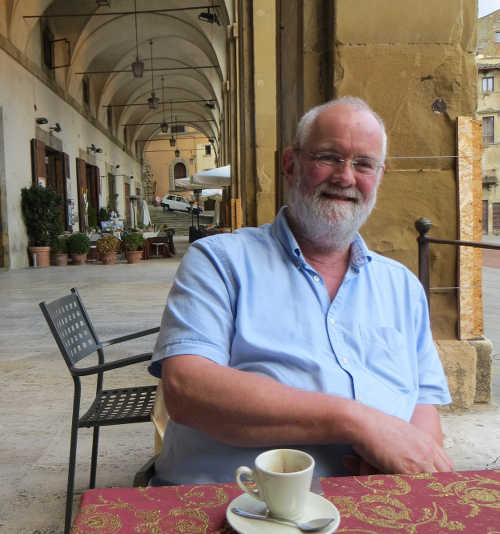
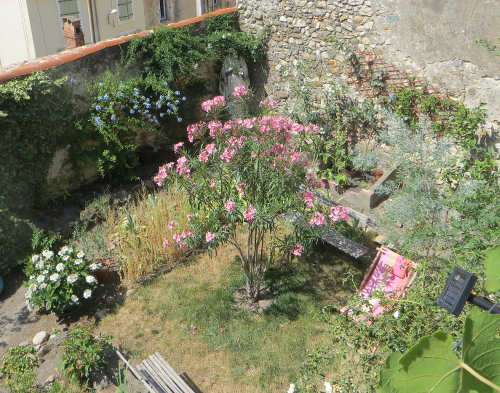
This month Martin recalls a major career change over four decades ago - and the lady who unwittingly played a key role in events at the time
It is now forty two years ago, and about this time of year, when my career path changed for ever.
I had spent a year training to be a teacher, attending Sion Hill Froebel College where I was doing a graduate course for Primary School teaching. I had loathed every minute of the teaching but had reckoned that this was my human lot and that now was the time to knuckle down, join the human race and enjoy a life of “quiet desperation”.
Just before the results came out the Dominican nun who ran the college, a shrewd intelligent woman, summoned me to the college and informed me that I had failed my teaching practice, and further that her (kindly) advice to me was to attempt another career.
I was shattered, I had met my present wife (she was in my class at Sion Hill), I had organised a job in a school (men teachers were rare and popular) and suddenly the rug was pulled from under my feet.
But then the realisation struck me - I no longer had to teach - the world was my oyster - I could do whatever I liked - follow a career in cooking which I loved - and at that moment my heart lifted and to tell the truth it has remained lifted since that day.
The following week saw me, cap in hand, knocking at the door of Snaffles Restaurant in Dublin’s Leeson Street. The proprietor, Nick Tinne (see Emlaghmore Lodge), was delighted with me. Having a degree in English and History he saw as an excellent basis for cooking (he himself had been a Cambridge rowing Blue) and serendipitously he told me that “My girl Trudy is leaving at the end of the week- could you start on Monday?”.
I took to cooking with joy, loved every moment of it (still do) and often thought of the marvellous coincidence of Trudy just heading off at the exact right moment and quietly gave her thanks.
Some years after I heard that a Trudy had opened an eponymous restaurant in Dun Laoghaire and decided (on no evidence whatever) that it was one and the same lady.
Cut forward now through the years to last week on the terrace of Le Presbytère in Thezan les Beziers.
An old friend who was staying, asked if she could bring a couple to dinner one night. “They are Trudy and Tony,” she said. “She had a restaurant in Dun Laoghaire for some years”.
I confess I felt some trepidation - was this going to be the lady who had given me my very first chance behind the stove ?
She wasn’t in the door when I had to ask he if she ever worked in Snaffles - “ Indeed I did.” I had found my Trudy! - and incredibly she spends her life now between the West of Ireland and Faugères, down the road from us in Thezan.
I think she was a little bemused by my gratitude in her leaving her job so conveniently (for me) all those years ago, but all that was lost in terrific remembrances of the Tinnes, and the wonderful waiting staff of Snaffles in the early Seventies.
-------------
 Martin Dwyer started cooking professionally over 40 years ago in the legendary “Snaffles Restaurant” in Dublin. After a time in a Relais Chateau in Anjou and in “The Wife of Bath” in Kent he opened his own much acclaimed restaurant, “Dwyers”, in Waterford in 1989. In 2004 he sold this and moved south to France where he and his wife Síle bought and restored an old presbytery in a village in the Languedoc. They now run Le Presbytère as a French style Chambre d’Hôte. Martin however is far too passionate about food to give up cooking so they now enjoy serving dinner to their customers on the terrace of Le Presbytère on warm summer evenings. Martin runs occasional cookery courses in Le Presbytère and Síle’s brother Colm does week long Nature Strolls discovering the Flora and Fauna of the Languedoc.
Martin Dwyer started cooking professionally over 40 years ago in the legendary “Snaffles Restaurant” in Dublin. After a time in a Relais Chateau in Anjou and in “The Wife of Bath” in Kent he opened his own much acclaimed restaurant, “Dwyers”, in Waterford in 1989. In 2004 he sold this and moved south to France where he and his wife Síle bought and restored an old presbytery in a village in the Languedoc. They now run Le Presbytère as a French style Chambre d’Hôte. Martin however is far too passionate about food to give up cooking so they now enjoy serving dinner to their customers on the terrace of Le Presbytère on warm summer evenings. Martin runs occasional cookery courses in Le Presbytère and Síle’s brother Colm does week long Nature Strolls discovering the Flora and Fauna of the Languedoc.
Le Presbytère can be seen at: www.lepresbytere.net;
email: martin@lepresbytere.net
An Irish Chef in France
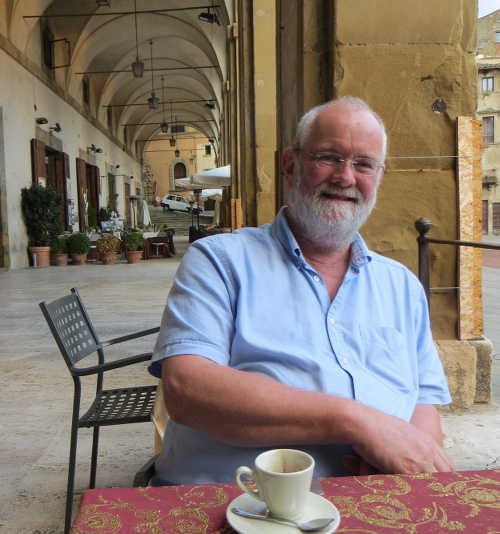
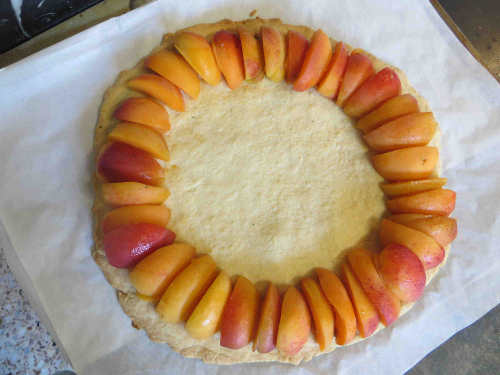 Euro-Toques chef Martin Dwyer, is much missed in Ireland since he and his wife Sile sold their eponymous restaurant in Waterford and moved to France. They now live in the Languedoc, where they take guests - and feed them very well.
Euro-Toques chef Martin Dwyer, is much missed in Ireland since he and his wife Sile sold their eponymous restaurant in Waterford and moved to France. They now live in the Languedoc, where they take guests - and feed them very well.
“Here is a piece for August about a very simple restaurant we ate in in the Aveyron. Common in France thirty years ago these experiences are quite rare now. The images show the progression of the very simple but delicious apricot tart.”
I have been making Tarte Aux Abricots in various ways over many years. I have made them with Frangipane Crème, with Almonds, with Crème Patisserie. I have made them with cooked apricots with bottled ones and with tinned. Most were delicious.
Last week when we were coming back from a brief holiday in the Aveyron over the mountains we happened to get the 12.00 hungers (our appetites have now adapted to the strict French timetable of eating) near the small village of Pleasance.
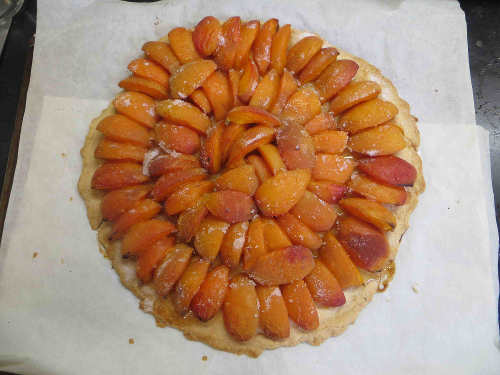 There was a café there which seemed to be doing terrific business judging from the cars parked outside the door, and indeed inside it was very full but Madame managed to find us a free table.
There was a café there which seemed to be doing terrific business judging from the cars parked outside the door, and indeed inside it was very full but Madame managed to find us a free table.
She told us they had no menu - we could just eat the Menu de Jour, basically what everyone else was eating and it would cost €13, including wine and coffee. Fine, we said.
The whole place was run by a family, Mama outside, Papa le Chef in the kitchen and a daughter and a son generally helping out. There were no roles as such though, Madame frequently disappeared into the kitchen and Monsieur just as frequently served at table - but no chaos here, each knew exactly what the other was at and the place ran very smoothly and quickly.
First course M. le Chef arrived out of the kitchen with a bowl of Tuna and Rice Salad which we helped ourselves from, not much to look at but quite delicious.
Next course was an equally generous Rabbit in Mustard sauce - with wonderful creamy mashed potatoes.
Then a generous cheese board was dropped at the table along with another basket of bread. Bear in mind this was costing €13 and we could have had wine included!
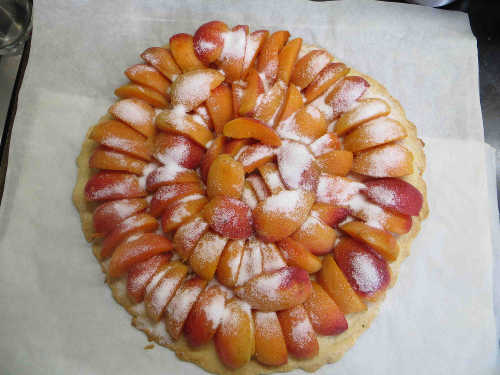 Then, after the cheese, Monsieur arrived out with a slice of his apricot tart. It was delicious and nicely summarises up old Escoffier's dictum to "Faites Simple". I tried cooking it last week myself and decided it was the very best way to cook an Apricot Tart.
Then, after the cheese, Monsieur arrived out with a slice of his apricot tart. It was delicious and nicely summarises up old Escoffier's dictum to "Faites Simple". I tried cooking it last week myself and decided it was the very best way to cook an Apricot Tart.
The recipe is remarkably simple.
Bake a disk of shortcrust pastry until golden brown.
Cover with apricots, sprinkle with sugar.
Bake in a hot oven until it starts to get black at the edges (about 45 minutes)
Eat warm with Crème Anglaise or cream.
-------------
 Martin Dwyer started cooking professionally over 40 years ago in the legendary “Snaffles Restaurant” in Dublin. After a time in a Relais Chateau in Anjou and in “The Wife of Bath” in Kent he opened his own much acclaimed restaurant, “Dwyers”, in Waterford in 1989. In 2004 he sold this and moved south to France where he and his wife Síle bought and restored an old presbytery in a village in the Languedoc. They now run Le Presbytère as a French style Chambre d’Hôte. Martin however is far too passionate about food to give up cooking so they now enjoy serving dinner to their customers on the terrace of Le Presbytère on warm summer evenings. Martin runs occasional cookery courses in Le Presbytère and Síle’s brother Colm does week long Nature Strolls discovering the Flora and Fauna of the Languedoc.
Martin Dwyer started cooking professionally over 40 years ago in the legendary “Snaffles Restaurant” in Dublin. After a time in a Relais Chateau in Anjou and in “The Wife of Bath” in Kent he opened his own much acclaimed restaurant, “Dwyers”, in Waterford in 1989. In 2004 he sold this and moved south to France where he and his wife Síle bought and restored an old presbytery in a village in the Languedoc. They now run Le Presbytère as a French style Chambre d’Hôte. Martin however is far too passionate about food to give up cooking so they now enjoy serving dinner to their customers on the terrace of Le Presbytère on warm summer evenings. Martin runs occasional cookery courses in Le Presbytère and Síle’s brother Colm does week long Nature Strolls discovering the Flora and Fauna of the Languedoc.
Le Presbytère can be seen at: www.lepresbytere.net;
email: martin@lepresbytere.net
An Irish Chef in France
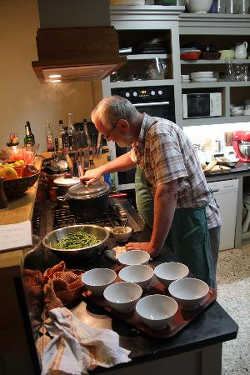
 Euro-Toques chef Martin Dwyer, is much missed in Ireland since he and his wife Sile sold their eponymous restaurant in Waterford and moved to France. They now live in the Languedoc, where they take guests - and feed them very well.
Euro-Toques chef Martin Dwyer, is much missed in Ireland since he and his wife Sile sold their eponymous restaurant in Waterford and moved to France. They now live in the Languedoc, where they take guests - and feed them very well.
This month Martin touches on the thorny subject of Cooking for the French…
It is not the commonest of career choices, to end ones working days as an Irish Chef in France, although the reverse is plainly common.
French chefs have always been common in Ireland and over the years many have run successful restaurants there, we Irish chefs, on the other hand, are not renowned for conquering the French palate.
I accepted this as a disadvantage when I moved here first. I felt that the French were going to be far less keen to risk handing over their taste buds to an Irishman.
This is not a condemnation of Irish cuisine by any means, the fact is that the French know nothing about Irish food and cooking but they associate our style of cooking with that of England and “La Cuisine Brittanique” which they have the utmost contempt for.
They are quick to relate stories of holidays in England – usually thirty odd years ago- where they were fed, they assure me, disgusting food everywhere.
Of course like all widely believed myths there is a small kernel of truth in this and thirty or so years ago on a limited budget (and the French abroad are ALWAYS on a limited budget) you could indeed eat far better in France than in the UK - you still can but these meals are now much harder to find and with the advent of Fast Food outlets the lines between the two countries have become very blurred indeed.
So my first reaction when they discover that I am the chef de cuisine in my own Maison d’Hote is one of disbelief, and they start to ask me what kind of food I actually cook.
It is at this point that, realising the deep dyed prejudices of the French that I usually do a little massaging of the truth.
I tend to tell them that I trained in France (which I did but just for a small part of my training) and that in my own restaurant over the years I cooked mainly French food. (True, even though the French food spoke with a strong Irish accent)
This they find very reassuring.
Then I try to let them catch a glimpse of the Eurotoques charter which is hanging on my wall. They may or may not have heard of Eurotoques, but all will have heard of Paul Bocuse, a national hero in France, whose signature is on the bottom.
All chat about food however, is, we all know, irrelevant because the whole truth about food is that the proof of the pudding is in the eating- to this a would add a little rider- the proof of the pudding is also in the smell.
The French, like us, have a certain amount of stock phrases with which they acknowledge certain experiences. The one they use most on me when they arrive downstairs around aperitif time, is an inevitable : “Ooo la la ce sent bon “- or- something sure smells good.
My small satisfaction at this moment is the appreciation in the voices of my diners as the say this, but more particularly in the deep regret in the tone of the people who have decided to dine elsewhere.
It is amazing how many decide to dine with us the next night once they have had a whiff of the heady scents of roast lamb perfumed with Garrigues herbs, or the piquant scent of a pot full of mussels flavoured with basil and garlic.
I started this piece by saying that I accepted my Irishness as a disadvantage when I came here first- now I know better.
Once I have enticed them up to my table and actually managed to feed them they really are the most appreciative eaters in the world.
One recent comments from a Frenchmen in the visitors book reads “Deux journees de regale pour les papilles“ (two days full of delight for the taste buds) another “une cuisine de reve” (cooking to dream about) these convince me that slowly (very slowly) I am in my own way managing to persuade the average Frenchman that us Irish are, after all, well able to wield the odd pot and pan in the kitchen.
-------------
 Martin Dwyer started cooking professionally over 40 years ago in the legendary “Snaffles Restaurant” in Dublin. After a time in a Relais Chateau in Anjou and in “The Wife of Bath” in Kent he opened his own much acclaimed restaurant, “Dwyers”, in Waterford in 1989. In 2004 he sold this and moved south to France where he and his wife Síle bought and restored an old presbytery in a village in the Languedoc. They now run Le Presbytère as a French style Chambre d’Hôte. Martin however is far too passionate about food to give up cooking so they now enjoy serving dinner to their customers on the terrace of Le Presbytère on warm summer evenings. Martin runs occasional cookery courses in Le Presbytère and Síle’s brother Colm does week long Nature Strolls discovering the Flora and Fauna of the Languedoc.
Martin Dwyer started cooking professionally over 40 years ago in the legendary “Snaffles Restaurant” in Dublin. After a time in a Relais Chateau in Anjou and in “The Wife of Bath” in Kent he opened his own much acclaimed restaurant, “Dwyers”, in Waterford in 1989. In 2004 he sold this and moved south to France where he and his wife Síle bought and restored an old presbytery in a village in the Languedoc. They now run Le Presbytère as a French style Chambre d’Hôte. Martin however is far too passionate about food to give up cooking so they now enjoy serving dinner to their customers on the terrace of Le Presbytère on warm summer evenings. Martin runs occasional cookery courses in Le Presbytère and Síle’s brother Colm does week long Nature Strolls discovering the Flora and Fauna of the Languedoc.
Le Presbytère can be seen at: www.lepresbytere.net;
email: martin@lepresbytere.net
An Irish Chef in France
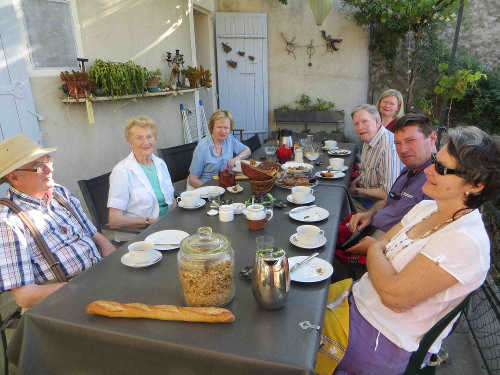
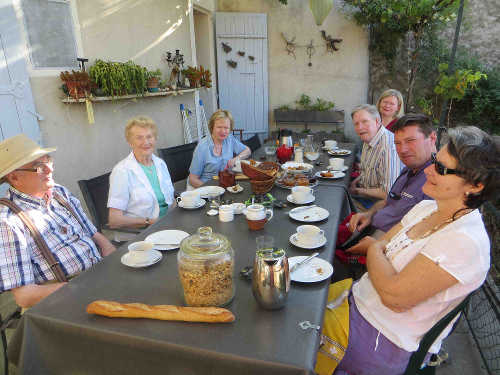 Euro-Toques chef Martin Dwyer, is much missed in Ireland since he and his wife Sile sold their eponymous restaurant in Waterford and moved to France. They now live in the Languedoc, where they take guests - and feed them very well.
Euro-Toques chef Martin Dwyer, is much missed in Ireland since he and his wife Sile sold their eponymous restaurant in Waterford and moved to France. They now live in the Languedoc, where they take guests - and feed them very well.
You couldn’t make it up! This month Martin tells us an extraordinary story about the way an English couple discovered this Languedoc retreat
People find us here in the Languedoc for the strangest of reasons but the following story of a couple who arrived this autumn is probably the most unlikely.
An English couple arrived in the door to us one afternoon, English but with properties in France and in the West of Ireland, I will call them the Johnsons. They accepted our offer of Barry’s tea gratefully and we sat down on the terrace to introduce ourselves.
Then having asked us the usual questions, “What’s an Irish couple doing in France etc.” I then asked them how they had heard of us and what had persuaded them to book in for a few days out of the blue. Mr. Johnson then cleared his throat and proceeded to tell us the saga of The Camper Van.
In England they had invested in a second hand Ford camper van which they had thought to use to explore France. No sooner had they brought the vehicle down to their French abode but she seized up and would only travel in first gear, the local French garage confessed themselves flummoxed and sent it on to the Ford dealer in the nearest town.
They announced that it needs a new gearbox, €4,500 worth of new gear box. Our friends were surprised but decided to proceed as otherwise their entire investment would have been wasted. However there was more news a few days later from the French garage. Having tried all the usual avenues he regretted but he could not source a new gearbox for the van.
The Johnsons then rang their local garage in Ireland’s west and the mechanic told them that he felt he could manage something, if they could get the van back to him. After much negotiation with their travel insurance the Johnsons discovered that they were covered to be repatriated back to a ferry with the van and so hired a car and watched their precious van put on to an ambulance and driven to Cherbourg.
They were able to drive the van on to the ferry (“first gear was working fine”) and had made arrangements to be met at the other side with another ambulance to bring them up west, Mr. Johnson in the ambulance Mrs. in the hired car.
The driver explained early on to Mr. Johnson that they were going to have to detour to Waterford (my old home town) and change drivers as the time in his taco graph was up. So down they headed to Waterford and changed drivers and they headed off on the long road west.
Mr. Johnson and the new driver fell into conversation on the way and he told him about his life and his house in France. The driver in his turn told him about a man who “was a brilliant chef” and a client of his father’s garage who had a restaurant in Waterford but had sold up and headed to the wilds of France to make his fortune fairly late in his life. “He had the best restaurant in Waterford” the driver lamented “and we miss it since he went”.
Mr. Johnson was intrigued and asked the driver the name of this prodigy. “Martin Dwyer” he was told. So when they got back to the west Mr. Johnson determined to find out more of this man, googled him, found him, and on their next trip down south in France (this one) determined to stay with us. At this stage I interrupted him and asked him was the garage owner able to get a new gear box for the van.
“I rang him a few days after we got back” he told me, "and asked him just that."
“Ah the van is all fixed” he said, “it just needed a fill of oil in the gear box - they have a cut out mechanism when the oil gets low there, that’s why it was stuck.” Mr. Johnson only had to pay for the oil.
“Well,” I said,”It was just as well you were so misdiagnosed in France and had to travel back to Ireland”
“Why” said Mr Johnson
“Otherwise you would never have found your way here”
-------------
 Martin Dwyer started cooking professionally over 40 years ago in the legendary “Snaffles Restaurant” in Dublin. After a time in a Relais Chateau in Anjou and in “The Wife of Bath” in Kent he opened his own much acclaimed restaurant, “Dwyers”, in Waterford in 1989. In 2004 he sold this and moved south to France where he and his wife Síle bought and restored an old presbytery in a village in the Languedoc. They now run Le Presbytère as a French style Chambre d’Hôte. Martin however is far too passionate about food to give up cooking so they now enjoy serving dinner to their customers on the terrace of Le Presbytère on warm summer evenings. Martin runs occasional cookery courses in Le Presbytère and Síle’s brother Colm does week long Nature Strolls discovering the Flora and Fauna of the Languedoc.
Martin Dwyer started cooking professionally over 40 years ago in the legendary “Snaffles Restaurant” in Dublin. After a time in a Relais Chateau in Anjou and in “The Wife of Bath” in Kent he opened his own much acclaimed restaurant, “Dwyers”, in Waterford in 1989. In 2004 he sold this and moved south to France where he and his wife Síle bought and restored an old presbytery in a village in the Languedoc. They now run Le Presbytère as a French style Chambre d’Hôte. Martin however is far too passionate about food to give up cooking so they now enjoy serving dinner to their customers on the terrace of Le Presbytère on warm summer evenings. Martin runs occasional cookery courses in Le Presbytère and Síle’s brother Colm does week long Nature Strolls discovering the Flora and Fauna of the Languedoc.
Le Presbytère can be seen at: www.lepresbytere.net;
email: martin@lepresbytere.net
An Irish Chef in France
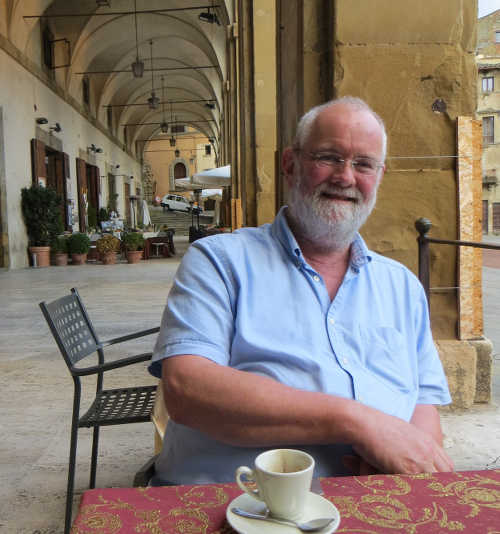
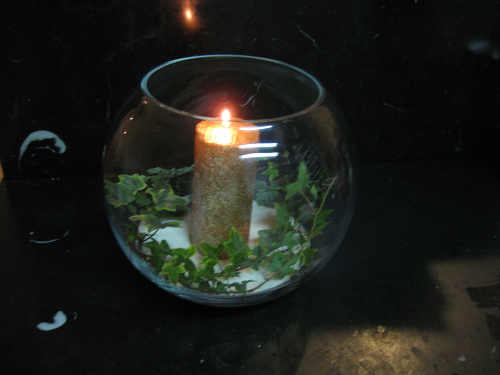 Euro-Toques chef Martin Dwyer, is much missed in Ireland since he and his wife Sile sold their eponymous restaurant in Waterford and moved to France. They now live in the Languedoc, where they take guests - and feed them very well.
Euro-Toques chef Martin Dwyer, is much missed in Ireland since he and his wife Sile sold their eponymous restaurant in Waterford and moved to France. They now live in the Languedoc, where they take guests - and feed them very well.
Plus ca change…. This month Martin tells us about the rituals and traditions of the Dwyer Christmas
Christmas for me has always been a time when the rituals, the traditions, however recently invented, are observed.
As a child in Cork, and the youngest of seven children, I was put in a most favourable position. Our tradition there was that no decorations put on walls, no tree, no lights, no holly until the youngsters (always me) went to bed on Christmas Eve.
That meant that for us not only was there the stomach churning excitement of the arrival of the presents from Santa but also there was the total amazement of coming down stairs on Christmas morning to see the house transformed into a Christmas grotto.
There were however some strict rules which were observed. The main one of these was that the room where the tree was, underneath which all the presents were stashed, was taboo until after breakfast, mass and until Granny had arrived.
That was a tough one. These were the big presents. Our offerings from Santa while exciting were really stocking fillers, sweets, some tiny toys and always a tangerine (that’s what we called them then) in the toe.
The Tree moment would produce all sorts of goodies. I remember a moment when there was a tiny puppy lined up for me, and another occasion when the present was a new tweed suit (with short pant legs) which (I was a bit of a dandy then) did not disappoint me in the least.
Once the pre-tree formalities had been endured we were lined up at the door, always youngest first, and then (I do blush a little at this) we all held hands and danced around the tree singing “Here we go round the Mulberry Bush” before the wonderful distribution of the presents began.
This was all stretched out exceedingly by having an appointed “ Present Caller”, he (it was usually my eldest brother) would be responsible to announce each present and only then were we allowed to start opening it. With seven children, two parents and myriad uncles, aunts and grannies this could take some time (you do the maths) but the excruciating anticipation was always well worthwhile.
After that it was off to my Granny Dwyer’s house for lunch , then back home for dinner, with probably upwards of twenty to thirty adults in our house that night. There we would get glimpses of how badly our aunts and uncles could behave. I remember one uncle’s paper hat being set on fire by another before being doused by a soda water fountain by a third.
I don’t think I have ever managed to hit those high moments of hedonism for my childrens’ Christmas celebrations - on reflection this is probably just as well, but I have managed to impose some of my family traditions on our celebrations.
Santa has always in our house played a minor role - I reckon we were too selfish to allow the credit for our purchase of toys to be allotted to some guy from the north pole - he just gave the usual stocking fillers and yes, always the orange in the toe of the stocking.
We also always insisted on the Christmas tree ritual, no presents until after breakfast. Breakfast has also changed quite a lot since our Rashers and Eggs with tea in the fifties. We now have the luxury of Scrambled Eggs with Smoked Salmon and this we eat with Bucks Fizz (maybe the old Cork traditions are resurfacing here too).
And now we only manage one dinner, and that in the late afternoon.
Strangely, it is my daughters who have remained adamant that not a single bit of these rituals be changed even as they get older and, of course now that there are two grandsons to be introduced to the mix it is very unlikely that they ever will be.
It is only with the greatest difficulty that I managed to persuade and cajole them to let me change from Turkey to Goose about five years ago.
This year is one of our favoured years and they are all coming out to us in France to celebrate Christmas. I am as excited about this as I used to be as a six year old trying to get to sleep on Christmas Eve.
The way the French celebrate Christmas is, especially in their culinary traditions, different to ours. Their main feast is on Christmas Eve night and then they indulge in all sorts of shellfish; lobsters, prawns and oysters.
Obviously there is no way that I am going to get away with this travesty being presented as Christmas Dinner to my tradition loving family so I now have to do what any self-respecting émigré chef would and observe both culinary traditions.
So it’ll be Lobster and Prawns for Dinner on Christmas Eve and Goose and Ham with all the trimmings on Christmas Day. I can’t wait!
-------------
 Martin Dwyer started cooking professionally over 40 years ago in the legendary “Snaffles Restaurant” in Dublin. After a time in a Relais Chateau in Anjou and in “The Wife of Bath” in Kent he opened his own much acclaimed restaurant, “Dwyers”, in Waterford in 1989. In 2004 he sold this and moved south to France where he and his wife Síle bought and restored an old presbytery in a village in the Languedoc. They now run Le Presbytère as a French style Chambre d’Hôte. Martin however is far too passionate about food to give up cooking so they now enjoy serving dinner to their customers on the terrace of Le Presbytère on warm summer evenings. Martin runs occasional cookery courses in Le Presbytère and Síle’s brother Colm does week long Nature Strolls discovering the Flora and Fauna of the Languedoc.
Martin Dwyer started cooking professionally over 40 years ago in the legendary “Snaffles Restaurant” in Dublin. After a time in a Relais Chateau in Anjou and in “The Wife of Bath” in Kent he opened his own much acclaimed restaurant, “Dwyers”, in Waterford in 1989. In 2004 he sold this and moved south to France where he and his wife Síle bought and restored an old presbytery in a village in the Languedoc. They now run Le Presbytère as a French style Chambre d’Hôte. Martin however is far too passionate about food to give up cooking so they now enjoy serving dinner to their customers on the terrace of Le Presbytère on warm summer evenings. Martin runs occasional cookery courses in Le Presbytère and Síle’s brother Colm does week long Nature Strolls discovering the Flora and Fauna of the Languedoc.
Le Presbytère can be seen at: www.lepresbytere.net;
email: martin@lepresbytere.net
An Irish Chef in France
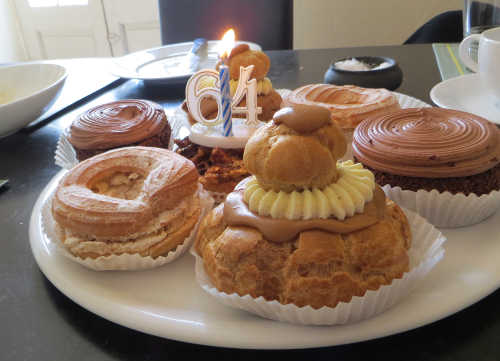
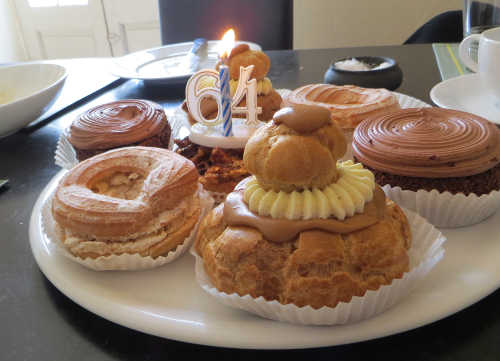 Euro-Toques chef Martin Dwyer, is much missed in Ireland since he and his wife Sile sold their eponymous restaurant in Waterford and moved to France. They now live in the Languedoc, where they take guests - and feed them very well.
Euro-Toques chef Martin Dwyer, is much missed in Ireland since he and his wife Sile sold their eponymous restaurant in Waterford and moved to France. They now live in the Languedoc, where they take guests - and feed them very well.
Martin frequently gets asked what does he miss from Ireland, or what does he find better out in France and this has inspired him to make out two lists: Ten Foodie Things Which Ireland/France do Better
Those which Ireland does better.
1. Fish.
It is a case of “Thank God we are surrounded by water” in Ireland. Down here by the Mediterranean we suffer from much depleted stocks, prime fish like Turbot and Brill are rare and prohibitively expensive.
2. Bread
This one is not going to be popular with the French but the French have an over reliance on the Baguette, a suspect loaf as far as I am concerned, how can one have as one’s daily bread a loaf at its best for only an hour or two? Also there is no good Brown Wholewheat bread here, I discovered that the French discard the coarse wheat chaff (the best bit.)
3. Cappuccino
The French have a notion that sweetened whipped cream improves a Cappuccino. It doesn’t.
4. Tea
This is one of France’s total failures. Firstly they do not make it on boiling water. Secondly the tea is not of good quality. Where are the Barry’s when you need them ?
5. Floury Potatoes.
Plain boiled potatoes, roast potatoes and the best mash potatoes are better made with an Irish “Ball of Flour”. Difficult if not impossible to find in France.
6. Fresh Milk
Fresh milk is a given in Ireland, all shops no matter how humble will have a daily delivery. Here only the better Supermarkets stock milk fresh and the French have developed a remarkable ability to stomach UHT.
7. Crackers for Cheese
Bread is preferred with Cheese here, all well and good except when one has eaten a big dinner after which only the crisp crack of a water biscuit will hit the mark with one’s smearing of ripe Camembert.
8. Curry
I suppose because the French did not have the colonial relationship with India as the Brits did they never got familiar with this type of food. They really don’t do Curries and use the spice in a totally different way.
9. Rhubarb
Sad soft bunches of rhubarb make an appearance in the “Exotic” section of our local supermarket from time to time. These are roughly four times what one would pay for a bigger bunch in Ireland. Enough said.
10. Bacon.
They just don’t do good joints of bacon for boiling and glazing here. They cut them into cubes instead and use them to savour their Daubes and Coq au Vins.
Ten Foodie things which France does Better.
1. Meat.
Our village butcher shares an abattoir with his brother in the next village, he brings his own Lamb down from the Massif Centrale where his relatives farm it and he will not sell me meat, even though hanging in his cold room, unless he reckons that it has hung for long enough. I know that Irish butchers are leaping and bounding upwards but they still have a bit to go to match my man.
2.Patisseries.
Nearly every local boulangerie, no matter how small, will produce enticing trays of patisseries, Croissants, Pain au Chocolate, Pain au Raisins and exotic looking Choux and whipped cream confections along with superb glazed tarts.
3.Supermarkets.
I actually think that Irish Supermarkets (with the notable exception of Ardkeen Stores in Waterford) have dropped in quality since I left for France seven years ago. Still none have Cheese, Fresh Fish and Traiteur counters to compare with their opposite numbers here in France.
4. Summer Fruits
This is an area where the climate of Southern France gives it the edge. The quality of the Apricots, White and Yellow Peaches, Plums of every colour, Nectarines of every shape and style, delectable sweet juicy Melons is to die for.
5. Offal.
People enjoy and eat offal here in France and every Supermarket and Butchery stall in a market will have a supply of Lambs Kidneys, Sweetbreads, Brains and Tripe, plus Duck and Chicken Livers. Stuff like this I often had to order well in advance in Ireland.
6. School Lunches.
The son of some French friends, who is a structural engineer, told us that the Spec for a school canteen kitchen was identical to that for a three star hotel. Couple that with the fact that, every week our local primary sends out the lunch menus for the coming week to the parents for approval.
7. Non Floury Potatoes.
This is where the French make a draw of the potato war. They do love a good waxy spud. These are certainly the best for a good sauté potato but especially for those potato dishes cooked in the oven like a Pommes Anna but most especially for their triumph : Gratin Dauphinoise.
8. Wine.
Yes, no argument here.
9. Jambon.
The French dry cured Ham is of remarkably high standard here - and other areas beside Bayonne produce good stuff. I think it is the dampness of the Irish weather which makes the air dried curing impossible.
10. Café, Café.
The French do enjoy their little Cafés and their tiny cups of strong hot coffee (ask for express by the way, not espresso). It has been my experience that nearly all bars and even the humblest of village will be able to produce a decent brew. (Just don’t ask for tea).
-------------
 Martin Dwyer started cooking professionally over 40 years ago in the legendary “Snaffles Restaurant” in Dublin. After a time in a Relais Chateau in Anjou and in “The Wife of Bath” in Kent he opened his own much acclaimed restaurant, “Dwyers”, in Waterford in 1989. In 2004 he sold this and moved south to France where he and his wife Síle bought and restored an old presbytery in a village in the Languedoc. They now run Le Presbytère as a French style Chambre d’Hôte. Martin however is far too passionate about food to give up cooking so they now enjoy serving dinner to their customers on the terrace of Le Presbytère on warm summer evenings. Martin runs occasional cookery courses in Le Presbytère and Síle’s brother Colm does week long Nature Strolls discovering the Flora and Fauna of the Languedoc.
Martin Dwyer started cooking professionally over 40 years ago in the legendary “Snaffles Restaurant” in Dublin. After a time in a Relais Chateau in Anjou and in “The Wife of Bath” in Kent he opened his own much acclaimed restaurant, “Dwyers”, in Waterford in 1989. In 2004 he sold this and moved south to France where he and his wife Síle bought and restored an old presbytery in a village in the Languedoc. They now run Le Presbytère as a French style Chambre d’Hôte. Martin however is far too passionate about food to give up cooking so they now enjoy serving dinner to their customers on the terrace of Le Presbytère on warm summer evenings. Martin runs occasional cookery courses in Le Presbytère and Síle’s brother Colm does week long Nature Strolls discovering the Flora and Fauna of the Languedoc.
Le Presbytère can be seen at: www.lepresbytere.net;
email: martin@lepresbytere.net
Twitter: www.twitter.com/DwyerThezan
An Irish Chef in France
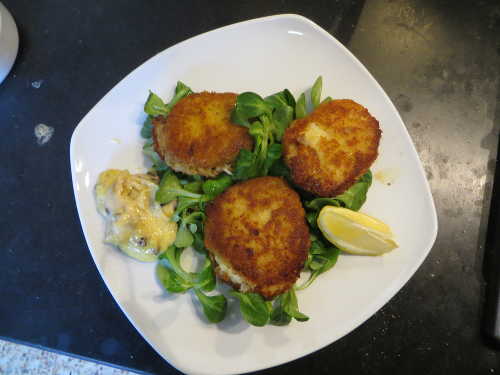
 Euro-Toques chef Martin Dwyer, is much missed in Ireland since he and his wife Sile sold their eponymous restaurant in Waterford and moved to France. They now live in the Languedoc, where they take guests - and feed them very well.
Euro-Toques chef Martin Dwyer, is much missed in Ireland since he and his wife Sile sold their eponymous restaurant in Waterford and moved to France. They now live in the Languedoc, where they take guests - and feed them very well.
This month Martin bravely takes on preparation of one of the great dishes of the area where they have settled: Salt Cod
I decided I should tackle Brandade de Morue, a classic dish of the area where the home of its excellence is Nimes, little more than an hour away from us on the motorway.
I have eaten and enjoyed it often but for some reason or other, (possibly fear of the unfood looking nature of it lying there on the shelf) I have yet to take Salt Cod - Morue in French - home and cook it.
Now I know all about its history, have read and enjoyed Mark Kurlansky's eponymous book which explained how the Catholic insistence on fish on Fridays may well have changed the history of the world.
The strange thing is that in Catholic Ireland we no longer eat salt cod. The preserved fish of choice would be smoked (Cod, Haddock, Ling) which one might well find in country areas in Ireland on the counter of the local shop, unrefrigerated, on a Friday in my youth.
Several times I have read exactly how to tackle this unappealing piece of white solid matter but always baulked. The directions were usually to soak it in several changes of water for some days until it (more or less) reconstituted itself, but were never quite precise enough for me.
I bought myself David Lebovitz's My Paris Kitchen for Christmas, a super book and ideal for an ex-pat in France. Now he, even younger than me and from further away, not only tackles Morue but also gives detailed direction on how to do it.
He does offer the alternative of putting it in the toilet - the cistern I add- and there the normal flushing action of a family will de-salt it in the fullness of time (24 hours or so), or else to soak it in the fridge for 24 hours and there to change the water three times.
Shame drove me to the fish counter in my local Super U and the purchase is pictured. I opted for the fridge method. For one thing French toilets (unlike Irish ones) have to be dismantled by plumbers of skill to get to the cistern.
I think that I can admit that my first excursion into the unknown world of Salt Cod was a success.
Pictured are little fritters which I made from Salt Cod and, I will most certainly make these again.
Recipe for Salt Cod Fritters:
700g salt cod 700g potatoes peeled and diced 8 plump garlic cloves - chopped fine or squeezed a couple of sprigs of thyme 200ml olive oil 200ml. crème fraiche generous use of the pepper mill beaten egg and breadcrumbs for the fritters.
Cut the cod into large pieces and soak it in the fridge for at least 24 hours changing the water 3 or 4 times.
Put the chopped garlic into a small pot with the oil and thyme and bring it up to a boil, then take it off and let it cool. Put the drained cod in a pot with the potato and cover with fresh water and cook it for about 30 mts.
Now check for tenderness, I found I had to take the thinner pieces of the cod out first and last to cook to tender were the potatoes.
As soon as the cod is cool, flake it and remove any skin and any bones. Beat the cod and potatoes together (a mixer with a flat blade is ideal) and, while it is beating add alternately the oil with the garlic (discard the thyme) and the crème fraiche. It will all come together as a creamy mass like some mashed potato. Pepper it liberally but it won't need salt.
This is the Brandade De Morue, to serve it in the traditional manner, put into an oven proof dish, or individual dishes, about half of the mixture (keep the other half for the fritters) and sprinkle the top with crumbs. Bake for about 20 minutes until brown and serve with toast.
To make the fritters, form the Brandade into balls and leave these to dry on a tray in the fridge (this way the individual balls form a skin which makes the next step much easier). Dip these in egg wash and bread crumbs and brown off both sides, in batches (keep warm in a warm oven) and serve with a piece of lemon and some mayonnaise with olives and capers.
It is delicious, even Madame, not a Brandade person, enjoyed hers.
-------------
 Martin Dwyer started cooking professionally over 40 years ago in the legendary “Snaffles Restaurant” in Dublin. After a time in a Relais Chateau in Anjou and in “The Wife of Bath” in Kent he opened his own much acclaimed restaurant, “Dwyers”, in Waterford in 1989. In 2004 he sold this and moved south to France where he and his wife Síle bought and restored an old presbytery in a village in the Languedoc. They now run Le Presbytère as a French style Chambre d’Hôte. Martin however is far too passionate about food to give up cooking so they now enjoy serving dinner to their customers on the terrace of Le Presbytère on warm summer evenings. Martin runs occasional cookery courses in Le Presbytère and Síle’s brother Colm does week long Nature Strolls discovering the Flora and Fauna of the Languedoc.
Martin Dwyer started cooking professionally over 40 years ago in the legendary “Snaffles Restaurant” in Dublin. After a time in a Relais Chateau in Anjou and in “The Wife of Bath” in Kent he opened his own much acclaimed restaurant, “Dwyers”, in Waterford in 1989. In 2004 he sold this and moved south to France where he and his wife Síle bought and restored an old presbytery in a village in the Languedoc. They now run Le Presbytère as a French style Chambre d’Hôte. Martin however is far too passionate about food to give up cooking so they now enjoy serving dinner to their customers on the terrace of Le Presbytère on warm summer evenings. Martin runs occasional cookery courses in Le Presbytère and Síle’s brother Colm does week long Nature Strolls discovering the Flora and Fauna of the Languedoc.
Le Presbytère can be seen at: www.lepresbytere.net;
email: martin@lepresbytere.net
Twitter: www.twitter.com/DwyerThezan
An Irish Chef in France
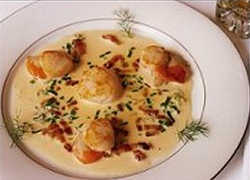
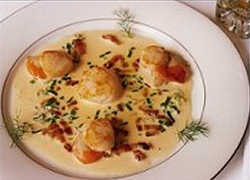 Euro-Toques chef Martin Dwyer, is much missed in Ireland since he and his wife Sile sold their eponymous restaurant in Waterford and moved to France. They now live in the Languedoc, where they take guests - and feed them very well.
Euro-Toques chef Martin Dwyer, is much missed in Ireland since he and his wife Sile sold their eponymous restaurant in Waterford and moved to France. They now live in the Languedoc, where they take guests - and feed them very well.
This month Martin enjoys a blast from the past and the story of how a new dish was born: Scallops Torrades
About twelve years ago, in 2003, Euro-Toques Ireland asked would I be part of the team of chefs to go to Brussels to cook some typically Irish dishes in the European House of Parliament . This was for an annual event, organised by Euro-Toques, in which member countries could showcase their native dishes at what they called a cocktail party.
Euro-Toques had asked myself, Brid Torrades from Sligo and Ross Lewis of Chapter One in Dublin to cook and present the food at this event. Ross, who was our Commissioner General at the time, had to cry off at the last minute due to illness so all that remained was Brid, myself and a large insulated coffin sized box of the very best of Irish food and drink.
After some adventures and payment of an additional €250 to Ryanair for excess baggage for the coffin, we struggled into the parliament building and unloaded our box in the vast kitchens where all the preparations were to happen.
I think it was only then that we realised that we had no notion what on earth we were going to do with the food in the coffin. It wasn’t until we opened it that we knew for sure what was inside. Ross had of course painstakingly gathered together the most wonderful fresh Irish ingredients but the recipes of how they were to be put together were with him in his sick bed in Dublin.
In the meantime we were surrounded by splendid activity as 12 European countries’ teams of chefs busied themselves getting ready their dishes for the party. These were serious teams, some like the Italians had as many as 12 members, some like the Germans had dirndl clad madchen to serve their food, the Belgians even had a Hot Chocolate Fountain which they were assembling. We had to think fast and on our feet if we weren’t going to disgrace our native land.
On examination the coffin was full of the most fantastic goodies. There were wonderful farmhouse cheeses, no problem with them they could stand alone, as could the bottles of Baileys Irish Cream and the 12 year old Irish Malt Whiskey, the wild smoked Salmon just had to be sliced and put out on trays, but, what were we going to do with the bags of scallops, still beautifully fresh and smelling of the sea.
Ross had mentioned something about wrapping them in rashers of bacon and grilling them. That notion seemed just too fiddly to Brid and myself, and would the delicate scallops be over cooked by the time the bacon was crisp?
A combination of Brid, Myself and Desperation (an even more maternal agent than necessity in the conception of inventions) came up very quickly with the method of cooking the scallops.
We diced and crisped the streaky rashers on a good heat and put to one side. We trimmed the scallops and used the trimmings to make a stock. Then we seared the scallops on a hot pan, deglazed with some 12 year old Irish Whiskey, added some cream which we had wheedled from the parliament chefs and then reduced until thickened and so was born one of the most delicious methods of cooking scallops that I know.
I’m not alone in this, we created quite a stir at the “Cocktail” with our scallops dish. There was a queue at all times at the Irish Stand as the word got around about the “ delicieux Coquilles St Jacques Irlandaise”.
In the end despite our chronic lack of manpower the Irish stand made a very creditable showing. We even managed to get a good press as the Fine Gael MEP Mary Banotti, who had been at a cookery class I had run, brought over all her MEP friends to sample our wares and created the kind of buzz around the Irish stand which made even the press interested.
A good chef is an economical person and there was no way that this delicious method of cooking scallops was going to be let die on one, admittedly fairly illustrious, outing.
Back in Waterford and in the kitchen in Dwyers I decided to put this method of cooking scallops on my menu. As Brid Torrades was certainly the second parent of this dish (and Desperation the midwife) I thought I should call it after her. So Scallops Torrades was born.
It was a hit, also it made a great talking point with customers, who only had to say “What does Torrades mean?” to be given the full story. I even created variations on the “Torrades” theme with dishes like Turbot Torrades which was poached turbot served with the same scallops.
It has also travelled well. Type “Torrades” into Google and the first hit you will get will be my recipe. Type in “Scallops Torrades” and you will see that it has featured in restaurants as far afield as Hong Kong and Michigan. Do I mind? Not at all. I’m flattered and delighted.
Ten years ago Brid and myself were again asked to cook in the Brussels Parliament house for the “Euro-Toque Cocktail”. No need to tell you, I’m sure, that we brought copious supplies of scallops, bacon and whiskey (Jameson’s 12 year old this time.)
This time we had Abigail Colleran, Bocuse d’Or Prize winner, and Brid’s daughter Fiona to help us so it was much less fraught and we did know in advance what we were going to cook. Scallops Torrades was again a great success.
The crowning moment of the day was when the Euro-Toque general secretary of the time, Bernard Fournier, came around with the EU fisheries minister and stopped at our stand. “Ah!” they said “The wonderful Irish Scallops and whiskey dish” (as they tucked in). “It is such a wonderful traditional dish isn’t it” Brid and I nodded mutely.
-------------
 Martin Dwyer started cooking professionally over 40 years ago in the legendary “Snaffles Restaurant” in Dublin. After a time in a Relais Chateau in Anjou and in “The Wife of Bath” in Kent he opened his own much acclaimed restaurant, “Dwyers”, in Waterford in 1989. In 2004 he sold this and moved south to France where he and his wife Síle bought and restored an old presbytery in a village in the Languedoc. They now run Le Presbytère as a French style Chambre d’Hôte. Martin however is far too passionate about food to give up cooking so they now enjoy serving dinner to their customers on the terrace of Le Presbytère on warm summer evenings. Martin runs occasional cookery courses in Le Presbytère and Síle’s brother Colm does week long Nature Strolls discovering the Flora and Fauna of the Languedoc.
Martin Dwyer started cooking professionally over 40 years ago in the legendary “Snaffles Restaurant” in Dublin. After a time in a Relais Chateau in Anjou and in “The Wife of Bath” in Kent he opened his own much acclaimed restaurant, “Dwyers”, in Waterford in 1989. In 2004 he sold this and moved south to France where he and his wife Síle bought and restored an old presbytery in a village in the Languedoc. They now run Le Presbytère as a French style Chambre d’Hôte. Martin however is far too passionate about food to give up cooking so they now enjoy serving dinner to their customers on the terrace of Le Presbytère on warm summer evenings. Martin runs occasional cookery courses in Le Presbytère and Síle’s brother Colm does week long Nature Strolls discovering the Flora and Fauna of the Languedoc.
Le Presbytère can be seen at: www.lepresbytere.net;
email: martin@lepresbytere.net
Twitter: www.twitter.com/DwyerThezan
An Irish Chef in France
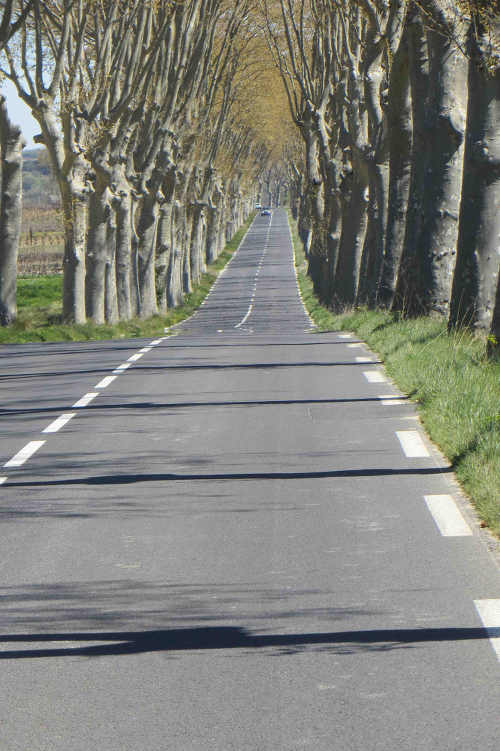
 Euro-Toques chef Martin Dwyer, is much missed in Ireland since he and his wife Sile sold their eponymous restaurant in Waterford and moved to France. They now live in the Languedoc, where they take guests - and feed them very well.
Euro-Toques chef Martin Dwyer, is much missed in Ireland since he and his wife Sile sold their eponymous restaurant in Waterford and moved to France. They now live in the Languedoc, where they take guests - and feed them very well.
This month: On being an Irishman in France
It is very difficult to discover what the French people really think of us - they have a lot of different notions about Ireland.
Their first reaction often, is to describe us as English, when we inevitably bridle at that they say blithely - “Well but you are Anglo-Saxon aren’t you?” I usually explain - with some venom - that if I am Anglo Saxon then they are Belgian - not something that they aspire to.
There is another reaction which amazes us, we who think that the sun sets and rises on the Emerald Isle. This is that some do not have a single notion about what Ireland is or where it might be. One visitor looking at a watercolour in our living room of the beach in Dunmore East said in puzzlement “But do you have the sea in Ireland?” We think she imagined that Ireland was a landlocked Baltic state.
I do think it is fair to say that as a nation the French haven’t spent a long time worrying about the “Irish Question” and how - with a few exceptions (which I will come back to) - they have but a shadowy picture of Ireland as a wet green rocky placed attached on to a holiday park called Le Connemara.
I should perhaps here say that this is not an attitude generally held throughout France but here in the Languedoc. In Brittany for example they have a very close knowledge of their Celtic cousins and there is a lot of intercommunication in terms of culture, music and indeed fishing. (In our local fishing village of Dunmore East in Waterford there are at least three Breton/Dunmore marriages).
But to get back to the exceptions, there are in fact, here in the Languedoc two outstanding factors about Ireland with which the natives are fully conversant.
One is the music, Irish music is thought of extremely highly and much performed by choirs and musical groups. Our local village in Thezan this year celebrated St. Patrick’s Day with an excellent concert of Irish songs and tunes. They even managed to dance a passable version of the Walls of Limerick and the Stack of Barley.
But the second, and the most important reason that the people from Languedoc know about Ireland is, of course, Le Rugby. When we tell rugby fans that we are Irish their first question is from which part. The answer of Cork, or Waterford or Dublin leaves them impatient. “No, no, they say, is it Munster, Leinster or Connaught?”
It is a delight to be able to claim Munster but it does leave me with a bit of a dilemma. As the seventh child in a hugely sporty family I always ignored all games, particularly Rugby which was compulsory in my Cork school.
Now I find that I am trying to brush up on my limited knowledge of the game, especially before I visit the chemist who has never missed France playing away in Dublin.
I did get a little sweet revenge last week when, just after Ireland won the championship, I had a set of five “Rugbymen” staying; they were having a reunion of their college team in the village.
Half way through their breakfast I brought them a basket of my own Irish Brown Bread, a bit of an acquired taste in France. “Now,” I said “eat this all up and you too might get to win like Ireland”. They had the grace to laugh, but they ate all the bread.
-------------
 Martin Dwyer started cooking professionally over 40 years ago in the legendary “Snaffles Restaurant” in Dublin. After a time in a Relais Chateau in Anjou and in “The Wife of Bath” in Kent he opened his own much acclaimed restaurant, “Dwyers”, in Waterford in 1989. In 2004 he sold this and moved south to France where he and his wife Síle bought and restored an old presbytery in a village in the Languedoc. They now run Le Presbytère as a French style Chambre d’Hôte. Martin however is far too passionate about food to give up cooking so they now enjoy serving dinner to their customers on the terrace of Le Presbytère on warm summer evenings. Martin runs occasional cookery courses in Le Presbytère and Síle’s brother Colm does week long Nature Strolls discovering the Flora and Fauna of the Languedoc.
Martin Dwyer started cooking professionally over 40 years ago in the legendary “Snaffles Restaurant” in Dublin. After a time in a Relais Chateau in Anjou and in “The Wife of Bath” in Kent he opened his own much acclaimed restaurant, “Dwyers”, in Waterford in 1989. In 2004 he sold this and moved south to France where he and his wife Síle bought and restored an old presbytery in a village in the Languedoc. They now run Le Presbytère as a French style Chambre d’Hôte. Martin however is far too passionate about food to give up cooking so they now enjoy serving dinner to their customers on the terrace of Le Presbytère on warm summer evenings. Martin runs occasional cookery courses in Le Presbytère and Síle’s brother Colm does week long Nature Strolls discovering the Flora and Fauna of the Languedoc.
Le Presbytère can be seen at: www.lepresbytere.net;
email: martin@lepresbytere.net
Twitter: www.twitter.com/DwyerThezan
An Irish Chef in France
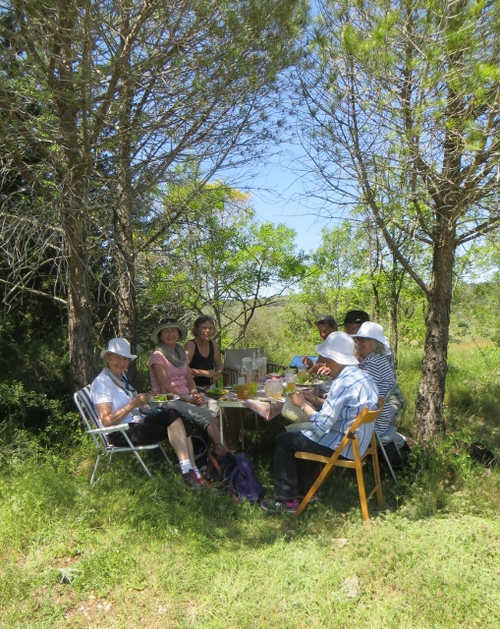
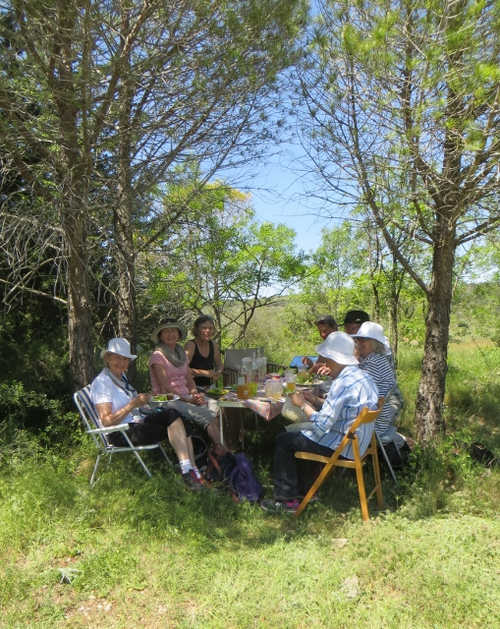 Euro-Toques chef Martin Dwyer, is much missed in Ireland since he and his wife Sile sold their eponymous restaurant in Waterford and moved to France. They now live in the Languedoc, where they take guests - and feed them very well.
Euro-Toques chef Martin Dwyer, is much missed in Ireland since he and his wife Sile sold their eponymous restaurant in Waterford and moved to France. They now live in the Languedoc, where they take guests - and feed them very well.
This month: Martin shares his love of a good al fresco meal and shows us How To Do A Proper Picnic
I am, let me confess it now, a nerd when it comes to picnics. I do enjoy them immensely but only when they are properly done.
The first thing I will require are a table and chairs, these can be provided by the local council in the form of a wooden table with integral benches, or a camping table and chairs brought by yourself but I insist on being able to eat comfortably, and to be able to balance my plate on a level surface while balancing my bottom on another.
The next essential on the Dwyer picnic is a tablecloth; this applies to either using the council table or your own. This does not have to be starched white linen (unless this is your desire) but a clean piece of cotton; we use an old bedspread very successfully. Napkins of some sort or other are even more essential outdoors than in and here (and here only) will I concede to the use of paper napkins or even (sotto voce) a torn off strip of kitchen roll.
Now we come to the thorniest problem, what food to provide and here I have to come down very firmly against sandwiches. Sandwiches, convenience food at its most convenient, should be eaten only when you haven’t got time or space for anything else, stuck in the car or office over lunch for instance. While enjoying a Déjeuner sur l’herbe, al fresco, the ultimate in leisurely feasts, these morsels of convenience should be taboo.
Instead my choice would be for a salade composée, one where all the pieces were sufficiently finely chopped that they could be eaten easily with a fork with only occasional help from a knife.
You will have realised that therefore plates, knives, and forks must be provided for each guest. If you cannot think of an appropriate salad here, fear not because I am going to provide you with my Great Aunt Agnes’s Salad, perfect for these and other occasions, at the end of this piece.
With the salad composée I would add a good starchy salad, potato, rice or couscous, and something fresh and refreshing like crisp lettuce or sweet tomatoes cut and ready to serve but do not dress them until just before serving.
Vinaigrette can be carried in a well-sealed bottle. (Another trick which the French use for al fresco dinners is to put some vinaigrette in the bottom of a sealed box, cover this with dry lettuce and then mix all together just before eating.)
The rest of the meal should be simplicity itself. Little morsels of a firm cheese like Comte or Gubbeen can be handed around and finally some fresh fruit (nothing too messy) can be served.
Coffee is optional, only if you own a good thermos flask and some CHINA cups which you will be forgiven for breaking. Otherwise to drink during the meal I would recommend some cold apple juice diluted with sparkling water unless of course you have the services of a chauffeur in which case a good chilled sparkling wine would be satisfying.
Bon Appetit !
Great Aunt Agnes’s Salad
1 large chicken (or 1kg of turkey meat, leg for preference)
1 head of celery
225g/8oz grapes (seedless for convenience, red for appearance)
175g/6 oz streaky rashers
Mayonnaise:
3 egg yolks
280ml/10 oz. sunflower oil
1 tbs. lemon juice
salt and pepper
Cover the chicken or turkey with cold water in a large pot and bring it to a rolling boil. Gently simmer for an hour then cut into the thigh to test that it is cooked through. Once satisfied that it's cooked take it off the heat and let it cool in the water. (This method of cooking keeps the chicken beautifully moist.)
When cool, drain the chicken of the stock (keep this in the freezer for soup) and then take the chicken off the bone and discard the bones and the skin.
Chop this meat up roughly. Cut the rashers into little pieces and fry in a hot pan until brown and crispy, drain well on kitchen paper and add to the chicken.
Cut the celery into small pieces and add to the chicken.
Halve the grapes and discard the seeds and add them in.
Beat the yolks up well with the lemon and seasoning and then dribble in the oil (an electric beater is a great help at this stage) continue dribbling in the oil until it is gone and the mayonnaise is "a thick and yellow ointment"
Fold this into the chicken mixture. (If you push it into a bowl lined with cling film it can be unmoulded successfully and makes a great centrepiece for a picnic).
Et voilà!
-------------
 Martin Dwyer started cooking professionally over 40 years ago in the legendary “Snaffles Restaurant” in Dublin. After a time in a Relais Chateau in Anjou and in “The Wife of Bath” in Kent he opened his own much acclaimed restaurant, “Dwyers”, in Waterford in 1989. In 2004 he sold this and moved south to France where he and his wife Síle bought and restored an old presbytery in a village in the Languedoc. They now run Le Presbytère as a French style Chambre d’Hôte. Martin however is far too passionate about food to give up cooking so they now enjoy serving dinner to their customers on the terrace of Le Presbytère on warm summer evenings. Martin runs occasional cookery courses in Le Presbytère and Síle’s brother Colm does week long Nature Strolls discovering the Flora and Fauna of the Languedoc.
Martin Dwyer started cooking professionally over 40 years ago in the legendary “Snaffles Restaurant” in Dublin. After a time in a Relais Chateau in Anjou and in “The Wife of Bath” in Kent he opened his own much acclaimed restaurant, “Dwyers”, in Waterford in 1989. In 2004 he sold this and moved south to France where he and his wife Síle bought and restored an old presbytery in a village in the Languedoc. They now run Le Presbytère as a French style Chambre d’Hôte. Martin however is far too passionate about food to give up cooking so they now enjoy serving dinner to their customers on the terrace of Le Presbytère on warm summer evenings. Martin runs occasional cookery courses in Le Presbytère and Síle’s brother Colm does week long Nature Strolls discovering the Flora and Fauna of the Languedoc.
Le Presbytère can be seen at: www.lepresbytere.net;
email: martin@lepresbytere.net
Twitter: www.twitter.com/DwyerThezan
An Irish Chef in France
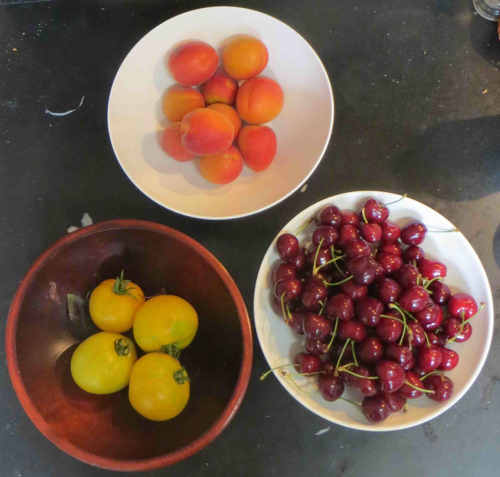
 Euro-Toques chef Martin Dwyer, is much missed in Ireland since he and his wife Sile sold their eponymous restaurant in Waterford and moved to France. They now live in the Languedoc, where they take guests - and feed them very well.
Euro-Toques chef Martin Dwyer, is much missed in Ireland since he and his wife Sile sold their eponymous restaurant in Waterford and moved to France. They now live in the Languedoc, where they take guests - and feed them very well.
This month: Martin extols the joys of the mouthwateringly delicious summer fruits in the South of France
The end of May and the beginning of June are the most exciting months on the culinary calendar here in the South of France because this is the time when the summer fruits come into season.
Everyone gets just a little excited when this happens, you know when the canny old market ladies are excited because they spend ten minutes tut tutting over the price of the first cherries, but then buy them anyway.
Cherries are the first fruits to come in, first from Spain which, considering you can see the Pyrenees from our terrace is not so far away and I think carry a permitted amount of air miles.
The first from France come from Ceret, again just down the road, and these are balls of sweet juice which explode in the mouth and every year I think I have never tasted anything as good as the first mouthful.
When we used to come to France only for our summer holidays, when my wife was teaching in a primary school in Waterford, it was a race to get the last of the cherries when we arrived down in July.
Next in are the Apricots, I think I never tasted a fresh Apricot until I bought them in France. Apricots are fruits which are a little more reluctant to deliver their flavour than, let us say, the cherries are.
They require a little encouragement, a very quick poaching in the lightest of syrups; they totally blossom when baked briefly in a hot oven and have over the years built up such a strong friendship with almonds that the Apricot and Almond Tart has become a cliché, but what a wonderful cliché!
The very last of the Cherries actually come in after the Apricots have arrived. These are bright yellow with some red streaks and are called Napoleons. My first encounter with these was one afternoon when we were driving along the Haut Languedoc when we saw a man at a gate selling something from a box.
We stopped (always stop in France when someone is selling by the side of the road!) and saw a box full of these cherries. We asked how much, he looked at us in the eye and said “You can have the whole lot for five Euro - I have been here all afternoon and these are the last we have”
We took them (there was at least five kilos there) and made not only the best cherry jam ever - the Napoleons have a delicious almondy bitterness - but had enough left over to make some excellent Cherry Ratafia. Needless to mention we have never been able to find that man since but this year we will try again.
Sometimes it is not as easy as that to buy fruit. On our way back from Perpignan airport by back roads a few years ago we happened on an Apricot farm. Now Apricot jam is to the French what Marmalade is to the Irish.
Monsieur had five kilo boxes of Apricots in his shed selling for a reasonable five Euros the box. I picked one up and headed off to pay him.
“What are you going to use them for” he asked. When I told them they were for jam he shook his head. “Have you a cellar in your house” he asked. When told that I had he took me to the back of the shed and showed me other, marginally less ripe apricots. “These are only three Euro the box” he told me, “but you must let them ripen in the cellar for a full week before you use them” Then he made me repeat this before he would sell them to me.
Before the Apricots finish however, my favourite of all the soft fruits of summer arrive - the Peaches. Peaches here come in many varieties (especially if you include Nectarines) but principally they are White or Yellow and for me, in any contest the white wins hands down every time.
My Mother was so passionate about the flavour of the white peach that it became the principal crop, with the tomato, of our glass house in Cork when I was a child. However I discovered that these Cork peaches were but an elusive shadow of the flavour of the white peach which has ripened under the Mediterranean sun.
When these arrive (and they arrived this week) there is only one way that I will eat them. First they deserve due ceremony so put them on a plate and get out your best fruit knife and fork. They must be carefully peeled, de-stoned and sliced before being eaten slowly, with the fork and a napkin in hand to mop up the copious juices and to pat your watering mouth.
Ambrosia was certainly these fruits.
-------------
 Martin Dwyer started cooking professionally over 40 years ago in the legendary “Snaffles Restaurant” in Dublin. After a time in a Relais Chateau in Anjou and in “The Wife of Bath” in Kent he opened his own much acclaimed restaurant, “Dwyers”, in Waterford in 1989. In 2004 he sold this and moved south to France where he and his wife Síle bought and restored an old presbytery in a village in the Languedoc. They now run Le Presbytère as a French style Chambre d’Hôte. Martin however is far too passionate about food to give up cooking so they now enjoy serving dinner to their customers on the terrace of Le Presbytère on warm summer evenings. Martin runs occasional cookery courses in Le Presbytère and Síle’s brother Colm does week long Nature Strolls discovering the Flora and Fauna of the Languedoc.
Martin Dwyer started cooking professionally over 40 years ago in the legendary “Snaffles Restaurant” in Dublin. After a time in a Relais Chateau in Anjou and in “The Wife of Bath” in Kent he opened his own much acclaimed restaurant, “Dwyers”, in Waterford in 1989. In 2004 he sold this and moved south to France where he and his wife Síle bought and restored an old presbytery in a village in the Languedoc. They now run Le Presbytère as a French style Chambre d’Hôte. Martin however is far too passionate about food to give up cooking so they now enjoy serving dinner to their customers on the terrace of Le Presbytère on warm summer evenings. Martin runs occasional cookery courses in Le Presbytère and Síle’s brother Colm does week long Nature Strolls discovering the Flora and Fauna of the Languedoc.
Le Presbytère can be seen at: www.lepresbytere.net;
email: martin@lepresbytere.net
Twitter: www.twitter.com/DwyerThezan
An Irish Chef in France
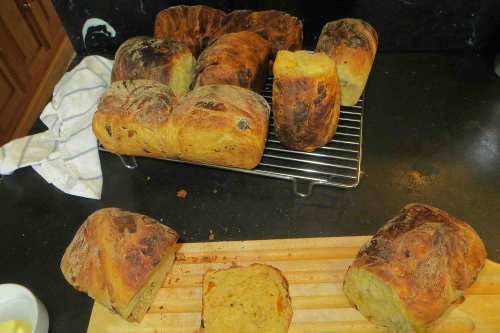
 Euro-Toques chef Martin Dwyer, is much missed in Ireland since he and his wife Sile sold their eponymous restaurant in Waterford and moved to France. They now live in the Languedoc, where they take guests - and feed them very well.
Euro-Toques chef Martin Dwyer, is much missed in Ireland since he and his wife Sile sold their eponymous restaurant in Waterford and moved to France. They now live in the Languedoc, where they take guests - and feed them very well.
This month Martin shares his unique Pain Fruité du Presbytère
This is a case of necessity being the mother of invention.
I had a problem, especially a winter one, in that I wanted to put something with a bit of a wow factor on the Presbytère breakfast table, particularly in those months when the summer apricots and peaches had departed.
I had made classic French Brioche from time to time but it is impossibly calorific, pumped full of butter and eggs and, even though delicious, difficult to get consistently right . There is a much lighter brioche in Provence called Pompe à l’Huile, which is extremely good but not really breakfast food.
Now we have a great tradition in Ireland of adding raisins to a white soda loaf and adding in some raisins or currants the resulting loaf was called a “Curranty Bread” and treated like cake, well spread with butter, to be eaten with the cup of tea as a dessert or a snack
Sile suggested that my mother’s Curranty Bread, basically a scone mix with currants added, would be a good idea but somehow this seemed a bit too Irish - and anyway (I know this is heresy in an Irishman ) I much prefer breads risen with yeast than those using bicarbonate of soda (or its first cousin baking powder).
So I decided to try a variation of my Mother’s Fruity Loaf but base it on a yeast dough – and further more I decided to use far more and different fruit than she did. Here in France we have access to excellent Prunes from Agen (only up the road) Apricots from Greece and Dates from the north of Africa, all sound Mediterranean choices.
There was a tradition in Ireland that fruit bread and scones had very little fruit indeed, this I remember particularly on any of my (very rare) visits to a convent where the nuns would triumphantly produce their version of the height of decadence; Curranty Bread, which was so careful with the fruit that we used to call it Bicycle Cake on the basis that if you were lucky enough to find one raisin you would then need a bike to find the next one.
But I digress.
With the intention of making this bread as easy to make as possible I decided to make a sort of Fruit Fougasse, the Provençal Fougasse is an Olive Oil flatbread with (often) Olives and Anchovies in the dough, which is yeast leavened but not kneaded and so extremely easy to make.
This was not a success, the quantity of fruit I added was too heavy for the yeast to work properly and the resulting flat bread was I think more closely related to Nougat than bread, not the stuff from which memorable breakfasts are made.
Attempt the second was far more successful, I used much the same ingredients as I had for the Fougasse but this time I followed the directions for making the Provençal Pompe à l’Huile.
This is a hell of a bread, sweet (but without sugar), light, and interesting. The oil keeps it very moist without being at all fatty and the dough (for those of you old enough) is a fairly good imitation of the stuff in the original Bewley’s Cherry Buns. Great Stuff.
Here is the final recipe. I have given enough for ten small loves because it freezes perfectly
Pain Fruité for Ten Small Loaves
120g fresh yeast (or five 15g sachets of dried yeast)
550ml warm water 18cl olive oil
5 eggs
2 teaspoons salt
grated zest of 2 oranges
1500g strong flour 100g candied orange peel (chopped)
100g prunes (halved)
100g dates (stoned and halved)
100g dried apricots (halved)
100g sultanas
Dissolve the yeast into some of the measured water.
Put this somewhere warm and, when completely liquid and frothy, top up to the desired amount of water with more warm water.
Add in the olive oil, and beat in the eggs.
Grate the orange zest into the flour and add in the salt.
Now add in the yeast mixture and then blend together roughly with your hand. Add in all the fruit and knead roughly together in the bowl until it comes together in a ball.
Tip it out on a floured top and knead for five minutes.
Weigh the dough and then divide by ten (should be about 3 ¼ Kgs giving 10 x 325g)
Knead together each of these ten pieces into balls and put two each into five well oiled 1kg loaf tins.
Cover with a tea towel and leave to rise for another hour or so - they should rise well over the top of the tins.
Set the oven to 190º C, 375º F, Gas 5 and cook at this temperature for about 40 minutes.
Slip the loaf out of the tin and cook for another 10 minutes at the same temperature.
Break each loaf in two as you take it from the tin and let them cool on a wire rack.
Have this for breakfast (or dinner or tea), with or without butter or jam. It will freeze beautifully and toast well (but watch the pieces of fruit which can char in the toaster).
-------------
 Martin Dwyer started cooking professionally over 40 years ago in the legendary “Snaffles Restaurant” in Dublin. After a time in a Relais Chateau in Anjou and in “The Wife of Bath” in Kent he opened his own much acclaimed restaurant, “Dwyers”, in Waterford in 1989. In 2004 he sold this and moved south to France where he and his wife Síle bought and restored an old presbytery in a village in the Languedoc. They now run Le Presbytère as a French style Chambre d’Hôte. Martin however is far too passionate about food to give up cooking so they now enjoy serving dinner to their customers on the terrace of Le Presbytère on warm summer evenings. Martin runs occasional cookery courses in Le Presbytère and Síle’s brother Colm does week long Nature Strolls discovering the Flora and Fauna of the Languedoc.
Martin Dwyer started cooking professionally over 40 years ago in the legendary “Snaffles Restaurant” in Dublin. After a time in a Relais Chateau in Anjou and in “The Wife of Bath” in Kent he opened his own much acclaimed restaurant, “Dwyers”, in Waterford in 1989. In 2004 he sold this and moved south to France where he and his wife Síle bought and restored an old presbytery in a village in the Languedoc. They now run Le Presbytère as a French style Chambre d’Hôte. Martin however is far too passionate about food to give up cooking so they now enjoy serving dinner to their customers on the terrace of Le Presbytère on warm summer evenings. Martin runs occasional cookery courses in Le Presbytère and Síle’s brother Colm does week long Nature Strolls discovering the Flora and Fauna of the Languedoc.
Le Presbytère can be seen at: www.lepresbytere.net;
email: martin@lepresbytere.net
Twitter: www.twitter.com/DwyerThezan
An Irish Chef in France

 Euro-Toques chef Martin Dwyer, is much missed in Ireland since he and his wife Sile sold their eponymous restaurant in Waterford and moved to France. They now live in the Languedoc, where they take guests - and feed them very well.
Euro-Toques chef Martin Dwyer, is much missed in Ireland since he and his wife Sile sold their eponymous restaurant in Waterford and moved to France. They now live in the Languedoc, where they take guests - and feed them very well.
This month Martin enjoys the search for interesting old practical items in France, when out ‘Brocanting’
I suppose because France was historically a more affluent country than Ireland they have always embraced second hand goods. They have never felt there was any shame in acquiring other peoples cast offs.
This of course takes many forms.
At the top of the second hand tree are the “Antiquities” these are the antique shops which would have a place in the smart old quarters of the cities, would usually have a very few tasteful items displayed in their windows and can often be horrendously expensive. You are extremely unlikely to pick up a bargain here as these people know their stuff.
Next come the “Brocantes”, or what I suppose we would call Junk Shops.
These would usually be a dusty muddle of second hand objects, everything from retro items from the fifties and sixties (these do nothing for me as they are far too redolent of my childhood) to older bric-a-brac and then (what I am looking for) sometimes the genuine chance of finding a true antique.
A sort of parallel order of shops, and one that is still common in France, are the “Trocantes”. The Irish equivalent of these shops would be the Pawn Shop, very much a dying breed in Ireland since my youth. I remember in Cork when I was growing up there were several and all were decorated with their emblem of three hanging spheres.
The system in the Trocantes is that they rely on the public to bring in their old and discarded pieces of furniture or bric-a-brac. The seller and the shop then decide on a price (from which the Trocanteur takes a hefty percentage).
This price will then drop over the weeks the object remains unsold so if you really desire an object you have to visit the shop frequently hit the right moment to buy at the best price - or risk losing the sale.
But by far the best place to get a bargain are at the many fairs that happen all year around in rural France. It is here that you come across the bottom of the second hand tree, the “Vide Greniers”. This literally means the empty attic and this is often exactly what is for sale there.
Vide Greniers are usually manned by ordinary house holders and take place on a Saturday or a Sunday. They are frequented by people looking for a bargain for their house and usually would have stalls full of well laundered clothes, particularly children’s clothes, which the French see no shame at all in buying.
But what draws me to these Vide Greniers is that sometimes buried in the old clothes and retro bric-a-brac there is to be found a genuine bargain.
Just last year I saw a beautiful collection of a dozen cut crystal champagne glasses which I recognised as coming from Nancy in Lorraine. The stall holder looked at them doubtfully when I asked the price of the twelve and suggested twelve euro for the lot. Needless to mention I snapped them up, I would have happily spent about twenty five euros for each one.
Probably the greatest pleasure I get out of my “Brocanting” is that there can actually be a practical application to my great pleasure of browsing the markets. As the proprietor of a French Chambre d’Hote I can often use these purchases for my guests.
In fact all the glasses in which I serve the drinks to my guests are the products of Brocantes or Vide Greniers and it is satisfying to see that these glasses- and some would be a hundred years old - are still being used for what their makers intended.
-------------
 Martin Dwyer started cooking professionally over 40 years ago in the legendary “Snaffles Restaurant” in Dublin. After a time in a Relais Chateau in Anjou and in “The Wife of Bath” in Kent he opened his own much acclaimed restaurant, “Dwyers”, in Waterford in 1989. In 2004 he sold this and moved south to France where he and his wife Síle bought and restored an old presbytery in a village in the Languedoc. They now run Le Presbytère as a French style Chambre d’Hôte. Martin however is far too passionate about food to give up cooking so they now enjoy serving dinner to their customers on the terrace of Le Presbytère on warm summer evenings. Martin runs occasional cookery courses in Le Presbytère and Síle’s brother Colm does week long Nature Strolls discovering the Flora and Fauna of the Languedoc.
Martin Dwyer started cooking professionally over 40 years ago in the legendary “Snaffles Restaurant” in Dublin. After a time in a Relais Chateau in Anjou and in “The Wife of Bath” in Kent he opened his own much acclaimed restaurant, “Dwyers”, in Waterford in 1989. In 2004 he sold this and moved south to France where he and his wife Síle bought and restored an old presbytery in a village in the Languedoc. They now run Le Presbytère as a French style Chambre d’Hôte. Martin however is far too passionate about food to give up cooking so they now enjoy serving dinner to their customers on the terrace of Le Presbytère on warm summer evenings. Martin runs occasional cookery courses in Le Presbytère and Síle’s brother Colm does week long Nature Strolls discovering the Flora and Fauna of the Languedoc.
Le Presbytère can be seen at: www.lepresbytere.net;
email: martin@lepresbytere.net
Twitter: www.twitter.com/DwyerThezan
An Irish Chef in France
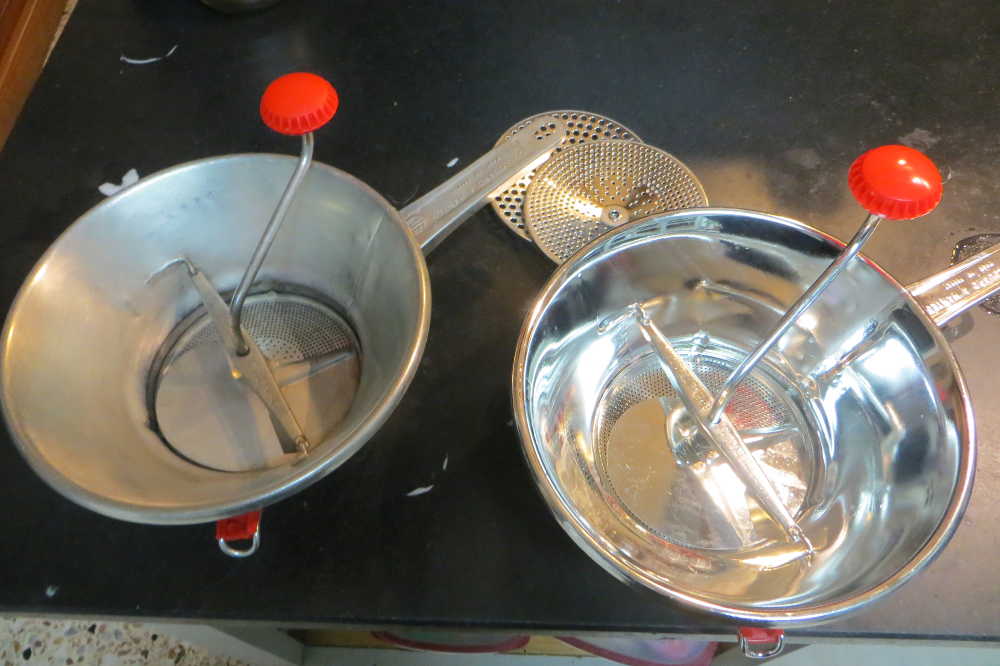

This month: Martin extols the virtues of an heroic piece of low-tech kitchen equipment - his Passe-Légumes
When I started to cook first, in my sister’s kitchen in the very early seventies, this machine , which we called the Mouli after the people who had made it, was an essential kitchen tool. It predates and held the place of a liquidiser and a food processor and did most of the jobs that these machines would later usurp.
And so, as these electric machines came into my kitchen my mouli got used less and less, it always held one function, all potatoes for mashed potatoes in Dwyers Restaurant were pushed through the mouli, I have a horror of lumpy mash and none was served in my establishment unless passed by this man, or his tougher brother the sieve.
When I moved out to France first I was keeping two kitchens going and it took a while for the heavier equipment to follow me out. It was then that I noticed the machine on the left in my local Super U, coming in at around €20 it was considerably cheaper than the electric boys.
It was then that I began to realise all the things my Passe-Légumes (to give it its proper French name) could do that my liquidiser couldn't.
Take tomato sauce. How much easier it is just to push the cooked tomatoes through the Mouli that to go through the tedious process of skinning and de-seeding? Tomatoes pushed through a Mouli just leave a neat and virtually dry pile of skins and seeds on top of the blade.
Then I began to realise the many other jobs which my old friend excelled in: The Passe-Légumes made totally string-less and smooth as velvet celery soup, it could produce both blackberry and raspberry jam totally without those annoying pips which stick relentlessly in your teeth.
On the savoury line this man was still a winner. Chicken Liver Parfait, passed through the Mouli’s finest blade had a smooth unctuousness that neither the processor nor the liquidiser could deliver.
However it was during the Autumn in the Languedoc when my Mouli had his finest hour.
In the late Autumn there is a great harvest of quinces on the hedgerows around the village and I had taken to making up a large quantity of Quince Paste from these. This paste is very commonly made here and sold in the marked as Cotignac, it is exactly the same as the Spanish and Portuguese Membrillo and its chief use (for me at any rate) is on the cheese board where it particularly good with goat’s cheese and the local sheep’s cheese which is the well known Roquefort.
My original recipe called for peeling the quinces for this (a thankless task as quinces are far tougher to peel than apples) then core them, then put the peels and cores in a muslin bag to boil up with the fruit until it softens.
It was the second time I was starting this labour when I had the idea of getting my Mouli to do the job for me. All I had to do was to quarter the quinces, boil till soft and then pass through the Mouli. Job time nearly halved.
You may be wondering why there are two Pass Legumes in the picture? The answer is simple. Over time the machine does get a bit worn, the grating blades do lose their edge, and so yesterday I went and bought a new model, exactly the same as the last and for just over €20 still, nine years later. Not a bad investment for nine years of use.
-------------
 Martin Dwyer started cooking professionally over 40 years ago in the legendary “Snaffles Restaurant” in Dublin. After a time in a Relais Chateau in Anjou and in “The Wife of Bath” in Kent he opened his own much acclaimed restaurant, “Dwyers”, in Waterford in 1989. In 2004 he sold this and moved south to France where he and his wife Síle bought and restored an old presbytery in a village in the Languedoc. They now run Le Presbytère as a French style Chambre d’Hôte. Martin however is far too passionate about food to give up cooking so they now enjoy serving dinner to their customers on the terrace of Le Presbytère on warm summer evenings. Martin runs occasional cookery courses in Le Presbytère and Síle’s brother Colm does week long Nature Strolls discovering the Flora and Fauna of the Languedoc.
Martin Dwyer started cooking professionally over 40 years ago in the legendary “Snaffles Restaurant” in Dublin. After a time in a Relais Chateau in Anjou and in “The Wife of Bath” in Kent he opened his own much acclaimed restaurant, “Dwyers”, in Waterford in 1989. In 2004 he sold this and moved south to France where he and his wife Síle bought and restored an old presbytery in a village in the Languedoc. They now run Le Presbytère as a French style Chambre d’Hôte. Martin however is far too passionate about food to give up cooking so they now enjoy serving dinner to their customers on the terrace of Le Presbytère on warm summer evenings. Martin runs occasional cookery courses in Le Presbytère and Síle’s brother Colm does week long Nature Strolls discovering the Flora and Fauna of the Languedoc.
Le Presbytère can be seen at: www.lepresbytere.net;
email: martin@lepresbytere.net
Twitter: www.twitter.com/DwyerThezan
An Irish Chef in France


Euro-Toques chef Martin Dwyer, is much missed in Ireland since he and his wife Sile sold their eponymous restaurant in Waterford and moved to France. They now live in the Languedoc, where they take guests - and feed them very well.
This month: A Plea for Vegetables
As Christmas comes round again and I inevitably start planning on making it really easy this year (this never works) my mind runs to all the foods which have become a compulsory addition to the table for Christmas dinner and I start thinking of the ones I could discreetly eliminate.
In the Christmases in my immediate past the following seem to have become an essential part of the table. To start with there has to be smoked salmon, just served with brown bread and lemon- but of course copious amounts, I mean you don’t stint at Christmas do you?
And then the main course - the chef d’oeuvre has to be the bird, and this in itself, in our house, always leads to controversy. Having insisted on turkey over the years I decided to take my life in my hands a few years ago and produce a goose.
This turned out to be a bit of a mixed success. There was no doubting the superiority of the goose meat over the turkey’s and the crispness of the shiny brown skin, but, even though Christmas Day was a winner we all missed out on the post Christmas turkey, those wonderful cooking free days when one was able to have it in sandwiches, and reheated and even in a salad.
The second essential Christmas meat is The Ham, which must be boiled tender and then finished in the oven while the turkey is resting, and glazed with honey and mustard and cloves.
But to get back to the Christmas table, ours has always been groaning with vegetables. We must, of course, have roast potatoes, with crisp skins (and in our case spiced with turmeric and cumin) and then also Christmas would never be Christmas if we didn’t have a mountain of white, butter infused, mashed potatoes.
Then there is the controversial sprout, in our case shredded and cooked with garlic and lardons which makes it acceptable to most, but for those few others an alternative must be arranged, and the best candidate seems to be red cabbage, cooked sweet and sour with apples, redcurrant jelly and a dash of balsamic.
That celery (in traditional white sauce) must be present goes without saying, but that completes the meat and veg, more or less, so then one can concentrate on the sauces.
The Gravy, is of course essential, as is bread sauce for the turkey and nowadays (our one concession to America) we have to have cranberry sauce also. So just add a selection of mustards (to help the ham go down) and the table is more or less there.
To get right back to my starting point, every year I start thinking of the bits I can rule out, the obvious candidate seems the vegetables. How could we possibly need five dishes of vegetables on the Christmas table?
My defence is the same as the Left Over Turkey Defence. In those relaxed cooking free days after Christmas these can be reheated and the cook can continue to slouch by the fire and sip his claret. The one exception is of course the roast potatoes but then, they are so delicious that there are never any left for Stephen’s Day.
So, even with the groaning table of Christmas day, vegetables can have a most useful function, and so this, brings me back to the title of this piece, a Plea for Vegetables.
In the last ten or twelve years in Ireland, and I suspect even longer in France, we have seen the decline and finally the disappearance of vegetables served in vegetable dishes with main courses. Nowadays one tends to see vegetables served really as a garnish, one exquisitely turned Pomme Fondant, a tiny timbale of Dauphinoise, a small pyramid of intricately placed julienne of carrots or a chiffonade of shredded parsnip looking like Barbie’s hair.
When I ran my restaurant in Waterford (and it is now twelve years since I did) we always served four separate dishes of vegetables with each table.
There was (and of course is still) a real logic in this: Everyone has a different sized appetite (rugby players managing slightly more than models) and the veg dish is a great thing to either refuse or indulge in. It is simple isn’t it? Then why is it no longer done ? I rest my case - but have a happy Christmas!
-------------
 Martin Dwyer started cooking professionally over 40 years ago in the legendary “Snaffles Restaurant” in Dublin. After a time in a Relais Chateau in Anjou and in “The Wife of Bath” in Kent he opened his own much acclaimed restaurant, “Dwyers”, in Waterford in 1989. In 2004 he sold this and moved south to France where he and his wife Síle bought and restored an old presbytery in a village in the Languedoc. They now run Le Presbytère as a French style Chambre d’Hôte. Martin however is far too passionate about food to give up cooking so they now enjoy serving dinner to their customers on the terrace of Le Presbytère on warm summer evenings. Martin runs occasional cookery courses in Le Presbytère and Síle’s brother Colm does week long Nature Strolls discovering the Flora and Fauna of the Languedoc.
Martin Dwyer started cooking professionally over 40 years ago in the legendary “Snaffles Restaurant” in Dublin. After a time in a Relais Chateau in Anjou and in “The Wife of Bath” in Kent he opened his own much acclaimed restaurant, “Dwyers”, in Waterford in 1989. In 2004 he sold this and moved south to France where he and his wife Síle bought and restored an old presbytery in a village in the Languedoc. They now run Le Presbytère as a French style Chambre d’Hôte. Martin however is far too passionate about food to give up cooking so they now enjoy serving dinner to their customers on the terrace of Le Presbytère on warm summer evenings. Martin runs occasional cookery courses in Le Presbytère and Síle’s brother Colm does week long Nature Strolls discovering the Flora and Fauna of the Languedoc.
Le Presbytère can be seen at: www.lepresbytere.net;
email: martin@lepresbytere.net
Twitter: www.twitter.com/DwyerThezan
An Irish Chef in France
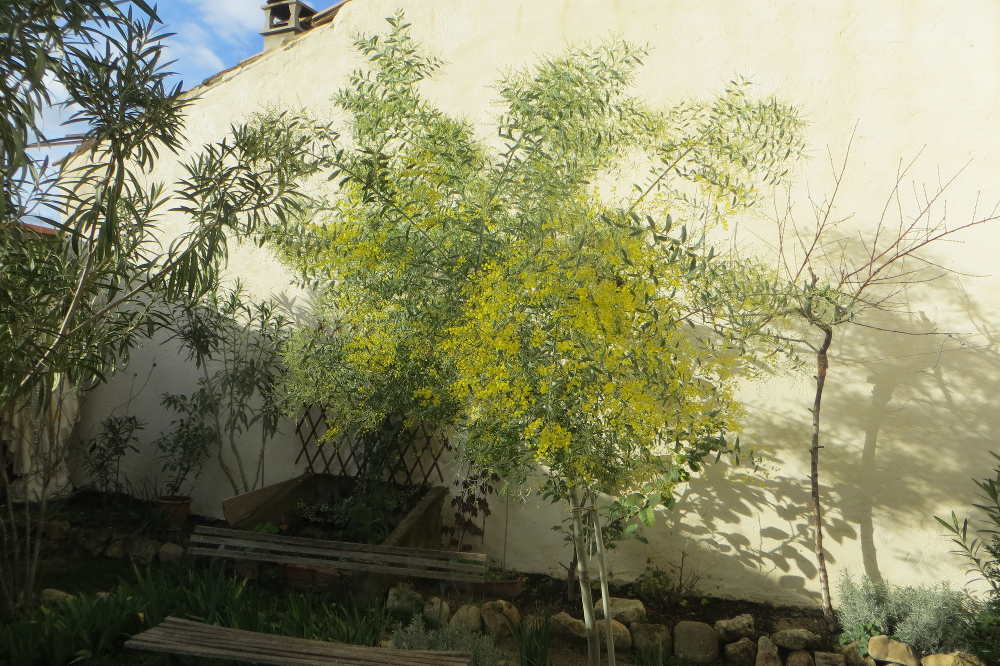
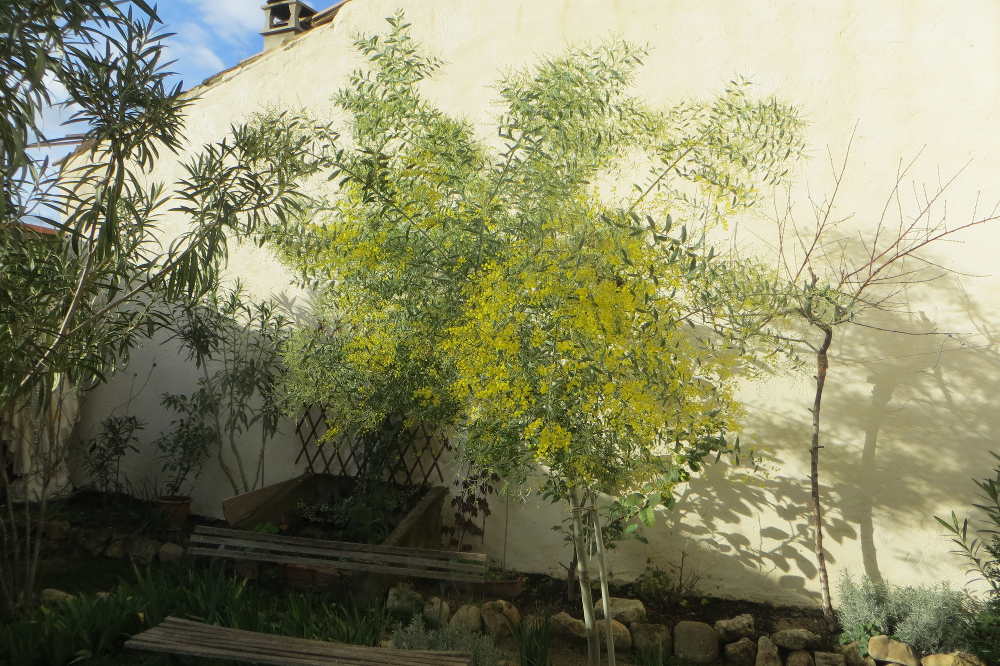 Euro-Toques chef Martin Dwyer, is much missed in Ireland since he and his wife Sile sold their eponymous restaurant in Waterford and moved to France. They now live in the Languedoc, where they take guests - and feed them very well.
Euro-Toques chef Martin Dwyer, is much missed in Ireland since he and his wife Sile sold their eponymous restaurant in Waterford and moved to France. They now live in the Languedoc, where they take guests - and feed them very well.
This month, Martin shares some of the changes for the better that he found in Ireland’s food and drink sector when back visiting family this Christmas - and dares to suggest that we may even be ahead of France in some ways at the moment...
It is now six years since we moved out, lock stock and barrel, to France, and nearly nine years since we started the process. We still come back for the odd holiday but it always is that: a holiday.
Somewhere along the line your centre of gravity shifts from one country to another and, even though we could never feel like strangers in Ireland, France has become home.
This gives us a different perspective on Ireland when we arrive on our holiday and, of course we start comparing the two countries- this can be a very interesting exercise because Ireland has done a lot of improving since 2006.
A major change in Ireland has been with the food, food available in the supermarkets, the shops and the markets in Ireland. Ireland is awash with new products, interesting new products, products which have been properly researched and packaged, are well presented and nearly all soundly based on vernacular ingredients.
Wander in the breakfast cereal lane in a supermarket, by the freezers which hold the ice-creams, the chill cabinets with the ready prepared foodstuffs and especially into the drinks section and you will be overwhelmed by the Irish produced goods on offer.
This trend was, in fairness beginning to appear in the early days of the century before we left. Thanks to great work put in by the Slow Food organisation and then individuals like Myrtle Allen, small artisan producers began to come into their own.
Their products began to creep onto the shelves of the smaller shops and the market stalls but then the Celtic Tiger declined and times got tough for everyone. I must confess that my feeling in France was that this could signal the demise of the young artisan industry in Ireland - this was a heavy blow to receive when the industry was just starting.
I am very glad to say that I have been proved quite wrong. The people of Ireland, once they began to taste wonderful Irish hand made cheeses like Milleens and then hundreds of others, have embraced them and I am endlessly grateful that the shelves of processed cheeses have disappeared. Well I thinks so, I saw no Calvita for sale this Christmas.
Strangely it seems to be that the boom and bust which has been Ireland’s economic reality for the last ten or twelve years has fostered this re-birth.
The boom not only created a taste for the finer things in life (not always the more expensive) but also a skilled and educated savvy worker who instead of creeping abroad decided to put their skills to the burgeoning food industry in Ireland and survive. This is nowhere more evident than in the amazing amounts of craft beers now available in the off licences and the more recent arrival of new Irish Gins and Irish Whiskey.
Strangely, France, the home of good food has experienced none of this renaissance in the past years. Partly this is due to the French being already very aware of the quality and variety of their local products.
The French housewife is a very canny shopper and will squeeze and smell several melons before she decides to part with any money. But it is also due to the French being deeply conservative (not always a bad thing) and also just a little complacent (not so good).
It is not an accident that French farmers are an unhappy lot at the moment and complain bitterly about the amount of produce which France imports from abroad. Perhaps, just perhaps, a little innovation, a little added value might attract their customers back? Maybe they should glance at Ireland and see how they are faring?
I have noticed that my local city, Beziers, has just produced a craft beer - my village butcher, who runs a marvellous shop, has it for sale and it is an excellent product. I went to enquire about this in a specialist beer shop in Beziers which had beers from all over the world (including Ireland) but they had not heard of it. Maybe the French Food Revolution hasn’t quite started yet?
As for the picture at the top, well when we got back to our house in the Languedoc having endured the storms of Ireland over Christmas we found that our Mimosa tree was in early blossom- a reminder that there is one thing that France always does better - the weather - Bon Année à Tous!
-------------
 Martin Dwyer started cooking professionally over 40 years ago in the legendary “Snaffles Restaurant” in Dublin. After a time in a Relais Chateau in Anjou and in “The Wife of Bath” in Kent he opened his own much acclaimed restaurant, “Dwyers”, in Waterford in 1989. In 2004 he sold this and moved south to France where he and his wife Síle bought and restored an old presbytery in a village in the Languedoc. They now run Le Presbytère as a French style Chambre d’Hôte. Martin however is far too passionate about food to give up cooking so they now enjoy serving dinner to their customers on the terrace of Le Presbytère on warm summer evenings. Martin runs occasional cookery courses in Le Presbytère and Síle’s brother Colm does week long Nature Strolls discovering the Flora and Fauna of the Languedoc.
Martin Dwyer started cooking professionally over 40 years ago in the legendary “Snaffles Restaurant” in Dublin. After a time in a Relais Chateau in Anjou and in “The Wife of Bath” in Kent he opened his own much acclaimed restaurant, “Dwyers”, in Waterford in 1989. In 2004 he sold this and moved south to France where he and his wife Síle bought and restored an old presbytery in a village in the Languedoc. They now run Le Presbytère as a French style Chambre d’Hôte. Martin however is far too passionate about food to give up cooking so they now enjoy serving dinner to their customers on the terrace of Le Presbytère on warm summer evenings. Martin runs occasional cookery courses in Le Presbytère and Síle’s brother Colm does week long Nature Strolls discovering the Flora and Fauna of the Languedoc.
Le Presbytère can be seen at: www.lepresbytere.net;
email: martin@lepresbytere.net
Twitter: www.twitter.com/DwyerThezan
An Irish Chef in France - How the French Entertain
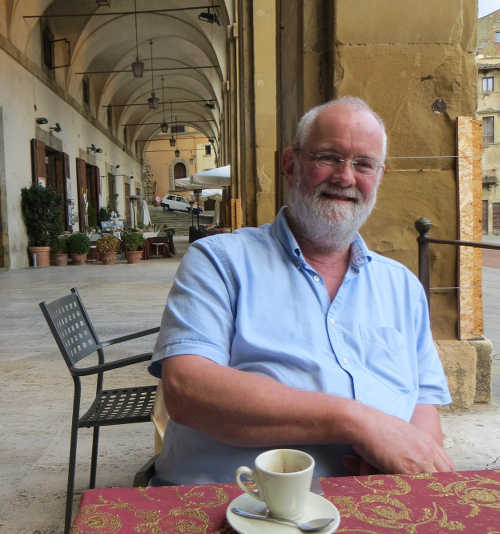
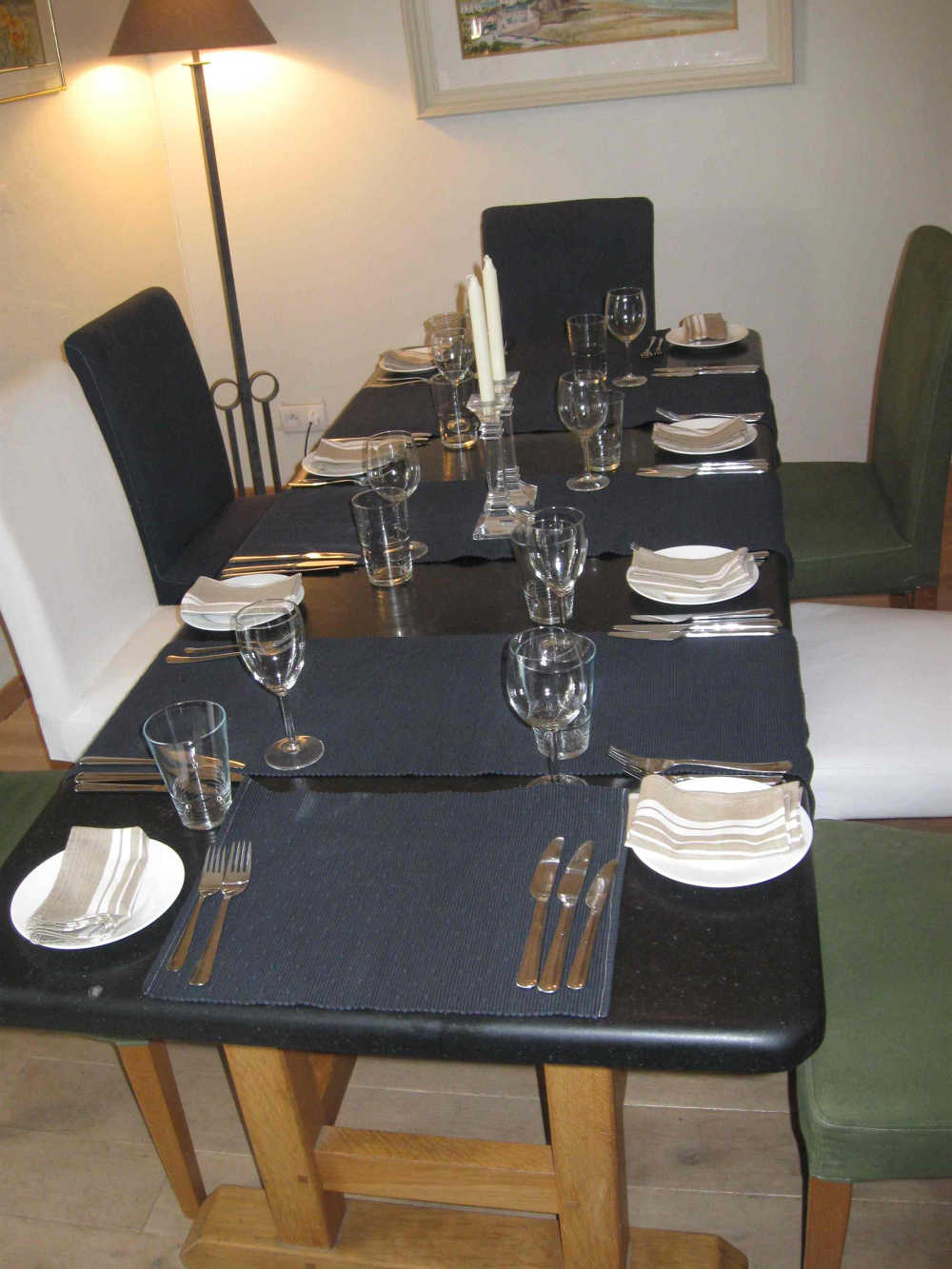 Euro-Toques chef Martin Dwyer, is much missed in Ireland since he and his wife Sile sold their eponymous restaurant in Waterford and moved to France. They now live in the Languedoc, where they take guests - and feed them very well.
Euro-Toques chef Martin Dwyer, is much missed in Ireland since he and his wife Sile sold their eponymous restaurant in Waterford and moved to France. They now live in the Languedoc, where they take guests - and feed them very well.
This month: How the French Entertain - Apero Dinatoire
The French entertain in a different way from us. They do have Dinner Parties as the Irish do from time to time, but much more often they just ask people around for an “Apero”- always called this it is actually short for an Aperitif, that ritual drink the French have to herald in the evening before starting dinner.
To be asked for an Apero is a real sign in France that you are being accepted into French society. There may often be only yourselves with the hosts and normally not more than two or three couples. It is a very informal gathering, yet there are certain rules you should be aware of.
The drinks offered will inevitably be those that the French enjoy before their meals. These are usually not at all the sort of drinks you would drink in Ireland at this time.
The French enjoy something sweet before dinner, you will often be offered a strongly liquorice flavoured Pastis (especially the men) or a sweet wine from the region. A Kir cocktail made from white wine and blackcurrant cassis is popular in France, as it has become in Ireland in recent years, but the French use far more cassis in the mix than we do so it ends up very dark red - and very sweet indeed. Dry sherry as served in Ireland is totally unknown in France, even in the Languedoc which is joined on to Spain.
The French then serve various nibbles with these drinks, little savoury biscuits, thin slices of salami, various local olives or dips or spreads made of these or anchovies.
The whole atmosphere is extremely informal and the host can be extremely generous with drinks, but it is very important that one remembers that this is a pre-dinner drink and you are expected to leave by eight and certainly before eight thirty.
When, however, you become a little more integrated with French society it may happen that when you are asked for an Apero it will be mentioned that it is an “Apero Dinatoire”
This is an altogether different kettle of fish, and a delightful one which I think could well be copied in Ireland.
We were asked to an “Apero Dinatoire” last week to a couple whom we have known for a while. This was to celebrate the husband’s sixtieth birthday.
There were twelve of us and we all sat around a table to start with, nibbling little cocktail biscuits and slices of salami while we drank either a vin doux from the Loire or Champagne.
Then the food started to come out, course after course of delicious little morsels. There were slivers of foie gras wrapped in crisp bacon and served with a slice of fried apple, a garlicy purée of beetroot and cucumber, a timbale of smoked salmon and avocado, a delicious terrine of monkfish and lobster, and the pièce de résistance, some buttery snails with herbs and garlic (the birthday boy is from Burgundy) before we hit the cheeses, the pre-dessert, and then the desserts.
This worked so well on so many different levels. It seemed that the couple had divided the tasks so there was always one relaxing at the table while the other was rustling up the next delicious tray full in the kitchen. The host was in charge of the wines and we went through many different styles with the various courses, always with some cool champagne on the table.
It is of course a lot of work to produce a meal as good as this, but observant hosts will have noticed that with the exception of the snails (which merely required reheating) all the food could be prepared well in advance thus giving the hosts time to thoroughly enjoy the evening. Not something which is easy to do when you spend it in front of a hot stove.
-------------
 Martin Dwyer started cooking professionally over 40 years ago in the legendary “Snaffles Restaurant” in Dublin. After a time in a Relais Chateau in Anjou and in “The Wife of Bath” in Kent he opened his own much acclaimed restaurant, “Dwyers”, in Waterford in 1989. In 2004 he sold this and moved south to France where he and his wife Síle bought and restored an old presbytery in a village in the Languedoc. They now run Le Presbytère as a French style Chambre d’Hôte. Martin however is far too passionate about food to give up cooking so they now enjoy serving dinner to their customers on the terrace of Le Presbytère on warm summer evenings. Martin runs occasional cookery courses in Le Presbytère and Síle’s brother Colm does week long Nature Strolls discovering the Flora and Fauna of the Languedoc.
Martin Dwyer started cooking professionally over 40 years ago in the legendary “Snaffles Restaurant” in Dublin. After a time in a Relais Chateau in Anjou and in “The Wife of Bath” in Kent he opened his own much acclaimed restaurant, “Dwyers”, in Waterford in 1989. In 2004 he sold this and moved south to France where he and his wife Síle bought and restored an old presbytery in a village in the Languedoc. They now run Le Presbytère as a French style Chambre d’Hôte. Martin however is far too passionate about food to give up cooking so they now enjoy serving dinner to their customers on the terrace of Le Presbytère on warm summer evenings. Martin runs occasional cookery courses in Le Presbytère and Síle’s brother Colm does week long Nature Strolls discovering the Flora and Fauna of the Languedoc.
Le Presbytère can be seen at: www.lepresbytere.net;
email: martin@lepresbytere.net
Twitter: www.twitter.com/DwyerThezan
An Irish Chef in France

 Euro-Toques chef Martin Dwyer, is much missed in Ireland since he and his wife Sile sold their eponymous restaurant in Waterford and moved to France. They now live in the Languedoc, where they take guests - and feed them very well.
Euro-Toques chef Martin Dwyer, is much missed in Ireland since he and his wife Sile sold their eponymous restaurant in Waterford and moved to France. They now live in the Languedoc, where they take guests - and feed them very well.
This month: Martin tells a curious tale of coincidences bound up with famous chefs, writers, and an unlikely would-be-chef writer...
As a chef who is also a great reader (and many of us are) it is not often that one comes across a book written about life in restaurants which is both interesting and well written.
Even though it was written nearly ten years ago, by a series of coincidences I have only recently come upon Bill Buford’s excellent book Heat. This is a gripping and informative account of a writer who, not in his first youth, decides to start from scratch in a busy restaurant in New York, and there rises through the ranks to become a line chef before heading to Italy to discover the very roots of Italian cooking.
Sometime in around 2005 I read an article by Buford, then a staff writer in the New Yorker, about his meeting with and subsequent working for Mario Batali. Batali cooked in and owned (with one Joe Bastianich - to whom we will return) New York’s most famous Italian Restaurant at that time; Babbo in Manhattan. He also was a hugely popular television chef in the states, eccentric, immensely colourful and certainly larger than life in every way.
It happened that, in 2002, Bill Buford, at this stage a “keen but basically clueless amateur cook”, was giving a birthday party for a friend who was also a friend of Batali’s and he had the temerity to ask him along to the party. As Buford tells it his skill, or lack of it, became unimportant as Batali took over the evening.
As well as the various alcohols he brought with him Batali also brought some home cured Lardo (yep, that is pig fat) which , rather like a priest at mass, he proceeded to place on the tongues of the willing guests “this is the best song sung in the key of pig” and as he fed them Grappa flavoured with quince and Grappa with walnut he regaled them with stories of food and eating.
He told them that he and Jo Bastianich would frequently put back a case of wine during an evening meal in Italy, thereby encouraging the party even further. Batali then asks Bill Buford to join him at a football game the following day where he discovers that Batali is also a hero of these hard boiled fans “I just love this guy” said a security man to Buford “Just lookin’ at him makes me hungry”
The upshot of all this is that Buford decides, incredibly - he must have been in his late forties - to give up his solid New Yorker job and start to work for Mario in his kitchen. This he does and eventually works his way up to line chef there when he further decides to follow Batali’s career path and work for Marco Pierre White in London and then a Pasta Maker and after a butcher in Tuscany.
Now all these moves I followed with great avidity as Buford wrote his continuing story in the New Yorker; fantastic tales of incredible hours of hard work in New York, London and Italy. He brought this progress together in a book called “Heat” which he got published in 2006 - and this is still available.
His very last words in the book (which I found hugely influential I confess) were his answer to Batali when he asked when he was going to open his own restaurant. Buford said the time was not right: “If I am really to understand Italian cooking I must follow Catherine de Midici... I need to cross the Alps and learn what happened next. I have to go to France”.
That was written sometime in 2005 and then there was no more in the New Yorker from Bill Buford. But last year he came back into my life in a most surprising way.
There was a family reunion in my B&B, Le Presbytere during the summer, various brothers and sisters originally from County Carlow now well scattered through the world, getting together for the first time in years.
Franco, the Italian husband of one of the ladies escaped the Irish reunion and came quietly into the kitchen shortly after they arrived (people quite frequently do). He told me that his sister was in the business, as it turned out this was a little understatement. She was Lydia Bastianich, USA’s most famous Italian television chef, partner in many restaurants with one Mario Batali and mother of his – previously mentioned - business partner Joe.
Franco was surprised with my familiarity with Batali - really unknown outside America - but getting more so as he became famous for huge charity works with the like of Bono et al. But then I had read Buford and he had stuck in my mind.
After Christmas and with some time on my hands I decided to submit a piece on Drisheen, a blood sausage from my native Cork, to the Oxford Symposium of Food as their theme for this year’s Symposium is “Offal”. This they published on their face book page.
To my pleasure this was “liked” and commented on by various people, among them, to my wonder, one Bill Buford. Of course I stretched out my brass neck, and wrote him a fan letter and asked him if he had ever gone to France and had he written about it yet. The kind man replied: “Thank you! I've been, 5 years in Lyon, and am finally finishing the book, to be published in the fall (with luck, grace, an absence of gravity, etc)”
So I have another treat awaiting by next Christmas, Bill Buford in a Restaurant in Lyon - I can’t wait!
-------------
 Martin Dwyer started cooking professionally over 40 years ago in the legendary “Snaffles Restaurant” in Dublin. After a time in a Relais Chateau in Anjou and in “The Wife of Bath” in Kent he opened his own much acclaimed restaurant, “Dwyers”, in Waterford in 1989. In 2004 he sold this and moved south to France where he and his wife Síle bought and restored an old presbytery in a village in the Languedoc. They now run Le Presbytère as a French style Chambre d’Hôte. Martin however is far too passionate about food to give up cooking so they now enjoy serving dinner to their customers on the terrace of Le Presbytère on warm summer evenings. Martin runs occasional cookery courses in Le Presbytère and Síle’s brother Colm does week long Nature Strolls discovering the Flora and Fauna of the Languedoc.
Martin Dwyer started cooking professionally over 40 years ago in the legendary “Snaffles Restaurant” in Dublin. After a time in a Relais Chateau in Anjou and in “The Wife of Bath” in Kent he opened his own much acclaimed restaurant, “Dwyers”, in Waterford in 1989. In 2004 he sold this and moved south to France where he and his wife Síle bought and restored an old presbytery in a village in the Languedoc. They now run Le Presbytère as a French style Chambre d’Hôte. Martin however is far too passionate about food to give up cooking so they now enjoy serving dinner to their customers on the terrace of Le Presbytère on warm summer evenings. Martin runs occasional cookery courses in Le Presbytère and Síle’s brother Colm does week long Nature Strolls discovering the Flora and Fauna of the Languedoc.
Le Presbytère can be seen at: www.lepresbytere.net;
email: martin@lepresbytere.net
Twitter: www.twitter.com/DwyerThezan
An Irish Chef in France
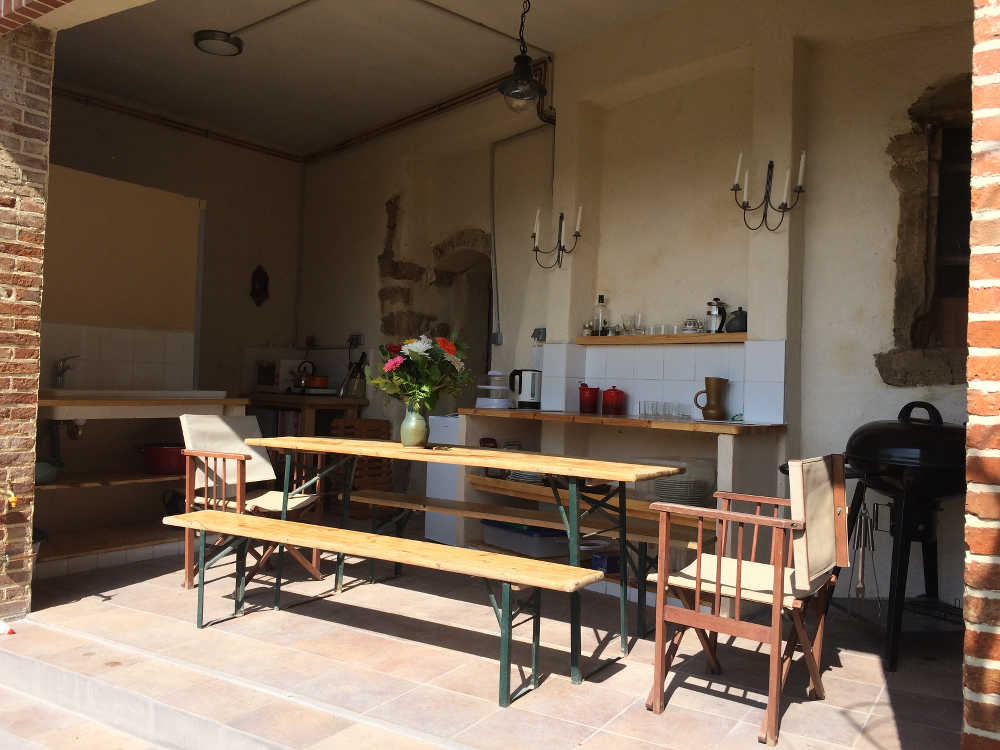
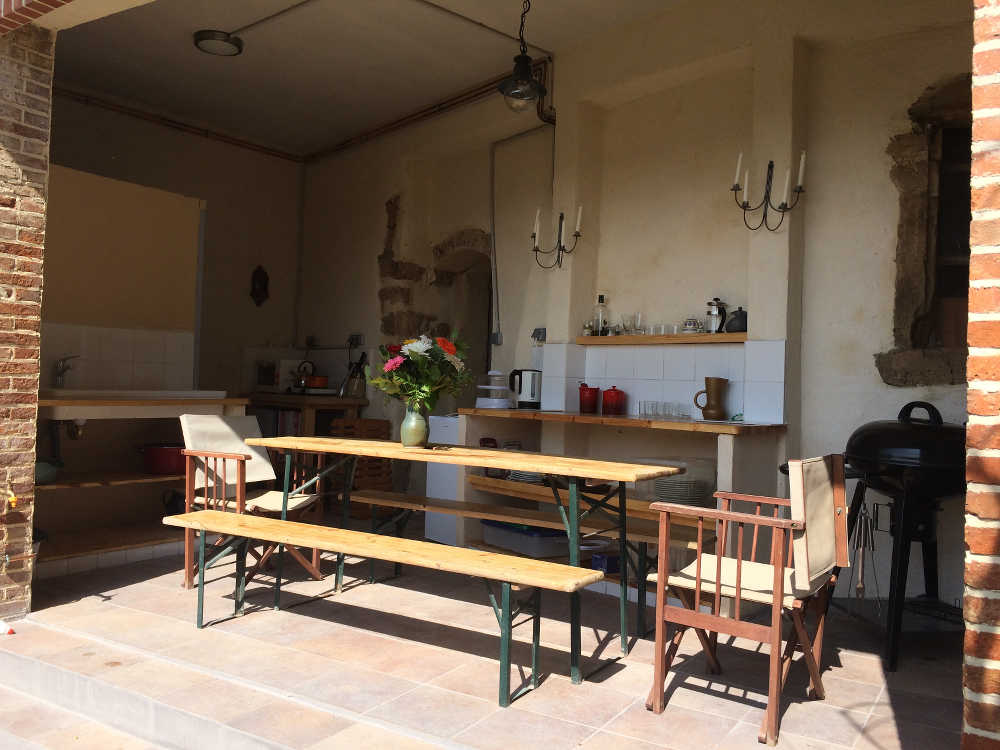 Euro-Toques chef Martin Dwyer, is much missed in Ireland since he and his wife Sile sold their eponymous restaurant in Waterford and moved to France. They now live in the Languedoc, where they take guests - and feed them very well.
Euro-Toques chef Martin Dwyer, is much missed in Ireland since he and his wife Sile sold their eponymous restaurant in Waterford and moved to France. They now live in the Languedoc, where they take guests - and feed them very well.
This month: La Cuisine d’ Été (‘Summer Kitchen’)
It began, as all good mystery tales do, with a lost staircase.
A couple of the locals had said that there used to be a staircase from our old Presbytere perched high in the centre of the village of Thezan, down to the street below. We couldn’t find any trace of this.
Then our neighbours bought the property directly in front of, and beneath us, to turn this into a garage. In the very back of this building they found a very old doorway. When they asked the seller where this led he said he had absolutely no idea and had never noticed it before.
They, being from Normandy and naturally curious , opened the door. There they discovered an ancient stone staircase which ran underneath our property climbing to the corner of our garden where it would have met our stone steps, leading down from our terrace, had this not been sealed off some time in the past.
This underground staircase was roofed by some stone arches and also by some iron girders which supported our garden above. Now these girders had rusted away to cobwebs since the years they had been installed so we had to replace them with concrete.
While we were employing a builder to do this, I got him to check out our terrace because it occurred to me that this was of a similar age to the roofing of the staircase. Unfortunately for us, the very same rusty cobwebs were the main support of our terrace so we had to replace the whole structure.
Our canny builder sweetened the pill for us by explaining that while he was replacing the terrace it would cost very little extra to increase its size by about twenty percent. As our terrace is the most important room in our house and the place we feed our guests for about six months out of twelve, this gave us a lot more space there.
There was also an extra bonus because the courtyard underneath the terrace was also increased in size and this space, which had previously been used as a garden shed for our little Jardin de Curé, now became a most attractive space and this was the moment when I got the notion of turning this space into a Cuisine d’ Été.
Because I had a restaurant for so long in Ireland, where I was the cook, I had gathered over the years a loyal clientele who are still enjoy my cooking here in the Languedoc in my Chambre d’Hôte. This often led me to cooking seven nights in a row, and even though I am still a chef who loves feeding people, I would prefer, in my old age, a few nights off in the week.
Now a lot of Chambre d’Hôtes in France boast a Coin Cuisine, which is a kitchen where the guests can cook for themselves - we had often sought out these when we were driving through France on our summer holidays when the children were young. It was amazingly handy, and cheap, to stay overnight in a place where our children could be fed a familiar meal before continuing on our journey. If you were lucky enough to have a garden these Coins Cuisines became a cuisine d’été or summer kitchen.
Our courtyard was a perfect space for this, it is completely protected from the elements by the terrace and yet one side of it opens out to the garden so it becomes a lovely space to eat out in the summer months.
So since Christmas this year we have been busying ourselves, searching Vide Greniers and Brocantes, looking for bits and pieces to furnish our second kitchen, and finally, just last week, we were able to let our first set of guests, a party of four from Ireland and Germany, enjoy the charms of the Coin Cuisine.
They pronounced it a great success, but the real test was yet to come. This week I had my two grandsons to stay and we decided to treat them to a barbecue in the cuisine d’été. We gathered together a simple meal of local sausages, some with ceps and some with paprika, and made some garlic bread from the abundant patch of wild garlic which springs up every year in the garden.
My eldest grandson Fionn, who at seven years old is a bit of a gourmet, told me at the end that it was “the best meal ever”. I reckon we can call it a success.
-------------
 Martin Dwyer started cooking professionally over 40 years ago in the legendary “Snaffles Restaurant” in Dublin. After a time in a Relais Chateau in Anjou and in “The Wife of Bath” in Kent he opened his own much acclaimed restaurant, “Dwyers”, in Waterford in 1989. In 2004 he sold this and moved south to France where he and his wife Síle bought and restored an old presbytery in a village in the Languedoc. They now run Le Presbytère as a French style Chambre d’Hôte. Martin however is far too passionate about food to give up cooking so they now enjoy serving dinner to their customers on the terrace of Le Presbytère on warm summer evenings. Martin runs occasional cookery courses in Le Presbytère and Síle’s brother Colm does week long Nature Strolls discovering the Flora and Fauna of the Languedoc.
Martin Dwyer started cooking professionally over 40 years ago in the legendary “Snaffles Restaurant” in Dublin. After a time in a Relais Chateau in Anjou and in “The Wife of Bath” in Kent he opened his own much acclaimed restaurant, “Dwyers”, in Waterford in 1989. In 2004 he sold this and moved south to France where he and his wife Síle bought and restored an old presbytery in a village in the Languedoc. They now run Le Presbytère as a French style Chambre d’Hôte. Martin however is far too passionate about food to give up cooking so they now enjoy serving dinner to their customers on the terrace of Le Presbytère on warm summer evenings. Martin runs occasional cookery courses in Le Presbytère and Síle’s brother Colm does week long Nature Strolls discovering the Flora and Fauna of the Languedoc.
Le Presbytère can be seen at: www.lepresbytere.net;
email: martin@lepresbytere.net
Twitter: www.twitter.com/DwyerThezan
An Irish Chef in France
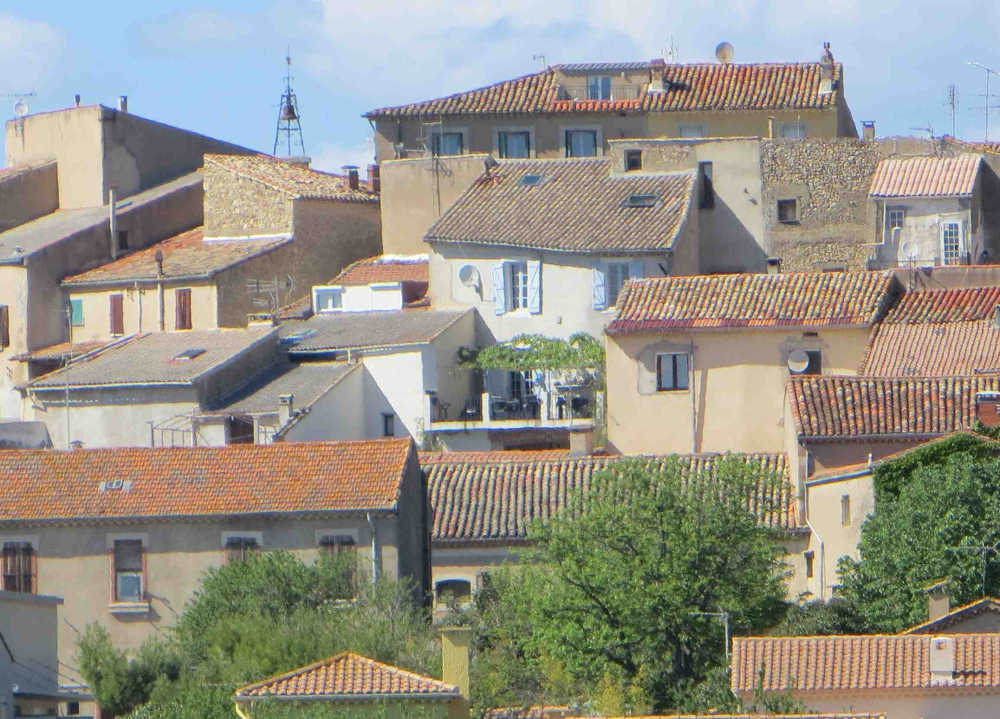
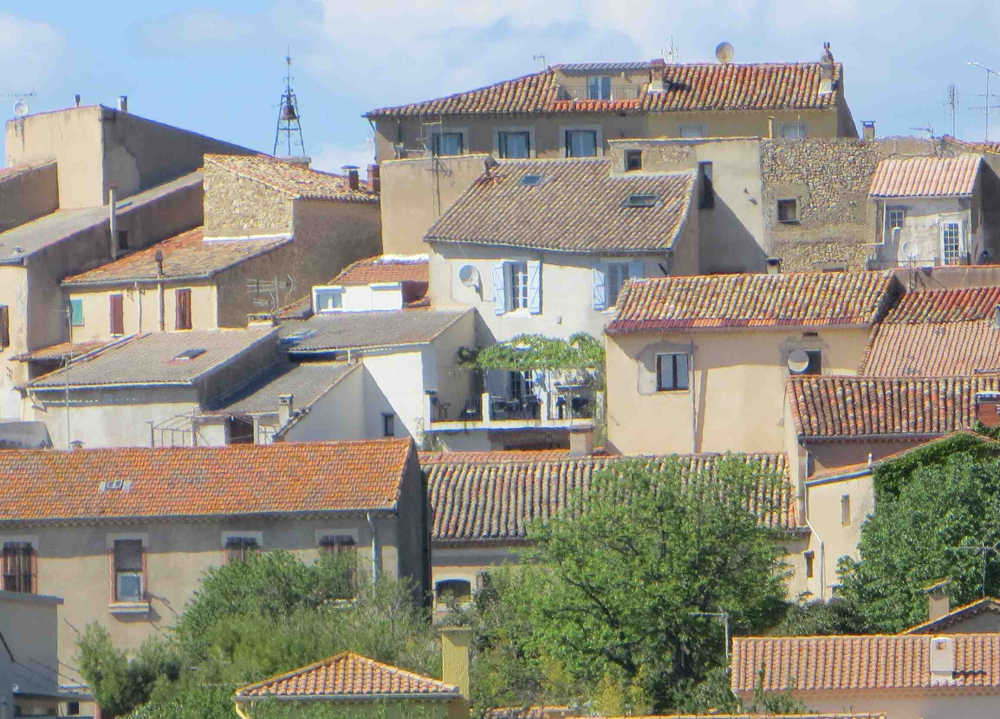 Euro-Toques chef Martin Dwyer, is much missed in Ireland since he and his wife Sile sold their eponymous restaurant in Waterford and moved to France. They now live in the Languedoc, where they take guests - and feed them very well.
Euro-Toques chef Martin Dwyer, is much missed in Ireland since he and his wife Sile sold their eponymous restaurant in Waterford and moved to France. They now live in the Languedoc, where they take guests - and feed them very well.
This month: The Vine
First let me confess that I am not the gardener in Le Presbytère- that role is certainly taken by my wife Sile. I am called upon from time to time when there is heavy work involved but, after forty three years of marriage, we have discovered our own happiest spaces, mine in the kitchen and hers in the garden.
One of our primary requirements when we came looking for a house in the Languedoc was that it should have a garden, as we also wanted to be in the centre of a village this proved to be quite a stumbling block.
Surprisingly we were finally saved by the Catholic Church. Because it was reckoned essential for the parish priest to have a place of peaceful contemplation in which to say his daily office most presbyteries in France are furnished with a little garden, “le Jardin de Curé”. Now this is not at all extensive, not necessarily a bad thing, but being in the centre of an old village it is to be treasured.
The first summer we were here we bought a lot of plants – many that we had grown successfully in Ireland - for our little garden. We had, to our regret, a lot of failures. (I still have a gooseberry bush from that time which, to date, has produced exactly one gooseberry.)
Our successes have all been those plants which grow profusely in the area. We get a great crop of white peaches, the Oleander produces flowers all through the summer, even our lemon tree produces enough fruit to keep my grandsons supplied with lemonade when they visit.
But, without a doubt the most successful planting has been our vine.When we bought this, now about nine years ago, we quite carefully selected a table grape variety; Chasselas. We knew this white grape was very rarely turned into wine (they do make some of Chasselas in Switzerland but this is usually damned with the faint praise of being “flowery”)
Coming from Ireland we knew nothing at all about vine cultivation but we were aware that they thrived here in the Languedoc. The Herault, our department, is in fact, the most densely planted wine area in the world.
For the first few years our vine didn’t seem to be doing much, or so we thought. In fact it was extremely busy sending down roots until it found the water table, as we are at the very top of the village this took a few years, but, once it settled its feet happily in moisture it started to shoot up.
Now our garden is on a level below our terrace, about four metres lower. Pretty soon we began to notice that the vine seemed to be making a beeline for the terrace.
Our terrace, for six months of the year, is the most used part of our house. We take nearly all of our meals there and, as it faces due south and is protected from all three other directions by the house, it is a sun trap par excellence.
This of course brings its own problems as during the mid-summer months it becomes, particularly at mid-day, often too hot to enjoy and really needs some shade. This we have provided over the years by a variety of sunshades, but as we watched the vine climb up to the terrace we realised that it was, as originally intended, going to lend a hand and provide us with the best shade of all, a vine.
I may not be the gardener of the house but I certainly have adopted the role of tender of the vine. Every year over the last three or four, once the vine starts to shoot, you will find me up a ladder cajoling, teasing and weaving the vine into providing the best possible shade from the sun. Every year also, in April, I have meticulously cut off every bunch of grapes (leaving just enough to make grape jelly for the grandsons) this is to encourage the vine to make more shoots and leaves which was what we wanted.
This year I think we will make it, as you can see from the picture taken from across the valley from the house, the vine is already doing an excellent job and has a lot more growing to do. As a reward for its diligence I have decided this year for the first time, not to snip off the grapes. The truth of the matter is that it would produce far more than either I or my guests could possibly use. I shall leave a few come to full ripeness for the jelly and some more for the pure luxury of snipping off a bunch as I serve the cheese at dinner time and adding it to the board for the guests.
For the rest I am going to follow a recipe which the thrifty French housewife in these parts has traditionally used. Just before they ripen the grapes are snipped from the vine and squeezed to make Verjuice. This mild vinegar is now again becoming popular in cooking, and when properly preserved, capable of lasting until the next harvest. I will let you know how I get on.
-------------
 Martin Dwyer started cooking professionally over 40 years ago in the legendary “Snaffles Restaurant” in Dublin. After a time in a Relais Chateau in Anjou and in “The Wife of Bath” in Kent he opened his own much acclaimed restaurant, “Dwyers”, in Waterford in 1989. In 2004 he sold this and moved south to France where he and his wife Síle bought and restored an old presbytery in a village in the Languedoc. They now run Le Presbytère as a French style Chambre d’Hôte. Martin however is far too passionate about food to give up cooking so they now enjoy serving dinner to their customers on the terrace of Le Presbytère on warm summer evenings. Martin runs occasional cookery courses in Le Presbytère and Síle’s brother Colm does week long Nature Strolls discovering the Flora and Fauna of the Languedoc.
Martin Dwyer started cooking professionally over 40 years ago in the legendary “Snaffles Restaurant” in Dublin. After a time in a Relais Chateau in Anjou and in “The Wife of Bath” in Kent he opened his own much acclaimed restaurant, “Dwyers”, in Waterford in 1989. In 2004 he sold this and moved south to France where he and his wife Síle bought and restored an old presbytery in a village in the Languedoc. They now run Le Presbytère as a French style Chambre d’Hôte. Martin however is far too passionate about food to give up cooking so they now enjoy serving dinner to their customers on the terrace of Le Presbytère on warm summer evenings. Martin runs occasional cookery courses in Le Presbytère and Síle’s brother Colm does week long Nature Strolls discovering the Flora and Fauna of the Languedoc.
Le Presbytère can be seen at: www.lepresbytere.net;
email: martin@lepresbytere.net
Twitter: www.twitter.com/DwyerThezan
An Irish Chef in France
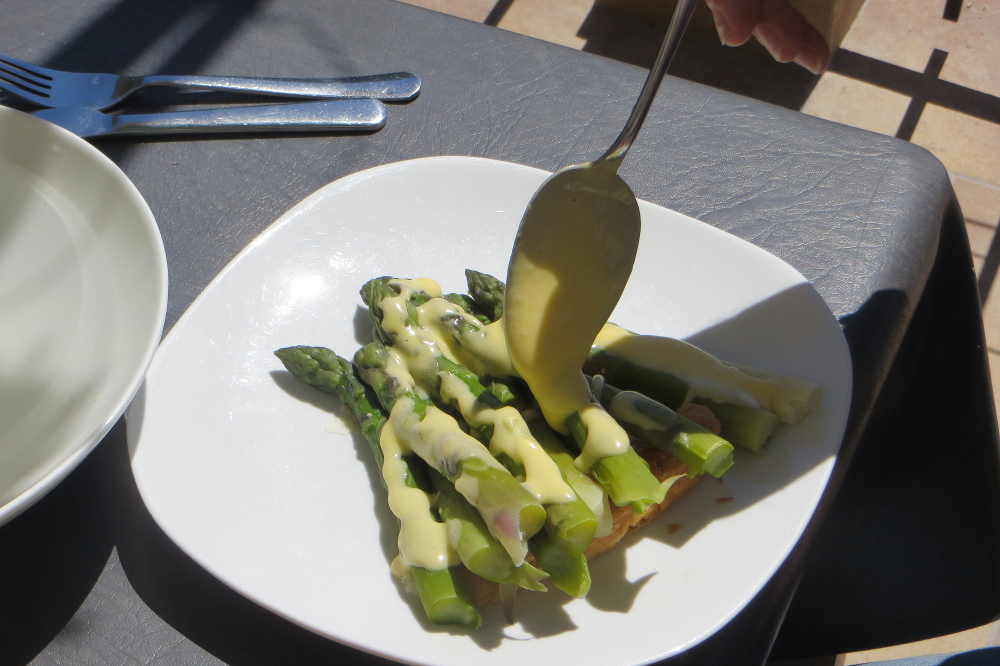

Euro-Toques chef Martin Dwyer, is much missed in Ireland since he and his wife Sile sold their eponymous restaurant in Waterford and moved to France. They now live in the Languedoc, where they take guests - and feed them very well.
This month: On Shopping in France
Shopping in France when you have eight guests staying can be an intense, frustrating, long and even dramatic experience as happened one day last week.
A family in the village of Thezan produce what is simply the best Asparagus around. They sell this from their garage which they have adapted to a small asparagus production with a washer and a sorting machine.
They put their signs up on Monday "Last week of Asparagus, open at 9.00 tomorrow”. By the time I got down, at 6 minutes past nine, there were already seven people queueing up, in full sun, at the door. Monsieur was there, shrugging apologetically - Madame was not yet back from the field with today’s crop. Nobody moved. Good asparagus is worth waiting for.
At 9.15 Madame and her pickers (her two grown children I reckon) arrive back from the fields and haul the many boxes of various sized asparagus to the back of the garage where Granny and Grandad are waiting to start the cleaning and sorting.
In the meantime we the queue are standing in the sun waiting. Perhaps I should add at this stage that very frequently in the course of the brief asparagus season they have run out of asparagus by 10.30. It doesn't pay to be late.
Most people seemed to be taking more than a kilo so, as number eight in the queue I was hoping I was not going to be too late. (Numbers nine, ten eleven and twelve were also anxious and kept making little sorties forward to check the boxes.)
Meanwhile the whole family were running backwards and forwards to keep abreast of the customers’ demands. Eventually I get up to number one position and am greeted with a "Bon Jour Chef !" and a hand shake by Monsieur. (This is a civilised country) I ask for my two kilos of the Sept (a medium grade, €7 a kilo.) and with much scurrying back and forth M. manages to put it together for me. This is accompanied by much chat and banter between us - made all the more interesting by the fact that I cannot penetrate his thick accent and he appears equally baffled by my French. However after a mere 35 minutes of queueing in the hot sun I am well rewarded by two kilos of superb asparagus.
Next stop the butchers for the lamb for dinner (they get exquisite lamb from relatives in the mountains of the Ardeche). There is just one lady in the shop, a pretty blonde lady of about 25 with a little 2 year old boy.
While I wait for Mathieu, the son of the house to finish her purchases she suddenly collapses gently onto the floor next to me. Mathieu calls his mother, Natalie, out from the back, she is obviously trained in first aid and immediately attends to Madame, Mathieu is phoning emergencies on her instructions and she tells me (we are old friends) to take the child away.
With some foreboding I put my arms out to the little boy who immediately and happily comes to me. And so I spend the next ten to fifteen minutes walking around the back of the shop, where his mother is out of sight, with this lovely trusting child in my arms while Natalie tries every trick in the book to rouse her back to consciousness.
The little boy and I get on fine and probably have about the same language skills. He doesn't cry or get upset at all. We talk about the pictures of the cows and the pigs on the walls while we await the ambulance.
Unfortunately Madame is still unconscious when the ambulance arrive and Natalie, who has been kneeling by her for about 15 minutes (and whose back is not great) manages to straighten up as they take Madame away in the ambulance. She comes over to me and gently takes the child into her arms.
Mathieu gives me my shoulders of lamb, the little boy waves good bye to me smiling and calls me “Papi” - obviously I was like his grandfather. The lady is a total stranger to Natalie but she was going to take the child home with her until they could find a relative. (I have since heard from Natalie that the lady is fine and the child is with his father.)
Next stop is at the Olive Farm; Domaine Pradines le Bas, where Madame produces about six varieties of excellent olive oil from her own trees, I buy 3 Litres of “Olivier”, my favourite, a wonderful fruity oil, which comes in a thick plastic bag with a tap and costs a small fortune. (When you taste the vinaigrette which this makes you realise it is worth every penny.)
Just across the road from the Olive farm is the producers market, La Ferme Biterroise, where I buy some strawberries from Portiragnes, which is a few miles down the coast on the shores of the Mediterranean. There they take advantage of the mild climate by producing early strawberries which, though large, are amazingly ripe and sweet. In the Ferme I also buy some of the first new potatoes, again very local, and some courgettes for the dinner.
The last stop on my shopping round is the local Super U supermarket. There I stock up on the basics, but which because this is France also have a large selection of local vegetables and some excellent but expensive fish from the auction in nearby Agde.
When I get back to my kitchen I realise that this excursion, which is, after all just for tonight’s dinner for me and my guests, has taken nearly three hours out of my day.
But then, tonight when I tuck into my delicious dinner, when I savour the freshest and juiciest asparagus (with Maltaise Sauce - Hollandaise, acidulated with the zest of a Seville Orange which I have husbanded in the freezer since February for just such an occasion) then taste the wonderful tender sweet lamb from the mountains (I have boned the shoulders and slow roasted them stuffed with garlic and rosemary and thyme from the Garrigue) and finished with the strawberries served with fennel scented shortbreads which I made from a recipe I found in Corsica, then I realise that I bear no resentment for all the time spent in shopping : It was all well worth while.
-------------
 Martin Dwyer started cooking professionally over 40 years ago in the legendary “Snaffles Restaurant” in Dublin. After a time in a Relais Chateau in Anjou and in “The Wife of Bath” in Kent he opened his own much acclaimed restaurant, “Dwyers”, in Waterford in 1989. In 2004 he sold this and moved south to France where he and his wife Síle bought and restored an old presbytery in a village in the Languedoc. They now run Le Presbytère as a French style Chambre d’Hôte. Martin however is far too passionate about food to give up cooking so they now enjoy serving dinner to their customers on the terrace of Le Presbytère on warm summer evenings. Martin runs occasional cookery courses in Le Presbytère and Síle’s brother Colm does week long Nature Strolls discovering the Flora and Fauna of the Languedoc.
Martin Dwyer started cooking professionally over 40 years ago in the legendary “Snaffles Restaurant” in Dublin. After a time in a Relais Chateau in Anjou and in “The Wife of Bath” in Kent he opened his own much acclaimed restaurant, “Dwyers”, in Waterford in 1989. In 2004 he sold this and moved south to France where he and his wife Síle bought and restored an old presbytery in a village in the Languedoc. They now run Le Presbytère as a French style Chambre d’Hôte. Martin however is far too passionate about food to give up cooking so they now enjoy serving dinner to their customers on the terrace of Le Presbytère on warm summer evenings. Martin runs occasional cookery courses in Le Presbytère and Síle’s brother Colm does week long Nature Strolls discovering the Flora and Fauna of the Languedoc.
Le Presbytère can be seen at: www.lepresbytere.net;
email: martin@lepresbytere.net
Twitter: www.twitter.com/DwyerThezan
An Irish Chef in France
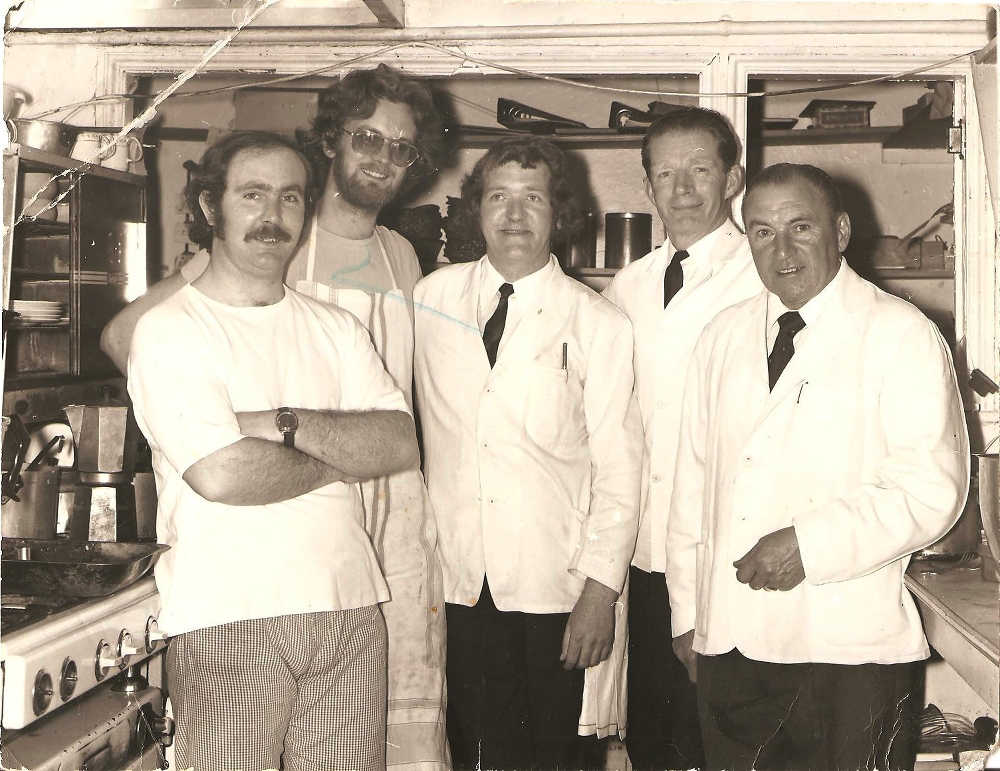
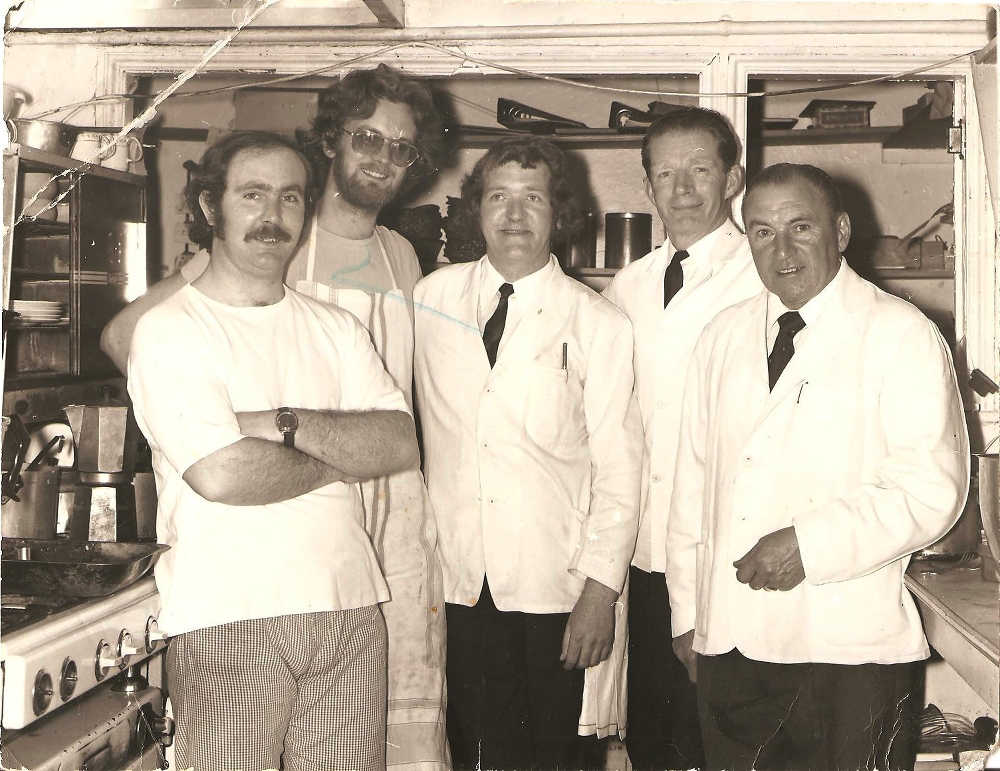
Euro-Toques chef Martin Dwyer, is much missed in Ireland since he and his wife Sile sold their eponymous restaurant in Waterford and moved to France. They now live in the Languedoc, where they take guests - and feed them very well.
This month: Snaffles
The picture shows some of the staff in Snaffles in 1972, chefs Jack Williams and myself, waiters Hugo, Danny and John.
In the sixties and the seventies there was no doubt that the smartest restaurant in Dublin was Snaffles of Leeson Street. I have a Good Food Guide from those years which calls it the place where “Guinness, Rome and beauty met”. I was lucky enough to get a job there in the early seventies and spent my first years of cooking there in Snaffles kitchen.
Snaffles was run by Nick and Rosie Tinne, he an excellent amateur cook, she a graduate of the Cordon Bleu school in London. They were decades ahead of their time in Dublin and certainly hit a note with Dublin gourmets as the small basement was always full, Saturday nights often booked a month in advance, and not just full but, as the Good Food Guide insinuated, full of the beautiful people of Dublin of that age.
The food in Snaffles was a fascinating mixture of Irish Country House cooking with its emphasis on game and offal and great varieties of old fashioned vegetables (the Guinness family used to grow Seakale for us in their house in Castleknock) and also a healthy selection of new - for Ireland - European dishes which were becoming fashionable at that time - Lasagne, Moussaka, Gazpacho and classic French dishes like Bourguignon and Coq au Vin were, I am quite sure, first tasted by a lot of Irish people there. Snaffles also had its signature dishes - Snaffles Mousse and Grape Pud were two - and the recipes for these were jealously guarded.
Snaffles was of course rather more than just a kitchen, the waiters, John, Danny and Hugh were superb professionals. Nick had been lucky enough to start the business just when the legendary Red Bank was closing and he just scooped up the waiters from there. They were a united team and even had a language all of their own with which they could communicate with skill while they smoothly went about their business.
The author Ben Kiely used to tell a story about arriving into the Red Bank having been on a bender and looking very much the worse for wear. John whooshed him into the gents with instructions to wait there until he came back. He arrived back with a razor and a clean shirt from Dunne’s Stores and John would then stand over him until he made himself presentable.
Just as the waiters in Snaffles were legendary so also were the customers. It was an obligatory port of call for visiting film stars, while Stanley Kubrick was making Barry Lyndon it became a sort of unofficial staff canteen and Ryan O’Neill (with his daughter Tatum in tow) and Marisa Berenson were frequently to be seen having dinner. John Huston often brought his daughter Angelica and I remember one occasion - while making “Macintosh Man” in Galway - he rang to book a table for a late lunch. Strangely he never arrived. At 2.30 the phone rang, it was Mr. Huston full of apologies. “I sent Paul Newman down to keep the table, he came back and said you were closed, I’ve just realised that I forgot to tell the idiot that you had to ring the bell to get in.”
Irish politicians were also frequent visitors and, as the restaurant had a discreet private back room, we were often visited by Mr Haughey.
That he was a master of political skill should never be underestimated. First thing Charlie did on entering the restaurant was to stick his head around the kitchen door and greet all the staff by name “Ah, still here Martin !” he’d say with a smile.
This always did wonders for my ego until one day John, the Maitre d’ told me that as soon as Charlie entered John was instructed to run down a list of all staff names, with all relevant details and it was with this information fresh in his mind that he stuck his head around the kitchen door.
-------------
 Martin Dwyer started cooking professionally over 40 years ago in the legendary “Snaffles Restaurant” in Dublin. After a time in a Relais Chateau in Anjou and in “The Wife of Bath” in Kent he opened his own much acclaimed restaurant, “Dwyers”, in Waterford in 1989. In 2004 he sold this and moved south to France where he and his wife Síle bought and restored an old presbytery in a village in the Languedoc. They now run Le Presbytère as a French style Chambre d’Hôte. Martin however is far too passionate about food to give up cooking so they now enjoy serving dinner to their customers on the terrace of Le Presbytère on warm summer evenings. Martin runs occasional cookery courses in Le Presbytère and Síle’s brother Colm does week long Nature Strolls discovering the Flora and Fauna of the Languedoc.
Martin Dwyer started cooking professionally over 40 years ago in the legendary “Snaffles Restaurant” in Dublin. After a time in a Relais Chateau in Anjou and in “The Wife of Bath” in Kent he opened his own much acclaimed restaurant, “Dwyers”, in Waterford in 1989. In 2004 he sold this and moved south to France where he and his wife Síle bought and restored an old presbytery in a village in the Languedoc. They now run Le Presbytère as a French style Chambre d’Hôte. Martin however is far too passionate about food to give up cooking so they now enjoy serving dinner to their customers on the terrace of Le Presbytère on warm summer evenings. Martin runs occasional cookery courses in Le Presbytère and Síle’s brother Colm does week long Nature Strolls discovering the Flora and Fauna of the Languedoc.
Le Presbytère can be seen at: www.lepresbytere.net;
email: martin@lepresbytere.net
Twitter: www.twitter.com/DwyerThezan
An Irish Chef in France
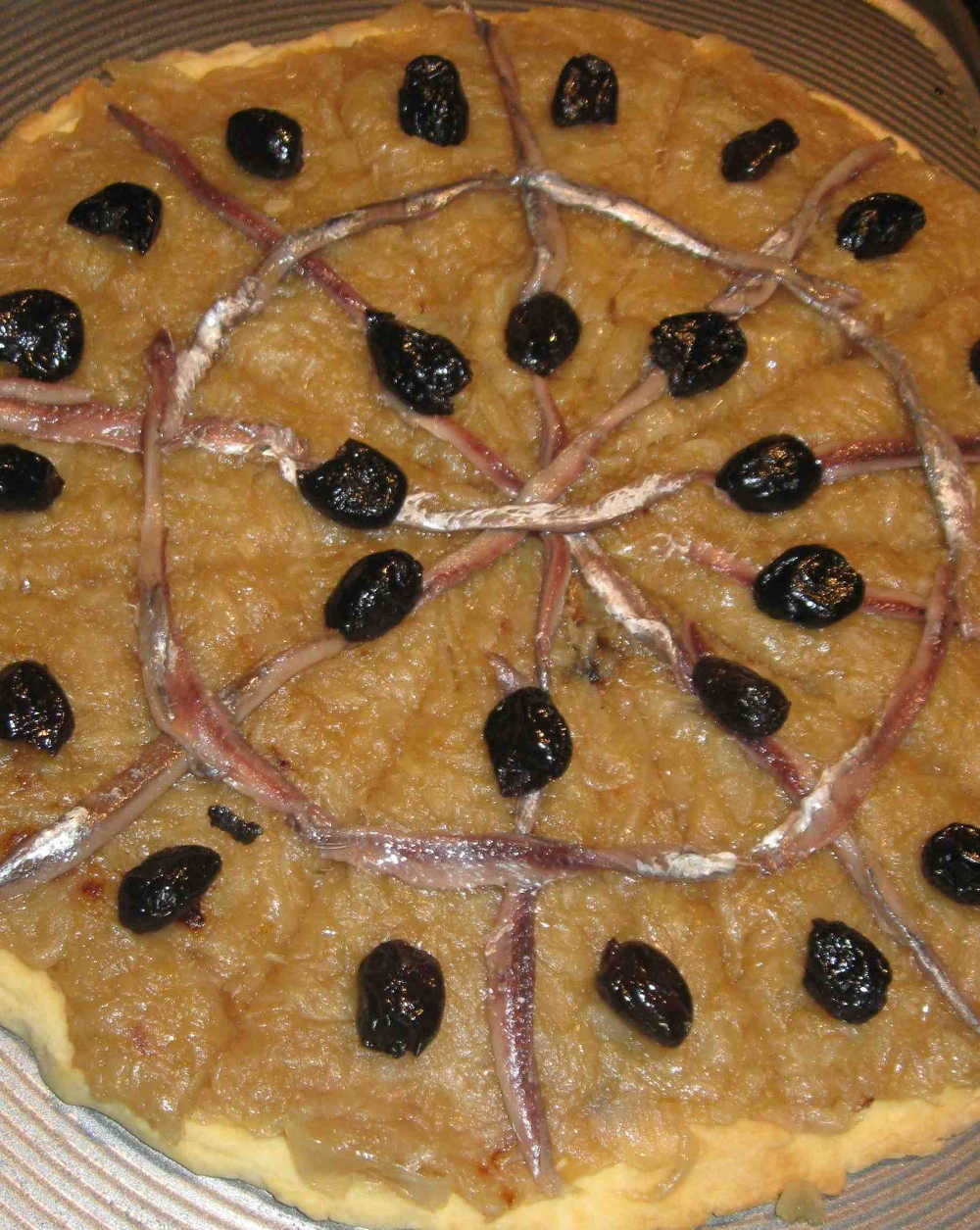
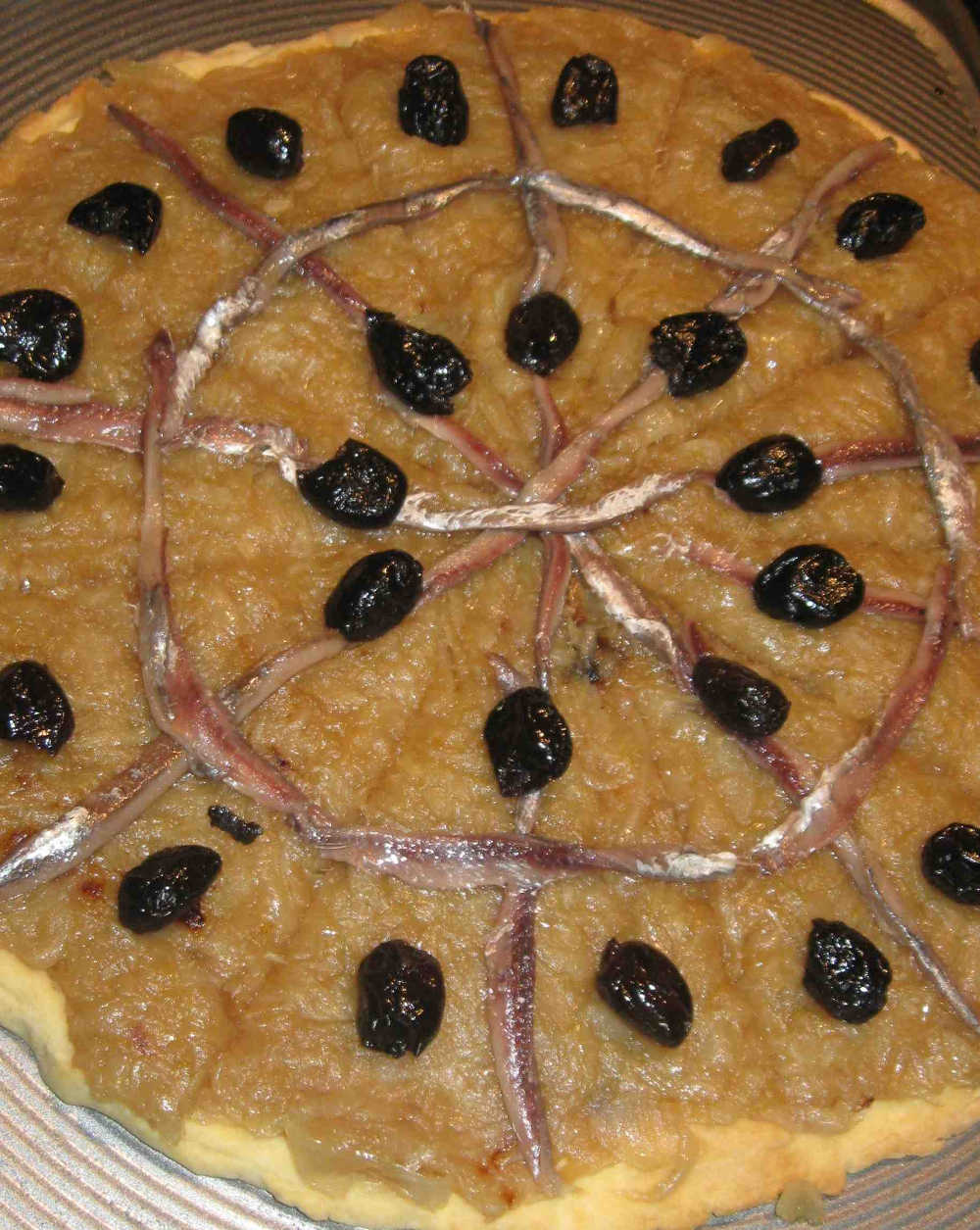 Euro-Toques chef Martin Dwyer, is much missed in Ireland since he and his wife Sile sold their eponymous restaurant in Waterford and moved to France. They now live in the Languedoc, where they take guests - and feed them very well.
Euro-Toques chef Martin Dwyer, is much missed in Ireland since he and his wife Sile sold their eponymous restaurant in Waterford and moved to France. They now live in the Languedoc, where they take guests - and feed them very well.
This month: Pissaladière
I have been aware of Pissaladière for as long as I have been cooking, certainly I remember producing large quantities in The Wife of Bath in Kent when I worked there in the seventies. I would have regarded it as a sort of French take on the Pizza, made with a less doughy crust but having the ubiquitous tomato topping.
After we moved to France I began to notice that the same pissaladière was a very common street food in the Languedoc. Sold commonly on market stalls and in traiteur’s shops this was a different creature from pissaladière I had cooked many years before in England. This was a totally tomato free zone and the topping was universally the same, melting soft pale brown onions topped in a lattice fashion with anchovies and olives.
Having tried a few of these slices I quickly realised how much this pure and simple tart was better without the addition of tomatoes, or indeed chorizo or tuna or even sweetcorn with which I have seen it decorated in restaurants and cookbooks.
I went back to my Master, Elizabeth David, to see what she had to say. She of course got it right. She calls it a tart spread with onions, olives anchovies and SOMETIMES tomatoes (my capitals) and also advocates the use of a lighter pate brisée for the base.
She says that it is the aromatic filling of onions, anchovies and olives which is important. She also hints that far from being copied from the Italians it is likely that the Italians copied this from the French to make their Pizza.
Here is my version of the one commonly available here in Languedoc.
Pissaladière
Base:
225g flour 110g butter 1 egg 1 tbs cold water
Topping:
3 tablespoons olive Oil 6 large onions sliced thinly 12 whole anchovies (24 fillets) preferably from Collioure. 24 black olives (stoned)
Base:
Make the base like you would make shortcrust pastry.
Either rub the butter into the flour by hand or in a food processor.
Bind into a dough with the egg and the water.
Leave this for an hour in the fridge to rest.
Roll this out to a circle about 12 inch wide and put on a baking sheet or use it to line an oiled 12" round pan (or a rectangular swiss roll tray)
Set the oven to 200C 400F gas 6.
Cook the pastry base at this temperature for 15 minutes until brown and crisp
(I find there is no need to weigh this down)
Topping:
Peel and slice the onions and cook in the olive oil in a covered pan on a low heat for about one hour until melting.
Now take the lid off the pan and raise the heat to cook off the liquid.
Watch the onions carefully as you want them to brown a little but not burn.
Spoon these over the dough base.
Slice the anchovies in two along their length and make a lattice on top of the onions with them. Into each square put a stoned olive.
Cook in a moderately hot oven (190C, 375F, Gas 5) for about 20 to 25 minutes.
Serve this warm or at room temperature.
-------------
 Martin Dwyer started cooking professionally over 40 years ago in the legendary “Snaffles Restaurant” in Dublin. After a time in a Relais Chateau in Anjou and in “The Wife of Bath” in Kent he opened his own much acclaimed restaurant, “Dwyers”, in Waterford in 1989. In 2004 he sold this and moved south to France where he and his wife Síle bought and restored an old presbytery in a village in the Languedoc. They now run Le Presbytère as a French style Chambre d’Hôte. Martin however is far too passionate about food to give up cooking so they now enjoy serving dinner to their customers on the terrace of Le Presbytère on warm summer evenings. Martin runs occasional cookery courses in Le Presbytère and Síle’s brother Colm does week long Nature Strolls discovering the Flora and Fauna of the Languedoc.
Martin Dwyer started cooking professionally over 40 years ago in the legendary “Snaffles Restaurant” in Dublin. After a time in a Relais Chateau in Anjou and in “The Wife of Bath” in Kent he opened his own much acclaimed restaurant, “Dwyers”, in Waterford in 1989. In 2004 he sold this and moved south to France where he and his wife Síle bought and restored an old presbytery in a village in the Languedoc. They now run Le Presbytère as a French style Chambre d’Hôte. Martin however is far too passionate about food to give up cooking so they now enjoy serving dinner to their customers on the terrace of Le Presbytère on warm summer evenings. Martin runs occasional cookery courses in Le Presbytère and Síle’s brother Colm does week long Nature Strolls discovering the Flora and Fauna of the Languedoc.
Le Presbytère can be seen at: www.lepresbytere.net;
email: martin@lepresbytere.net
Twitter: www.twitter.com/DwyerThezan
An Irish Chef in France


Euro-Toques chef Martin Dwyer, is much missed in Ireland since he and his wife Sile sold their eponymous restaurant in Waterford and moved to France. They now live in the Languedoc, where they take guests - and feed them very well.
This month: Martin answers the question most often asked by guests: how did a middle aged Irish couple come to be running a B&B in the Languedoc?
Usually when guests arrive at Le Presbytere we welcome them with a drink or a cuppa on the terrace. As we join them the first question, almost inevitably, is to enquire how a middle aged Irish couple came to be running a B&B in the Languedoc.
This is of course a loaded question. To answer it completely I would need to go back to my training as a chef, the various places I worked, the fact that we owned and ran a restaurant in Ireland for many years. Rather than bore my clients to death with my full life story I usually decide that they just need to know why we ended up in this particular neck of the woods.
The truth is that in 2004, having sold our restaurant in Waterford, my wife Sile and I decided to move to France without a definite plan as to which particular part of France we were going to settle. We have been lovers of all things French for many years so the decision to retire in that country was a definite and long dreamed of.
In the summer of that year we decide to use the long summer holidays (Sile was a primary school teacher) exploring the five areas which we had narrowed down as being the ones from which we should make our choice.
We had already ruled out the northern regions as being too similar in climate to Ireland, one of our certain aspirations was to follow the sun. Our search therefore was to look at Burgundy, The Loire, Provence, The Auvergne, and The Languedoc.
The Loire, which we visited first, was a long-time favourite of ours, we had worked there together in a Relais de Campagne shortly after we married and had gone back many times with our children on camping holidays. It is a stunning area, has beautiful rivers and magnificent castles which we both love. We found a quiet camp site (the luxury of being family free meant we were able to travel extremely light with just a two-man tent in the car) and set out to re explore the area. We found that it still cast a spell but unfortunately we both decided we had to turn it down on the quality of the weather we experienced during our stay. It was a little bit too like Ireland.
Our next exploration took us across France to the East, to Burgundy. Burgundy was an area which intrigued us, we had never stayed longer than overnight there on our way down south of our holidays but were very keen to see more of its towns and villages and even, maybe to sample some of the excellent wines. But Burgundy unfortunately was given a thumbs down for the same reason as The Loire. We decided we needed more sun and headed south to the Auvergne.
The Auvergne is a fascinating area. Certainly it is one of the most authentically French parts of France, La France Profonde. A lot of the land around is mountainous and not tremendously fertile. We had holidayed there with our children some years before and had loved the isolation of the area and the charming welcome of the people. Unfortunately it was to be that very isolation which decided us that it was not going to be our choice. The only direct flights at that time from Ireland were into one airport at Rodez and if we wished to operate a B&B we would be at the mercy of this one flight for our Irish clients and which had also to provide us trips back to Ireland to see the family.
Provence was discarded very quickly, just looking at the windows of the real estate offices made us realise that the price of properties in this region had risen so sharply in the last few years that it was now above our budget. It also quickly became obvious that there were less French people living here than were in the other regions we had visited and the mixture of languages we heard of the streets brought it home to us, particularly after the Frenchness of the Auvergne, that this would not be our choice.
The last week of our explorations was in the Languedoc, probably the place we had holidayed in more than any other. We soon realised that this was going to be our future home; the Languedoc ticked all of our boxes.
Here we had the Mediterranean climate which we loved, wonderful accessibility to Ireland from Carcassonne which at that time flew to three Irish airports, marvellous miles to beaches to attract our Irish customers and (most importantly), not having the kudos of Provence or the west coast of France, it was still within our price range.
We decided to come back the following year and search Languedoc for our future home.
-------------
 Martin Dwyer started cooking professionally over 40 years ago in the legendary “Snaffles Restaurant” in Dublin. After a time in a Relais Chateau in Anjou and in “The Wife of Bath” in Kent he opened his own much acclaimed restaurant, “Dwyers”, in Waterford in 1989. In 2004 he sold this and moved south to France where he and his wife Síle bought and restored an old presbytery in a village in the Languedoc. They now run Le Presbytère as a French style Chambre d’Hôte. Martin however is far too passionate about food to give up cooking so they now enjoy serving dinner to their customers on the terrace of Le Presbytère on warm summer evenings. Martin runs occasional cookery courses in Le Presbytère and Síle’s brother Colm does week long Nature Strolls discovering the Flora and Fauna of the Languedoc.
Martin Dwyer started cooking professionally over 40 years ago in the legendary “Snaffles Restaurant” in Dublin. After a time in a Relais Chateau in Anjou and in “The Wife of Bath” in Kent he opened his own much acclaimed restaurant, “Dwyers”, in Waterford in 1989. In 2004 he sold this and moved south to France where he and his wife Síle bought and restored an old presbytery in a village in the Languedoc. They now run Le Presbytère as a French style Chambre d’Hôte. Martin however is far too passionate about food to give up cooking so they now enjoy serving dinner to their customers on the terrace of Le Presbytère on warm summer evenings. Martin runs occasional cookery courses in Le Presbytère and Síle’s brother Colm does week long Nature Strolls discovering the Flora and Fauna of the Languedoc.
Le Presbytère can be seen at: www.lepresbytere.net;
email: martin@lepresbytere.net
Twitter: www.twitter.com/DwyerThezan
An Irish Chef in France
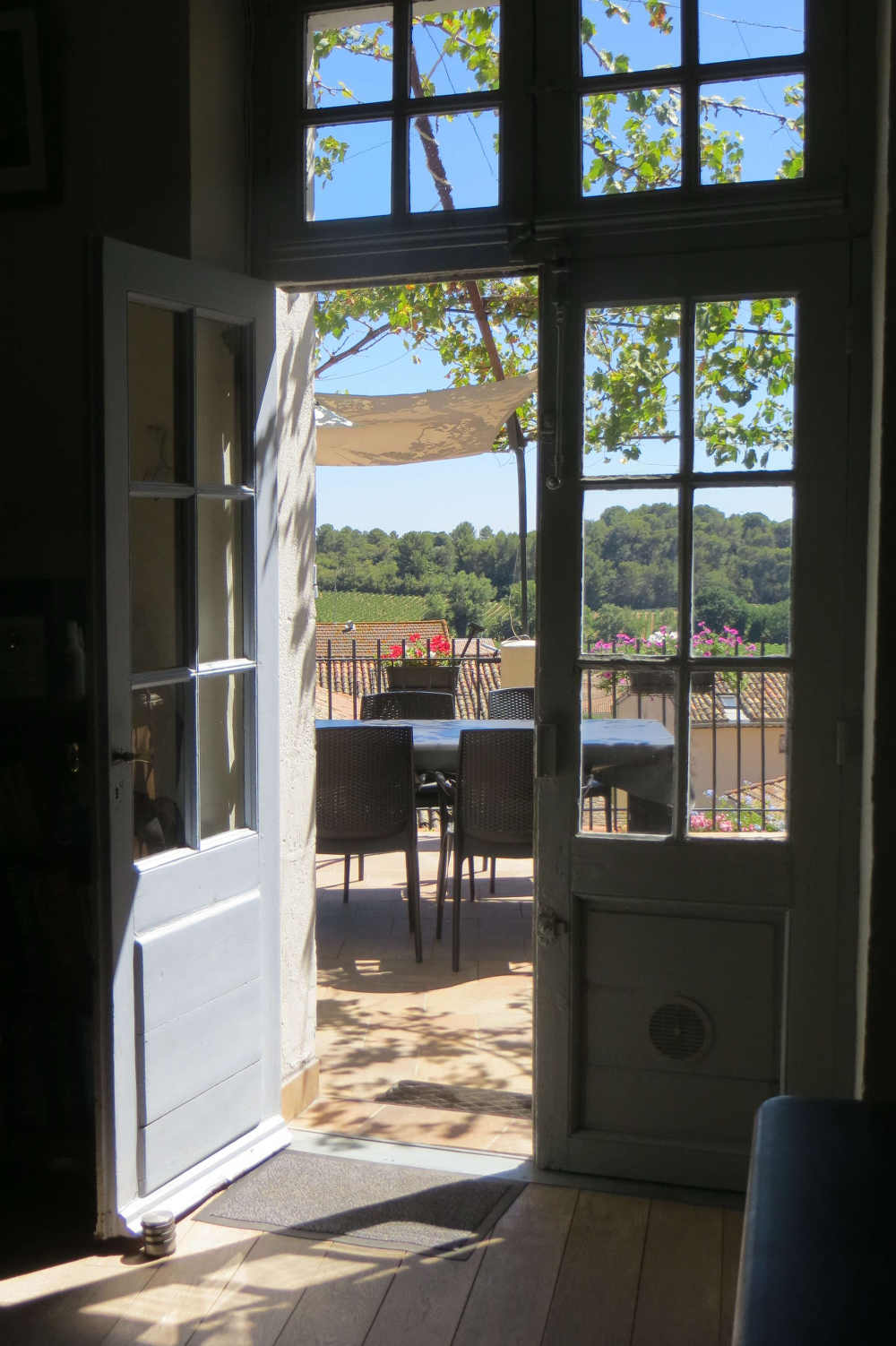

Euro-Toques chef Martin Dwyer, is much missed in Ireland since he and his wife Sile sold their eponymous restaurant in Waterford and moved to France. They now live in the Languedoc, where they take guests - and feed them very well.
This month: Martin continues his reflections on Finding Le Presbytere:
Once we had decided that we wanted to settle in the Languedoc we headed back to that area as soon as Sile got her school holidays in 2006. By that time we had a check list of what we needed for our new venture.
We needed at least three lettable bedrooms, all large enough to accommodate a bathroom en suite, and another, also en suite, for ourselves.
We wanted the house in the middle of a village, close to bakeries and shops, so our neighbours could keep an eye on the place in our absence.
We wanted a garden, big enough for a swimming pool (should we decide to get one) and certainly big enough for us to eat outside in the summer.
This house had to be within 100 km of Carcassonne airport.
It had to be of a certain age and charm.
It had to be within our budget (not huge).
It had to be in fairly reasonable nick, restoration would be possible, rebuilding would not.
We picked a camp site in Trebes, on the outskirts of Carcassonne, to be our base for the six weeks we were prepared to look.
We were armed with a list of auctioneers in and around the area. Our first appointment was with a charming lady called Pierette in Carcassonne. She showed us quite a few totally unsuitable properties, one that was almost a runner but came with an incredible barn, so rickety that it would surely, and with great expense, have to be demolished before we even contemplated restoring the main building.
She showed us a real Maison Bourgeois in the village of Bram just a few kilometres to the west of Carcassonne. This place had terrific kerb appeal. It had those gates and railings which we associate with period dramas set in fin de siècle France. It also had great gardens both front and back but these horrendously overgrown.
The house itself was not enormous but we noticed a lot of outbuildings at the bottom of the back garden and asked could we go and see them.
“But of course” said Madame “I haven’t been there for ages”, this said pointing to her walking cane.
Sile and I went off down the garden exploring the sheds at the bottom – it was obvious we were the first people there for many years. We had to beat our way to the door of these stables, which was what they turned out to be, and it was obvious that it would take a lot of money to make them habitable.
As we drove back to Carcassonne in Pierette’s little car I noticed that my trousers were covered in what I took to be burrs, I went to flick them off and they jumped up from my sweeping hand to land again. I was covered in fleas.
I screamed I confess like a hysterical girl, I then noticed that Pierette and Sile were also fairly well covered. There was no time for false modesty, within seconds we were out of the car on the road semi naked and beating and sweeping at each other and at the fleas.
Passing cars slowed down to watch the cabaret but we were far beyond caring. We eventually risked getting into the car again, even though I did notice that my white shirt was dotted with little blood spots where I had been bitten.
Pierette told us later that she rang Madame in Bram the following day to tell her what had happened. “I don’t suppose they will be wanting to buy the house then?” she said. She was right.
We went on from Pierette to investigate the many estate agents in Carcassonne, an exercise which left us with very little faith in the business acumen of the average French Immobilier.
Having been given our list of requirements they would, without shame, bring us to an apartment by the sea, a tiny house down a dark alley or even a small hotel which was many times our budget.
Often we would window shop the properties on the auctioneer’s window and pick out one which seemed to tick all the boxes only to be told with patient condescension: “Oh No! That house was sold months ago!”
We were beginning to despair at this stage, July was gone and we still hadn’t cracked it. Our next appointment however held great promise.
This time we were searching in the area known as Le Valley d’Orb which was a particularly lovely river valley area which followed the Orb River from where it rose in the Massif Central all the way down through Beziers to the sea.
Throughout this region there were villages scattered rather like the buttons on an eiderdown. This flat plain was interrupted regularly by villages built on the hills in the area. Most of these hills were built in a circle around the ancient church and were known as circulades.
In one of these circulades there was a Dutch auctioneer who had a reputation for getting things done; Freddy Rueda. His agency operated out of a café in the village of St Genies de Fontadet. We arrived there for our appointment and discovered that our personal agent would be Charles.
Charles, although totally French, had gone to the Guildhall in England to study music so spoke impeccable English. He arrived in the café with the usual pile of properties in a folio and then did something refreshingly different.
He asked us directly “What is it you actually want to buy?” We gave him our long list of requirements (see above). He listened. He took out his giant portfolio of properties, took out two sheets, dropped the rest and said:
“I am going to show you just two properties, the first has all of your requirements, but you will see it just for contrast, the second you will buy.” He brought us to the village of Autignac where there was indeed a possible property. But with a problem, the garden was about 100 metres down the road from the house, the house had the requisite amount of bedrooms but none big enough to take an en suite bathroom.
Then he drove us to the village of Thezan Les Beziers, which being a Circulade meant we spiralled up to the very top where, next to the church, was le Vieux Presbytere. “This place” he warned us as he put his key in the lock “is a bit smelly, it hasn’t been lived in for some years “
“However” he went on, “It has one thing which you didn’t ask for but once you have seen, you will want “ He then ushered us into a large pitch black room (all the shutters were closed), which did indeed smell, the S bends in the loos having long before dried out giving us direct access to the main sewer of the village.
We then headed down to the end where he opened first some French windows and then threw back some shutters. Sunlight streamed into the room through the south facing door on to the terrace, Charles turned triumphantly back to us; “It has a view.”
It had, from the large terrace we could see a long wide plain which led all the way down South to the Mediterranean – which was beyond our horizon - but we could clearly see the Pyrenees even though they were 150 kilometres away to the south.
Under the terraces was a charming little garden which came with a full sized tree covered in fruits like bunches of little golden balls. The house, Charles told us, had six bedrooms and a large attic space ready to convert into more.
We had found our Chambre d’Hote.
-------------
 Martin Dwyer started cooking professionally over 40 years ago in the legendary “Snaffles Restaurant” in Dublin. After a time in a Relais Chateau in Anjou and in “The Wife of Bath” in Kent he opened his own much acclaimed restaurant, “Dwyers”, in Waterford in 1989. In 2004 he sold this and moved south to France where he and his wife Síle bought and restored an old presbytery in a village in the Languedoc. They now run Le Presbytère as a French style Chambre d’Hôte. Martin however is far too passionate about food to give up cooking so they now enjoy serving dinner to their customers on the terrace of Le Presbytère on warm summer evenings. Martin runs occasional cookery courses in Le Presbytère and Síle’s brother Colm does week long Nature Strolls discovering the Flora and Fauna of the Languedoc.
Martin Dwyer started cooking professionally over 40 years ago in the legendary “Snaffles Restaurant” in Dublin. After a time in a Relais Chateau in Anjou and in “The Wife of Bath” in Kent he opened his own much acclaimed restaurant, “Dwyers”, in Waterford in 1989. In 2004 he sold this and moved south to France where he and his wife Síle bought and restored an old presbytery in a village in the Languedoc. They now run Le Presbytère as a French style Chambre d’Hôte. Martin however is far too passionate about food to give up cooking so they now enjoy serving dinner to their customers on the terrace of Le Presbytère on warm summer evenings. Martin runs occasional cookery courses in Le Presbytère and Síle’s brother Colm does week long Nature Strolls discovering the Flora and Fauna of the Languedoc.
Le Presbytère can be seen at: www.lepresbytere.net;
email: martin@lepresbytere.net
Twitter: www.twitter.com/DwyerThezan
An Irish Chef in France
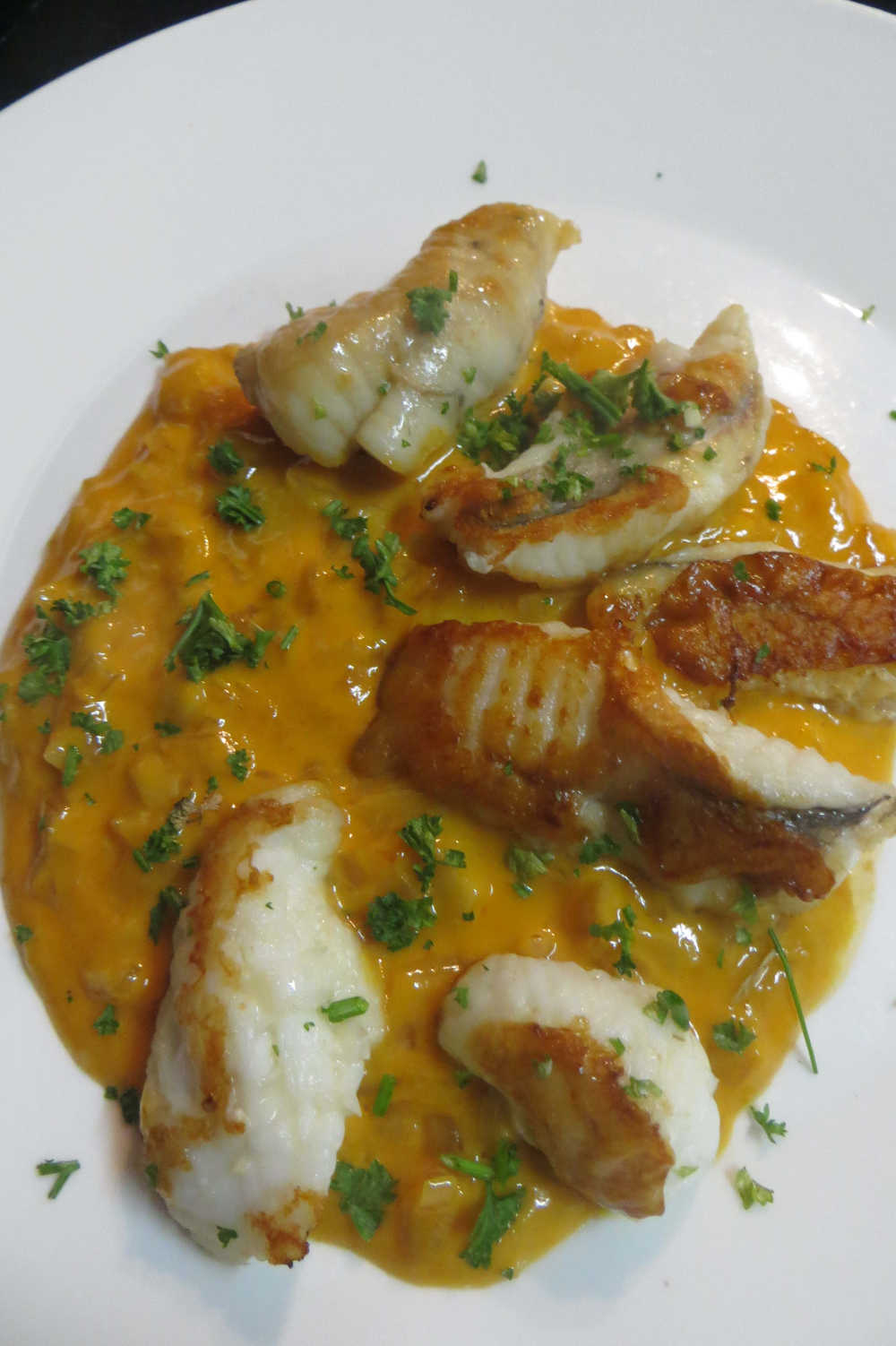
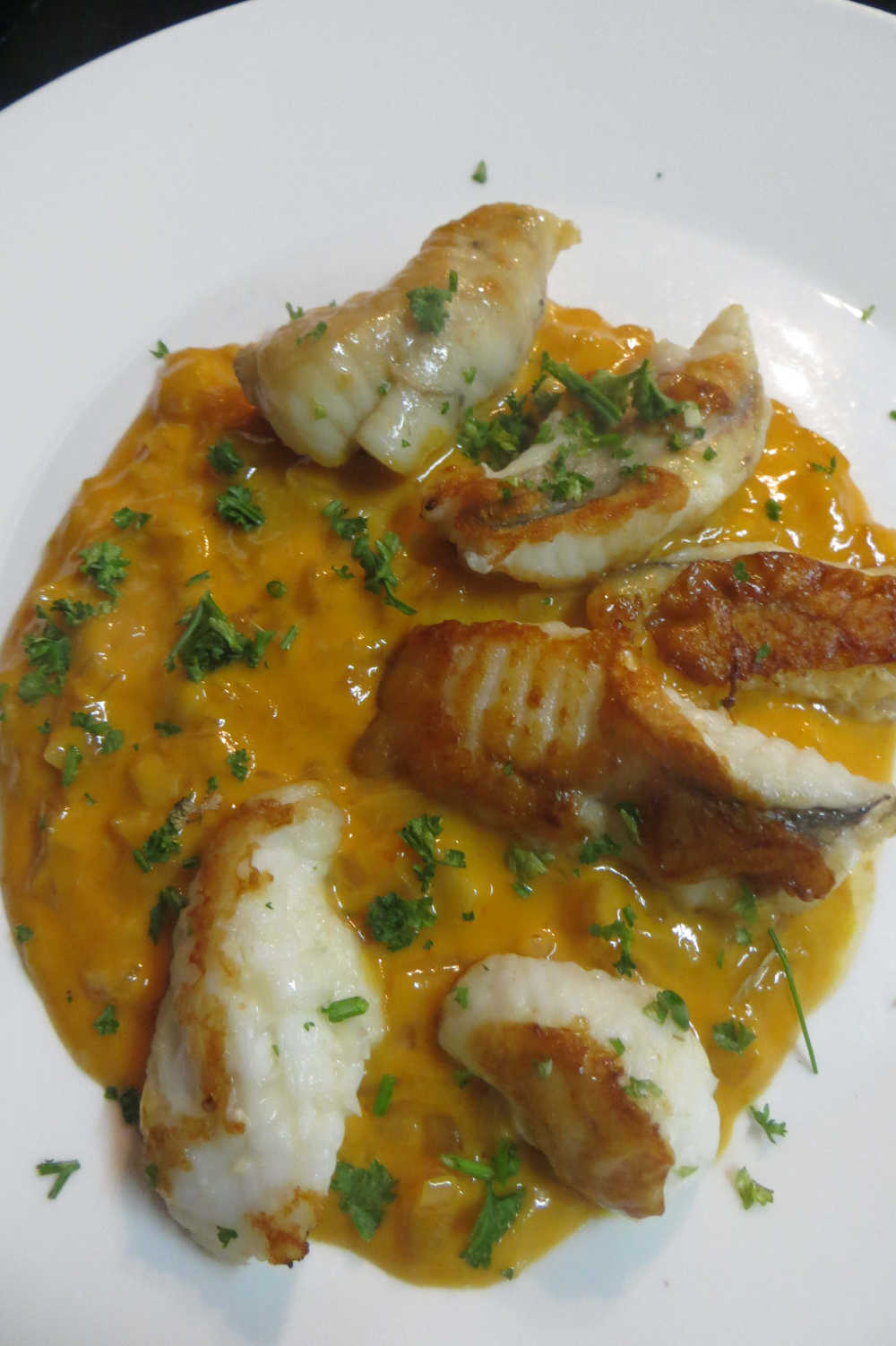
This month our man in the Languedoc, Martin Dwyer, shares the wonderful lobster recipe, Homard à l’Américaine and its history - and wishes you all a Joyeux Noel!
The French traditionally celebrate Christmas not with a large meal on Christmas day but with one on Christmas Eve - and this traditionally, but no longer, after midnight mass which gave it the extra charm of a midnight feast.
This feast was, unlike our more northern tradition, not of turkey, or goose but of Fruits de Mer, fish in its many incarnations and preferably of the shelled variety; oysters, prawns and especially lobster.
Probably the star of all the lobster dishes in the French repertoire is Homard à l’Américaine and I imagine that many French households pulled out the stops for this wonderful dish on the day before Christmas.
The title of the dish begs the question of why this firmly French masterpiece should appear to have come from America? Well of course, it didn’t. It is generally accepted that this classic French dish was first produced by French chef Pierre Fraisse in his restaurant in Paris at the end of the nineteenth century.
Various theories have been mooted as to why he should have called it after the new world, a group of Bretons reckoned he meant to call it Homard Amorique (after the old name for Brittany) but that makes no sense - it is clearly a dish of the Mediterranean; tomatoes, olive oil garlic are not part of the Breton way of cooking. Elizabeth David in French Provincial Cooking suggests that he called it after America because Fraisse had spent some time there before his Paris Restaurant but I think all these theories miss the point.
Just as in Ireland we used to say in the Fifties and Sixties about a particularly stylish and modern house, “It is like America at home”, so in France is “American” used as a compliment. We need look no further than Jacques Brel who, in the sixties in “Madeleine” has his unfortunate, constantly jilted hero sing that his Madeleine is “mon Noel, c’est mon Amérique a moi”- “she is my Christmas, my America to me”. So we see that Chef Fraisse was merely producing a dish which would be – he hoped - the height of fashion.
But of course this dish is far from being an invention of Monsieur Fraisse. There are a lot of variations out there now, all declaring themselves to be the original masterpiece, but, bearing in mind that M. Fraisse came from Sete (our nearest port here in the Languedoc) and the total similarity between the ingredients and the classic fish dish of the Languedoc; “Bourride”, I think there is little doubt but that the origins of the dish came from the Mediterranean and more particularly from the Languedoc.
My version is one which makes strong references to my part of France but before I give you my recipe I would like to add a note of comfort to Irish readers. If you fear cooking lobster because of the way they are killed or their expense, a delicious version of this dish can be used using our own Dublin Bay Prawns, and another using the even more humble monkfish.
Homard à l’Américaine (for 4)
2 small or 1 medium lobster
6 shallots
2 tablespoons olive oil
3 cloves garlic
glass of dry white wine (picpoul de pinet would be perfect)
a glass of cognac
1 dessertspoon of tomato purée
2 tablespoons of aioli
If your lobster is still alive (and there is no problem about buying a cooked one from a reputable fish monger) you need to plunge it into a pot of boiling water and bring it back to a rolling boil before you proceed. Then take the flesh from the shell and cut it into, smallish - not too small - pieces.
(I would do the same with the prawns, but leave them whole, and if using monkfish would skin it, cut it into medallions, sear it in oil and cook for about five minutes with the wine and shallot.)
Chop the shallots and the garlic finely and sweat then slowly in the olive oil until transparent, add the white wine and tomato purée, let these simmer together for a few minutes then put to one side.
In a fresh pan sear the lobster pieces in olive oil and then set alight with the cognac, now add the shallot and wine to the fish and simmer for a few minutes and then remove the lobster and keep warm.
With the pan on the lowest heat whisk in the aioli until the sauce thickens a little, put the pieces of lobster back in the sauce to reheat and serve with rice.
Joyeux Noel!
-------------
 Martin Dwyer started cooking professionally over 40 years ago in the legendary “Snaffles Restaurant” in Dublin. After a time in a Relais Chateau in Anjou and in “The Wife of Bath” in Kent he opened his own much acclaimed restaurant, “Dwyers”, in Waterford in 1989. In 2004 he sold this and moved south to France where he and his wife Síle bought and restored an old presbytery in a village in the Languedoc. They now run Le Presbytère as a French style Chambre d’Hôte. Martin however is far too passionate about food to give up cooking so they now enjoy serving dinner to their customers on the terrace of Le Presbytère on warm summer evenings. Martin runs occasional cookery courses in Le Presbytère and Síle’s brother Colm does week long Nature Strolls discovering the Flora and Fauna of the Languedoc.
Martin Dwyer started cooking professionally over 40 years ago in the legendary “Snaffles Restaurant” in Dublin. After a time in a Relais Chateau in Anjou and in “The Wife of Bath” in Kent he opened his own much acclaimed restaurant, “Dwyers”, in Waterford in 1989. In 2004 he sold this and moved south to France where he and his wife Síle bought and restored an old presbytery in a village in the Languedoc. They now run Le Presbytère as a French style Chambre d’Hôte. Martin however is far too passionate about food to give up cooking so they now enjoy serving dinner to their customers on the terrace of Le Presbytère on warm summer evenings. Martin runs occasional cookery courses in Le Presbytère and Síle’s brother Colm does week long Nature Strolls discovering the Flora and Fauna of the Languedoc.
Le Presbytère can be seen at: www.lepresbytere.net;
email: martin@lepresbytere.net
Twitter: www.twitter.com/DwyerThezan
An Irish Chef in France - Remembering Veronica Steele
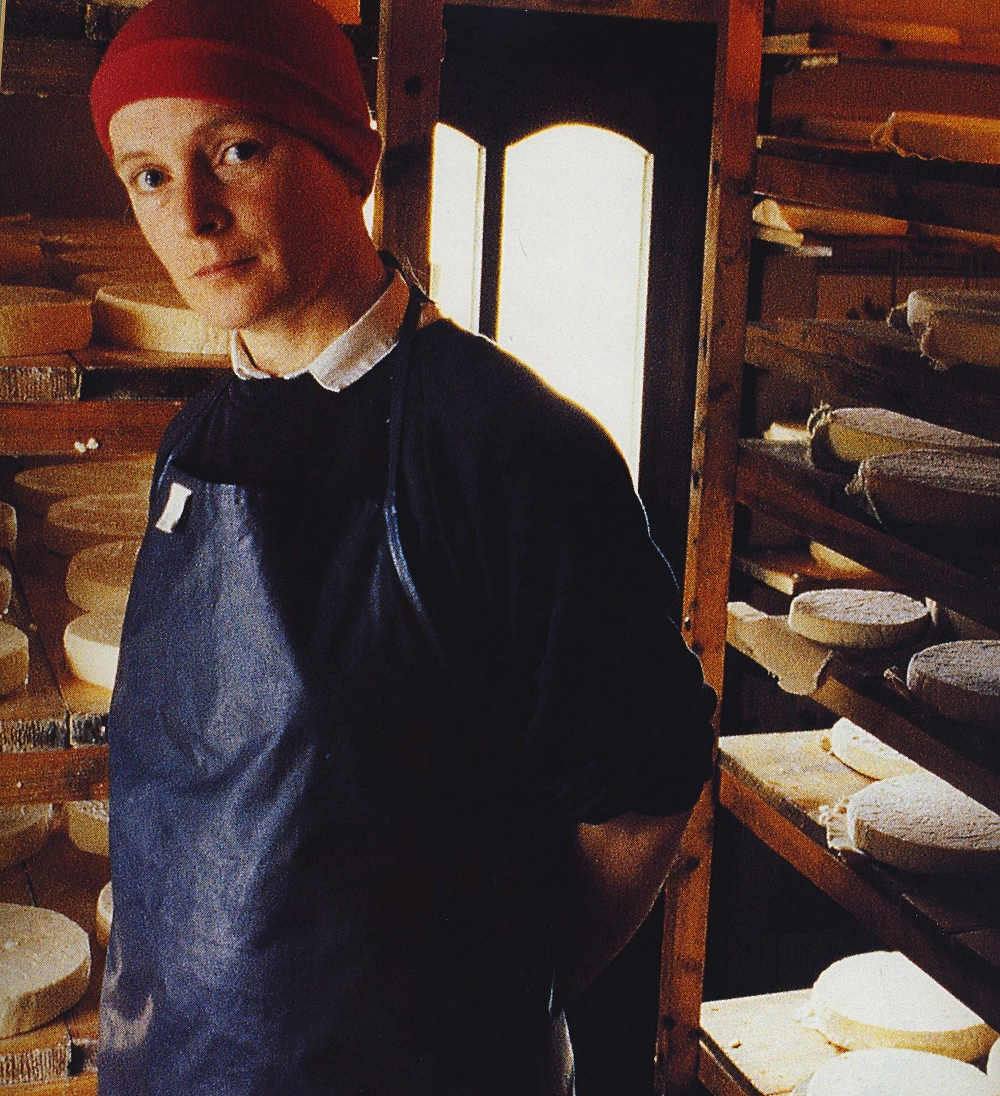

This month our man in the Languedoc, Martin Dwyer is Remembering Veronica Steele
Veronica Steele, who died last month was indeed one of the most important innovators in the food revolution of Ireland. The story of how she, virtually single handedly, reinvented the cheese industry is now well known, how an almost chance tasting by Dermot Ryan and Myrtle Allen in Annie Goulding's restaurant in Sneem led to the wonderful flowering of Irish craft cheese.
At the end of the seventies and early eighties I was the chef in George Gossip's restaurant, Ballinakill House in Waterford. Myrtle Allen was an old friend of the Gossip family and as she was on the board of Newtown School in Waterford was a frequent visitor. I remember her coming into the kitchen to me and telling me about this most exciting new cheese called Milleens which was coming out of West Cork.
For our holidays in 1980 Síle and I decided to go camping in Allihies and during that holiday we called in to see the place where this new cheese was being made. As soon as Veronica answered the door Síle and she recognised each other, they had both attended Scoil Caitriona in Dublin and, while not in the same class, Veronica was in the same class as Síle's sister Una.
That factor, in typical Irish fashion, kick started our friendship. I remember that I was determined to put Milleens on the Cheese Board in Ballinakill House and this we managed for a few months with a complicated delivery system which involved (as I remember it) using CIE, the national transport company, as the courier.
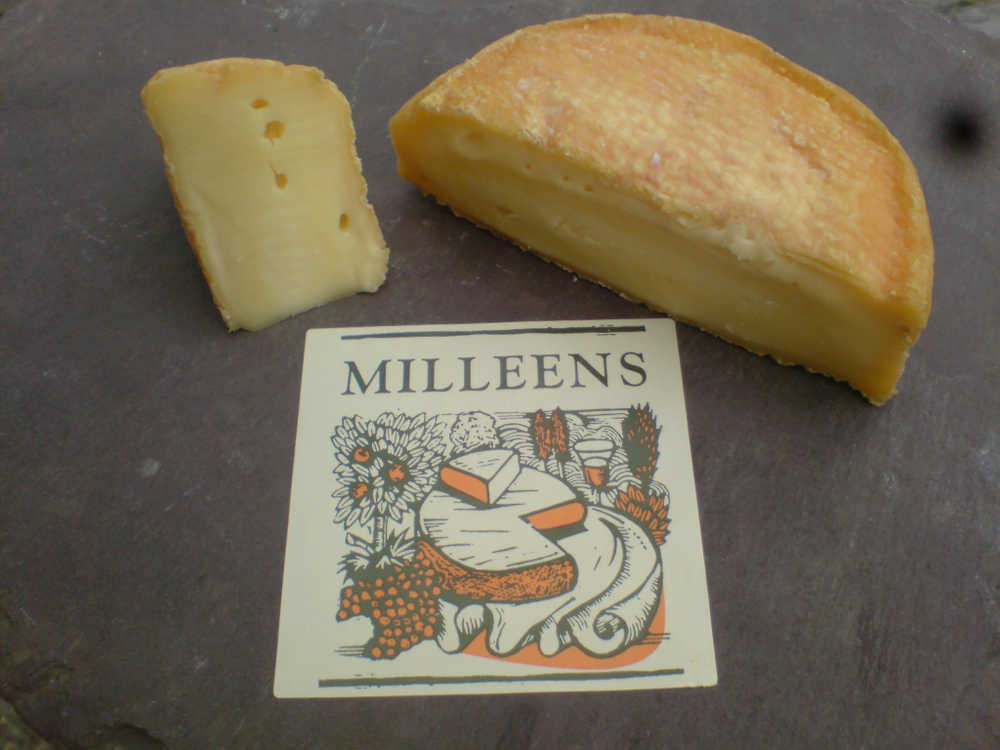
Shortly after I remember Milleens began to develop a distribution system and by the time I had moved through other restaurants in Waterford we could get it delivered by a specialised food courier or buy it in the excellent (but now long closed) Chapmans on the quay in Waterford.
When I became Chief Commissioner of the Irish branch of Eurotoques in 2005, after we had sold Dwyers Restaurant in Waterford, Veronica (who was in the process of passing on the making of Milleens to her son Quentin) and I would meet up as we attended various meetings and conferences throughout the country.
In what was probably 2006 we met together as we were both speaking at a meeting about New Irish Food Products at Castle Leslie in Co. Monaghan. I remember Veronica nabbing me for a lift back to Dublin after the talks and so we had the time (unusual in both of our lives) to have a couple of hours chat with just the two of us. It was then that she told me the story about John Ehle
When Veronica started her cheese making she found it extremely difficult to find a book of instructions to help her on her way. She could find various leaflets which had recipes but it wasn’t until she found John Ehle’s book on the cheeses of France and England that she found something (this quote from her, is in Colman Andrews book “The Country Cooking of Ireland) which “told her what cheese was”.
Because she had found the Ehle book so useful she used it as her bible of cheese and if she was contacted by anyone to recommend a book to start them off in the cheese business she would guide them to it.
Then she told me that one day, about twenty years after she had first read Ehle’s book, she had been in Allihies in her house when she heard a knock at the door and there was a middle aged gentleman outside - it was the same John Ehle.
“I have come to see you” he said ”because I want tell you of the amazing rise in the sale of my book over the last few years, not just here and in Britain but in America also.” When he had asked his publisher to explain this they too said that they were intrigued and had discovered that it was her recommendations which had spurred this rise.
“So” he said “I decided that I should come to see you in person to thank you for this” This story is one of the reasons why I think that Veronica had a huge influence not just in the risorgimento of the craft cheese industry here in Ireland but also in Britain and the States.
I want to finish on a purely personal note, I have a Facebook friend here in France who is from Beara but now lives in Paris. She was at home at Christmas and bumped into Norman, Veronica’s husband. My name came up in conversation and Norman told my friend that Veronica had been full of plans to come and stay with us in Le Presbytere just around the time that her horrible disease was diagnosed.
This is sad, I would love to have had Veronica and Norman stay with us here, her pioneering work and her great renown as a cheese maker lay very lightly on her shoulders. She had a great sense of humour and had wonderful witty turn of phrase and any visit from her would have been a pleasure. She will be missed.
-------------
 Martin Dwyer started cooking professionally over 40 years ago in the legendary “Snaffles Restaurant” in Dublin. After a time in a Relais Chateau in Anjou and in “The Wife of Bath” in Kent he opened his own much acclaimed restaurant, “Dwyers”, in Waterford in 1989. In 2004 he sold this and moved south to France where he and his wife Síle bought and restored an old presbytery in a village in the Languedoc. They now run Le Presbytère as a French style Chambre d’Hôte. Martin however is far too passionate about food to give up cooking so they now enjoy serving dinner to their customers on the terrace of Le Presbytère on warm summer evenings. Martin runs occasional cookery courses in Le Presbytère and Síle’s brother Colm does week long Nature Strolls discovering the Flora and Fauna of the Languedoc.
Martin Dwyer started cooking professionally over 40 years ago in the legendary “Snaffles Restaurant” in Dublin. After a time in a Relais Chateau in Anjou and in “The Wife of Bath” in Kent he opened his own much acclaimed restaurant, “Dwyers”, in Waterford in 1989. In 2004 he sold this and moved south to France where he and his wife Síle bought and restored an old presbytery in a village in the Languedoc. They now run Le Presbytère as a French style Chambre d’Hôte. Martin however is far too passionate about food to give up cooking so they now enjoy serving dinner to their customers on the terrace of Le Presbytère on warm summer evenings. Martin runs occasional cookery courses in Le Presbytère and Síle’s brother Colm does week long Nature Strolls discovering the Flora and Fauna of the Languedoc.
Le Presbytère can be seen at: www.lepresbytere.net;
email: martin@lepresbytere.net
Twitter: www.twitter.com/DwyerThezan
An Irish Chef in France
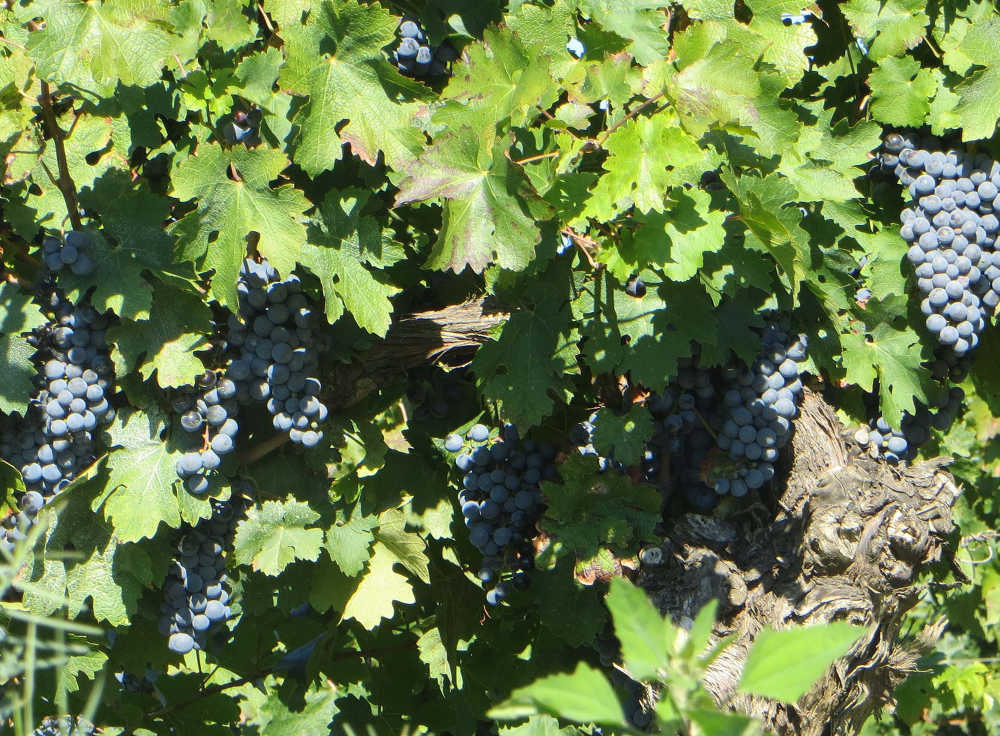
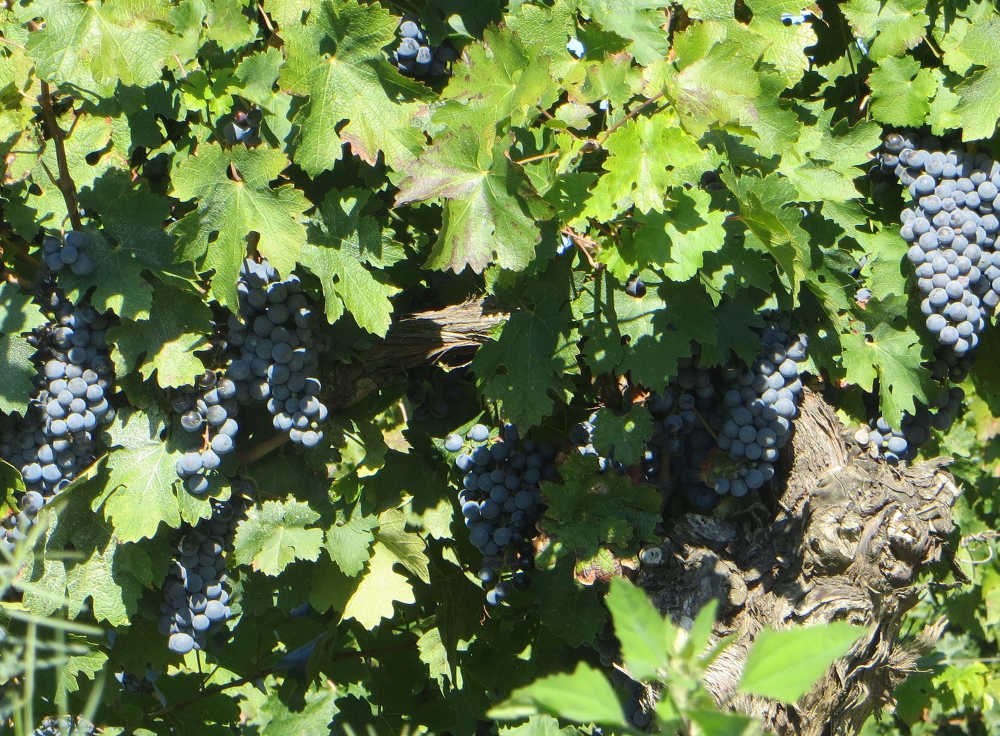
This month: A little introduction to The Wines of the Languedoc - there are lots of them selling in Ireland now, as Martin noticed on his last visit.
We are just back from a winter break in the Cote d’Azur, that part of the country which is known, outside France, as The French Riviera. This is a wonderful part of France and one that has enjoyed a healthy tourist trade for many many years.
This, in part is due to the gentle climate it enjoys even in winter, being sheltered from the cold northern winds by the towering Alps - unlike its neighbours on the Rhone in Provence which are whipped by the Mistral. This tourist money is of course reflected in prices here and we noticed that things are a lot dearer than in our native Languedoc.
The most noticeable price difference we found was the cost of wines, particularly in the neighbouring Rosés from Provence which seem to us to come in at about twice the price of similar Rosés from Languedoc.
Of course it could be argued that the quality is reflected in the price but, even though we did enjoy our glasses of local pinks we felt that the price hike which Provencal enjoys had more to do with the name Rosé de Provence than the inherent quality. And thereby hangs a tale.
The Languedoc has a more intense cultivation of vines per square hectare than anywhere else on earth, the area has been growing grapes for hundreds of years and has learned that the more grapes you grow, the more wine you make and sell, the richer you get.
In the 19th Century the Languedoc was the largest producer of wine anywhere. At that time you must appreciate that the average French worker was being advised to try not to drink more than a litre of wine PER DAY, and also being advised to avoid, at all costs the poisonous effects of water consumption.
Languedoc rose to this challenge by specializing in quantity rather than quality in its wine production and so it became the major wine making part of France.
Of course this quantity production came at the expense of quality and so its reputation became wine which was cheap, because of its high production, but also was of low quality.
This was boom time in the Languedoc and the evidence is everywhere. Our village and the nearby town of Beziers are full of impressive maisons de Vignerons, large houses of the bourgeoisie, built in the second half of the 19th Century when they sold so much wine to the rest of the country that they could nearly afford to print their own money. That this was done on the back of the workers is true, there was a huge vine workers strike here in 1906 which did improve the workers lives a little.
But, as the twentieth century progressed, the wines of Languedoc began to come under pressure from both the new world and from the old. Countries like Spain and Italy, Australia, New Zealand, America - North and South - began to compete with Languedoc for the cheap end of the market.
Because Languedoc, with some noble exceptions, had decided to throw their efforts into quantity and to growing the vines which produced the greatest yield, they were found lacking. Right up to the sixties, when I had my first holidays in France, you could buy wine from this area for very small money. I remember a wine from Corbières called Le Velour d’Estomac (which it wasn’t) being sold in the supermarket for the modern equivalent of about 25 cent a litre.
However, for the last twenty or thirty years the wine makers of Languedoc have been making strenuous efforts to improve their quality. We see a lot of older vines being dug up and discarded and new vines being planted.
There have always been the noble exceptions: St Chinian and Faugères are good examples of wines, which consistently produced quality over the years and these marques are now well placed in the market, producing excellent quality and still extremely well priced.
Other areas like Pinet- with its distinctive Picpoul grape, have become runaway best sellers in the last few years.I can still buy wines here of excellent quality which are cheaper than any comparable wines from other parts of France, or indeed globally.
Sometimes fortune lands one in the right place at the right time !
-------------
 Martin Dwyer started cooking professionally over 40 years ago in the legendary “Snaffles Restaurant” in Dublin. After a time in a Relais Chateau in Anjou and in “The Wife of Bath” in Kent he opened his own much acclaimed restaurant, “Dwyers”, in Waterford in 1989. In 2004 he sold this and moved south to France where he and his wife Síle bought and restored an old presbytery in a village in the Languedoc. They now run Le Presbytère as a French style Chambre d’Hôte. Martin however is far too passionate about food to give up cooking so they now enjoy serving dinner to their customers on the terrace of Le Presbytère on warm summer evenings. Martin runs occasional cookery courses in Le Presbytère and Síle’s brother Colm does week long Nature Strolls discovering the Flora and Fauna of the Languedoc.
Martin Dwyer started cooking professionally over 40 years ago in the legendary “Snaffles Restaurant” in Dublin. After a time in a Relais Chateau in Anjou and in “The Wife of Bath” in Kent he opened his own much acclaimed restaurant, “Dwyers”, in Waterford in 1989. In 2004 he sold this and moved south to France where he and his wife Síle bought and restored an old presbytery in a village in the Languedoc. They now run Le Presbytère as a French style Chambre d’Hôte. Martin however is far too passionate about food to give up cooking so they now enjoy serving dinner to their customers on the terrace of Le Presbytère on warm summer evenings. Martin runs occasional cookery courses in Le Presbytère and Síle’s brother Colm does week long Nature Strolls discovering the Flora and Fauna of the Languedoc.
Le Presbytère can be seen at: www.lepresbytere.net;
email: martin@lepresbytere.net
Twitter: www.twitter.com/DwyerThezan
An Irish Chef in France
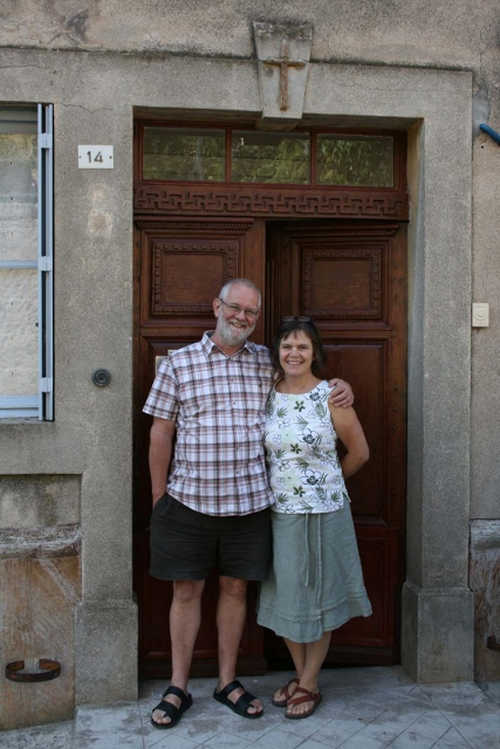

Euro-Toques chef Martin Dwyer, is much missed in Ireland since he and his wife Sile sold their eponymous restaurant in Waterford and moved to France. They now live in the Languedoc, where they take guests - and feed them very well.
This month: On French School Meals
Running a chambre d'hote in France, which also serves table d'hote meals to guests, you get a real insight into the eating habits of various nations.
As we don't offer choices on our table d'hote meals we always ask in advance if anyone has any foods which they don't want served. Most people are fine, will try anything- of course there are people with genuine dietary problems, which we cater for, but also there are people who give you a long list of foods which they don't like.
Sometimes, and this seems to apply particularly to children, this list can be quite long. We have noticed, over the years one national difference: The French, and particularly French children, are certainly much less fussy when it comes to food.
Children in France tend to eat, and with relish, what you serve them. We imagined initially that this was just a demonstration of the French attitude to food but we have realised over the years that it has much more to do with school meals.
All schools in France serve a proper lunch to their pupils, usually coming from a serious dedicated kitchen on the premises. Our neighbour’s son, who is a structural engineer, told me that the specifications for a school kitchen were exactly the same as those for a small hotel.
Every week in the Mairie in the village the menus for the school lunches are listed. This is usually three courses and very similar to the choices you would get in a simple table d’hote in a busy restaurant. The meals are supervised and nutritionally balanced but also basically adult food with none of the chicken nuggets and fish fingers being offered as “Children’s Menus “in Ireland.

In 2004 and 2005 when I was chief commissioner for Euro Toques Ireland I made it my special mission to try and improve the quality of the food we served to children in restaurants. One of the first things we discovered was that the reason for the paucity of choice on the typical children’s menu was that by the time children went to school in Ireland they were already picking from a very limited choice of foods from home, and so were not inclined to step outside these choices to experience newer tastes.
We in Euro Toques did some days in Primary schools around the country and one of the better discoveries was that the emigrant children from other countries were much more open to new tastes and flavours and that they encouraged our Irish children to expand their range of tastes. I notice that Bord Bia now operate a similar programme in Irish schools.
I am impressed to see in this month's Journal de Beziers that Pierre Augé, from the well-known Petit Pierre Restaurant, which has been awarded an “Assiette” from Michelin (and he was a finalist in the French Master Chef) has now been called in as consultant to oversee the food in the schools in Beziers. A step in the right direction.
If our children are not encouraged to experiment with new tastes and flavours it does not bode well for our next generation of chefs.
-------------
 Martin Dwyer started cooking professionally over 40 years ago in the legendary “Snaffles Restaurant” in Dublin. After a time in a Relais Chateau in Anjou and in “The Wife of Bath” in Kent he opened his own much acclaimed restaurant, “Dwyers”, in Waterford in 1989. In 2004 he sold this and moved south to France where he and his wife Síle bought and restored an old presbytery in a village in the Languedoc. They now run Le Presbytère as a French style Chambre d’Hôte. Martin however is far too passionate about food to give up cooking so they now enjoy serving dinner to their customers on the terrace of Le Presbytère on warm summer evenings. Martin runs occasional cookery courses in Le Presbytère and Síle’s brother Colm does week long Nature Strolls discovering the Flora and Fauna of the Languedoc.
Martin Dwyer started cooking professionally over 40 years ago in the legendary “Snaffles Restaurant” in Dublin. After a time in a Relais Chateau in Anjou and in “The Wife of Bath” in Kent he opened his own much acclaimed restaurant, “Dwyers”, in Waterford in 1989. In 2004 he sold this and moved south to France where he and his wife Síle bought and restored an old presbytery in a village in the Languedoc. They now run Le Presbytère as a French style Chambre d’Hôte. Martin however is far too passionate about food to give up cooking so they now enjoy serving dinner to their customers on the terrace of Le Presbytère on warm summer evenings. Martin runs occasional cookery courses in Le Presbytère and Síle’s brother Colm does week long Nature Strolls discovering the Flora and Fauna of the Languedoc.
Le Presbytère can be seen at: www.lepresbytere.net;
email: martin@lepresbytere.net
Twitter: www.twitter.com/DwyerThezan
An Irish Chef in France - Driving Through France
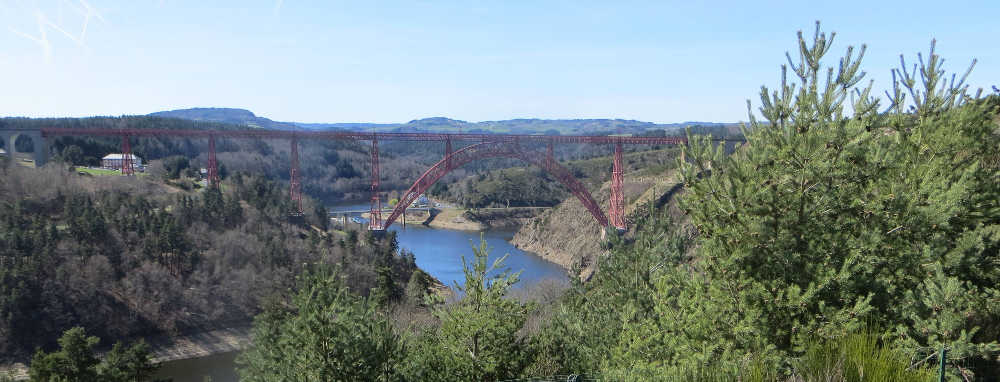
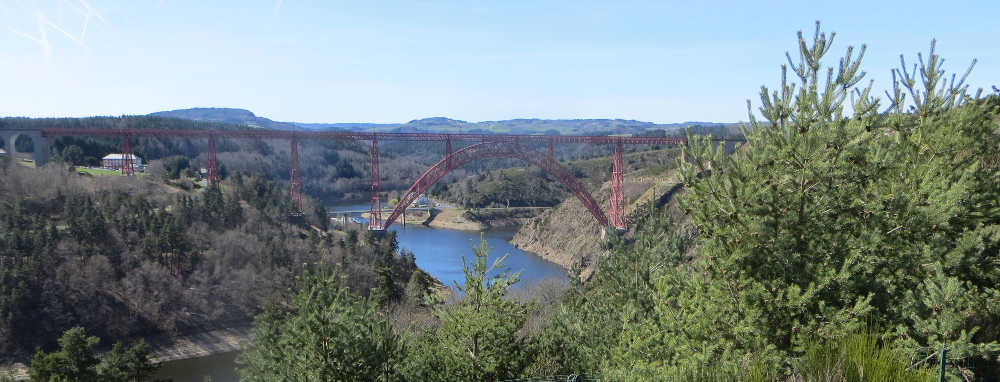
Euro-Toques chef Martin Dwyer, is much missed in Ireland since he and his wife Sile sold their eponymous restaurant in Waterford and moved to France. They now live in the Languedoc, where they take guests - and feed them very well.
This month: Driving Through France.
Last month we went back to Ireland for a catch-up with the friends and relatives. As we were going for about three weeks we thought it worth while to drive to Cherbourg and take the ferry across to Rosslare. As we live in the very south of France, we can see Spain from our terrace - on a clear day - we are over a thousand kilometres from the Channel so this is a journey we don’t do often on our trips back to our native land.
Modern air flights and charges mean that it is no longer practical for us to take the long road home, and sadly I mourn this. I love the long slow ten hour (about 14 with stops) drive through France.
The first time I was ever in France I was en route for Spain, this was in 1963 and flights, if they even existed, were expensive and infrequent. The route to Spain was by train through France and, as these trains were equipped with sleeping berths, I remember the whole experience as being a very pleasant one.
When I had my own family we still used the ferries to go on our camping holidays in France. These started out (as all Irish family camping holidays did) in Brittany and Normandy. Then, as the weather in northern France became more and more like Irish winter weather - and the children became able to endure longer trips - we began to descent further and further into La France Profonde. It was on these trips I guess when I began to fall in love with the amazing and much varied regions and departments which the French like to call l’Hexagone.
Having spent a most enjoyable three weeks in Ireland this Spring we boarded a ferry again in Rosslare, as we had often before, and after eighteen hours of complete relaxation cruising on the (this trip) still, calm waters of the Atlantic, we headed south, home to the Languedoc.
Leaving the ferry in Normandy can be very un-surprising for an Irishman. The countryside is familiar, the farming bucolic like our own. There are cows and horses, crops and gardens. Hedges are much like Irish ones with Hawthorn and Sloes and in the banks there are primroses, much as you would find in Wexford. The temperature is also familiar, in April there will still be a nip in the air and not a lot of indications that summer is coming in.
Moving into the next part of France things start to become a little more exotic. The area known as the Pays du Loire always has been (and still is) one of the more affluent parts of France. Here the houses and villages are made of cut stone and you cannot avoid passing over wide slowly moving rivers, very beautiful in their tree bordered elegance.
Small detours in this area will bring you to marvellous chateaux. This is the area where the kings and aristocracy liked to build their hunting lodges and these in time often became their main residences. This was often the area where we broke our journey to visit one, this trip was no exception and we managed to fit in two!
Leaving the Loire area we come to the centre which is probably the bread basket of France, where large areas are planted with crops with fields extending as far as the eye can see and with the small fields of Normandy with their hedge boundaries now just a memory.
This is the part where I just put the foot down and drive. It is flat, and dull, here. In previous summers we used to pass through huge fields of sunflowers here but this spring these seemed to have been replaced by acres of bright yellow Rape shining brightly in the sun.
The South centre of France is a plateau which rises from the Loire Valley and the Limousin and doesn’t descend again until it comes to the Languedoc and the plains of the Mediterranean.
This part of the journey is probably the most beautiful.
As one rises into the Massif Central the vegetation changes dramatically. Here one is surrounded by poorer land, moorland cropped short by sheep and goats and the hardy cattle of the Auvergne. Everywhere are the old stubs of volcanoes, fabulous primitive shapes which become snow covered in winter, and provide skiing holidays for the people in the know.
This road we are on now, the A 75 Autoroute is toll free once we pass Clermont Ferrand. This is because it was built by the French government, started in the socialist mid-century, to provide a route for the workers of the north to the beaches on the Languedoc. It was finally completed about five years ago.
The undoubted high point of the A75 is passing over the Viaduct of Millau, it is one of the highest bridge spans in the world and passing over it is a bit like flying.
But before Millau the autoroute will have passed another beautiful bridge. The Viaduct de Garabit straddles the Truyere river its delicate steel supports making it look like the Eiffel Tower is lying on its side across the river. This is not surprising really as it was designed by the same man (in 1842) and in its day was also one of the tallest bridges in the world. It is worth stopping to look at from the nearest rest area.
After Millau we descend down the Massif into the warm sunny Languedoc. (Last week it went from -1C in Normandy to 21C on our terrace.) Here again we are surrounded by the red roof tiles of the Mediterranean and surrounded by familiar grape vines which are the dominant crop of the area. We are home.
-------------
 Martin Dwyer started cooking professionally over 40 years ago in the legendary “Snaffles Restaurant” in Dublin. After a time in a Relais Chateau in Anjou and in “The Wife of Bath” in Kent he opened his own much acclaimed restaurant, “Dwyers”, in Waterford in 1989. In 2004 he sold this and moved south to France where he and his wife Síle bought and restored an old presbytery in a village in the Languedoc. They now run Le Presbytère as a French style Chambre d’Hôte. Martin however is far too passionate about food to give up cooking so they now enjoy serving dinner to their customers on the terrace of Le Presbytère on warm summer evenings. Martin runs occasional cookery courses in Le Presbytère and Síle’s brother Colm does week long Nature Strolls discovering the Flora and Fauna of the Languedoc.
Martin Dwyer started cooking professionally over 40 years ago in the legendary “Snaffles Restaurant” in Dublin. After a time in a Relais Chateau in Anjou and in “The Wife of Bath” in Kent he opened his own much acclaimed restaurant, “Dwyers”, in Waterford in 1989. In 2004 he sold this and moved south to France where he and his wife Síle bought and restored an old presbytery in a village in the Languedoc. They now run Le Presbytère as a French style Chambre d’Hôte. Martin however is far too passionate about food to give up cooking so they now enjoy serving dinner to their customers on the terrace of Le Presbytère on warm summer evenings. Martin runs occasional cookery courses in Le Presbytère and Síle’s brother Colm does week long Nature Strolls discovering the Flora and Fauna of the Languedoc.
Le Presbytère can be seen at: www.lepresbytere.net;
email: martin@lepresbytere.net
Twitter: www.twitter.com/DwyerThezan
An Irish Chef in France
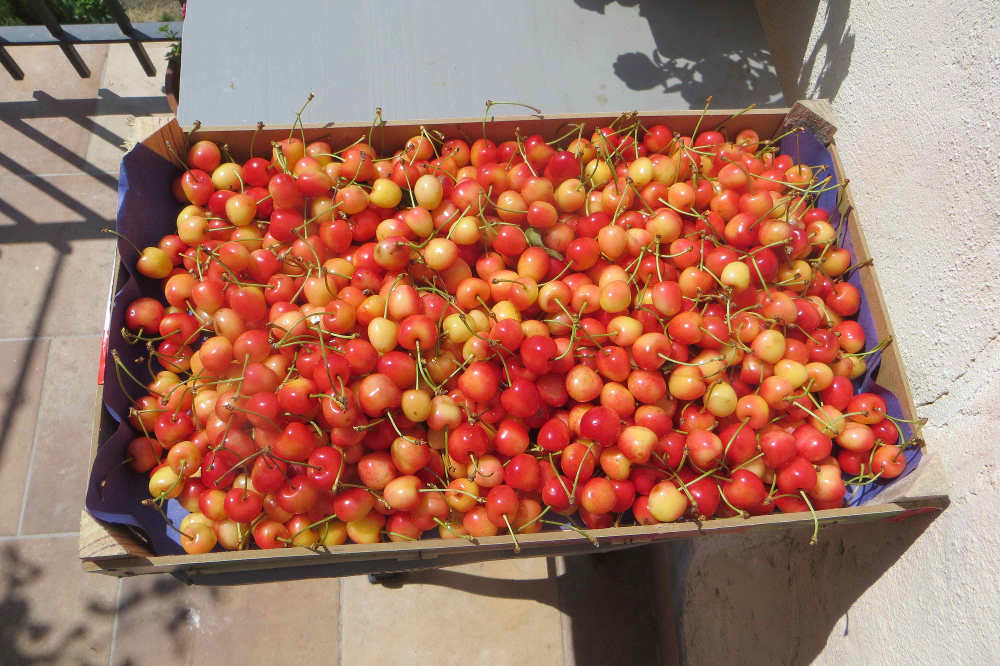
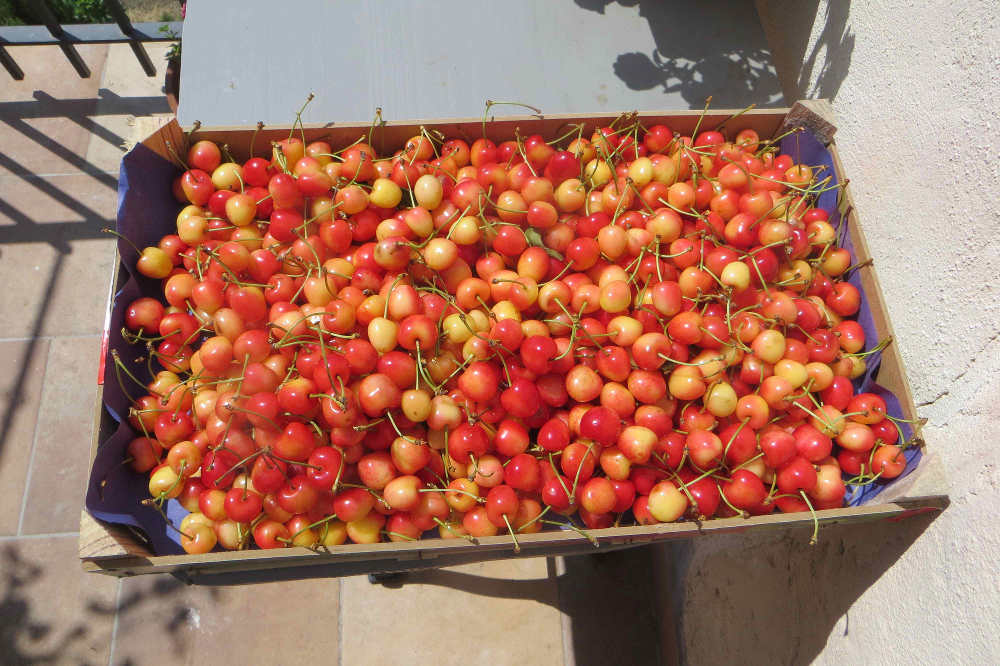
Euro-Toques chef Martin Dwyer, is much missed in Ireland since he and his wife Sile sold their eponymous restaurant in Waterford and moved to France. They now live in the Languedoc, where they take guests - and feed them very well.
This month: White Cherry Jam
It must have been in 2007, shortly after we bought the house, when we were exploring about the lovely villages in the Haut Languedoc that we saw a man who had set up a stall outside his farm gate and seemed to be selling cherries.
It would have been around the beginning of June when most of the cherry harvest is over in this part of the world. These, we immediately noticed were not the usual red cherries but were yellow with pink stripes.
Monsieur invited us to sample one and they were really good, not the usual balls of sugar and juice but had rather more flavour and were not as sweet as the red ones. When asked how much they were M. said they were €2.50 a kilo, but if we liked we could have the whole box (about three kilos) for €5.
We took the box and M. retired indoors, delighted, his selling day over.
If you run a Chambre d’Hote in France you soon realise that the French vision of breakfast is Coffee, with fresh baguette and lots of jam. Jam was no sooner made in our kitchen but it was consumed by the jarful by our clients.
We decided to turn the three kilos of cherries into jam. It made a delicious end product, the extra acidity giving the jam more flavour than the red variety. A little bit of research on the internet revealed that our cherry was called a Cerise Napoleon- no doubt because it had been great favourite with the Emperor.
The following year we went searching again for the Napoleons but this time we couldn’t find any. Despite crawling along the roads where we thought we had found them being sold we never succeeded in finding Monsieur at his gate.
I made a few enquiries at the local markets but it seemed that nobody grew these old fashioned cherries any more. The market seemed to be for the red variety which, though delicious when they arrived first in May, were just not as good for jam.
Then just two years ago we were driving through Tarrassac where a high suspension bridge crosses the Orb when, in the old village on the side of the bridge we found a lady, outside the door of an old long defunct Boucherie, selling cherries. On closer inspection it turned out that she had the elusive Napoleons, about two kilos, needless to say we bought the lot.
Last year we missed them, the season was over when we went looking so this year I was determined this wouldn’t happen. Passing through Tarrassac about three weeks ago we saw Madame at her door selling her red cherries. I asked her about her yellow ones. She firstly corrected us, they were not yellow but white - she explained - “That’s right” I said “Napoleons”. She was impressed. Then she explained that the white were a later fruiting variety and wouldn’t be ready for a few weeks yet.
I told Madame that I had a Chambre d’Hote and had found that her cherries made delicious jam, if I gave her my card would she promise to call me when they were ready. She duly promised.
Last Thursday Madame called and said the cherries were ripe; I asked her to put aside four kilos for me and promised to collect them the following day. This is why yesterday found me travelling up the side of the Orb River along the corniche of Le Vallee d’Orb on my way to collect the cherries.
The village of Tarrassac is only about 34 km from our village but as the road twists and winds over the Garrigue and along the side of the river it takes about three quarters of an hour to get there.
Once you pass through Murviel the road climbs up to the Garrigue at Causses et Veyran, wonderful moorland landscape with only the odd vineyard flourishing on the thin soil. Once you get to Roquebrun the vegetation changes and you are firmly back in wine country. Because this village is totally protected from the north it is called Le Petit Nice and wonderful lemon and orange trees, full of fruit in February and at the same time amazing displays of Mimosa.
Roquebrun is part of the St. Chinian appellation and (in my opinion) they produce the finest wine of that region. The vineyards here are on the side of the south facing hills where no mechanical grape picker can venture and so they are all picked by hand. The wine from the co-op in the village is our house wine in Le Presbytere.
At Tarrassac I knocked on the door of the Ancienne Boucherie and a very old Granny gave me my large box of cherries and charged me ten euro for the fruit.
This morning I had the task of stoning these beauties. A couple of years ago I found an old cherry stoner in a Vide Grenier, a simple device a bit like an old fashioned garlic squeezer. This machine is not always easily used with the modern larger juicy cherries but is perfect for these smaller, old fashioned varieties.
At 8.30 this morning I set myself up on our sunny terrace, still reasonably cool until the sun comes around to heat it later, and armed with my trusty machine set about the task.
I must confess at this moment that if one is going to face a long repetitive task it is considerably easier to perform it on a south facing terrace in southern France where the birds alone offer entertainment.
Our resident Hoopoe has returned again this year and his gentle hooting call is very soothing, as are the calls of the dove population who seem to be intent on wooing each other. The Swifts and Martins are certainly not as soothing as they dive bomb the terrace, screaming as they go. It is however consoling that in their bombing raids they are swallowing flies and mosquitoes.
It took me an hour and a half to stone the cherries, and another ten minutes to clean up the copious amounts of cherry juice from the terrace.
It seems that actually making the jam is going to be the easiest part of this operation.
-------------
 Martin Dwyer started cooking professionally over 40 years ago in the legendary “Snaffles Restaurant” in Dublin. After a time in a Relais Chateau in Anjou and in “The Wife of Bath” in Kent he opened his own much acclaimed restaurant, “Dwyers”, in Waterford in 1989. In 2004 he sold this and moved south to France where he and his wife Síle bought and restored an old presbytery in a village in the Languedoc. They now run Le Presbytère as a French style Chambre d’Hôte. Martin however is far too passionate about food to give up cooking so they now enjoy serving dinner to their customers on the terrace of Le Presbytère on warm summer evenings. Martin runs occasional cookery courses in Le Presbytère and Síle’s brother Colm does week long Nature Strolls discovering the Flora and Fauna of the Languedoc.
Martin Dwyer started cooking professionally over 40 years ago in the legendary “Snaffles Restaurant” in Dublin. After a time in a Relais Chateau in Anjou and in “The Wife of Bath” in Kent he opened his own much acclaimed restaurant, “Dwyers”, in Waterford in 1989. In 2004 he sold this and moved south to France where he and his wife Síle bought and restored an old presbytery in a village in the Languedoc. They now run Le Presbytère as a French style Chambre d’Hôte. Martin however is far too passionate about food to give up cooking so they now enjoy serving dinner to their customers on the terrace of Le Presbytère on warm summer evenings. Martin runs occasional cookery courses in Le Presbytère and Síle’s brother Colm does week long Nature Strolls discovering the Flora and Fauna of the Languedoc.
Le Presbytère can be seen at: www.lepresbytere.net;
email: martin@lepresbytere.net
Twitter: www.twitter.com/DwyerThezan
An Irish Chef in France
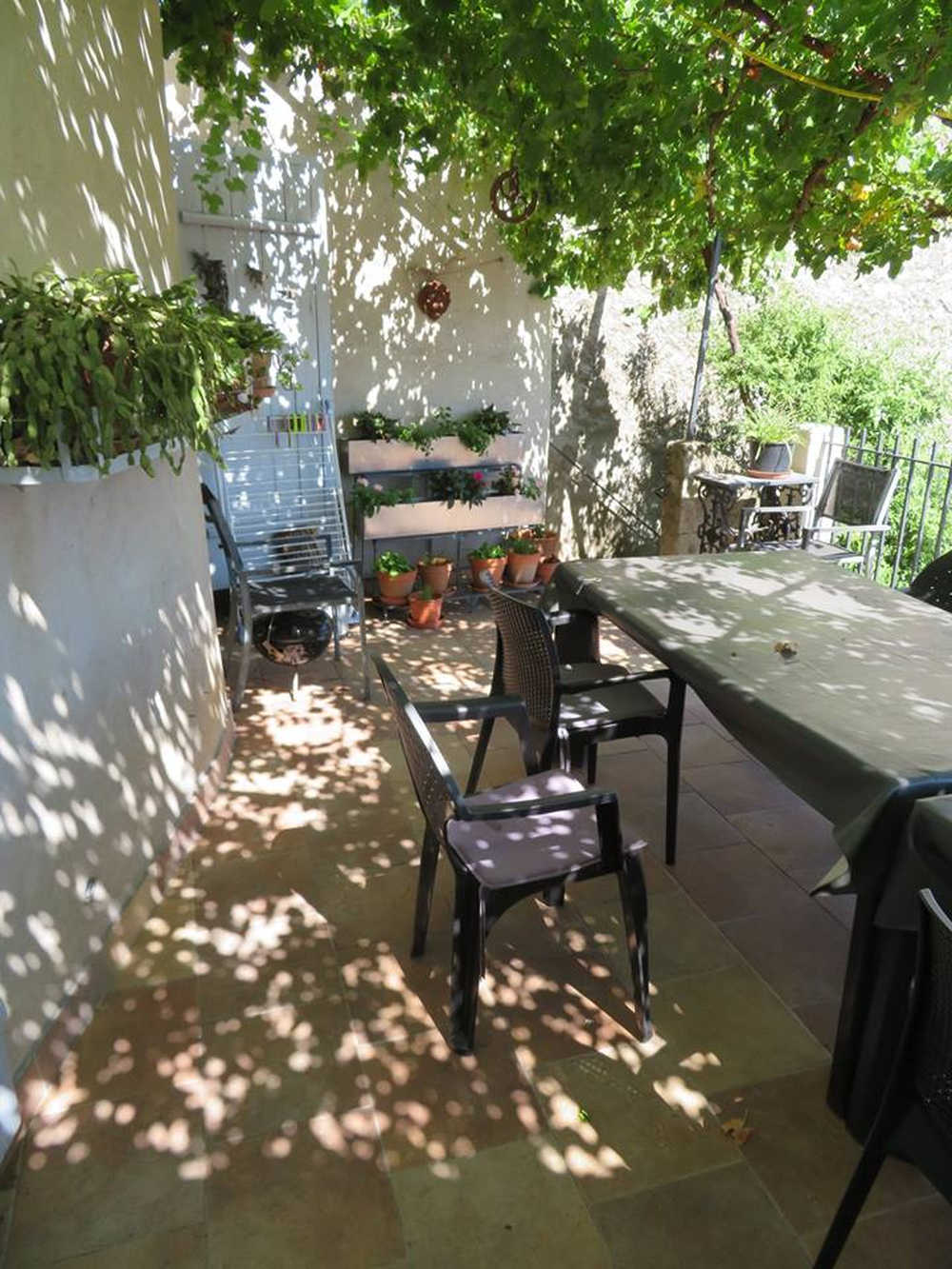
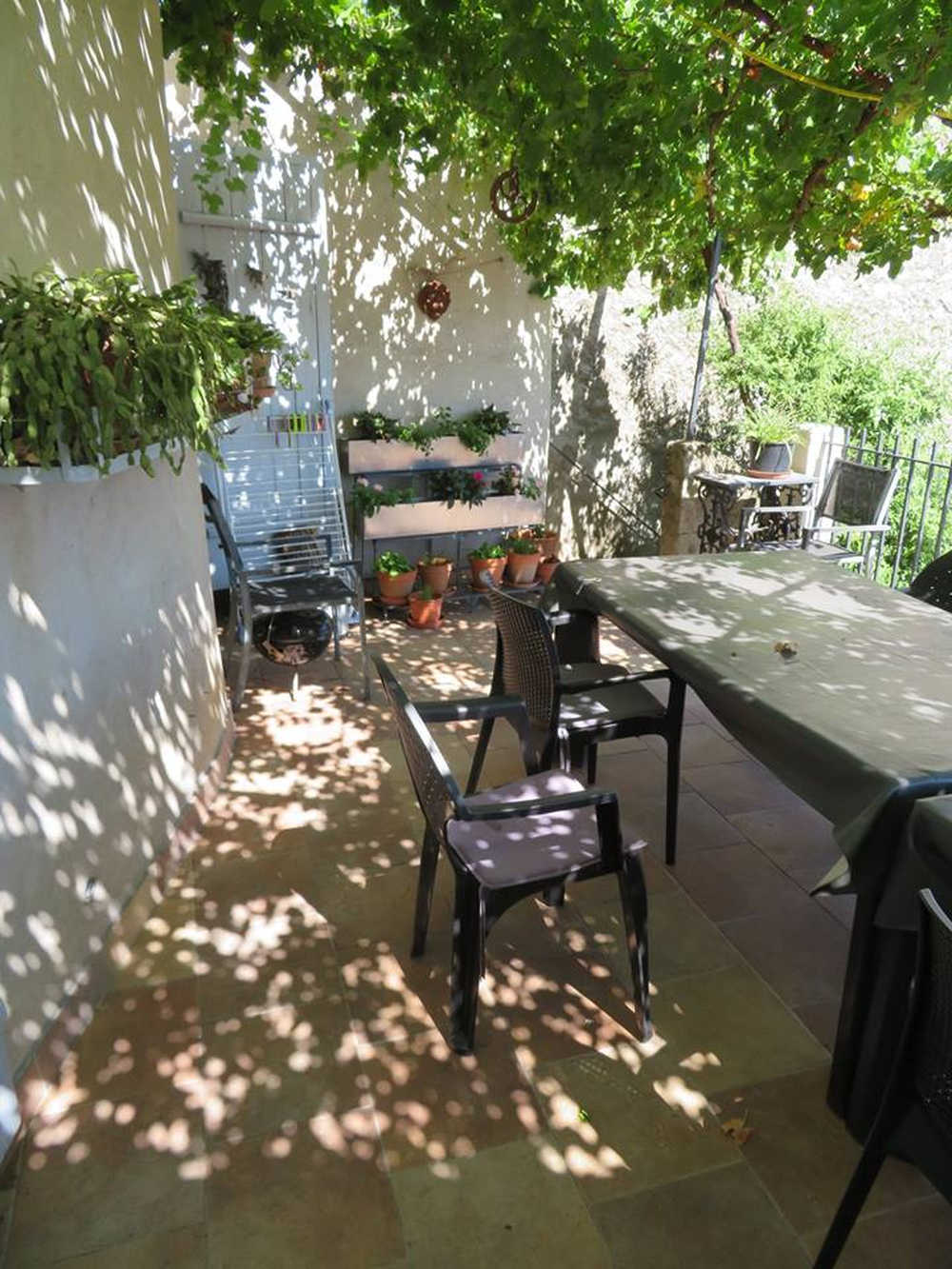
Euro-Toques chef Martin Dwyer, is much missed in Ireland since he and his wife Sile sold their eponymous restaurant in Waterford and moved to France. They now live in the Languedoc, where they take guests - and feed them very well.
This month: On Coping with the Weather
Every so often I get a chance for reflection on our life here in the Languedoc and this morning, sitting at 7.00 in a guestless house, coffee in hand, enjoying the cool of the morning before the heat of the day descends, is a perfect one for such thoughts.
We recently had a group of visitors who came to attend a wedding from about two hours north of here in the Tarn. They spent the time complaining about the heat. They asked us, as nearly all visitors do, what persuaded us northerners to come so far south and were plainly incredulous when I explained that it was probably searching for sunshine which brought us down here.
Let me just give you a general picture of the weather here in our part of the Midi. Our winter is a short one, lasting from sometime in January to late in March. At this time it is cold in the mornings and the evenings and we are glad of the stout wood burning stove in our living room.
The temperature rarely slips below freezing point and quite often the sun will warm us up to entice us to sit on the terrace in the afternoons. Certainly the longest season here is the Spring/ Autumn. This covers roughly 7 months of the year, from April to June in the rising of the year and September to December in the fall.
These times are without doubt, the best times to live in the South of France. Sometime in April I discard socks, vests and jackets and put on my summer wardrobe of sandals, shorts and short sleeved shirts which I will wear until I get respectable again around Christmas.
It is also very likely that the rain will happen during this time and even though we don't have a huge rainfall we do have sufficient to keep our vines producing excellent wine. The rain also has a certain tact and often happens with great intensity in the form of a storm which produces the same amount of irrigation in a few hours as does a week of "soft Irish rain". (Also, an added bonus, it rains more frequently in the night than the day.)
However I still have to talk about the months of July and August, these are the hot ones, temperatures hanging about in the thirties in the middle of the day. The mornings and the evenings are usually cooler and the dining room moves to the terrace for breakfast and dinner. This mid-day heat, mind you, is usually a dry heat and not the heavy humidity which happens west of us where the air is saturated with moisture from the Atlantic.
How do we survive these times ? Well we take a lesson from Noel Coward and become like the natives, we close the shutters against the heat of the day, put our fans into action, and proceed to do as little as possible.
Last week our guests from the Tarn arrived back at the house mid-wedding all hot, flushed and sweaty and complaining of the heat as they went upstairs and discarded their finery for shorts and t-shirts before returning to the festivities.
You see Mr. Coward it is not only Mad dogs and Englishmen - but also people from the Tarn - who Go out in the mid-day sun .
-------------
 Martin Dwyer started cooking professionally over 40 years ago in the legendary “Snaffles Restaurant” in Dublin. After a time in a Relais Chateau in Anjou and in “The Wife of Bath” in Kent he opened his own much acclaimed restaurant, “Dwyers”, in Waterford in 1989. In 2004 he sold this and moved south to France where he and his wife Síle bought and restored an old presbytery in a village in the Languedoc. They now run Le Presbytère as a French style Chambre d’Hôte. Martin however is far too passionate about food to give up cooking so they now enjoy serving dinner to their customers on the terrace of Le Presbytère on warm summer evenings. Martin runs occasional cookery courses in Le Presbytère and Síle’s brother Colm does week long Nature Strolls discovering the Flora and Fauna of the Languedoc.
Martin Dwyer started cooking professionally over 40 years ago in the legendary “Snaffles Restaurant” in Dublin. After a time in a Relais Chateau in Anjou and in “The Wife of Bath” in Kent he opened his own much acclaimed restaurant, “Dwyers”, in Waterford in 1989. In 2004 he sold this and moved south to France where he and his wife Síle bought and restored an old presbytery in a village in the Languedoc. They now run Le Presbytère as a French style Chambre d’Hôte. Martin however is far too passionate about food to give up cooking so they now enjoy serving dinner to their customers on the terrace of Le Presbytère on warm summer evenings. Martin runs occasional cookery courses in Le Presbytère and Síle’s brother Colm does week long Nature Strolls discovering the Flora and Fauna of the Languedoc.
Le Presbytère can be seen at: www.lepresbytere.net;
email: martin@lepresbytere.net
Twitter: www.twitter.com/DwyerThezan
An Irish Chef in France - Wholewheat Chestnut Bread
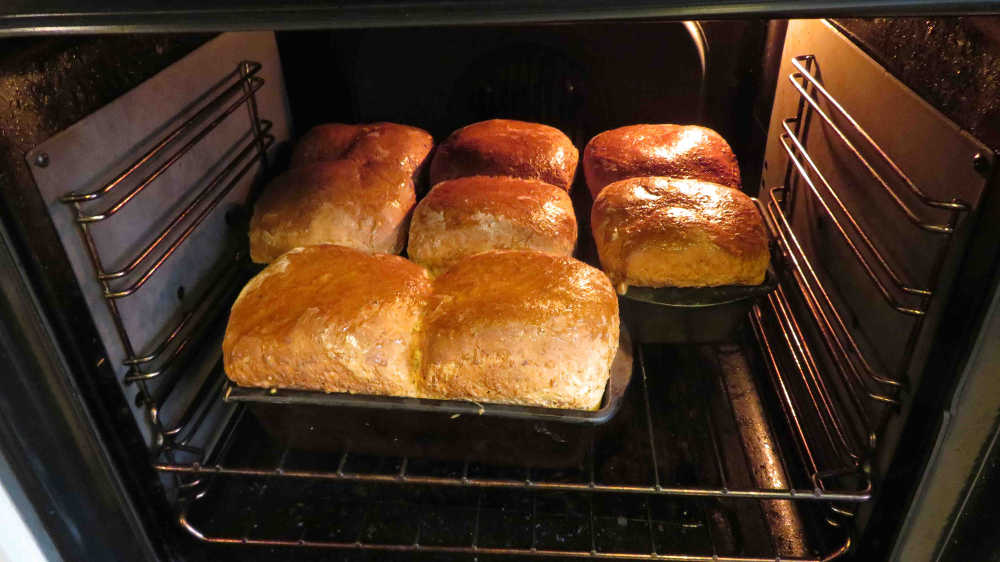
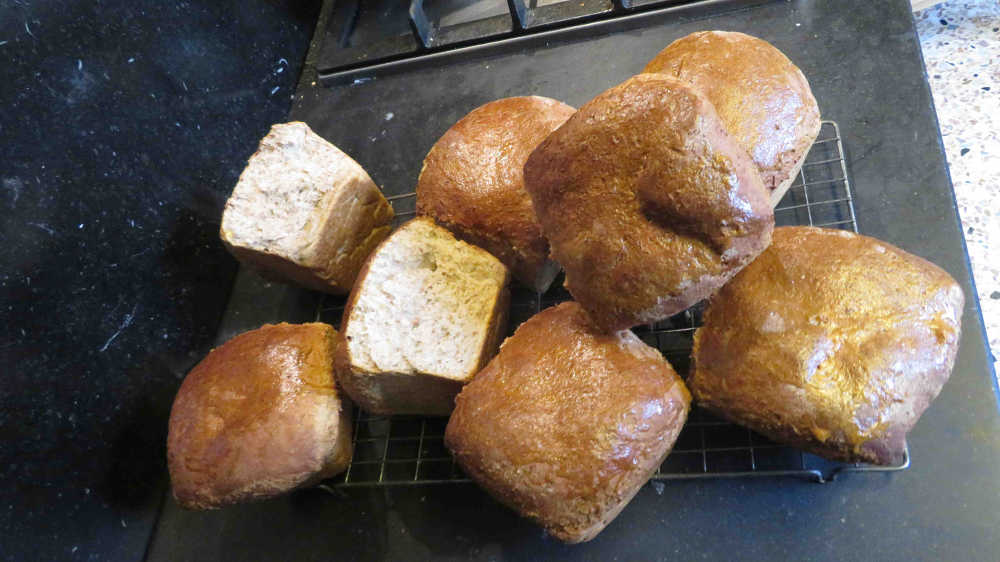
Euro-Toques chef Martin Dwyer, is much missed in Ireland since he and his wife Sile sold their eponymous restaurant in Waterford and moved to France. They now live in the Languedoc, where they take guests - and feed them very well.
This month: Wholewheat Chestnut Bread.
This is really a marriage between Languedoc and Ireland.
Since we moved to France from Ireland to open our Chambre d’Hote here in the Languedoc we have been very aware that, in our own small way, we are flying a flag for Ireland, not just for Ireland but in particular for Irish food.
For all the years when I ran my restaurant in Waterford one of the most common questions I was asked was “What sort of food do you cook?” and my answer, was usually “French, but with Irish ingredients and a certain Irish twist”
That, of course is not a possible answer here in France as, being a supporter of all things local, I have no intentions of importing my ingredients from Ireland - well possibly with one or two tiny exceptions.
The part of Languedoc where live is locally known as La Vallee d’Orb and did, so local history books tell me, grow wheat during the 1800’s but not for the last couple of hundred years when all available land is used for the cultivation of vines.
Consequently all the wheat used by the bakers here has been imported from the wheat belt which stretches across the middle of France, the Charente and the Vendée. But of course the peasants in the northern half of the Languedoc, the area which stretches into the great plateau in the centre of France, Le Massif Central, were not going to deprive themselves of France’s staple so they made their flour from the Chestnut which grows in the woods and forests on the slopes of the Haut Languedoc.
The first time I saw evidence of this was seeing some extraordinary shoes in a museum in Olargues, a village quite near our house here. These had long savage looking spikes attached to the soles and at first glance seemed instruments of medieval torture. They were, it turned out, Chestnut shelling shoes. The peasants scattered the fruits of the tree on the ground and stamped on them with these boots to remove the shells - a true sign of how far the French peasant is prepared to go to secure his daily bread.
I was however delighted to discover that if I was to try and emulate these bread makers I wouldn’t have to go to the same lengths and that, with quite a lot of searching, chestnut flour was still available to buy, ready shelled, peeled and ground, in the Languedoc.
I am now going to digress, a little, back to my original point about exploring my Irish traditions here in France.
I am going to speak some words of heresy and alienate all of my French friends by confessing something: The world famous French Baguette, the crisp white loaf which is the symbol of France, the sine qua non of French Breakfasts, begins to pall after a while and this particular Irishman began to long for some bread which he could chew, something with a bit of texture, some whole wheat Irish bread.
The French effort at whole wheat flour is not at all to our robust Irish tastes. I actually talked to a French miller about this and he explained that yes the French always sieve their coarse bran and chaff from their flour and discard it. “This” Monsieur Le Meunier explained to me “cannot be digested by the human body, only by animals” - and no amount of talk of roughage would change his mind.
So I started to import some Irish whole wheat flour. Import is of course a very grand word for getting a friend, from time to time, to bring me over a bag in their luggage.
I started making soda bread but honestly, whether it was the quality of the buttermilk or the climate, it just never worked well here.
At about the same time I started experimenting with chestnut flour and was having a similar lack of success. The chestnuts are not high in gluten so the bread was ending up wet and flat.
I spoke one day, in a market, to a German who was selling chestnut flour and he agreed that an all chestnut bread wasn’t to our modern tastes “You should use about 20% chestnut to strong flour” he suggested “that gives a very good texture.”
So I did, but the results still didn’t satisfy me.
Then I had my eureka moment and tried a bread combining Strong French Flour, Irish Wholewheat and Languedoc Chestnut flour.
Success at last. This is the one I now bake all the time and here is the recipe.
I usually divide the dough into eight (a scales is best to use for this) and put two pieces into each tin – these pull apart easily after cooking as this gives me eight small loaves which freeze well and are a perfect size for breakfast.
You will need 4 x Ikg loaf tins which you oil liberally with olive oil.
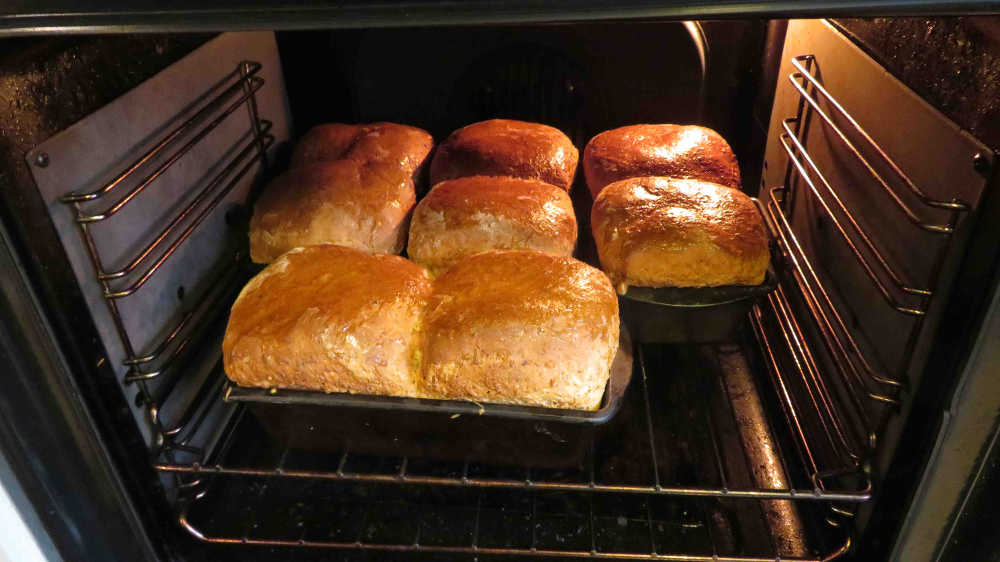
Wholewheat Chestnut Bread.
500g Wholewheat flour 1300g Strong White Flour 200g Chestnut flour Teaspoon Salt 100g Fresh Yeast 150ms Olive Oil
1.25 ltrs Warm Water
Dissolve the yeast in some of the warm water and mix the flours with the salt.
Mix the oil with the warm water and yeast mixture and add to the flours and make into a dough in the bowl.
Turn onto a floured board and knead for 5 minutes.
Cut into eight pieces and fit two in each 1kg tin.
Leave to rise for at least an hour.
Bake in a hot oven, preheated to 420ºC, for thirty minutes
(If you want them to have a glaze just paint with some egg wash after 15 minutes in the oven)
After 30 minutes shake out of the tin and bake at 400ºC for a further 15 minutes,
Remove from the oven and cool on a rack.
-------------
 Martin Dwyer started cooking professionally over 40 years ago in the legendary “Snaffles Restaurant” in Dublin. After a time in a Relais Chateau in Anjou and in “The Wife of Bath” in Kent he opened his own much acclaimed restaurant, “Dwyers”, in Waterford in 1989. In 2004 he sold this and moved south to France where he and his wife Síle bought and restored an old presbytery in a village in the Languedoc. They now run Le Presbytère as a French style Chambre d’Hôte. Martin however is far too passionate about food to give up cooking so they now enjoy serving dinner to their customers on the terrace of Le Presbytère on warm summer evenings. Martin runs occasional cookery courses in Le Presbytère and Síle’s brother Colm does week long Nature Strolls discovering the Flora and Fauna of the Languedoc.
Martin Dwyer started cooking professionally over 40 years ago in the legendary “Snaffles Restaurant” in Dublin. After a time in a Relais Chateau in Anjou and in “The Wife of Bath” in Kent he opened his own much acclaimed restaurant, “Dwyers”, in Waterford in 1989. In 2004 he sold this and moved south to France where he and his wife Síle bought and restored an old presbytery in a village in the Languedoc. They now run Le Presbytère as a French style Chambre d’Hôte. Martin however is far too passionate about food to give up cooking so they now enjoy serving dinner to their customers on the terrace of Le Presbytère on warm summer evenings. Martin runs occasional cookery courses in Le Presbytère and Síle’s brother Colm does week long Nature Strolls discovering the Flora and Fauna of the Languedoc.
Le Presbytère can be seen at: www.lepresbytere.net;
email: martin@lepresbytere.net
Twitter: www.twitter.com/DwyerThezan
An Irish Chef in France - A Cork Childhood Christmas
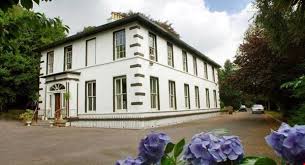
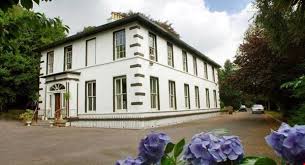
Euro-Toques chef Martin Dwyer, is much missed in Ireland since he and his wife Sile sold their eponymous restaurant in Waterford and moved to France. They now live in the Languedoc, where they take guests - and feed them very well.
This month: A Cork Childhood Christmas
We always went to Lotaville for lunch on Christmas day. Lotaville was my father’s family home, a stately Victorian Villa in Glanmire, overlooking the river Lee about 3 miles outside Cork city.
It was what they call a “Gentleman’s Residence”, in about two or three acres of gardens, including a disused tennis court and large greenhouses where we were allowed to pick the delicious black grapes in September.
The house itself was quite large but without a lot of bedrooms, probably about four or five, but these were huge. It also had a tower built in on one side, a piece of Victorian-Gothic whimsy which could only be scaled inside by a series of ladders, and which the boys were allowed climb after lunch on Christmas day.
The inhabitants of the house were an odd lot to my young eyes. The head of the house (we would always have described a trip there as going to Granny Dwyers) was my Granny.
She was small and round and, as far as I was concerned, permanently cross.
My elder sister remembers someone quite different, someone warm who spoiled her, but, by the time I got to know her life had squeezed most of the joy from her, and, as the seventh child, the best emotion I could expect from her was tolerance.
My grandfather we called Dubs, he and Granny lived totally different lives within this house. As well as having his own bedroom, Dubs had his own drawing room, a large brown masculine room with large windows overlooking the river.
This he shared with various small dogs, of which he was very fond. He was also fond of his grandchildren and I remember always feeling welcome when I entered his room.
Granny’s Drawing Room was at the end of the corridor but also looked over the river. In contrast with Dubs room it was feminine and chintzy with carpet and curtains in pale greens and pinks.
Granny shared this room with another member of the household; Auntie Kat.
Auntie Kat was a classic maiden Aunt, my Granny’s unmarried sister and she was shared between Granny’s household and that of her younger sister at a farm in Mitchelstown. It was always obvious to me, from the way she used to talk about the farm and the family there, that that was her favoured billet. Auntie Kat smoked “like a chimney”, she always had a Woodbine in the corner of her mouth and her cloud of white hair had permanent brown nicotine stain in that place where the smoke ascended.
The other member of the household, and to me much the most interesting, was Lena. Lena was the cook and her kingdom was in the large, dark basement kitchen. Lena was an old retainer and as I remember her quite lame, she got about with some difficulty using a stick. This did not stop her doing all the cooking and ruling over the girls who had been brought in for serving on Christmas day with an iron hand.
She was a kindly lady though and would tolerate us children “under her feet” for short periods. These visits to the kitchen would have to be organised with some skill as it was strictly forbidden to go “annoying Lena” before lunch on Christmas day.
Despite all embargos I can still remember being put by her up on a chair in the kitchen to better see her making the bread sauce for the turkey. I still have a memory of the delicious smell of the milk infusing with an onion studded with cloves, as Lena grated stale bread with which to thicken the sauce.
The lunch itself was not my favourite part of the day. For all Lena’s kindness the food was much better at home. Classic Christmas fare was served, soup, followed by turkey and ham with Lena’s bread sauce and then Christmas Pudding with Brandy Butter.
The younger children were put at a small side table and, under orders to behave well, fed apart from the adults. I can remember a certain amount of jollity at the large table, and the surprise I felt when granny allowed a paper hat from a cracker to be put on her head.
I presume that Dubs would also have broken out of his part of the house and joined us for lunch, even though I have no memory of him being there.
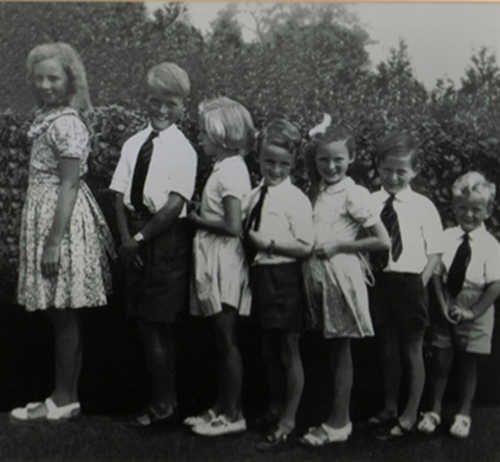
I would hate anyone to think that Christmas day was not a happy day for me. It was in fact a day full of magic, the lunch in Granny’s being just a formal and perfectly acceptable hiatus in the middle of a joyous day.
Santa Claus, and his stocking were a great source of joy when my eyes first opened on Christmas morning. I would have lain for hours in the bed, too excited to sleep and knowing that “He” wouldn’t come until I did.
The morning stocking was always filled with cheap toys and sweets and always had a silver wrapped tangerine at the toe. Unlike other households Santa didn’t provide the main Christmas presents for us. This was reserved for the “Christmas Tree”
“The Tree” as we called this time was, without doubt the highlight of Christmas day. After morning mass, for those who were reckoned too young to be allowed up for midnight mass, we had breakfast in the breakfast room which was next to the billiard room.
The billiard room was the biggest room in the house, large enough for a billiard table but as yet not holding one. There was no decorating done to this room until after the younger children had gone to bed on Christmas eve.
Then it was transformed. The tree was put in the middle of the room, decorated with lights and the shiny glass balls which rested for the rest of the year in the attic in boxes. But it was what was under the tree was what made the magic of this moment. Here were piled all our presents. This was what “The Tree” was all about.
There was a large amount of ceremony attached. We all had to line up in age at the door to the billiard room. This was the one time of the year when the youngest took precedence. Then once we got into the room itself we had to join hands and dance around the tree singing “Here we go round the mulberry bush” This does sound just a little twee today but I promise you that in the fifties there was no embarrassment whatsoever.
Again tradition dictated that you were not allowed pick or open one of your own presents. Anything with “To Martin” on it, no matter how tempting had to be passed by and one picked out one for George or Valerie.
Eventually you ended up with a sizeable pile of presents in the corner and then there was the excitement of unwrapping and glorying in your new found wealth. I never remember being disappointed. Then it was off to Granny’s for lunch.
When we came back from Granny’s we would find the Billiard room again completely transformed, this time for Christmas Dinner. The tree would be re-erected in the bow window in the corner and the floor covered with trestle tables covered with white linen.
To my childish eyes it seemed that these tables were set for hundreds of people but I now suppose that it couldn’t have been more than forty or so. These would have been members of my mother’s large family, and my mother and father’s equally large circle of friends. There would be various extra staff recruited for the night so, for us children, it was difficult to decide where the most fun was going on, in the billiard room or in the kitchen.
In direct contrast to the staid and old fashioned lunch the dinner was a bit of a bacchanalia. In addition to the turkey a roast ham would be served and my Mothers speciality - called Soufflé Surprise - was always served along with the Christmas Pudding; this dessert, which was really a version of Baked Alaska, was always recognised as the star turn of the evening.
I can remember that we were allowed smoke cigarettes on the night, yes us 8 to 10 year olds were allowed to puff away - this was long before cigarettes were recognised as bad for health.
I can also remember that much drink was consumed by my various uncles.
I have a distinct memory of someone’s paper hat being ignited and then the flames quenched by another uncle with a soda water siphon. In the meantime there would have also been much hilarity and drink consumed in the kitchen, I can remember a steady stream of uncles and aunts arriving in with bottles to make sure that the “staff” were able to celebrate as well.
Stephens’s day was “The Wran” and we would be allowed dress up in rags and sing outside our neighbours’ houses, passing others up to the same tricks on the way.
“The Wran the Wran
The king of all Birds
St Stephens day
Was caught in the furze
Up with the kettle
And down with the pot
Give us our answer and let us begone”
“Knock at the knocker ring at the bell,
Give us a copper for singing so well”
“God bless the mistress of this house
A golden chain around her neck
And be she sick or be she sore
The lord have mercy all the more”
And we would be given lots of coppers and this money, unlike the money we would have collected for carol singing the week before, was for ourselves and so, once we were finished we would divide the spoils and head off to Mr. Sullivan’s shop on the Lower Glanmire Road for a gorge of sweets.
As you can see it was easy enough to put up with lunch in Lotaville knowing what other treats Christmas had in store for us.
-------------
 Martin Dwyer started cooking professionally over 40 years ago in the legendary “Snaffles Restaurant” in Dublin. After a time in a Relais Chateau in Anjou and in “The Wife of Bath” in Kent he opened his own much acclaimed restaurant, “Dwyers”, in Waterford in 1989. In 2004 he sold this and moved south to France where he and his wife Síle bought and restored an old presbytery in a village in the Languedoc. They now run Le Presbytère as a French style Chambre d’Hôte. Martin however is far too passionate about food to give up cooking so they now enjoy serving dinner to their customers on the terrace of Le Presbytère on warm summer evenings. Martin runs occasional cookery courses in Le Presbytère and Síle’s brother Colm does week long Nature Strolls discovering the Flora and Fauna of the Languedoc.
Martin Dwyer started cooking professionally over 40 years ago in the legendary “Snaffles Restaurant” in Dublin. After a time in a Relais Chateau in Anjou and in “The Wife of Bath” in Kent he opened his own much acclaimed restaurant, “Dwyers”, in Waterford in 1989. In 2004 he sold this and moved south to France where he and his wife Síle bought and restored an old presbytery in a village in the Languedoc. They now run Le Presbytère as a French style Chambre d’Hôte. Martin however is far too passionate about food to give up cooking so they now enjoy serving dinner to their customers on the terrace of Le Presbytère on warm summer evenings. Martin runs occasional cookery courses in Le Presbytère and Síle’s brother Colm does week long Nature Strolls discovering the Flora and Fauna of the Languedoc.
Le Presbytère can be seen at: www.lepresbytere.net;
email: martin@lepresbytere.net
Twitter: www.twitter.com/DwyerThezan
An Irish Chef in France - The Wife of Bath
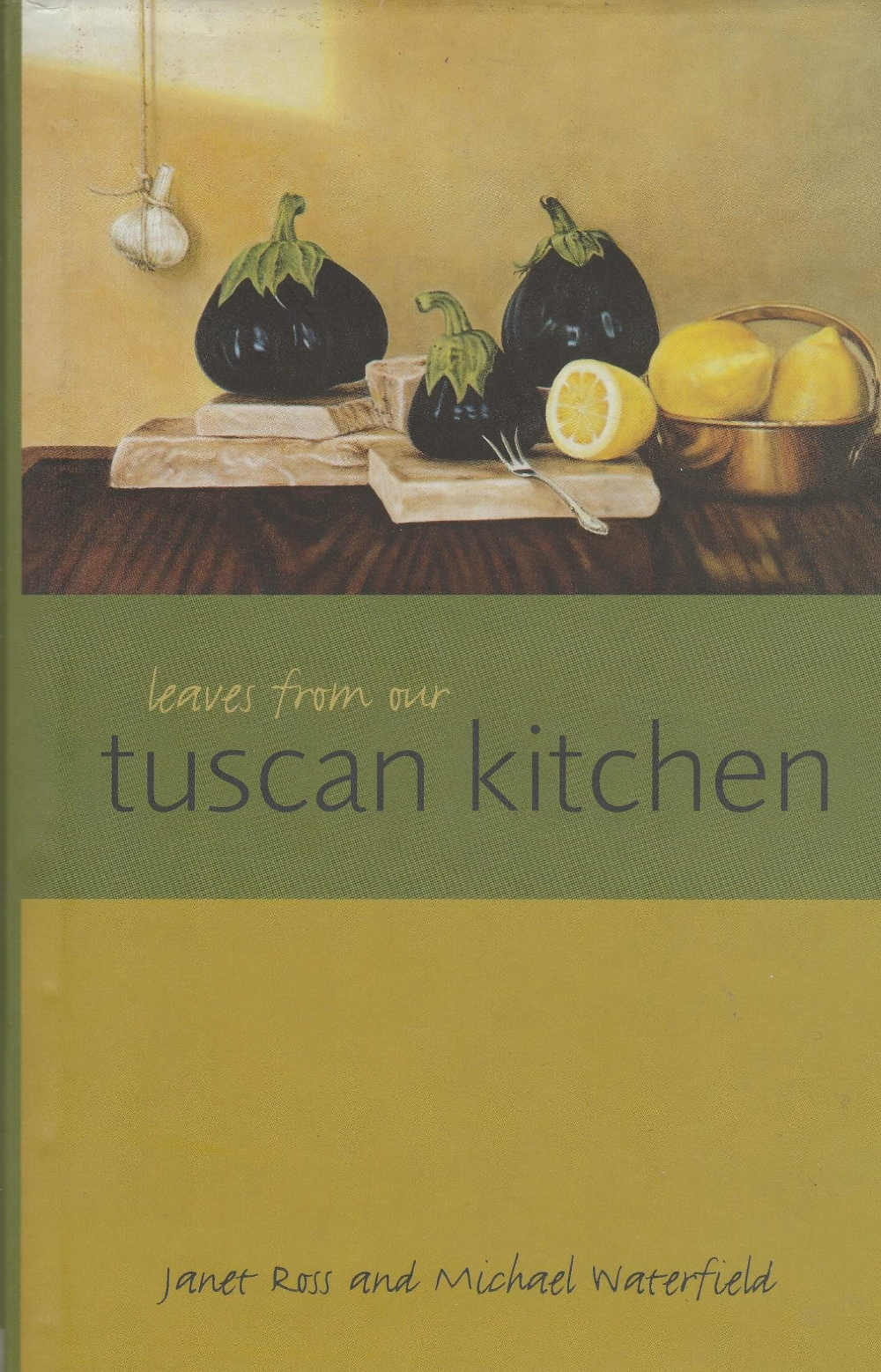
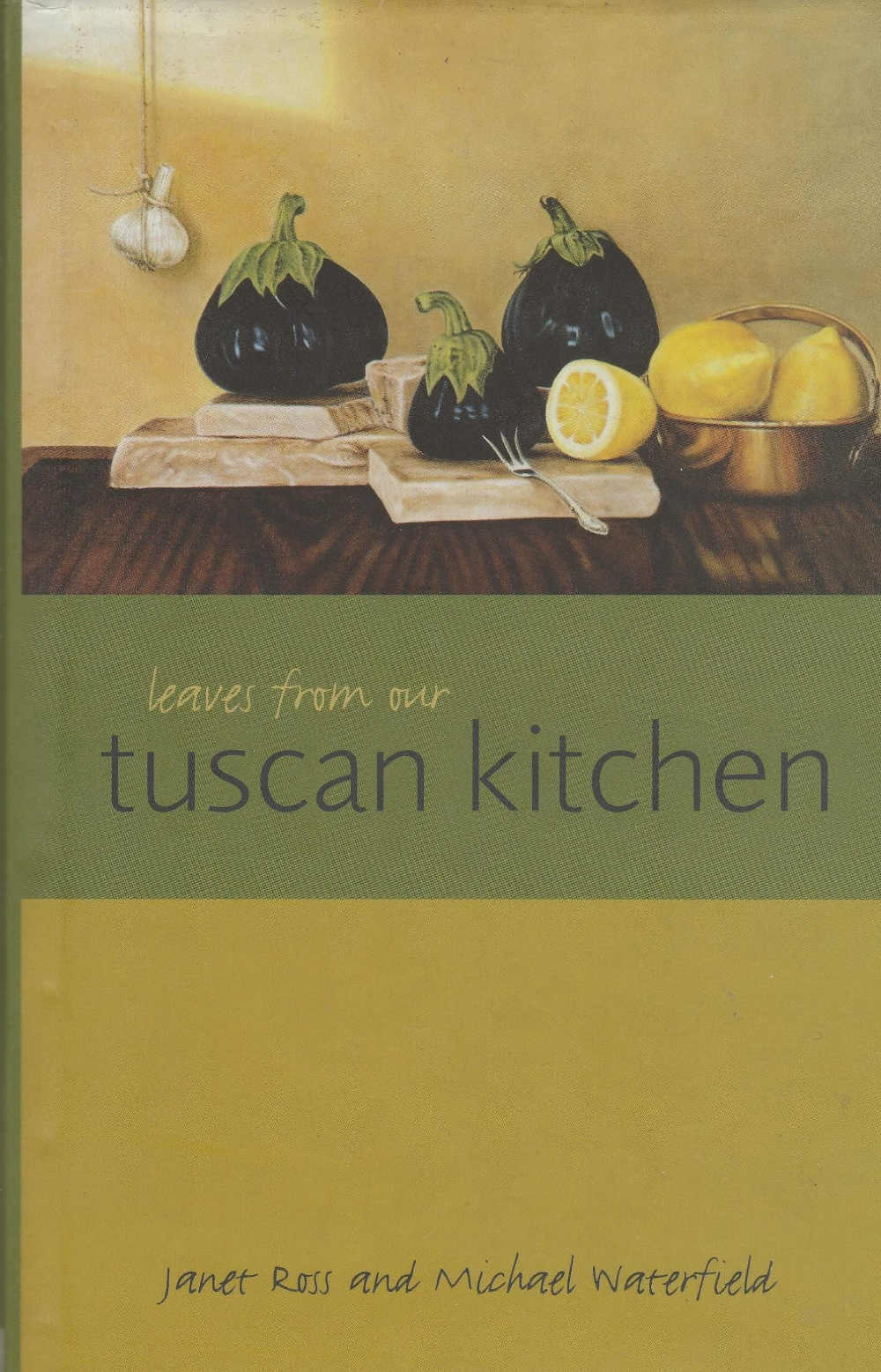
Euro-Toques chef Martin Dwyer, is much missed in Ireland since he and his wife Sile sold their eponymous restaurant in Waterford and moved to France. They now live in the Languedoc, where they take guests - and feed them very well.
This month: The Wife of Bath
The notion of gap years in a career was not totally invented by the present generation. After about two and a half years in our first jobs in Dublin, mine in Snaffles as a chef, Sile as a teacher in Basin Lane in the Liberties, we decided to throw all up and head for the world outside while we still had the liberty to do so.
We had a brief sojourn in France (and that’s another story) but ended up in England (which seemed quite as far away as Australia does today) in 1974, full of equal measures of fear and hope.
My restaurant guide bible at that time was the Good Food Guide. We went through it with a fine tooth comb and picked out about 30 restaurants or small hotels where we felt we might fit in and learn something. We wrote them an honest letter, indicating that we were keen but little else and then sat back and waited to see if we would get any replies. Incredibly we got about 28 encouraging letters.
Most of them were very polite refusals, about ten were job offers of various sorts. Our confidence, which was just about at bottom, soared. We picked out the two most tempting offers, one in Kent, one in The Lake District and made arrangements to be interviewed in both. The Wife of Bath in the tiny village of Wye in Kent was our first interview.
When we got there the door of the restaurant was answered by a scrawny lanky man in a very torn jumper who I assumed to be some sort of a gardener. Of course he turned out to be the proprietor, Michael Waterfield.
After talking to him for a few minutes I knew that I wanted to work here more than anywhere else. This man was, and still is, the most gentle, unassuming man I have ever met in a kitchen. As proprietor of a restaurant, which was at that time recognised as one of the top ten in England, he had none of the characteristics of a prima donna chef.
Michael ran his kitchen with kindness and understanding, he never raised his voice, didn’t know how to be sarcastic, and still produced marvellous food. He became, and still to this day is, my role model of how a kitchen should be run. He had a job for me in the kitchen and one for Sile working in the little bar taking the diners orders. We started the following week.
The Wife of Bath was named after the character in Chaucer’s Canterbury Tales (we were very close to the Pilgrims Way to Canterbury) and also because Michael’s wife Hilary came from Bath. As I said Michael was running one of the most renowned restaurants in England of the time. He had trained, like so many of his successful chef colleagues, under George Perry Smith in “The Hole in the Wall” in Bath.
Perry Smith is reckoned to be the man who translated the ideas of Elizabeth David into food for restaurants and was responsible for the huge raising of standards in catering in England, the reverberations of which can be felt in modern Britain’s culinary confidence and skill.
It was an exciting time to be in a kitchen in England, and Wye was a great village to live in.The village was just a short train journey from Canterbury and about 90 mts by train from London. We actually could (and did) go to the theatre or cinema there and get the last train home. The Kent coast was about 30 minutes away and Bob, the other chef, brought us to swim in Sandgate any hot afternoon when we were free.
The restaurant was also much visited by the local celebrities. Edward Heath, the then prime minister, ate often and as he ate in the private room at the back of the kitchen he had to pass by the pots and pans with his bodyguards to get there. He endeared himself to me by being obviously passionate about his food and found it hard to pass a pot of sauce or a bowl of dessert without begging for a taste.
But far more important than mere politicians we were hosts to cookery writers from time to time. Mary Berry, now enjoying a second renaissance on British TV, was often there and on one momentous day Elizabeth David had lunch on her way to catch the ferry in Dover.
Village life in England was a very new experience to us. For a long time we thought the villagers were cold and unfriendly. This was the time of the height of the IRA campaigns in England so we weren’t pushing ourselves forward anyway.
By coincidence, at that time someone in Ireland sent us a copy of Hibernia magazine. There was an article in this written by an Englishman who moved to the west of Ireland who couldn’t get over how friendly (intrusive?) the natives were. The explanation was quite simple. English people thought it impolite to ask newcomers about themselves, Irish people thought it impolite not to.
After 18 months in Wye our first daughter Caitriona was born and we were overwhelmed by the reaction of the villagers. They queued up at our door to bring presents, we bought absolutely nothing for the baby as everyone had hand me downs they were only too keen to give us. We had been accepted and now they were only too happy to be friendly.I doubt if we would have met with such kindness in a similar Irish village.
Thinking back on it all now I find it strange that I have no memory of ever being homesick while we lived in Wye. We made lots of friends there. Bob and his wife Janet were very kind to us and entertained us frequently and generously. We were much taken by the Waterfield family. Michael kindly agreed to be Caitriona’s godfather, and Olga Wills, an Irish ex-pat like ourselves,who did the wash-up, agreed to be her godmother.
However it was the excellent , honest and simple food that is my best memory of our time in The Wife of Bath. While we were there Michael was updating his great Aunt, Janet Ross’s Italian cook book, “Leaves from a Tuscan Kitchen” for Penguin Books.
This wonderful little book on cooking vegetables was quite a revolutionary volume in the early seventies. It is amazing to see how it captures the simplicity of Italian cooking a full 25 years before the great success of The River Café.
After two years we felt the time was right for us to come home so, in March 1977 we packed all our hand me downs together and sailed with Caitriona on the Inisfallen back to Cork. Our time abroad was only ever intended to be a few years, we knew that we wanted to bring up our children in Ireland but still we left Wye with real regret.
(Incidentially Leaves from a Tuscan Kitchen has been reprinted and re-issued by Grubb Street Press and no serious kitchen should be without it.)
-------------
 Martin Dwyer started cooking professionally over 40 years ago in the legendary “Snaffles Restaurant” in Dublin. After a time in a Relais Chateau in Anjou and in “The Wife of Bath” in Kent he opened his own much acclaimed restaurant, “Dwyers”, in Waterford in 1989. In 2004 he sold this and moved south to France where he and his wife Síle bought and restored an old presbytery in a village in the Languedoc. They now run Le Presbytère as a French style Chambre d’Hôte. Martin however is far too passionate about food to give up cooking so they now enjoy serving dinner to their customers on the terrace of Le Presbytère on warm summer evenings. Martin runs occasional cookery courses in Le Presbytère and Síle’s brother Colm does week long Nature Strolls discovering the Flora and Fauna of the Languedoc.
Martin Dwyer started cooking professionally over 40 years ago in the legendary “Snaffles Restaurant” in Dublin. After a time in a Relais Chateau in Anjou and in “The Wife of Bath” in Kent he opened his own much acclaimed restaurant, “Dwyers”, in Waterford in 1989. In 2004 he sold this and moved south to France where he and his wife Síle bought and restored an old presbytery in a village in the Languedoc. They now run Le Presbytère as a French style Chambre d’Hôte. Martin however is far too passionate about food to give up cooking so they now enjoy serving dinner to their customers on the terrace of Le Presbytère on warm summer evenings. Martin runs occasional cookery courses in Le Presbytère and Síle’s brother Colm does week long Nature Strolls discovering the Flora and Fauna of the Languedoc.
Le Presbytère can be seen at: www.lepresbytere.net;
email: martin@lepresbytere.net
Twitter: www.twitter.com/DwyerThezan
An Irish Chef in France
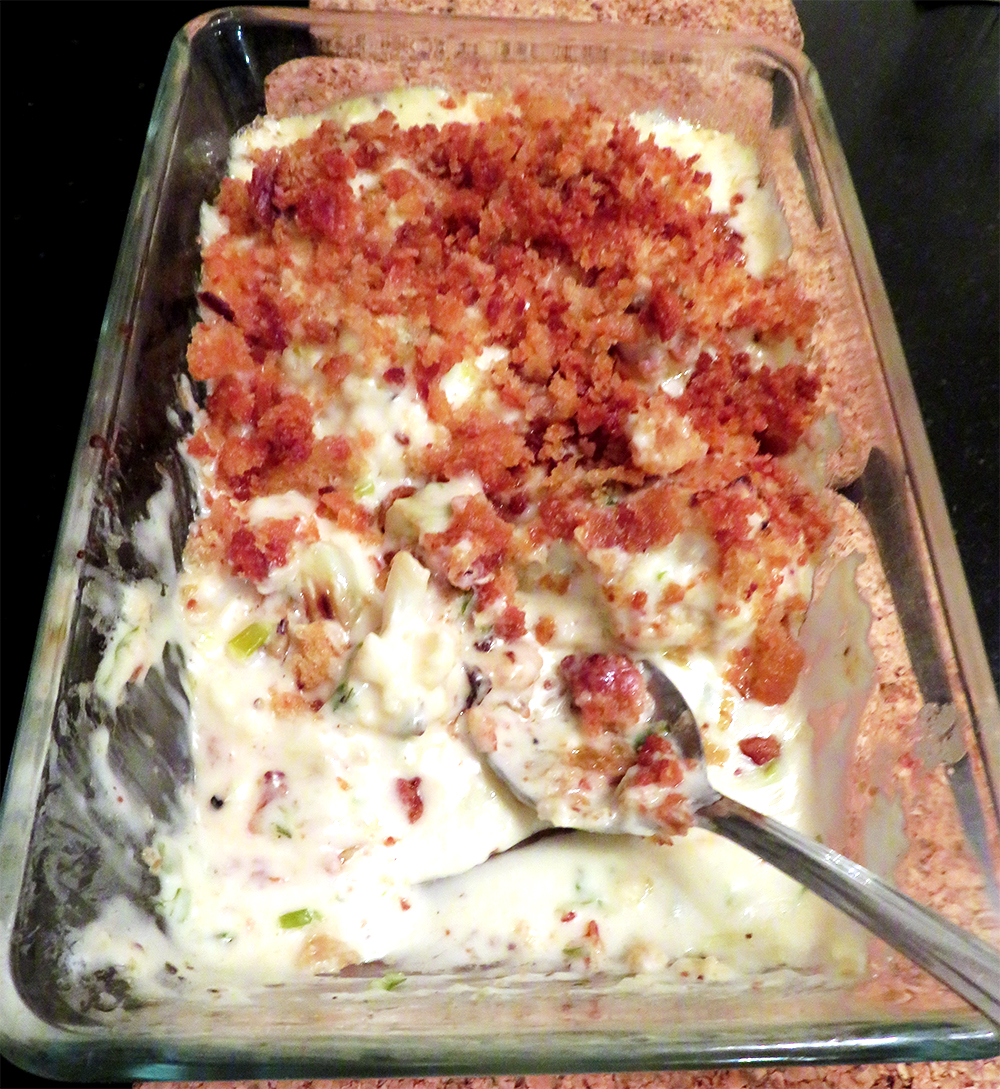
In Ireland, at the end of the last century, a vegetable accompaniment often produced at large functions was Cauliflower Cheese.
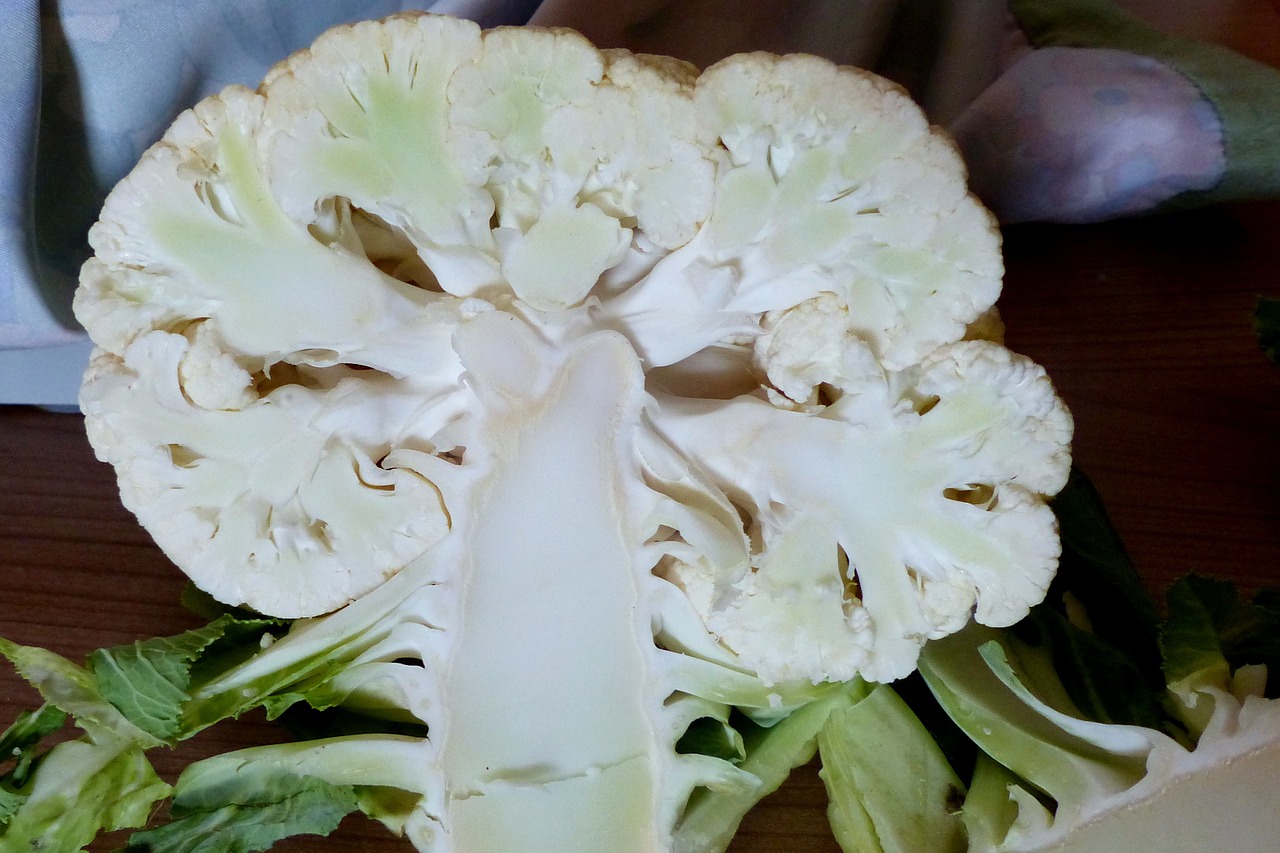 There were various reasons for this, Cauliflower is reasonably easy to grow in Ireland and therefore cheap. Because it rested in its own sauce it could be “put down” in a Bain Marie at an early hour with the idea that it would still be hot when served.
There were various reasons for this, Cauliflower is reasonably easy to grow in Ireland and therefore cheap. Because it rested in its own sauce it could be “put down” in a Bain Marie at an early hour with the idea that it would still be hot when served.
Unfortunately, by keeping this vegetable warm in this way it lost all its texture. I well remember a friend undergoing a meal with cauliflower in this condition and declaring that it was impossible to know where the cauliflower ended and the cheese sauce began.
At the moment Sile and I are alone in Le Presbytere, so I went shopping for a supper a little lighter than that we would serve to our guests.
This morning in the market there was a certain dearth of fresh vegetables. Over here in France a lot of the autumnal vegetables are over but the good winter substitutes are only just starting to come in.
There were, however, some delicious looking Cauliflowers, white, crisp and still dew covered so I decided to give them a go.
I could of course have roasted the florets with spices and garlic and olive oil, as I often do down here, but instead I decided to give the old Irish method a whirl and see if I could produce a French version of Cauliflower Cheese with local ingredients, which I could be proud of, which would be delicious, and crisp and zinging with flavour.
First change, I decided to roast the cauliflower instead of boiling it before I married it to the cheese sauce. I broke my cauliflower into florets tossed them in melted butter, seasoned it with salt and black pepper and put it into a hot oven for about twenty minutes, until they were just starting to get tender, while I got on with the rest.
Next step was to make a good crunchy topping - easily done. I chopped the remains of the morning’s baguette into slices and dropped it into the food processor until it was broken into coarse pieces - hardly breadcrumbs, more like bread shards. These shards I fried in butter until they turned golden brown and crisp.
The cheese sauce I made in much the same fashion as I would have in Ireland, with butter, flour and milk, but the cheese was a mixture of mature Comté and some very un-French Parmigiano.
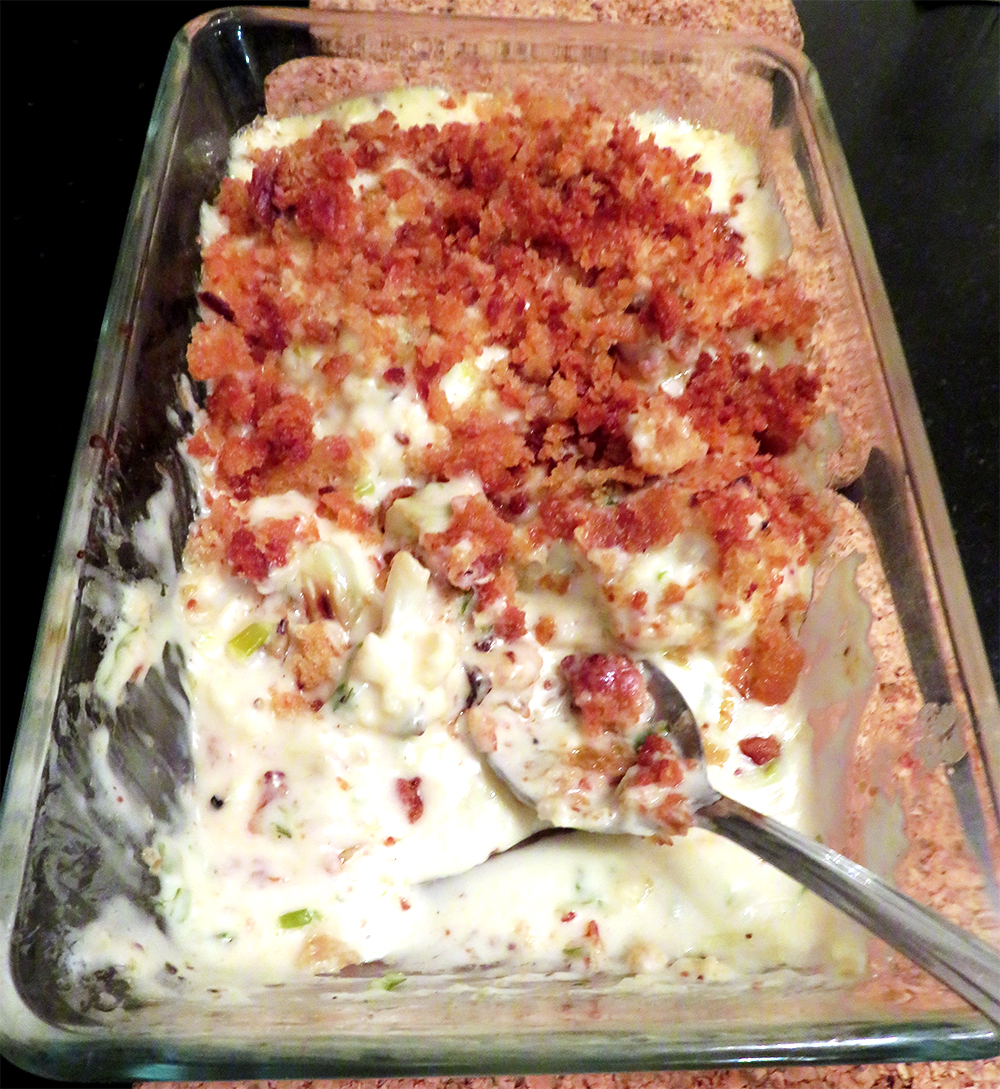 So now I had my whole dish to put together (and Nota Bene this was the star turn of the dinner- no playing second fiddle to beef or salmon). The roasted Cauliflower was covered with the cheese sauce and then topped with the crisp bread before it was put into a hot oven for about 30 minutes.
So now I had my whole dish to put together (and Nota Bene this was the star turn of the dinner- no playing second fiddle to beef or salmon). The roasted Cauliflower was covered with the cheese sauce and then topped with the crisp bread before it was put into a hot oven for about 30 minutes.
It was, I am delighted to report, delicious and would happily constitute a dinner all on its own (being however a typical Irishman I had to have some baked potatoes on the side)
The Cauliflower retained its bite, the cheese sauce was deeply cheesy and the bread topping provided just the right crunchy contrast. An excellent result.
Martin Dwyer started cooking professionally over 40 years ago in the legendary “Snaffles Restaurant” in Dublin. After a time in a Relais Chateau in Anjou and in “The Wife of Bath” in Kent he opened his own acclaimed restaurant, “Dwyers”, in Waterford in 1989. In 2004 he sold this and moved south to France where he and his wife Síle bought and restored an old presbytery in a village in the Languedoc. They now run Le Presbytère as a French style Chambre d’Hôte. Martin however is far too passionate about food to give up cooking so they now enjoy serving dinner to their customers on the terrace of Le Presbytère on warm summer evenings. Martin runs occasional cookery courses in Le Presbytère and Síle’s brother Colm does week long Nature Strolls discovering the Flora and Fauna of the Languedoc.
Le Presbytère can be seen at: www.lepresbytere.net;
email: martin@lepresbytere.net.
An Irish Chef in France
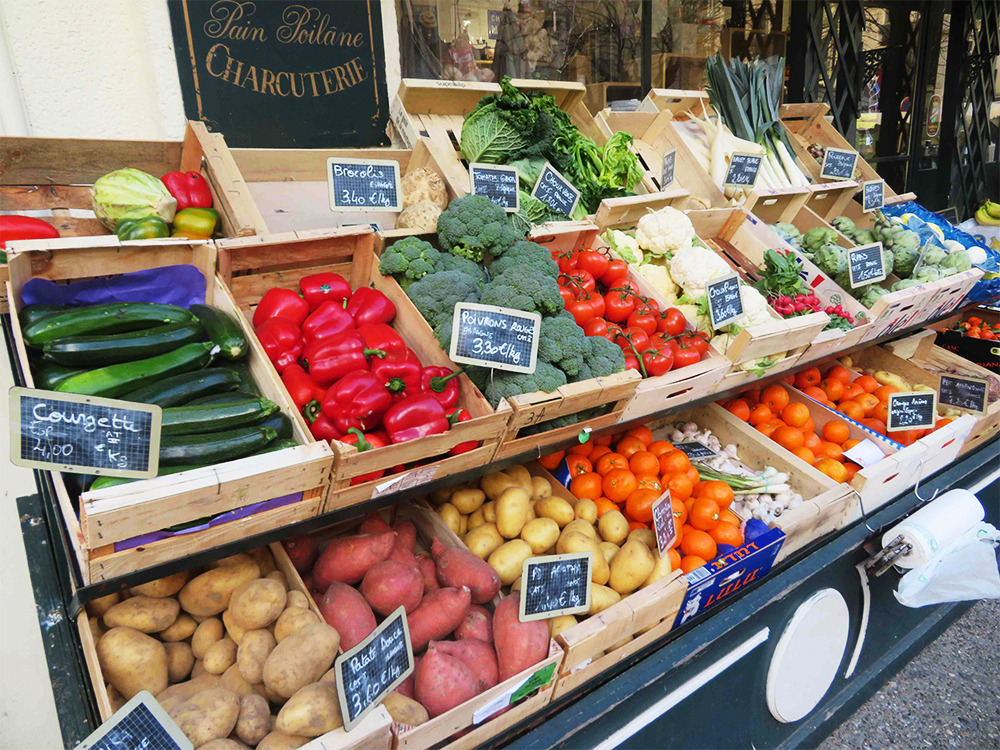
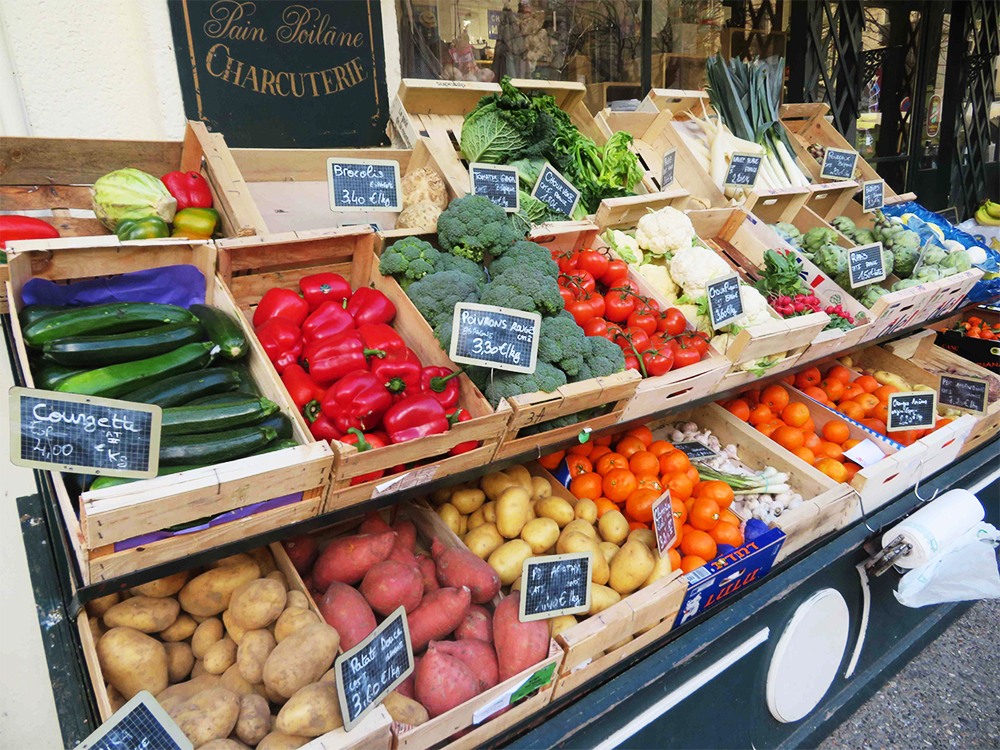 I have always been enamoured of a good French market. The French really use their markets for buying their groceries and the producer for selling their wares. One of our first family holidays in France was in the Dordogne where there was a superb market in Sarlat on, as I remember, a Saturday.
I have always been enamoured of a good French market. The French really use their markets for buying their groceries and the producer for selling their wares. One of our first family holidays in France was in the Dordogne where there was a superb market in Sarlat on, as I remember, a Saturday.
This was a big one with large fruit and vegetable sellers and also stalls selling meat and fish and what we used to call fancy goods.
My eye was caught by an old lady in black who was carrying a small trestle, a tray and a basket. While I watched her she unfolded her trestle at the church door, laid the tray on top, covered this with a white cloth from her basket and then laid out her wares. Some bouquets garni of herbs, a tray of fresh eggs, a small pyramid of apricots, another of red cherries and a half dozen pots of homemade jam. I roughly calculated her take at about a maximum of €20 in today’s money and wondered how long she would have to stand to earn it. It was consoling to find her gone when I passed the church again about thirty minutes later.
Of course the likely scenario is that she had regular customers who awaited her arrival and scooped up her offerings as soon as she set up her stall.
A lot of the serious buying at a French market is done by ladies of a certain age (my age now) who will be loading their produce into a wheeled basket or one carried more or less willingly by a husband or son.
You watch these ladies carefully; they will only buy the best quality. They will finger the carrots carefully in at least four stalls before they deign to purchase. Sometimes they are willing to offer the stallholder a selection of maybe two potatoes, two carrots and a large onion. The stallholder is perfectly happy to weigh and price these separately, and then neither surprised nor inconvenienced to accept payment by cheque.
These ladies who buy are not happy about this decimalization that has happened to their currency and still in our neck of the woods you will sometimes see the price in Francs in brackets after the price in Euro. Quite frequently the ladies-who-buy will just hand out their purses with a sigh with their purchases and let the seller help themselves.
Mind you the Euro has only been running for seventeen years now so it is understandable how people can be hanging in there thinking in francs. Much less comprehensible was the man in front of me at the poultry van who when asked by the young man what weight of chicken wings he needed replied “une livre” literally a pound. The young stallholder looked back at him in total miscomprehension, so the purchaser amends his request to “cinque cent grams”. Amazing to think that France went metric in their weights in the eighteen fifties but, being a deeply conservative people still haven’t let go of the pound weight quite yet.
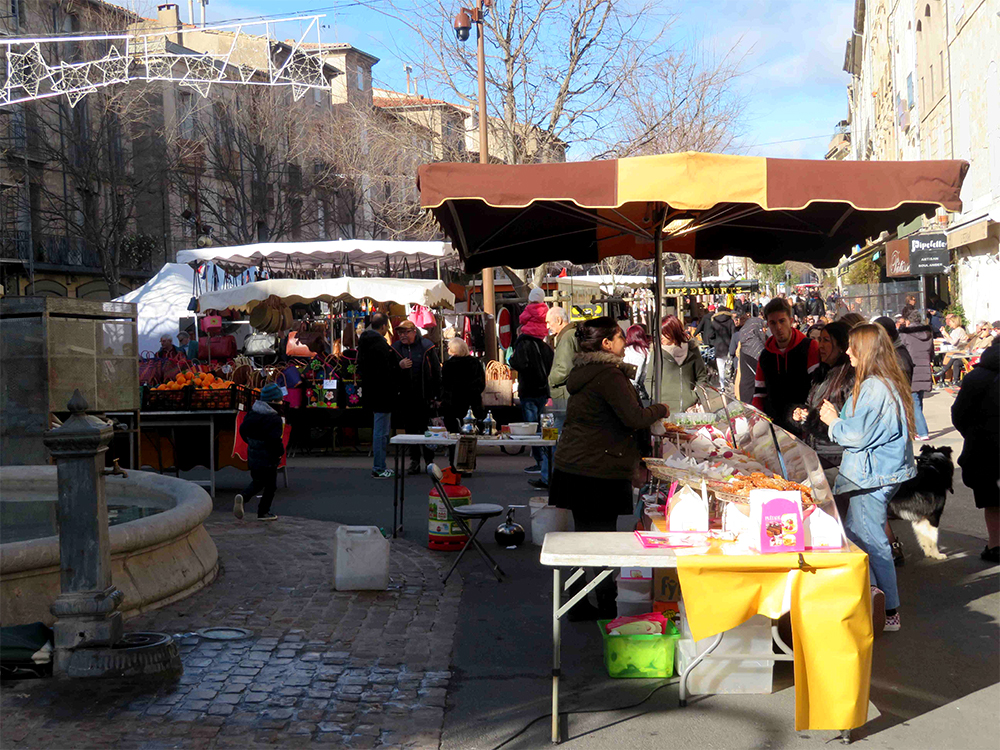 All this brings me around to my morning visit to the market here in Languedoc.
All this brings me around to my morning visit to the market here in Languedoc.
Saturday morning is when Pezenas market is in full flight so we headed off this morning with just a few essential purchases needed.
My number one need was for marmalade oranges, amazingly difficult to source here, and my second essential was for a new pair of braces, as my only pair had given up the ghost this morning as I attempted to fasten them.
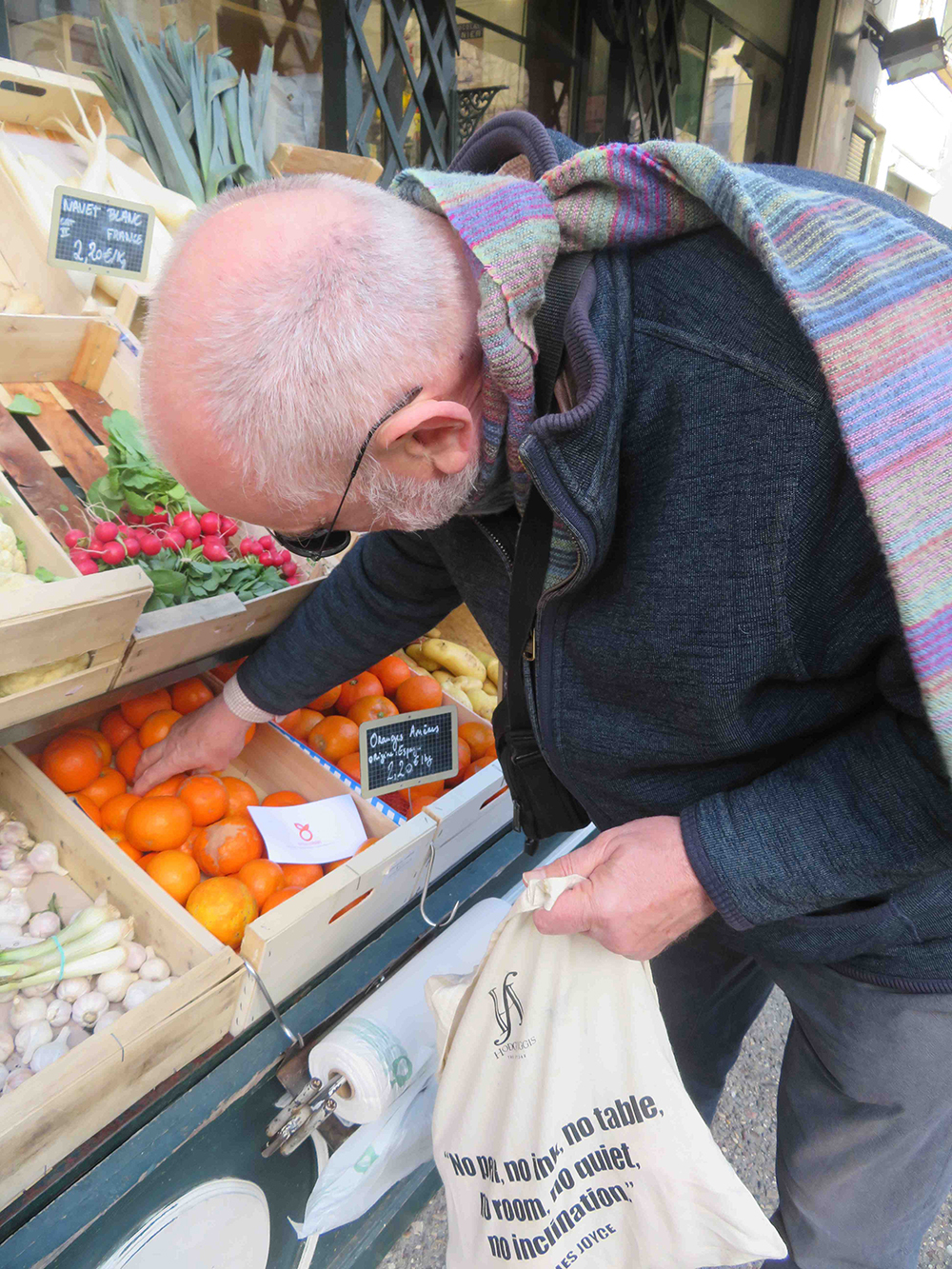 The first thing we needed to do was to get the French current term for both. Braces proved the easier of the two to translate- bretelles was still in current use here but plainly not stocked a lot in Pezenas, in fact it began to be a hopeless quest. Seville Oranges posed another problem. My culinary dictionaries translate this fruit as the Bigarade but asking for this met with many blank stares until I started to ask for Oranges amères - bitter oranges - then at least they did understand, even though they didn’t stock them. They had they assured me, Navel Oranges, Blood Oranges, Satsumas, Tangerines and Clementines but alas no Amères.
The first thing we needed to do was to get the French current term for both. Braces proved the easier of the two to translate- bretelles was still in current use here but plainly not stocked a lot in Pezenas, in fact it began to be a hopeless quest. Seville Oranges posed another problem. My culinary dictionaries translate this fruit as the Bigarade but asking for this met with many blank stares until I started to ask for Oranges amères - bitter oranges - then at least they did understand, even though they didn’t stock them. They had they assured me, Navel Oranges, Blood Oranges, Satsumas, Tangerines and Clementines but alas no Amères.
My last chance was in a little Charcutier-fruitier at the very end of the market. There to my great delight was the elusive Bigarade for an affordable €2.20 the kilo, and then ( because success seems to follow success) in a man’s clothing stall at the very beginning of the market nearest to the car we also found the elusive bretelles, perfect sturdy looking bretelles two and stout enough to maintain the Dwyer dignity. We had also managed to stock up on vegetables (delicious young spinach and young crisp broccoli) and a good free range chicken, and also breakfasted on a creamy coffee in the square and people watched as we chewed our way some pain au raisin from the boulanger next to the café.
All in all an excellent morning’s work.
Martin Dwyer started cooking professionally over 40 years ago in the legendary “Snaffles Restaurant” in Dublin. After a time in a Relais Chateau in Anjou and in “The Wife of Bath” in Kent he opened his own acclaimed restaurant, “Dwyers”, in Waterford in 1989. In 2004 he sold this and moved south to France where he and his wife Síle bought and restored an old presbytery in a village in the Languedoc. They now run Le Presbytère as a French style Chambre d’Hôte. Martin however is far too passionate about food to give up cooking so they now enjoy serving dinner to their customers on the terrace of Le Presbytère on warm summer evenings. Martin runs occasional cookery courses in Le Presbytère and Síle’s brother Colm does week long Nature Strolls discovering the Flora and Fauna of the Languedoc.
Le Presbytère can be seen at: www.lepresbytere.net;
email: martin@lepresbytere.net
An Irish Chef in France
.jpg)
 The French don’t like to throw stuff away, when an artefact, a piece of clothing or furniture becomes redundant they much prefer to sell it.
The French don’t like to throw stuff away, when an artefact, a piece of clothing or furniture becomes redundant they much prefer to sell it.
There are various levels on which it is possible to sell these pieces from the past. Antiquités, or Antique Shops are the places where the plum pieces are sold and they are the places where you can expect to spend money. Next level down is the Brocante, these are, I suppose, roughly the equivalent of junk shops in Ireland and where you can find bargains from the past or pick up something vintage at less than half the price of buying it new.
The third level is the Vide Grenier - the Empty Attic - and these are usually village sales where all the tat from Granny’s attic are put out on tables in the village square and offered, without shame, for sale.
This is the place to find bargains. But you must be prepared to look hard.
We were drawn to these village sales first by our pursuit of French glasses. These are classic café glasses usually sold as Absinthe glasses in the Antique or Brocante shops but the truth of the matter is that they were the sturdy drinking glasses of the people and used at home and in cafés to drink wine and water. I remember buying one in a country sale for a couple of euro and seeing his identical twin for sale in the Marché aux Puces in Paris for ten times that amount.
Of course not everything for sale on a stall in a Vide Grenier is a bargain. Most things are tat; in fact I would put the tat level up at around 99% so you need an eagle eye and a lot of patience to find the treasures among the dross.
As I said you must have patience and also a good eye. We started looking for glasses on stalls but soon realised that there were other things available at a fraction of their retail cost. We have furnished the Presbytère with a lot of Vide Grenier finds, beautiful chairs with cane seats, which are perfect for guest rooms, glass lampshades which were from the beginning of the last century, Sile has bought beautiful linen sheets, probably part of a bride’s trousseau, and as well as using them for their original purpose, she has used the great lengths of old linen to make curtains for the Presbytere windows and pillowslips for the beds.
.jpg) Of course, as time went on for us in France and as we visited more Vide Greniers, we began to fill our own attic full of junk. We did however have one last bit of equipment we were searching for. It is our custom in Le Presbytère to offer or guests, as an aperitif, a glass of the local sparkling wine from Limoux. I had bought - I think for about €40, a particularly fine champagne flute which was from the turn of the last century and came from Alsace.
Of course, as time went on for us in France and as we visited more Vide Greniers, we began to fill our own attic full of junk. We did however have one last bit of equipment we were searching for. It is our custom in Le Presbytère to offer or guests, as an aperitif, a glass of the local sparkling wine from Limoux. I had bought - I think for about €40, a particularly fine champagne flute which was from the turn of the last century and came from Alsace.
It was near the end of the day in a local village when I spotted ten of them, a not quite matching set, lined up on a stall. “How much are they” I asked Monsieur. “Dix euro,” he said. Ten euro - now this was a bargain, the whole ten for a mere hundred Euros - but I didn’t have €100 on me and while I was trying to put into French a request to pay by cheque I produced my last tenner from my wallet.
“C’est bon” said monsieur, whisked the tenner from my fingers and proceeded to wrap the glasses in old newspapers. I suddenly realised that he meant €10 for the entire collection and tried to hide the glee from my face.
This was certainly my best Vide Grenier bargain, and these beauties have served sparkling wine now, from the terrace of the Presbytère, many hundreds of times since their purchase.
ABOUT: Euro-Toques chef Martin Dwyer and his wife Sile sold their eponymous Waterford restaurant in 2004 and moved to France. They now live in the Languedoc, where they take guests - and feed them very well.
Martin started cooking professionally over 40 years ago in the legendary “Snaffles Restaurant” in Dublin. After a time in a Relais Chateau in Anjou and in “The Wife of Bath” in Kent he opened his own acclaimed restaurant, “Dwyers”, in Waterford in 1989. In 2004 he sold this and moved south to France where he and his wife Síle bought and restored an old presbytery in a village in the Languedoc. They now run Le Presbytère as a French style Chambre d’Hôte. Martin however is far too passionate about food to give up cooking so they now enjoy serving dinner to their customers on the terrace of Le Presbytère on warm summer evenings. Martin runs occasional cookery courses in Le Presbytère and Síle’s brother Colm does week long Nature Strolls discovering the Flora and Fauna of the Languedoc.
Le Presbytère can be seen at: www.lepresbytere.net;
email: martin@lepresbytere.net.
An Irish Chef in France
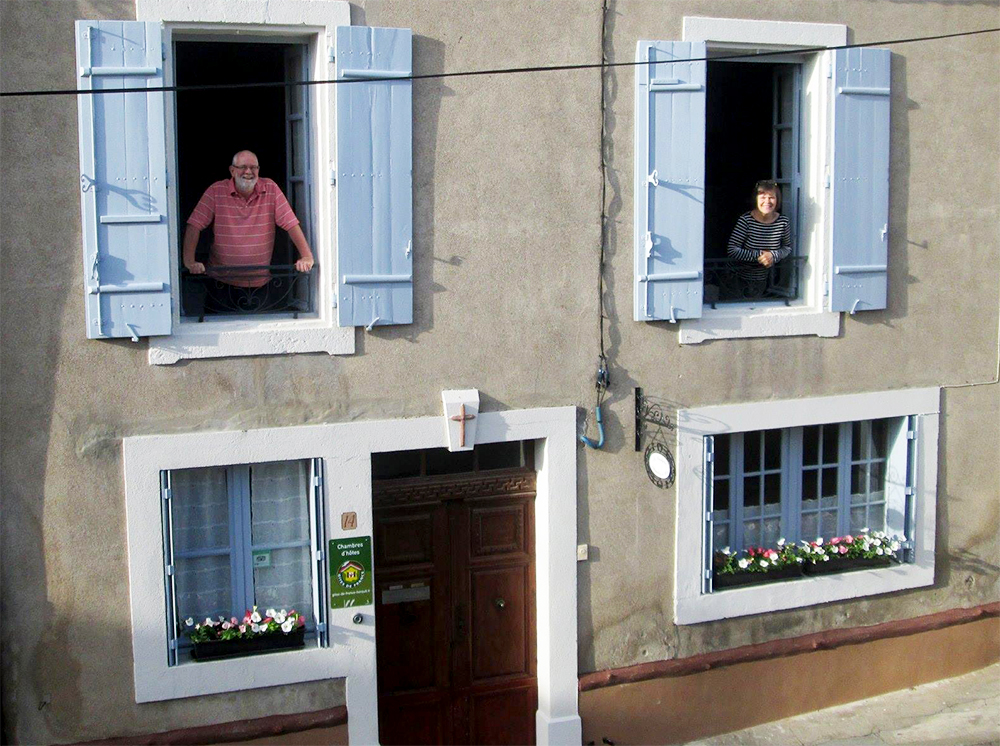
 Historically the Chambre d’Hote in France predated the restaurant by many years. France is such a large area that a traveller would have to spend more than one night in rented beds if he wanted to travel from one end of the country to the other. In this way the practice of host families offering travellers food and a bed for the night became well-established long before the birth of the restaurant.
Historically the Chambre d’Hote in France predated the restaurant by many years. France is such a large area that a traveller would have to spend more than one night in rented beds if he wanted to travel from one end of the country to the other. In this way the practice of host families offering travellers food and a bed for the night became well-established long before the birth of the restaurant.
Restaurants commenced trading when cooks and servants who were no longer employed by the deposed (and sometimes be-headed) aristocracy after the French Revolution needed to use their skills differently. These people then started to sell “restorative” soup and so opened the first restaurants in Paris and the larger cities in France. The whole process of feeding guests in France in Chambres d’Hote is governed by tradition rather than legislation and one of the traditions is that the guests should eat at the same table, and eat the same food as the hosts.
This leads to a completely different relationship with ones customers and we find that eating and drinking around the table with the clients leads to a much closer and more relaxed atmosphere.
Since we ran our own restaurant, Dwyers, in Waterford for more than fifteen years we do find that a proportion of our visitors were also customers there. We also find that one gets to know these people better over a single night while eating on the terrace that we ever did even after many visits to the restaurant.
And that of course leads naturally to the other great difference of practice out here in France; this is that for fully six months of the year, here in the south of Europe, the weather is sufficiently benign to allow us to take our dinner outside on the terrace. Food, eaten outdoors,( to quote Enid Blyton) - always seems to taste just that little better, and certainly guests eating out are always that little bit more relaxed.
Fairly early on in Le Presbytere we discovered that the French system suited us well and made the whole business more enjoyable for us. A recently widowed lady from England joined our dinner table one night during our first year in business and was delighted to join the family table. She was touring France and had spent her previous dinners eating in solitary splendour on a small table in the corner of hotel dining rooms. She loved the friendliness of the Table d’Hote and has been back nearly every year since.
Of course eating out of doors does bring one that bit closer to nature. One summer we had a nightingale who lived in a local tree within earshot and would sing to us delightfully each evening as the night fell. Early evening is usually dominated by Swifts who make daring swoops as they chase each other around the terrace. One night one of the more daring miscalculated and ended stunned on the table beside a dish of potatoes. All the coaxing in the world could not persuade the bird to take off again from our hands and then - remembering that they cannot take off from the ground - we wrapped the Swift in a napkin and catapulted him into the sky where he became instantly airborne and flew off into the sunset.
But perhaps the greatest advantage of the French system, and that which makes our lives here more relaxed, is that our Table d’Hote method of offering dinner to our guests means that we offer them no choices of courses for dinner. We do of course ask dinner guests as they book to let us know if there are any foods which they would rather not have served, any allergies or dislikes. These we can then easily avoid when making up the menu for the night.
Often my Irish customers visiting in France ask me do I regret leaving Waterford and my restaurant there and moving to Le Presbytere in Languedoc.
I explain to them that I now eat my dinner from a menu of my own choice, around the table with my customers, outdoors to the sound of Swifts and Nightingales.
Yes in a way I do miss Ireland and the buzz of running a busy restaurant from a windowless kitchen but running a Chambre d’Hote here in France has its compensations.
Martin Dwyer started cooking professionally over 40 years ago in the legendary “Snaffles Restaurant” in Dublin. After a time in a Relais Chateau in Anjou and in “The Wife of Bath” in Kent he opened his own acclaimed restaurant, “Dwyers”, in Waterford in 1989. In 2004 he sold this and moved south to France where he and his wife Síle bought and restored an old presbytery in a village in the Languedoc. They now run Le Presbytère as a French style Chambre d’Hôte. Martin however is far too passionate about food to give up cooking so they now enjoy serving dinner to their customers on the terrace of Le Presbytère on warm summer evenings. Martin runs occasional cookery courses in Le Presbytère and Síle’s brother Colm does week long Nature Strolls discovering the Flora and Fauna of the Languedoc.
Le Presbytère can be seen at: www.lepresbytere.net;
email: martin@lepresbytere.net.
An Irish Chef in France
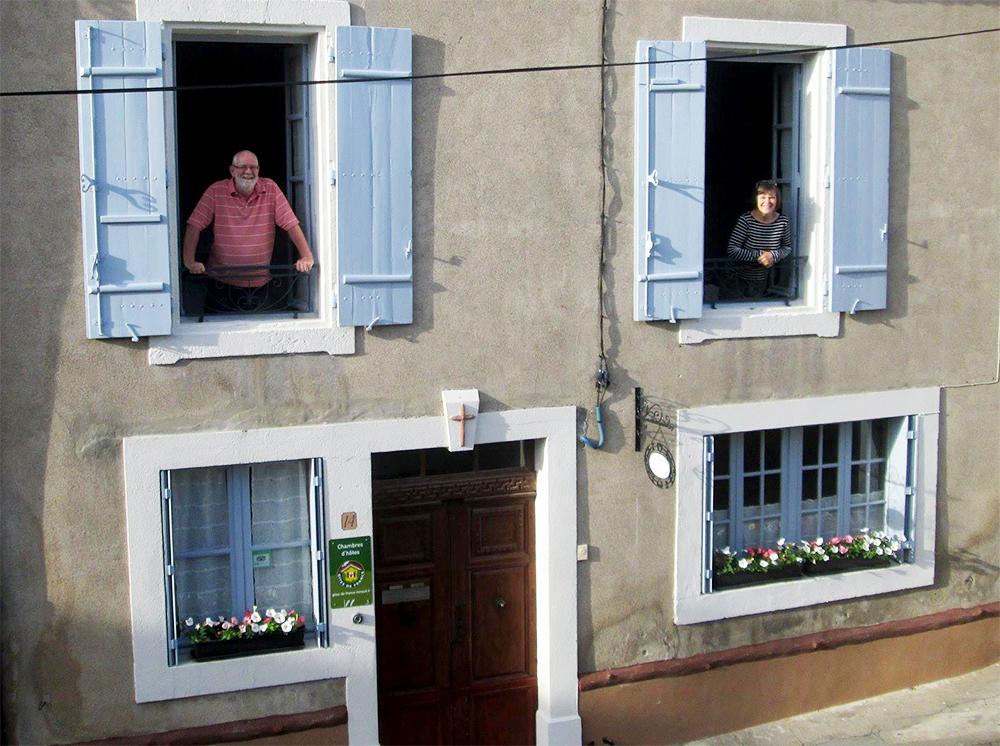
 It must be every chef’s dream from the first day they put on whites that their ultimate ambition is only going to be satisfied when they run their own restaurant. Every decision made by the management has to be considered in terms of whether or not it is one you would agree with, were you in charge.
It must be every chef’s dream from the first day they put on whites that their ultimate ambition is only going to be satisfied when they run their own restaurant. Every decision made by the management has to be considered in terms of whether or not it is one you would agree with, were you in charge.
Before I opened my own restaurant, Dwyers in Mary Street in Waterford in 1989 I had worked in a good selection of establishments, all these restaurants had certainly contributed to the chef I was then.
In 1972 I had started work first in the far from tender (in terms of kitchen employment) age of twenty three. I had perhaps dawdled a little while in search of a B.A. in U.C.D. and perhaps followed a cul de sac or two before I realised that I was not made to be a teacher. I felt an immediate rapport when working in a kitchen and was far happier peeling spuds for a few hours than writing an essay on the decline and fall of the Roman Empire.
Snaffles was in many ways an amazing place to start, Nick and Rosie Tinne who ran the establishment were both cooks because of their love of food rather than any strict training. Rosie had it is true done a Cordon Bleu course in London with Constance Spry and Nick was a Rowing Blue from Cambridge but neither of these qualifications were necessarily going to prepare them for running a busy restaurant in Leeson Street in Dublin.
What did prepare them was their dinner parties which they had produced in their house in Castleknock and the many other parties they had attended within their circle in sixties Ireland. At this time the old rigid formulae of professional cooking were breaking down, the heavily reduced stocks and set piece desserts were being overtaken by the less traditional French cooking style introduced by Elizabeth David.
The Tinnes were a great hit in Dublin for this reason and as the Good Food Guide of the time famously said “Guinness, Rome and Beauty” made a path to their basement in Leeson Street. The Tinnes were also prepared to let me try out new dishes, particularly at lunchtime, an amazing experience for an unqualified if enthusiastic young(ish) chef.
From Snaffles I went back to the heartland of cooking and headed for France. This was an eye-opener in many ways. Now I found myself back in the old school of three days boiling to make a “Fond” and peeling a potato with six concave facets and one convex “comme un gousse d’oeil”.
Probably my most important influence came next when I went to Kent to work for some years under chef Michael Waterfield.
Michael had trained under George Perry Smith in the “Hole in the Wall” in Bath. This restaurant is now recognised as the one which started to introduce the cooking philosophy of Elizabeth David to restaurants in England.
Again I had made an extremely lucky choice in my progression towards my own restaurant. Here in the Wife of Bath we cooked not only the dishes discovered by Mrs. David but also those discovered by the other cookery writers of the time, Jane Grigson and Margaret Costa. The Wife of Bath was a complete pleasure to work in and marvellous to find oneself in a job with which one was perfectly attuned.
The first time I was actually master of a kitchen was when I worked for the Gossip family in Waterford. This was also a great dry run for opening my own restaurant in this town. When I opened Dwyers in 1989 I had been living in Waterford for a decade which had truly introduced me to my prospective clients.
Nothing had, however, prepared me for the work load of running a restaurant alone. Not only must one be a chef-de-cuisine but also the human resource officer for a staff of 5 or 6 people, you must be a clever purchasing officer, on a constant search for local quality foods, you must be able to somehow spread your personality between the kitchen and the dining room so that clients feel that your personal touch is felt throughout the restaurant. You rapidly acquire a whole new set of skills from flower arranging to self publicity. I remember after the first six months of the restaurant being permanently exhausted as I continued to try and be all things to all men.
It does however, get better, but you do have to be extremely clever about husbanding your energy and delegating jobs to your staff as they become more used to your ways.
In the end however there is a tremendous amount of job satisfaction to be had from running your own business, from knowing that excellence can be achieved when the buck stops with you.
However after 15 years, in 2004, I decided to close the doors in Dwyers. Basically I wanted to experience new things before it became too much effort and running a Chambre d’Hote here in France would be less stressful than running a restaurant. This has turned out to be the case. Here we have no staff except ourselves and we eat dinner with the guests, all of which reduces the stress levels.
Recently a friend in Waterford has started to design and make wonderful sand art on the beaches of Waterford. On his webpage he recently noted that it was odd to put your heart and soul into a piece of art which was going to be washed away in the next high tide. I commented to him that this is not strange or odd for chefs whose works of art are demolished by customers within an hour of making.
Martin Dwyer started cooking professionally over 40 years ago in the legendary “Snaffles Restaurant” in Dublin. After a time in a Relais Chateau in Anjou and in “The Wife of Bath” in Kent he opened his own acclaimed restaurant, “Dwyers”, in Waterford in 1989. In 2004 he sold this and moved south to France where he and his wife Síle bought and restored an old presbytery in a village in the Languedoc. They now run Le Presbytère as a French style Chambre d’Hôte. Martin however is far too passionate about food to give up cooking so they now enjoy serving dinner to their customers on the terrace of Le Presbytère on warm summer evenings. Martin runs occasional cookery courses in Le Presbytère and Síle’s brother Colm does week long Nature Strolls discovering the Flora and Fauna of the Languedoc.
Le Presbytère can be seen at: www.lepresbytere.net;
email: martin@lepresbytere.net.
An Irish Chef in France
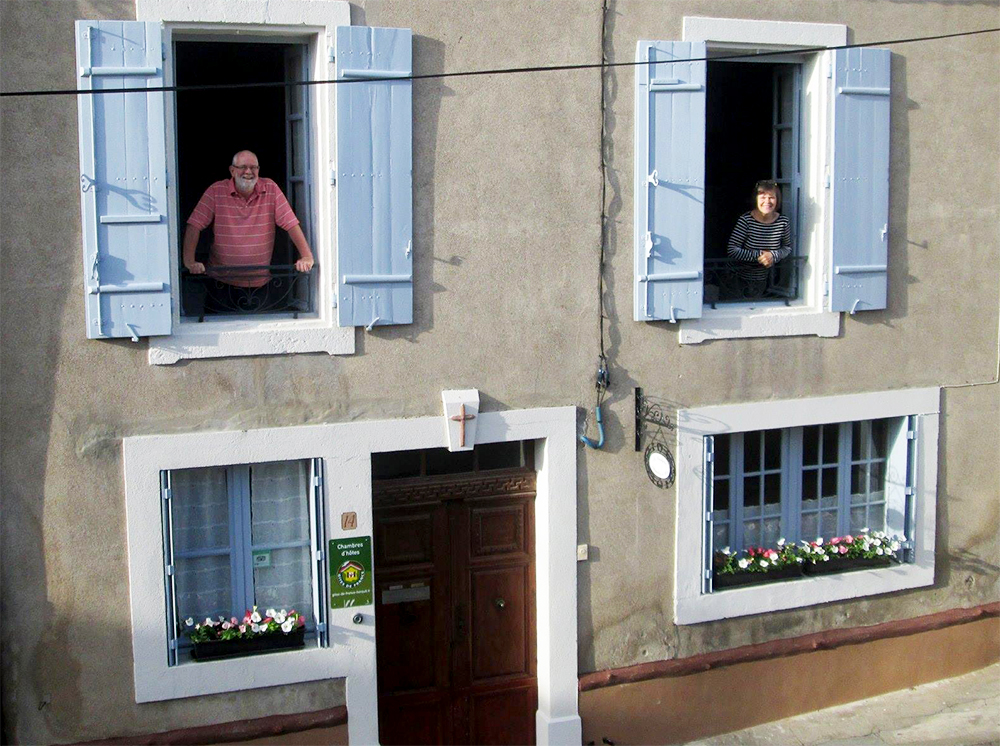
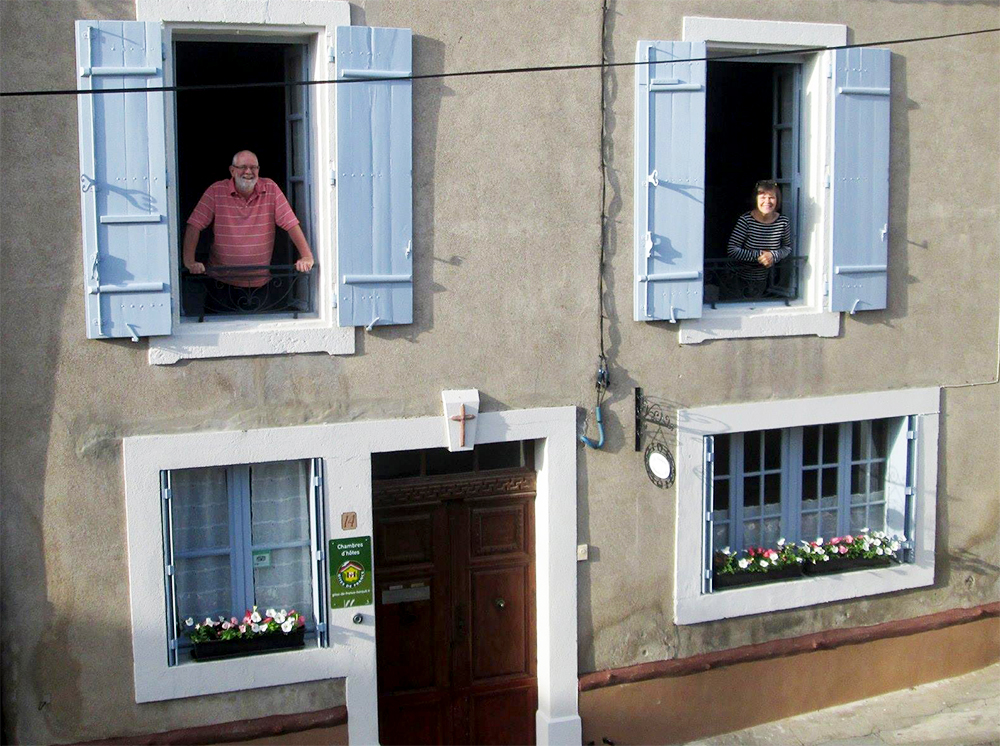 The end of a year, particularly when it coincides with the end of a decade is a time when one starts to look back and examine your last few years.
The end of a year, particularly when it coincides with the end of a decade is a time when one starts to look back and examine your last few years.
For the Dwyer family it also coincides with the end of our first decade in France. Although we bought Le Presbytere in December 2006 we didn’t move full time until the summer of 2009 and were ready for our first guests in September of that year.
It has been an interesting time and it is particularly interesting to think about the way both France and Ireland have changed over this decade.
Let us look at Ireland first.
Leaving Ireland when we did has coincided with the birth of an exciting change of attitude to food in my old home. This of course didn’t come from nowhere.
The seeds were well sown by people like Myrtle Allen in Ballymaloe and Dermot and Michael Ryan of Arbutus Lodge in Cork. They inspired a generation of Chefs to re-examine our own national cuisine and start producing food which reflected what our land and our farmers were producing. This movement was of course also an inspiration to our food producers and we are now all familiar with the amazing birth of an artisanal food industry which sprung from Veronica Steele looking for a way to use up her surplus milk in her small farm in Milleens in West Cork.
We may have all helped this movement in our own way. Euro-Toques, the international organisation of Chefs (led in Ireland by Myrtle Allen) did and does an excellent job of spreading the word of quality and honesty in our restaurants and also the organisation was one of the first to start a system of awards to reward excellence in producers and also a young chef’s award to nurture and encourage young talent in the industry.
We have seen this flower in the last few years as now Ireland is recognised as a serious food destination and indeed The Guide Michelin in its latest edition have awarded a record number of stars to Ireland.
The situation here in France is quite different; of course they started from a very different place than Ireland at the start of the century.
The French have always been great respecters of tradition and always had a great love of cooking and eating well.
I get a lot of people who arrive to us from Ireland and claim that the French have lost that tradition and that now “You can eat better in Ireland”.
I have actually been watching this with some interest and of course like many clichés there is some truth in it.
The rise of the Pizza and Burger restaurants has happened in France as it has all over the world . These can be bad as fast food chains often are, but I have discovered that most towns will also host a family run restaurant where the old French traditions of food still rule.
It is also significant that (as is also happening in Ireland) there are young chefs who are starting to produce excellent food in small, not necessarily luxurious establishments. One such has happened in our own village where a young couple have opened an excellent restaurant and appear to be doing extremely well. Another young couple opened a small restaurant in a nearby village, this pair (an Irish Chef and a French Maitresse d’Hotel) run an excellent establishment and last year were awarded a Michelin Bib Gourmand . It is interesting to wonder if this could have happened twenty years ago.
And so to reflect on our ten years in France, it is heartening to see that Ireland has developed a thriving food culture since we left – and, in France, it is possibly taking them a little longer to learn how to adapt to the twenty first century but there is strong evidence that they will get there.
An Irish Chef in France
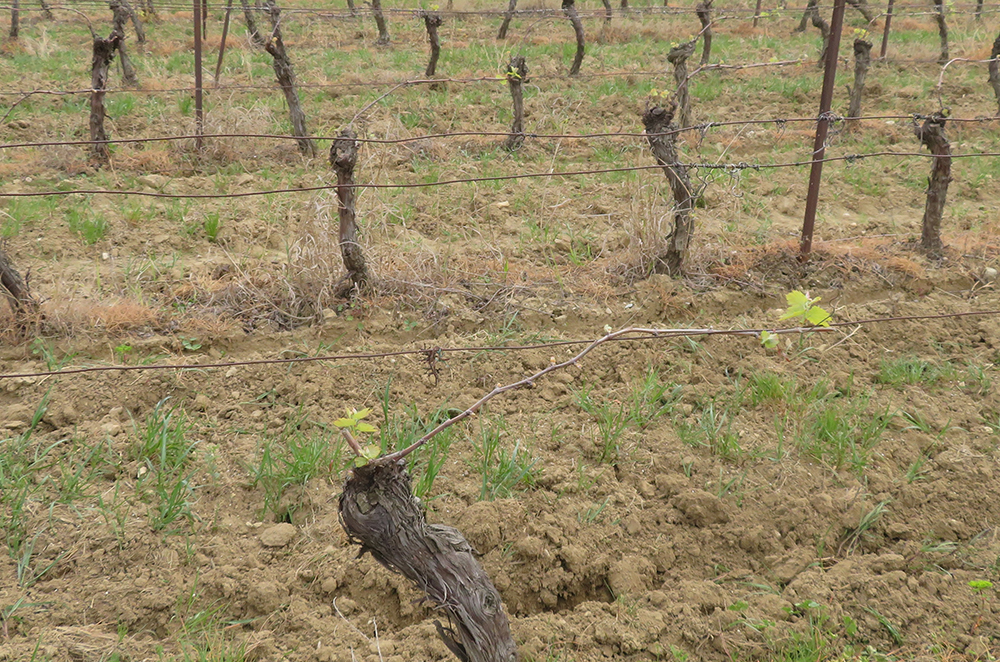
Irish chef Martin Dwyer and his wife Sile sold their eponymous restaurant in Waterford some years ago and moved to France. They now live in the Languedoc, where they (normally) take guests - and feed them very well.
This month: On being in lockdown in France
 We could have picked plenty of places to get “locked in” which would have been a lot worse than our Chambre d’Hote here in the Languedoc. Here we can enjoy the advantages of having the whole house to ourselves and with seven bedrooms we could pick a different place to lay our heads each day of the week if we wanted to, but of course we don’t.
We could have picked plenty of places to get “locked in” which would have been a lot worse than our Chambre d’Hote here in the Languedoc. Here we can enjoy the advantages of having the whole house to ourselves and with seven bedrooms we could pick a different place to lay our heads each day of the week if we wanted to, but of course we don’t.
Here in France we are allowed out only for essential shopping and for one walk in our neighbourhood each day, and for that we have to fill in a permit each time or face a fine. I must say I have no objection to that and so far it seems to be working. We have only heard of one case in the village – although I fear there may be more.
This lock in has created two highlights in our otherwise fairly dull day.
The first is our walk; when we heard first what the conditions of our confinement were to be, I imagined that we would be taking off in all directions from the village but strangely we have opted to do the same stroll almost every day.
As the Presbytère is next to the church we are right in the old heart of Thézan, inside the old walls where all the houses have roots which lead right back to the middle ages. When we started getting the house redone we discovered that there were doorways in the walls - long closed up - so that in times of attack people could escape to other houses within the walls. We also discovered a hidden passageway in the garden which led under the walls and to freedom.
Many relics of days gone by are still evident in the village and now that we have all the time in the world we can look around with a new curiosity. Our daily walk leads us out through the old walls, through a gap which must have been created when free access was more important than fear of an invading army. We walk along outside these walls and pass the remnants of a barbentine, a stone sentry box high in the wall where the man on look-out would have been protected from flying arrows.
However very quickly we are out into the countryside. The Languedoc has the reputation for being the part of the world where there are more vines growing per hectare than any other and certainly, bar some asparagus and some fruit trees, it seems to be the only crop grown around our village.
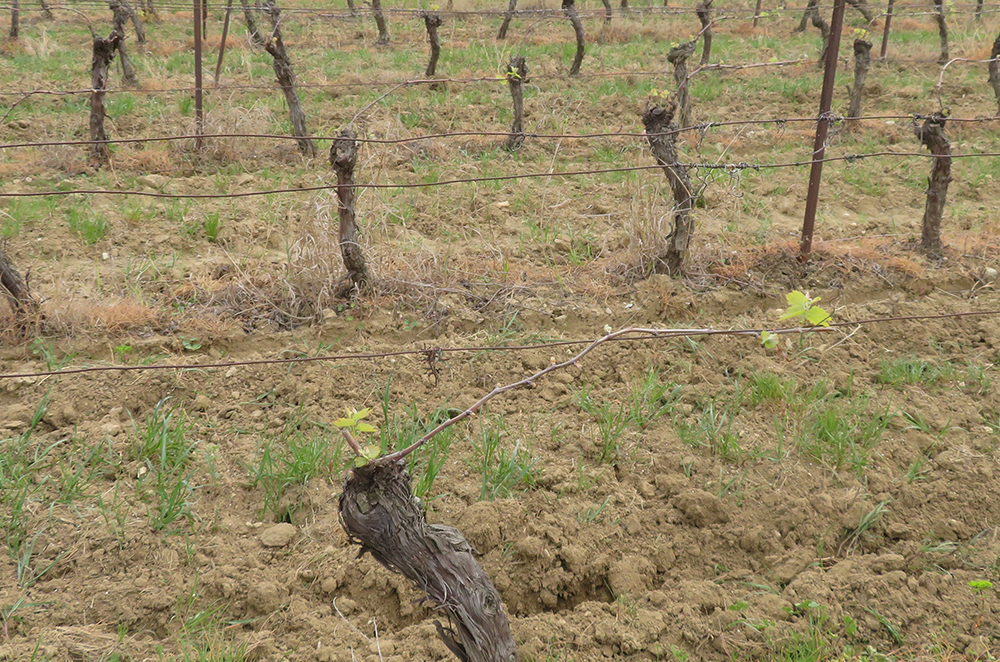
But I did say there was another highlight to our day, and this is of course our evening meal. Because we have decided that we will only shop one day a week, and then in the supermarket (most of the outdoor markets have been closed) I have, for the first time since we left our restaurant, to plan our dinners for a week in advance. This has meant that we are relying more on vegetables and eggs for our sustenance, as meat and fish are not as good at seeing out the week as are the excellent eggs and vegetables which are available in the Languedoc. There is very little hardship, we have discovered, in living on Cheese soufflé made with The Tomme cheese of the Pyrenées or in baked eggs which have been cooked in a ratatouille made with the local Coeur de Boeuf tomatoes.
Our lives are really not too bad here, we have our terrace and our garden and the mild weather of spring in southern France to help us along.
Martin Dwyer started cooking professionally over 40 years ago in the legendary “Snaffles Restaurant” in Dublin. After a time in a Relais Chateau in Anjou and in “The Wife of Bath” in Kent he opened his own acclaimed restaurant, “Dwyers”, in Waterford in 1989. In 2004 he sold this and moved south to France where he and his wife Síle bought and restored an old presbytery in a village in the Languedoc. They now run Le Presbytère as a French style Chambre d’Hôte. Martin however is far too passionate about food to give up cooking so they now enjoy serving dinner to their customers on the terrace of Le Presbytère on warm summer evenings. Martin runs occasional cookery courses in Le Presbytère and Síle’s brother Colm does week long Nature Strolls discovering the Flora and Fauna of the Languedoc.
Le Presbytère can be seen at: www.lepresbytere.net;
email: martin@lepresbytere.net.
An Irish Chef in France
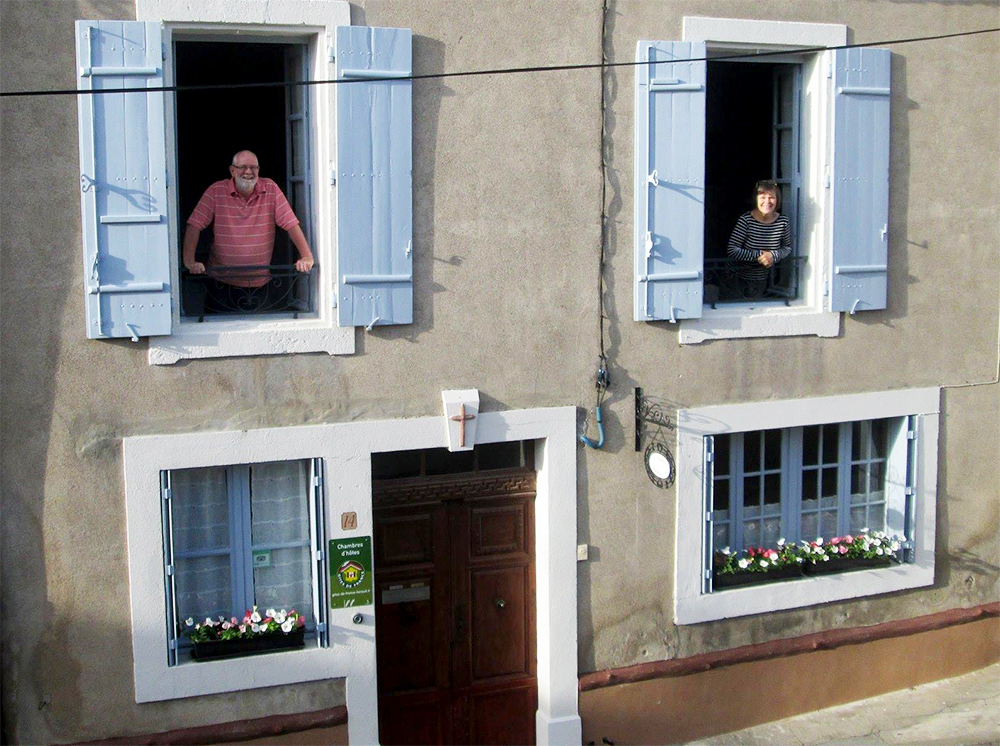
Euro-Toques chef Martin Dwyer and his wife Sile, formerly of the much-loved Dwyers restaurant in Waterford, now live in the Languedoc, where they take guests - and feed them very well.
This month: What It Really Takes To Run A Restaurant
As I write this it is the beginning of May in 2020 and restaurants in France where I live have been closed since the middle of March. Some staggered openings of other businesses have now been announced here, but there is very little hope of restaurants re-opening before the end of June at the earliest.
The tourists to the Languedoc come mainly for the beaches and they have also been closed down so even if restaurants were permitted to open their doors customers would be in scarce supply.
This is very bad news for restaurants.
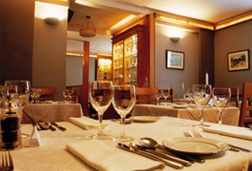 I have spent most of my working life in Ireland working in restaurants - as a chef and also, latterly, as a proprietor. I can now imagine the despair which my fellow restaurateurs must be feeling. It is a very difficult business to survive in; one slack night in an otherwise busy week can be nerve wracking, so a whole three months must be devastating.
I have spent most of my working life in Ireland working in restaurants - as a chef and also, latterly, as a proprietor. I can now imagine the despair which my fellow restaurateurs must be feeling. It is a very difficult business to survive in; one slack night in an otherwise busy week can be nerve wracking, so a whole three months must be devastating.
I think there is a general impression that restaurants can be run successfully by talented amateurs. I couldn’t count the amount of times a satisfied customer has, at the end of a good meal, confided that he and his wife have often thought of opening a place where they could feed the public.
Now I know people think that being a good cook is enough skills to run a successful restaurant, but people need to know that there are a lot of other skills to practise if they want to remain in business.
You must be a good accountant - if you are not charging enough money to cover all your expenses and costs, you will not remain long in business.
On the other side of the coin, if you charge too much you will be perceived as rip off and the customers will also stay away.
You must also be an expert in human resources, in restaurants there is inevitably a large time spent when staff have to work well together as a team, if it seems to one member that another is not pulling his weight then trouble ensues. Perhaps a waiter is required to help out with desserts or (as is currently in vogue), a chef might be needed to bring food to a table. You as proprietor must create an ethos where people are prepared to move, when needed, between roles for the good of the business.
There’s a multitude of other little skills in which you must be practised if your business is to be successful.
You must have a natural eye for décor and style because if your dining room doesn’t look pristine and welcoming no amount of good food will persuade your customers to return. You must be able to pass through the room and spot and rectify the smudge on a glass or the grains of salt on a table and yes, you must learn how to properly arrange flowers in a vase.
The point I am making here is that restaurateurs are in fact highly skilled individuals and as such should be nurtured rather than hindered by laws and taxes which don’t help their businesses.
We are all aware now that the industry has been finding it extremely difficult to recruit workers, and particularly chefs for restaurants. The reason of course is both pay and conditions and the only way that restaurateurs will be able to fix this is either to pay out less in taxes, to charge more at the end of a meal, or to somehow reduce their costs so that, while charging the same money they can pay less for their raw product.
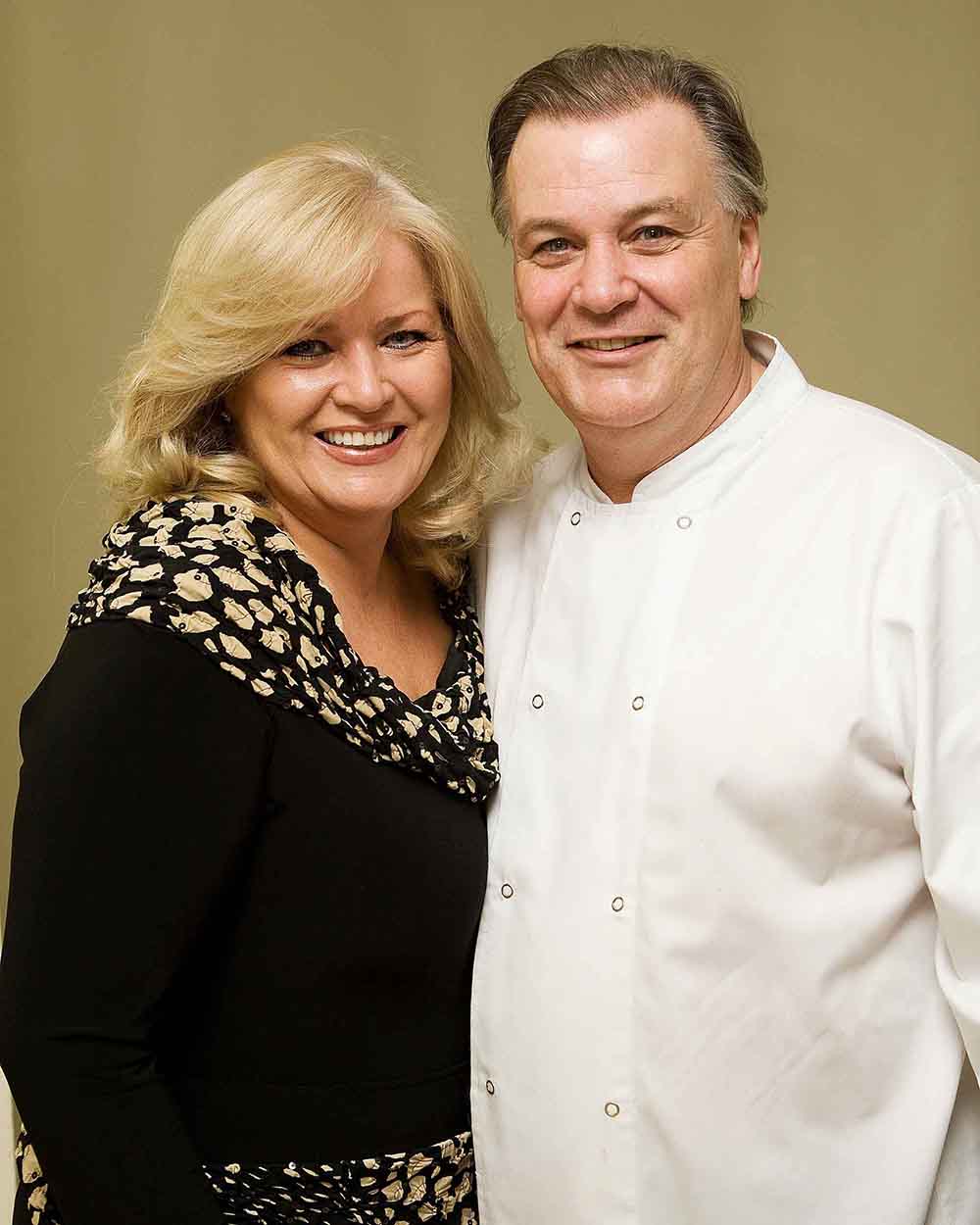 We have a small restaurant in our village here in France and they are keeping in touch with us, their customers, while in lockdown. They have told us that when they re-open they are going to serve more “small plate” food, that will make their offering more casual with a repertoire more like tapas. This is becoming an attractive option for restaurants and many fine dining chefs are deciding to change course in a bid to offer quality midmarket food in a less intense working environment. Among them, I see that my old friends Derry and Sallyanne Clarke have decided to move from Dublin’s famed L‘Ecrivain at the end of the year and reopen in Temple Bar as a restaurant that serves cheaper and less labour intensive food. This may well be the way forward.
We have a small restaurant in our village here in France and they are keeping in touch with us, their customers, while in lockdown. They have told us that when they re-open they are going to serve more “small plate” food, that will make their offering more casual with a repertoire more like tapas. This is becoming an attractive option for restaurants and many fine dining chefs are deciding to change course in a bid to offer quality midmarket food in a less intense working environment. Among them, I see that my old friends Derry and Sallyanne Clarke have decided to move from Dublin’s famed L‘Ecrivain at the end of the year and reopen in Temple Bar as a restaurant that serves cheaper and less labour intensive food. This may well be the way forward.
Meanwhile, whatever the style of their offering, there is no doubt that this virus is dealing a terrible blow to all my friends in the industry - so we must all try and support them enthusiastically as soon as they are allowed to reopen their doors.
Martin Dwyer started cooking professionally over 40 years ago in the legendary “Snaffles Restaurant” in Dublin. After a time in a Relais Chateau in Anjou and in “The Wife of Bath” in Kent he opened his own acclaimed restaurant, “Dwyers”, in Waterford in 1989. In 2004 he sold this and moved south to France where he and his wife Síle bought and restored an old presbytery in a village in the Languedoc. They now run Le Presbytère as a French style Chambre d’Hôte. Martin however is far too passionate about food to give up cooking so they now enjoy serving dinner to their customers on the terrace of Le Presbytère on warm summer evenings. Martin runs occasional cookery courses in Le Presbytère and Síle’s brother Colm does week long Nature Strolls discovering the Flora and Fauna of the Languedoc.
Le Presbytère can be seen at: www.lepresbytere.net;
email: martin@lepresbytere.net.
An Irish Chef in France
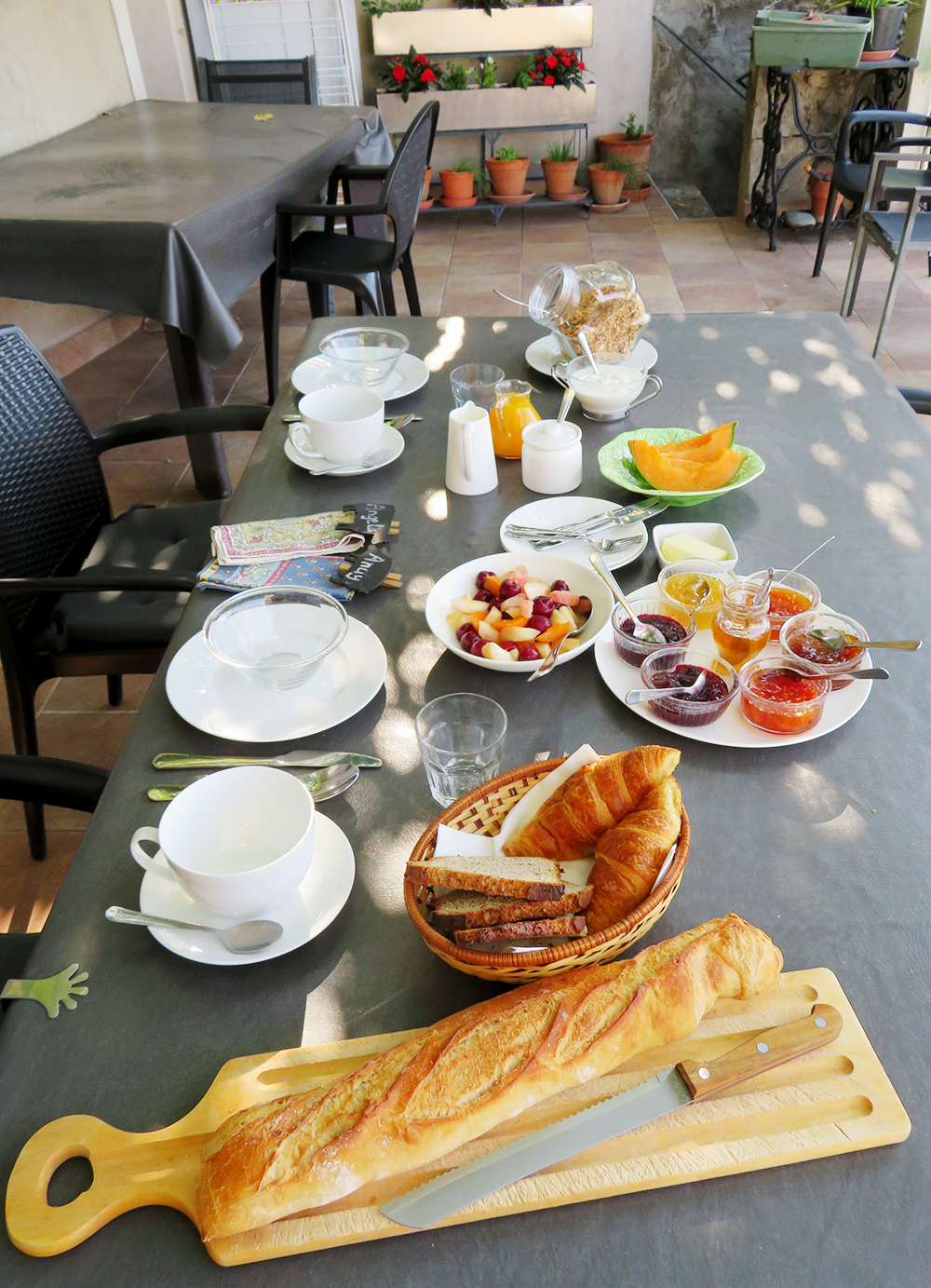
 Euro-Toques chef Martin Dwyer and his wife Sile, formerly of the much-loved Dwyers restaurant in Waterford, now live in the Languedoc, where they take guests - and feed them very well.
Euro-Toques chef Martin Dwyer and his wife Sile, formerly of the much-loved Dwyers restaurant in Waterford, now live in the Languedoc, where they take guests - and feed them very well.
This month: The summer fruit and veg season in France brings joy to all.
As I write this at the end of May in France, we are still suffering from the restrictions of the dread virus which has hugely affected our lives since mid-March. Now we can feel that the strings which bind us are slowly loosening, but also that it will be a long time before we are as free as we were last January.
However - because it is the beginning of the summer season - there is a huge consolation which is warming everyone’s heart here: the summer fruit and veg are starting to arrive.
It all started this year with the asparagus, at the beginning of April - about four weeks earlier than usual.
The asparagus growing family always know how to excite us and to make sure their pickings sell quickly they put a sign up on their gate telling us that the first of the season’s crop will be sold at nine am on Friday morning. You had better note that well because I promise by 9.30 all that will be left will be some scrawny stems suitable only for soup.
Next to arrive - around the beginning of May - are the new potatoes. They like them firm and buttery here, not particularly floury as in Ireland, but their flavour is special - mind you I always sneak a few leaves of mint into the water as I boil them, to remind me of home.
Next up are the strawberries - here two varieties fight for my attention: the large juicy and flavourful Magnums, and the small intense Garriguettes which are only a small step up from the wild strawberries, les Fraises des Bois.
Around the beginning of June the soft fruit start to arrive on the market stalls and on the shelves of the shops. First usually are the cherries - the best early ones come from the town of Ceret about 100 km away from us. Around this time it is usually worth having a spin in the car to the Haute Languedoc as a lot of the smaller growers often prefer to sell them outside their farm gates rather than go through the middle man. Here is where I sometimes find some Yellow ones - Napoleons, which make the very best jam. While we are out and about we keep an eye open for some apricots which will be coming on stream. Apricot Jam is essential to French Croissants as Orange Marmalade is to our toast.
I remember stopping by one such apricot farm gate and attempting to buy a tray from man who was plainly an experienced grower. He stopped me. “What are you going to do with them?” When I told him I was going to make jam he shook his head. “They are too ripe,” he told me. “Have you got a large cool cellar?” I told him I had. He then went back into his shed and produced a box for half the price. “Keep these in your cellar for two weeks and then make your jam.” I did what I was told - and the jam was delicious.
So now, as June unfolds, I have these to look forward to - and the white peaches, the nectarines, the melons... With this I can manage to forget about the Coronavirus for a while and just enjoy the summer bounty of the south of France.
Martin Dwyer started cooking professionally over 40 years ago in the legendary “Snaffles Restaurant” in Dublin. After a time in a Relais Chateau in Anjou and in “The Wife of Bath” in Kent, he opened his own acclaimed restaurant, “Dwyers”, in Waterford in 1989. In 2004 he sold this and moved south to France where he and his wife Síle bought and restored an old presbytery in a village in the Languedoc. They now run Le Presbytère as a French style Chambre d’Hôte. Martin however is far too passionate about food to give up cooking so they now enjoy serving dinner to their customers on the terrace of Le Presbytère on warm summer evenings. Martin runs occasional cookery courses in Le Presbytère and Síle’s brother Colm does week long Nature Strolls discovering the Flora and Fauna of the Languedoc.
Le Presbytère can be seen at: www.lepresbytere.net;
email: martin@lepresbytere.net.
An Irish Chef in France

Euro-Toques chef Martin Dwyer and his wife Sile, formerly of the much-loved Dwyers restaurant in Waterford, now live in the Languedoc, where they normally take guests and feed them very well - although, this year, they have decided that the Covid-19 protocols are too restrictive and they will wait to re-open in 2021.
Martin recalls the influence that Elizabeth David had on his life (something so many food lovers have shared), and a lingering regret…
Before I ever thought that I would end up being a chef I became interested in reading about food, there was really one major reason why this happened: it can be put down to being greedy. Having left home to go to university I soon began to realise that if I wanted to continue to enjoy food without someone to cook it for me I was going to have to learn to cook and so I began to search for suitable cook books to guide me.
 As a Corkman abroad in Dublin in the sixties I was lucky that I had a sister already living in Rathfarnham who would every so often take pity on my plight and invite me over for a decent meal. The same sister had had to teach herself to cook and fortunately for me she decided to do this from the pages of Elizabeth David. I decided to follow her lead and so the various works of Mrs David became my cooking bibles.
As a Corkman abroad in Dublin in the sixties I was lucky that I had a sister already living in Rathfarnham who would every so often take pity on my plight and invite me over for a decent meal. The same sister had had to teach herself to cook and fortunately for me she decided to do this from the pages of Elizabeth David. I decided to follow her lead and so the various works of Mrs David became my cooking bibles.
This didn’t turn out to be as useless an exercise as it sounds because after I left university with a B.A. in English and History (and a firm commitment not to become a teacher) my first job was in a kitchen (in Snaffles Restaurant) where my perusal of recipes turned out to be far more practically useful than my time studying The Hundred Years War or the pastoral poetry of Wordsworth.
My first Elizabeth David cookbook was Italian Food, not the first one she had written but an excellent choice for someone with limited financial resources.
The first of her dishes which I remember mastering was Lasagne al Forno which was (and still is) a great dish for parties and one where a little money went a very long way, and it is also worth remembering that if properly cooked it can be quite a noble repast.
 The book of Mrs. David’s which influenced me most however was French Provincial Cooking. Soon enough I began to toss out some of the wonderful dishes of provincial France. I became a dab hand at Boeuf Bourguignon, mastered a good Coq au Vin, spent many attempts getting her Terrine de Campagne right and in fact discovered that her Chicken Liver Paté was so delicious that I could subsidise my meagre income at any time by making some for the local delicatessen.
The book of Mrs. David’s which influenced me most however was French Provincial Cooking. Soon enough I began to toss out some of the wonderful dishes of provincial France. I became a dab hand at Boeuf Bourguignon, mastered a good Coq au Vin, spent many attempts getting her Terrine de Campagne right and in fact discovered that her Chicken Liver Paté was so delicious that I could subsidise my meagre income at any time by making some for the local delicatessen.
By the time of having done several years in Snaffles I decided that I should move on. Of course, (as anyone would) I decided to consult the oracle to know where to go next. I had the temerity to write and ask Mrs David what she thought.
I am still surprised that she immediately replied and, even though kindness itself, she explained that she was now out of touch with the restaurant scene in France (I have of course kept the letter). In fact it was our own Theodora FitzGibbon – at that time cookery writer for the Irish Times - who guided me towards a country Relais in Anjou which was my first employment in France.
Many years after this I was working in a little village in Kent which was midway between London and the cross channel ferries .
In the middle of lunch service the waiter announced to us that the two on table 6 were none other than Elizabeth David and a friend en route to France.
I remember that she ate the Lamb, and told us that she enjoyed it but I lacked the courage to actually go and talk to her, a thing I still regret today.
Martin Martin Dwyer started cooking professionally over 40 years ago in the legendary “Snaffles Restaurant” in Dublin. After a time in a Relais Chateau in Anjou and in “The Wife of Bath” in Kent, he opened his own acclaimed restaurant, “Dwyers”, in Waterford in 1989. In 2004 he sold up and moved south to France where he and his wife Síle bought and restored an old presbytery in a village in the Languedoc. They now run Le Presbytère as a French style Chambre d’Hôte. Martin however is far too passionate about food to give up cooking so they now enjoy serving dinner to their customers on the terrace of Le Presbytère on warm summer evenings. Martin runs occasional cookery courses in Le Presbytère and Síle’s brother Colm does week long Nature Strolls discovering the Flora and Fauna of the Languedoc.
Le Presbytère can be seen at: www.lepresbytere.net;
email: martin@lepresbytere.net.
An Irish Chef in France
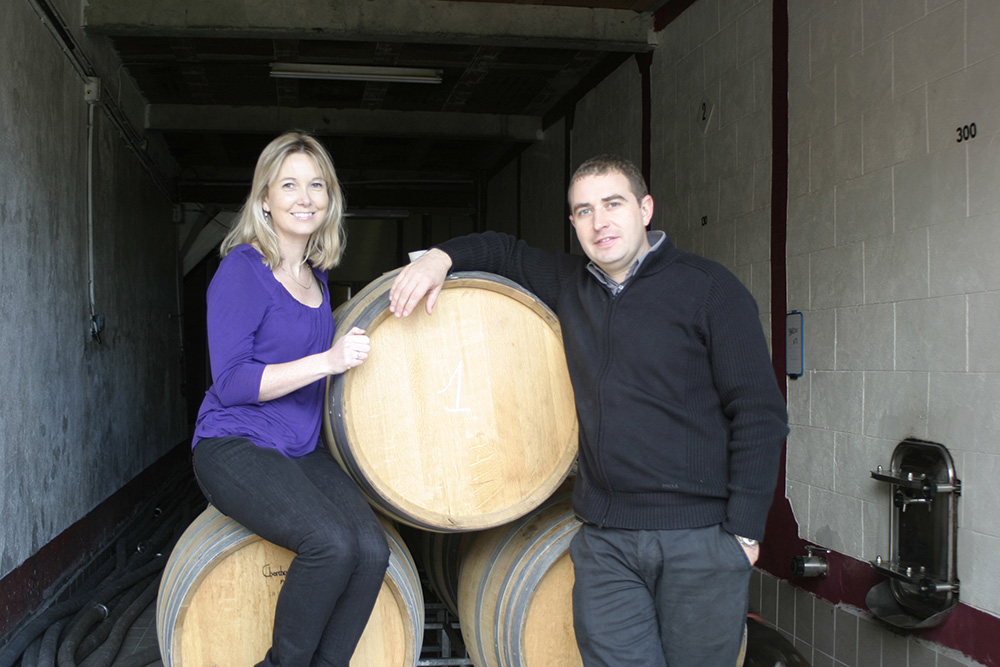
%20LR.jpg) When we bought our Chambre d’Hote in the Languedoc in 2006 we very quickly became aware that the dominant use of the land here was to cultivate the grape and the outstanding product of the area was wine.
When we bought our Chambre d’Hote in the Languedoc in 2006 we very quickly became aware that the dominant use of the land here was to cultivate the grape and the outstanding product of the area was wine.
One of the very few vineyards in our immediate area, of which we had previously heard, was Cazal Viel. Their wine was starting at that time to be sold in the Irish market and had been taken up by several of the large supermarkets.
Their vineyard, which is within the borders of the St. Chinian appellation, is about 10 km from our village and hidden in a shallow valley of the Garrigue (the rough moorland of the Languedoc).
This area has been planted with vines since the beginning of the thirteenth century, originally by the monks from nearby Fontcaude Abbey and since 1791 by the Miquel family. It is now run by Henri and Laurent Miquel the seventh and eighth generation, respectively, of the family. They now are the largest private producers in the St. Chinian area.
Laurent initially decided not to follow the family wine trade and had qualified as an engineer and was planning to work in Sheffield when he met a young Irish girl, Neasa Corish, from Foxrock in Dublin, who was working as an au pair in the nearby seaside town of Valras Plage. Theirs was a holiday romance which lasted well and six years later, having completed a Physics degree in Trinity College Dublin, Neasa moved out to France to be with him.
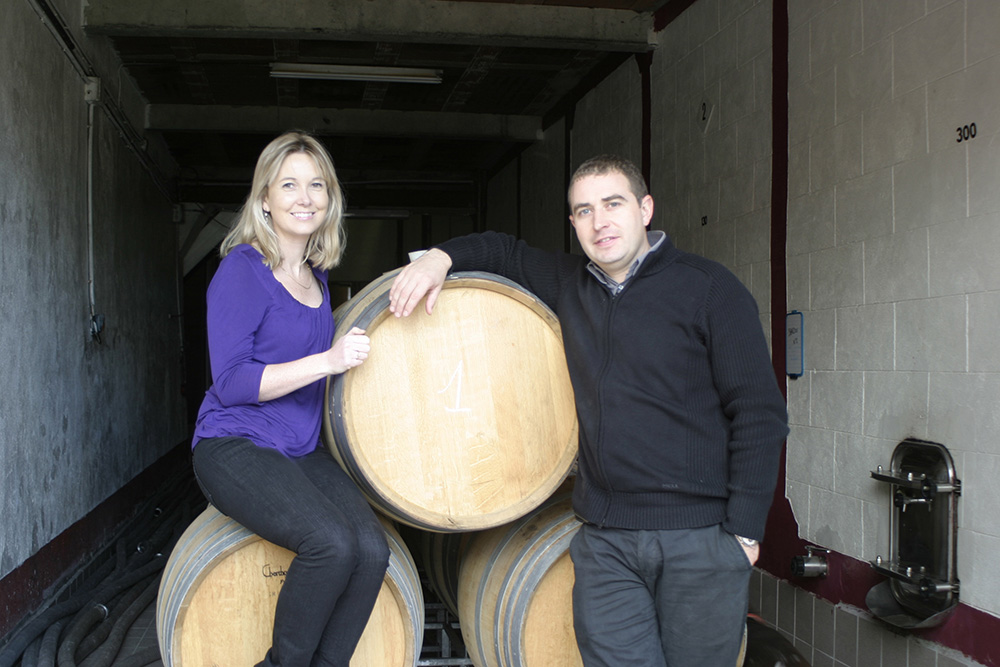 Laurent had, by this time decided to return to work in the family business and had become one of the young wine makers who were taking advantage of the volatility in the wine market of the Languedoc to move in new directions.
Laurent had, by this time decided to return to work in the family business and had become one of the young wine makers who were taking advantage of the volatility in the wine market of the Languedoc to move in new directions.
Languedoc wines were a victim of their own success. They had traditionally cornered the lower end of the market at a time when the French, never happy with the purity of their water, drank wine as a safer option to quench their thirst.
Time had caught up with them in the sixties and seventies. The importing of cheap wines from Australia and the Americas had eaten into their market. Also the French saw that their consumption of wine was not perhaps as healthy as they thought and this resulted in the average annual consumption of wine going, in a very short period of time, from 200 litres to around 40 litres per person.
The traditional wines of the area were strong reds and Laurent and Neasa went out on a limb to introduce white wines into this red dominated area. To this end Laurent planted Viognier grapes in Cazal Viel. This delicate flavoured wine was traditionally grown in Condrieu on the Rhone, an area much wetter than the Languedoc Garrigue that was dried by the by the Tramontane wind which blew down between the Pyrenees to the south and the Montagnes Noirs to the North.
Laurent set up large reservoirs on their land and was able to gather enough water in the winter to keep these vines drip irrigated during the summer.
Pleased with the success of the Viognier the Miquels made a further incursion into the white wine market by planting the Spanish Alberino grapes in another vineyard near Lagrasse. This has also proved a great success.
Neasa told us a story about one of the reasons that she and Laurent were inspired to start afresh and change and modernise their production in Cazal Viel.
After Laurent went back into the family business he met an old student friend whose father was investing heavily in a vineyard in Bordeaux. Laurent suggested he could invest more profitably in the Languedoc.
The man advised him that he would never make wines “with finesse” in the Languedoc. Laurent was determined to prove him wrong.
Wine experts like Jancis Robinson and Andrew Jefford would agree that the Languedoc wines of today have proved Laurent right.
It is pleasing to contemplate that, because these young Vignerons were prepared to change dramatically the direction of their business and move from the old reds that had been their tradition towards modern whites, they are now enjoying the successful fulfilment of their ambitions.
*Martin and Síle Dwyer’s Chambre d’Hôte, Le Presbytère, is closed this season due to Covid-19, but they look forward to welcoming guests again in 2021.
Martin Martin Dwyer started cooking professionally over 40 years ago in the legendary “Snaffles Restaurant” in Dublin. After a time in a Relais Chateau in Anjou and in “The Wife of Bath” in Kent he opened his own acclaimed restaurant, “Dwyers”, in Waterford in 1989. In 2004 he sold this and moved south to France where he and his wife Síle bought and restored an old presbytery in a village in the Languedoc. They now run Le Presbytère as a French style Chambre d’Hôte. Martin however is far too passionate about food to give up cooking so they now enjoy serving dinner to their customers on the terrace of Le Presbytère on warm summer evenings. Martin runs occasional cookery courses in Le Presbytère and Síle’s brother Colm does week long Nature Strolls discovering the Flora and Fauna of the Languedoc.
Le Presbytère can be seen at: www.lepresbytere.net;
email: martin@lepresbytere.net.
An Irish Chef in France
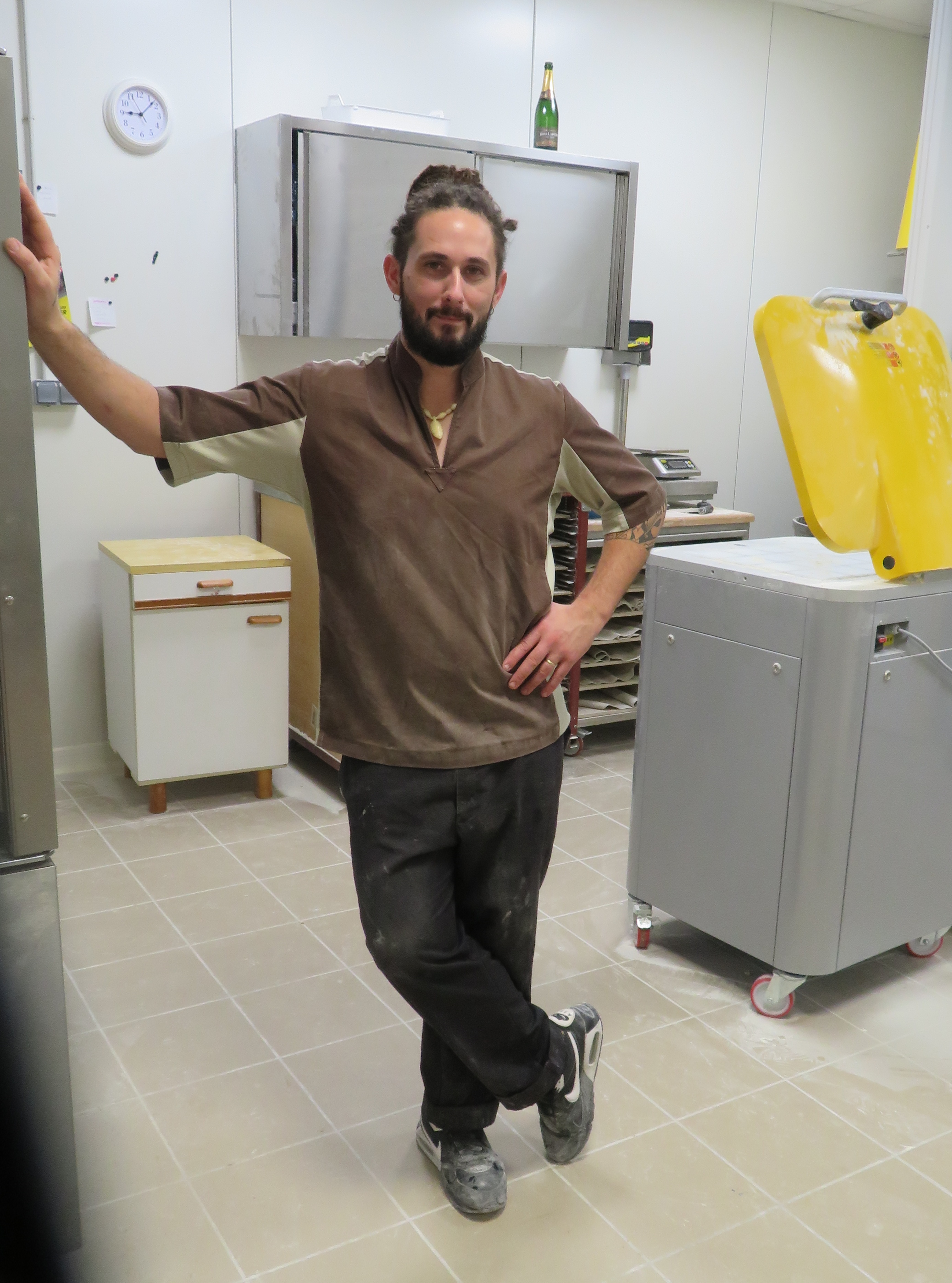
The Village Bakery: Our Irish Chef in France, Martin Dwyer, tells the story of their local bakery and its ups and downs. And there’s a lesson we could learn from in Ireland too - a favourable rates deal might encourage many a small business to bring the heart back to our rural towns and villages
*Martin and Síle Dwyer’s Chambre d’Hôte, Le Presbytère, is closed this season due to Covid-19, but they look forward to welcoming guests again in 2021.
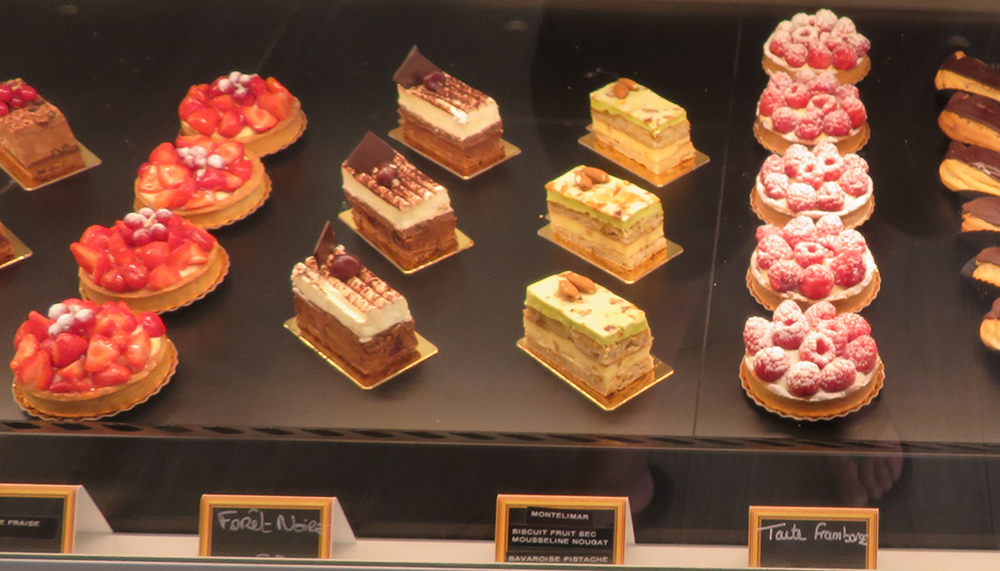
This was the first time we began to realise the importance of fresh bread to the French. The village bakery was about a kilometre away and Madame would pop down in her car to get fresh baguettes and croissants each morning - trying to time this as close as possible to the first guest’s arrival for breakfast. Should there be a break of longer than half an hour before the next guests came down Madame would again drive again to the village for fresh bread.
While we were raising our family and running our restaurant in Waterford we kept in touch with France and always had our summer holidays there.
Like the French we found that we always expected to have a handy source of fresh bread with our meals and, even in camp sites, if there wasn’t a bakery nearby there would always be a local “depot de pain” with fresh bread arriving each morning. It became a family tradition that our three daughters would head off to the nearest bread source each morning with their first useful French phrase- “Deux baguettes s’il vous plait “.
When we arrived in Thezan and set up our Chambre d’Hote there was a bakery in the village run by an elderly couple who retired shortly after our arrival, They were followed by various couples (it always follows the same pattern, he bakes and she sells) who were we think taking advantage of favourable rates offered by the Mairie to attract them in - the French have a very strong belief that a village without a bakery is a village without a heart.
I think it was about the fourth couple since our arrival who lasted the shortest time, after a few years they shut up for their summer holidays and never came back. It must be said that they were not greatly missed; I used to see a lot of people from our village buying bread in the bakery of a nearby village when I went there to get the breakfast bread for our guests.
At that stage I thought, sadly, that we had seen the last tenant of our boulangerie. I assumed that I was going to have to travel to the nearest village for our guests - but it turned out that all was not lost.
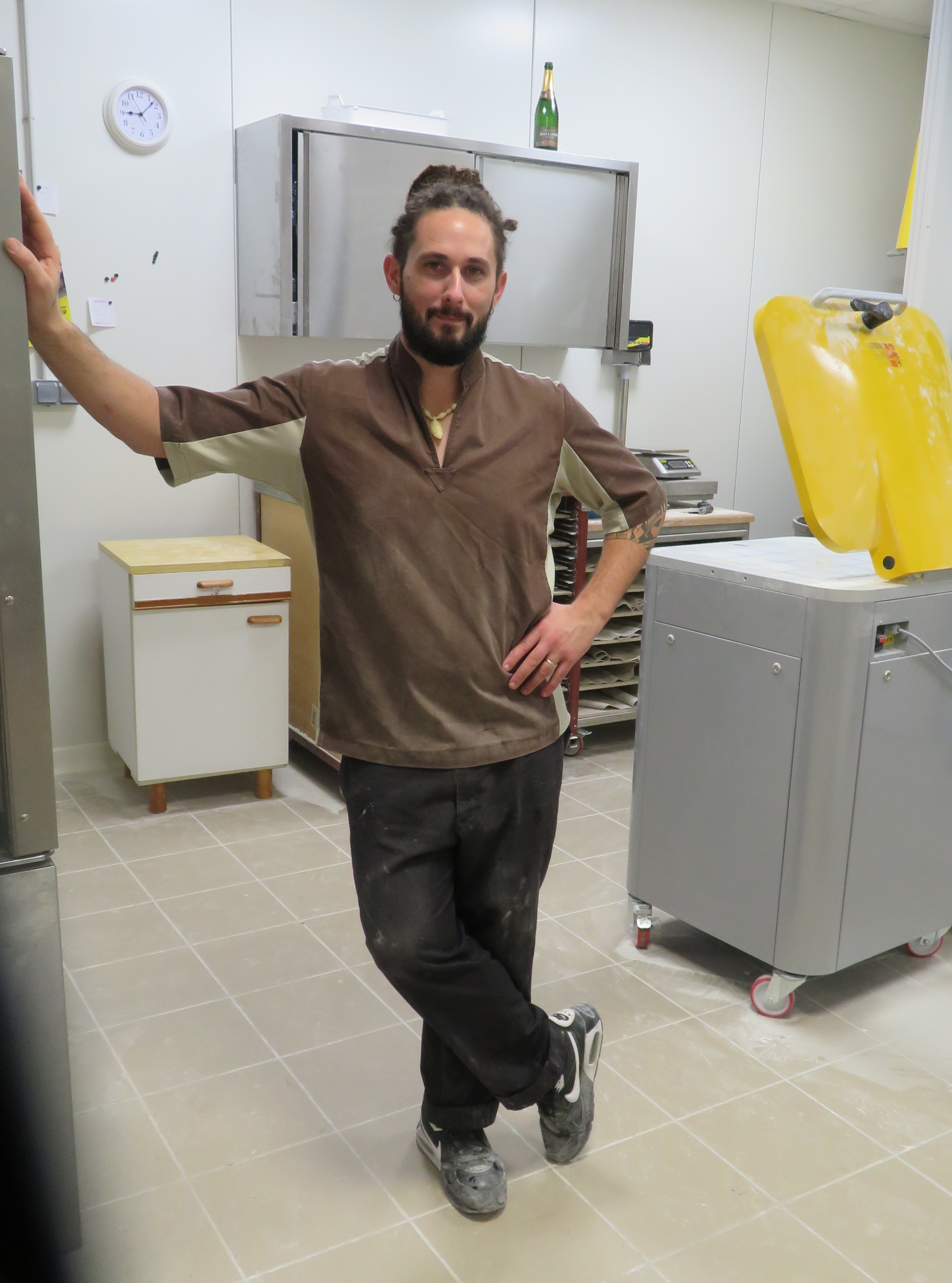
The pair had met in Martinique (where she had been born) and were now looking for somewhere to start their own business. They were Pierre-Antoine (called Pierrot) and Anais and they had two young sons.
They arrived in Le Presbytère that evening and ate here with the mayoral council, and I must confess that we were at our most encouraging. The bakery had now been empty for a year and we realised that this pair could represent a very important moment in our village.
However very little encouragement was needed to be welcoming to this lovely young couple and dinner and breakfast passed very pleasantly.
And then nothing, we heard no further from either the mayor or the people of the village so we rather assumed that our nice young couple had been lost to another venture. Then at Christmas time this year work began again on the old bakery and the word got around that it was going to re-open in the summer - not just as a boulangerie, but also a patisserie and a Salon de Thé.
We still were unsure who the baker might be until we met Pierrot in the Post Office in July - yes indeed it was he and Anais who were taking over the bakery, and they and their two boys were already ensconced in the house at the back of the bakery.
On the night before they opened they had a little reception for the traders in the village and very charmingly thanked us in their opening speech for our welcome.
The following morning they opened their doors to a lovely light filled bakery with a wonderful display of bread and pastries.
We think they are here to stay.
Martin Dwyer started cooking professionally over 40 years ago in the legendary “Snaffles Restaurant” in Dublin. After a time in a Relais Chateau in Anjou and in “The Wife of Bath” in Kent he opened his own acclaimed restaurant, “Dwyers”, in Waterford in 1989. In 2004 he sold this and moved south to France where he and his wife Síle bought and restored an old presbytery in a village in the Languedoc. They now run Le Presbytère as a French style Chambre d’Hôte. Martin however is far too passionate about food to give up cooking so they now enjoy serving dinner to their customers on the terrace of Le Presbytère on warm summer evenings. Martin runs occasional cookery courses in Le Presbytère and Síle’s brother Colm does week long Nature Strolls discovering the Flora and Fauna of the Languedoc.
Le Presbytère can be seen at: www.lepresbytere.net;
email: martin@lepresbytere.net.
An Irish Chef in France

A keen observer of the changing food scene, Euro-Toques chef Martin Dwyer is well known in Ireland for the excellent restaurant that he and his wife Sile ran in Waterford, until they moved to France in 2004. They now live in the Languedoc, where they take guests - and feed them very well.
 As I write this at Hallowe’en, we are in a second lockdown in France so we are not a bit sure whether or not we will have small “Trick or Treat” people calling at our door tonight. This is the twelfth year we have been here for Hallowe’en and in these twelve years the appearance of this holiday has changed a great deal in our village.
As I write this at Hallowe’en, we are in a second lockdown in France so we are not a bit sure whether or not we will have small “Trick or Treat” people calling at our door tonight. This is the twelfth year we have been here for Hallowe’en and in these twelve years the appearance of this holiday has changed a great deal in our village.
It was probably about our third year in residence when the first tentative knocks on the door happened at Le Presbytère and on opening we found a rag bag of children trying to get their tongues around “Trick or Treat”. That of course was the giveaway, this tradition was being imported in directly from America, probably on the back of various Hollywood movies. As the years have gone on since, the callers have certainly become more numerous and last year our neighbours recorded over a hundred at their door.
Previously the holiday of Toussaint was marked as the holiday of the departed. On all souls day, it was the tradition to visit your family graves and put flowers there. This was a beautiful sight for the first few weeks in November as the graveyards were a mass of floral splendour. Nowadays the feast has moved closer to the Irish ( American) tradition. From the middle of the month the supermarkets will be offering the usual ghastly (in its true sense) range of scary toys and ephemera.
Of course in the years we have been living here in the Languedoc this is not the only holiday which has been overtaken by the Americans, in the same time they have managed to get their hands on Christmas too.
The time I remember that hitting me - again in the supermarket - was some weeks before Christmas some years ago. This started as an almost subliminal spur which had me humming “Santa Claus is coming to town”. Then I pricked up my ears and started actually listening to what Muzak was playing in the background. It was exactly the same as it would have been in a supermarket in Ireland - lots of American Christmas standards like “Jingle Bells”, peppered with a few traditional Carols like “Silent Night”.
The American tradition had arrived it seemed as a complete parcel.
But I have also observed that the food conquest has not been so complete. Yes there are turkeys available for eating on Christmas Day but all the shops and markets will have a large range of shellfish for the night of Christmas eve. ( I like to loyally follow both traditions and follow my Lobster and Prawn dinner on Christmas Eve with a Turkey and all the trimmings on the 25th.)
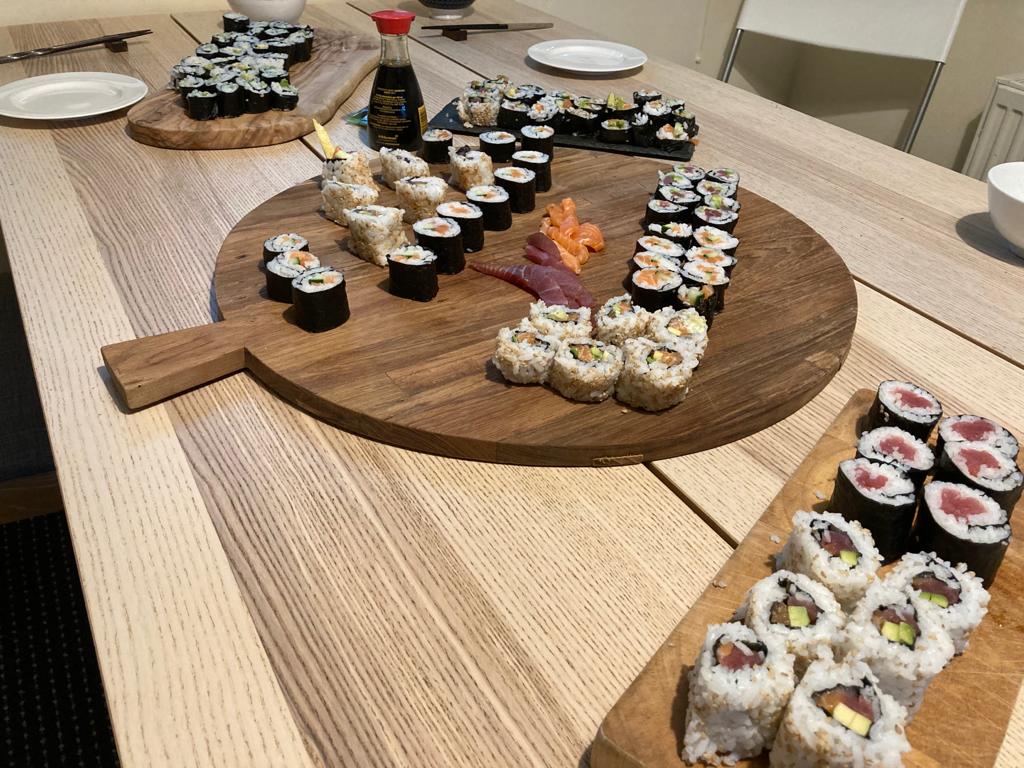 Of course at the same time the food choices in Ireland have not remained the same. Irish shops and markets (as I discovered this summer on a visit) have changed enormously since we left. Now we will be offered a large range of international foods, spices and sauces which I haven’t ever used, and the range of cheeses can sometimes even surpass the French selection.
Of course at the same time the food choices in Ireland have not remained the same. Irish shops and markets (as I discovered this summer on a visit) have changed enormously since we left. Now we will be offered a large range of international foods, spices and sauces which I haven’t ever used, and the range of cheeses can sometimes even surpass the French selection.
In the many years while I was working in my restaurant in Waterford I would long for my summer holidays in France, I would savour the thoughts of little runny goat’s cheeses, and rough savoury charcuterie, and crisp bread for mopping up sauces and croissants for breakfast - now I can get all of these things in Ireland, although I still find the French charcuterie has an edge on the Irish.
In Ireland the great traditions of international food have been welcomed . My grandsons now will have Peanut Rayu with their eggs and even make their own Sushi.
Strangely in this cosmopolitan acceptance of “foreign” foods the Irish are ahead of the French, but then the original playing field was hardly level. Twenty years ago or so the choices in Ireland would have been a lot more limited.
We are living in interesting times.
Martin Dwyer started cooking professionally over 40 years ago in the legendary “Snaffles Restaurant” in Dublin. After a time in a Relais Chateau in Anjou and in “The Wife of Bath” in Kent he opened his own acclaimed restaurant, “Dwyers”, in Waterford in 1989. In 2004 he sold this and moved south to France where he and his wife Síle bought and restored an old presbytery in a village in the Languedoc. They now run Le Presbytère as a French style Chambre d’Hôte. Martin however is far too passionate about food to give up cooking so they now enjoy serving dinner to their customers on the terrace of Le Presbytère on warm summer evenings. Martin runs occasional cookery courses in Le Presbytère and Síle’s brother Colm does week long Nature Strolls discovering the Flora and Fauna of the Languedoc.
An Irish Chef in France
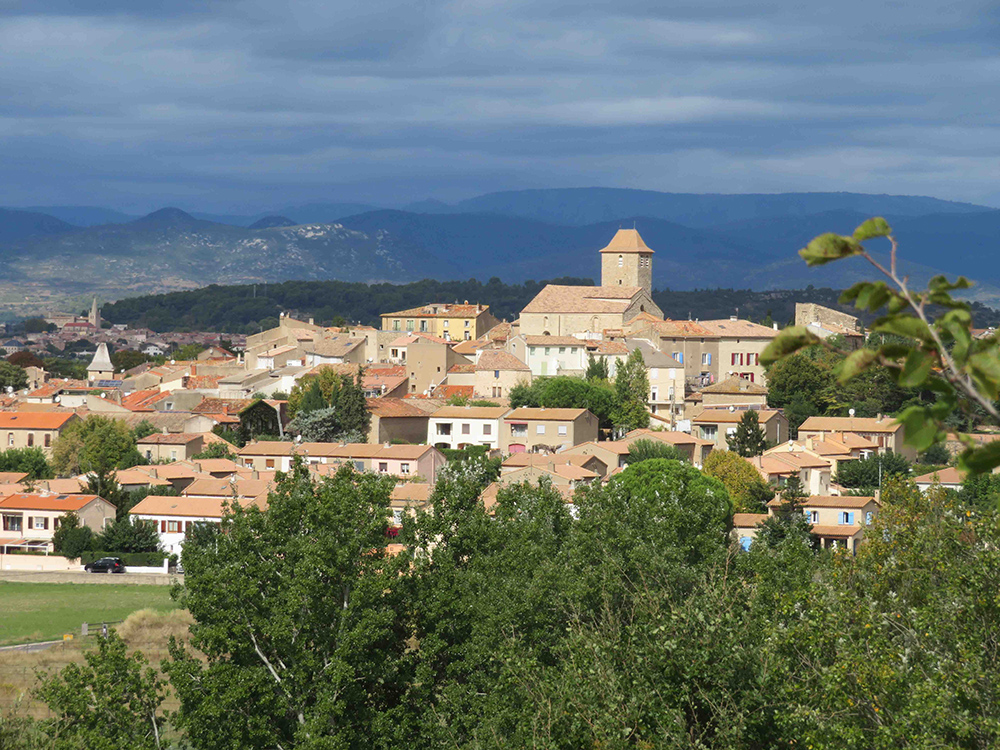
Now living in the Languedoc, where they take guests - and feed them very well - Waterford chef Martin Dwyer and his wife Sile have been closed this season due to Covid, which has given them time to enjoy the quirks of their old house and find out more about its history
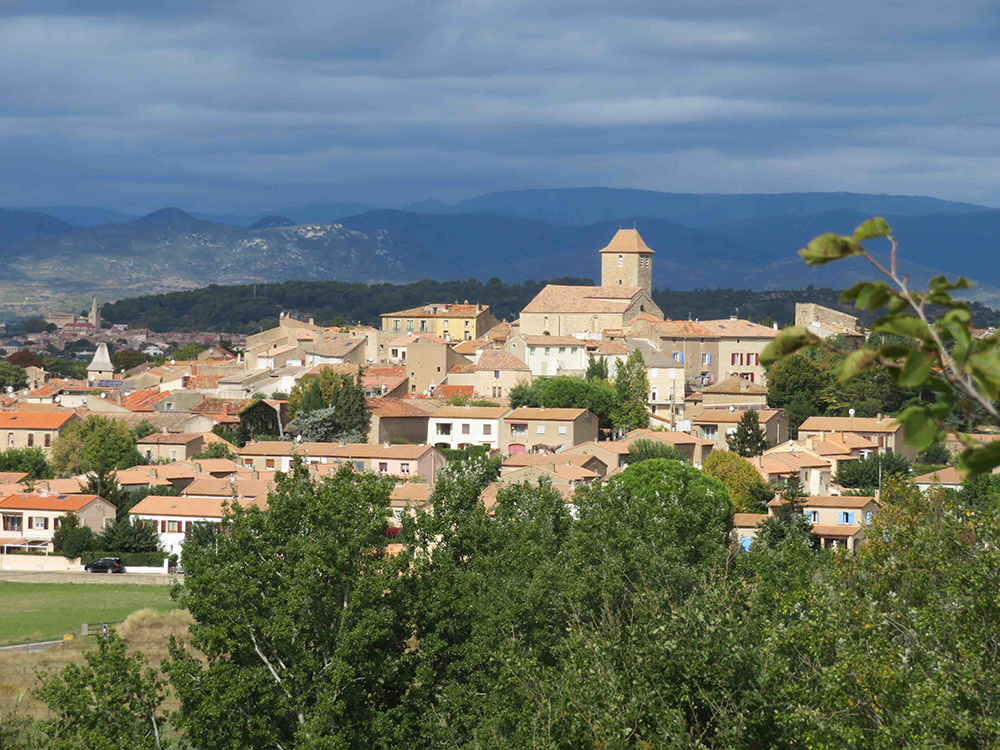 When you have been locked in for the bones of nine months you don’t tend to have a lot of stuff to chat about. That is, if you are lucky enough to come up against a friend online, or on the phone, or even by post.
When you have been locked in for the bones of nine months you don’t tend to have a lot of stuff to chat about. That is, if you are lucky enough to come up against a friend online, or on the phone, or even by post.
We do realise that we are fortunate out here in France with our rambling old house and the countryside just outside our door and with sunshine, but still, it’s a long time on our own for a couple who are used to having a fairly constant stream of guests coming and going. However, you have to work with what you have been given.
The weather here is a great help, nearly constant sun cheers me and high summer temperatures are much less debilitating when you don’t have to cook and clean up for a houseful of guests.
As we entered into our second phase of lockdown in October I decided to set myself a challenge, a very easy challenge. I decided that I would write a daily entry on Face Book about aspects of my house which my “readers” might find interesting, so with that in mind - every day - I stuck up a photo under the title of “Petits Coins du Presbytere “( Little corners of the Presbytery)
For those of you who haven’t come across my life history before here is a quick resumé:
Having worked in kitchens all my life I ran a my own restaurant in Waterford for fifteen years before my wife Sile and I sold up, and fulfilled a lifelong ambition by buying an old presbytery in the south of France and converting it into a B&B. This has been running successfully now for over ten years until the Covid 19 stopped us in our tracks.
The area we settled in is in the Languedoc, which is more or less halfway between the Alps and the Atlantic coast. We are about 20km from the Mediterranean and about 150km from the Spanish border.
Our village is called Thezan les Beziers and it is about 800 years old. Our Presbytery is just near the Church in the centre and we know that part of it at any rate was within the old town walls so some of its walls go back a long way.
The village was what they call a circulade, which means that the walls formed a circle around the centre where there was usually a castle or a church.
We do know that our house wasn’t always a presbytery, in France even in the 1920s the Catholic church was in decline. Most of the churches had been taken over by the municipal authorities and, even though still used for services, they were also allowed to be used by lay people. I found an old post-card of the outside of the church from around 1900 in which you can see a banner over the church door. I have managed to blow it up and it says that “this building is for the use of ALL the townspeople of Thezan”
.jpg) At about the same time the original Presbytère, which was a much bigger building than the one we occupy, was changed in use to the girls school and our building, in 1925 ( the date is on the wall) was converted into Le Presbytère. At the same time we reckon a road which passed along the back of our house was turned into a garden where the priests could say their offices. Our house now as it stands, is a lot larger than the houses around it. It actually touches nine other houses, so we think at the time of the conversion two or even three village houses were joined together to make the presbytery. This helps to explain all the incongruous doorways and passage ways which our builder found when we were converting the house. One particular blocked up doorway was set at an angle in the wall and a visiting urban archaeologist told us that this was at latest 15th century, when doorways were sometimes angled to give advantage to the defenders right arm, the one armed with a sword. Another doorway was blocked up and would have led into our neighbour’s living room. Our builder, who was from the village , told us that these interconnecting doors were often found in old houses in Thezan.
At about the same time the original Presbytère, which was a much bigger building than the one we occupy, was changed in use to the girls school and our building, in 1925 ( the date is on the wall) was converted into Le Presbytère. At the same time we reckon a road which passed along the back of our house was turned into a garden where the priests could say their offices. Our house now as it stands, is a lot larger than the houses around it. It actually touches nine other houses, so we think at the time of the conversion two or even three village houses were joined together to make the presbytery. This helps to explain all the incongruous doorways and passage ways which our builder found when we were converting the house. One particular blocked up doorway was set at an angle in the wall and a visiting urban archaeologist told us that this was at latest 15th century, when doorways were sometimes angled to give advantage to the defenders right arm, the one armed with a sword. Another doorway was blocked up and would have led into our neighbour’s living room. Our builder, who was from the village , told us that these interconnecting doors were often found in old houses in Thezan.
The most exciting find however was when our neighbours bought a barn which abuts our garden but on the lower street level. At the back of the building they found a doorway which led to an old stone arched stairway which had led into our little garden but the exit had long been blocked off . This would have connected to our old stone garden steps. Plainly this was a public route at one time, and at the bottom it would have led outside the village walls.
I must admit that I often wondered why the old building was so equipped for defence. Even though the medieval times were not exactly peaceful there was, I would have thought, more unrest in the north of France.
It was however during this lockdown that I began to get a possible answer to my questions. As well as having a close look at the house for my “Petits Coins du Presbytère”, I was reading a book called “Distant Mirror” about the “calamitous” 14th century in France. In one part Barbara Tuchman, the author, explains that these wars, mainly between England and France, in their way gave rise to a dangerous amount of brigandage. As neither side could afford to keep a standing army they trained men who, after the battles, would be let loose to their own devices. This soldiery then became bands of outlaws who roamed through the country often attacking small towns and villages to pillage, rob and slaughter. This offers an explanation of the life saving measures in the old houses like ours. If the walls were breached and the enemy at the door an escape could be offered into a neighbour’s house and should the danger be even more grave the passage through the house and down the stairway would provide them with an escape outside the walls. Living in an old house in France sometimes brings history right into your life.
Martin Dwyer started cooking professionally over 40 years ago in the legendary “Snaffles Restaurant” in Dublin. After a time in a Relais Chateau in Anjou and in “The Wife of Bath” in Kent he opened his own acclaimed restaurant, “Dwyers”, in Waterford in 1989. In 2004 he sold this and moved south to France where he and his wife Síle bought and restored an old presbytery in a village in the Languedoc. They now run Le Presbytère as a French style Chambre d’Hôte. Martin however is far too passionate about food to give up cooking so they now enjoy serving dinner to their customers on the terrace of Le Presbytère on warm summer evenings. Martin runs occasional cookery courses in Le Presbytère and Síle’s brother Colm does week long Nature Strolls discovering the Flora and Fauna of the Languedoc.
Le Presbytère can be seen at: www.lepresbytere.net;
email: martin@lepresbytere.net.
An Irish Chef in France
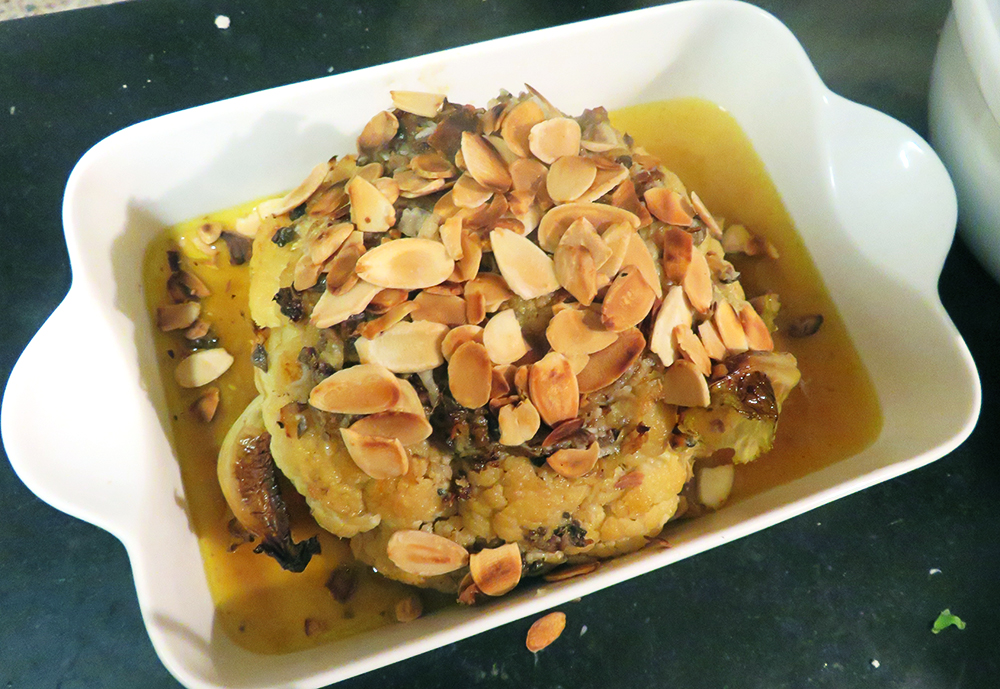
Martin and Sile Dwyer’s Chambre d’Hôte in the Languedoc has been closed by Covid for months on end. So now‘the dinner’ takes on a different role - and, simple as it is, Martin’s Lockdown Cauli story will resonate with many other cooks and chefs, no matter where they are.
 As we get through our third period of locked down here in Languedoc and our house remains stubbornly quiet, I start to think about the passers of time that we use to get us through these quiet times.
As we get through our third period of locked down here in Languedoc and our house remains stubbornly quiet, I start to think about the passers of time that we use to get us through these quiet times.
I suppose that, because I have been a chef now for 50 years anything culinary has become important in my life and being a chef in lockdown with only the two of us in the house that translates directly into “the dinner”.
As there are no outsiders to impress we are tending to eat very simple foods. One of the things we try and avoid is shopping - whether that is in supermarkets or in open air markets. Shopping involves us in a lot of close proximity with a whole lot of people and so we are more comfortable avoiding it as much as possible.
This quite often leaves us looking into our stores, into the fridge or even on to the vegetable rack searching for something which will get us through the dinner without having to shop.
This is why the humble cauliflower seems to have taken over as one of our staples.
Now I am I confess a fairly old fashioned chef, a meat and two veg kind of man but I am still aware that a lot of people aren’t like this anymore and having a main course of a roast cauliflower is not unheard of in other households.
This has set me off experimenting.
The great Irish solution with Cauliflower has been the standard and much abused Cauliflower in Cheese sauce. Done well with a good bite remaining in the vegetable and a good strong flavoured cheese it can still be a delicious dish, but let’s face it, it is often way below par. The best description I have heard of this dish at its worst was a friend who described a hotel meal served with Cauliflower Cheese as a side; “ It was impossible to tell where the cauliflower ended and the cheese sauce began”.
So rather than try to gild that particular lily I set about roasting cauliflowers with various ingredients from the larder and am glad to report that I think I have now mastered my favourite way to cook this vegetable.
It seems to have adopted a few Mediterranean ingredients (our local sardines from Collioure are excellent) and these touches really do give it an extra edge.

Serves four as a main course with other vegetables, or six as a side.
1medium cauliflower
3 whole anchovies (or 6 fillets) well chopped 3 fat cloves garlic - grated Grated zest and juice of 1 lemon 3 tablespoons of sherry ( or dry wine)
3 tablespoons olive oil
2 tablespoons slivered almonds
Preheat the oven to 180c.
Brown the almonds on a dry pan. Trim the cauliflower of most of its leaves and slice across the base so that it stands. Cut a cross in the core.
Make a paste with the anchovies, garlic and lemon zest then add the juice, the sherry, and the oil.
Rub this paste into the cauliflower. Put into a casserole with a lid ( or a roasting tin well sealed with tinfoil) add half a cup of water to ensure it doesn’t dry out. Put into the pre-heated oven.
Cook for 45 minutes basting with the pan juices a few times (check after half an hour to ensure it still has some liquid in the pan).
Take off the lid or the foil and cook, uncovered, for a further 15 minutes.
Sprinkle over the toasted almonds before serving.
It is worth noting that if you pop some potatoes into the oven as you put in the cauli they will just be ready at the same time - and if you have a vegetarian in the house you can substitute some stoned finely chopped olives for the anchovies.
Martin Dwyer started cooking professionally over 40 years ago in the legendary “Snaffles Restaurant” in Dublin. After a time in a Relais Chateau in Anjou and in “The Wife of Bath” in Kent he opened his own acclaimed restaurant, “Dwyers”, in Waterford in 1989. In 2004 he sold this and moved south to France where he and his wife Síle bought and restored an old presbytery in a village in the Languedoc. They now run Le Presbytère as a French style Chambre d’Hôte. Martin however is far too passionate about food to give up cooking so they now enjoy serving dinner to their customers on the terrace of Le Presbytère on warm summer evenings. Martin runs occasional cookery courses in Le Presbytère and Síle’s brother Colm does week long Nature Strolls discovering the Flora and Fauna of the Languedoc.
Le Presbytère can be seen at: www.lepresbytere.net;
email: martin@lepresbytere.net.
An Irish Chef in France
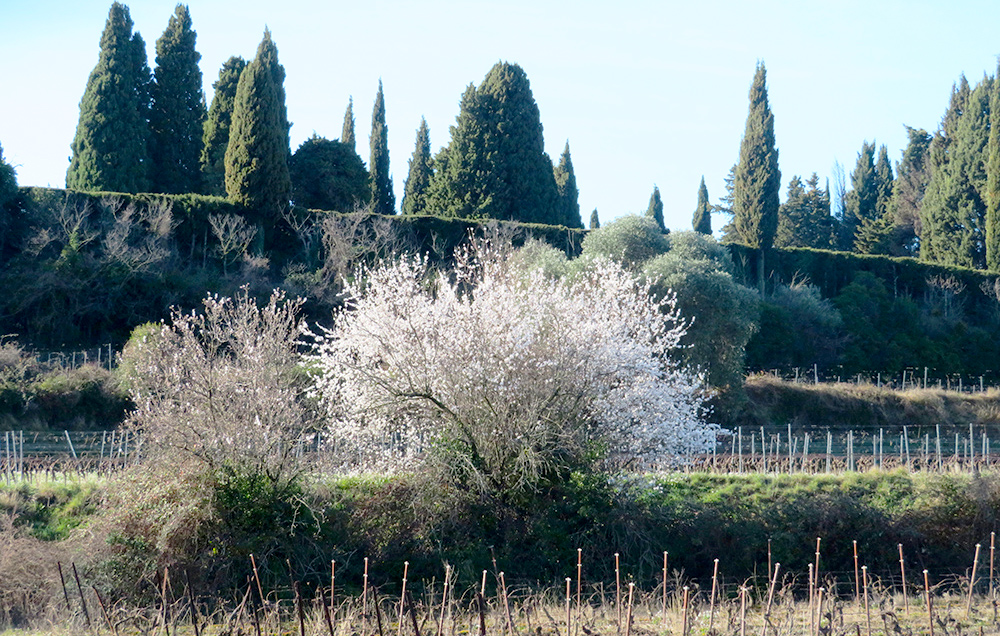
Martin and Sile Dwyer’s Chambre d’Hôte in the Languedoc has been closed by Covid for months on end and, as for everyone in lockdown, the daily walk has become their main highlight. As spring arrives, the foraging year begins, adding interest to their outings - and some of the wild food that’s there for the taking in France is surprisngly exotic…
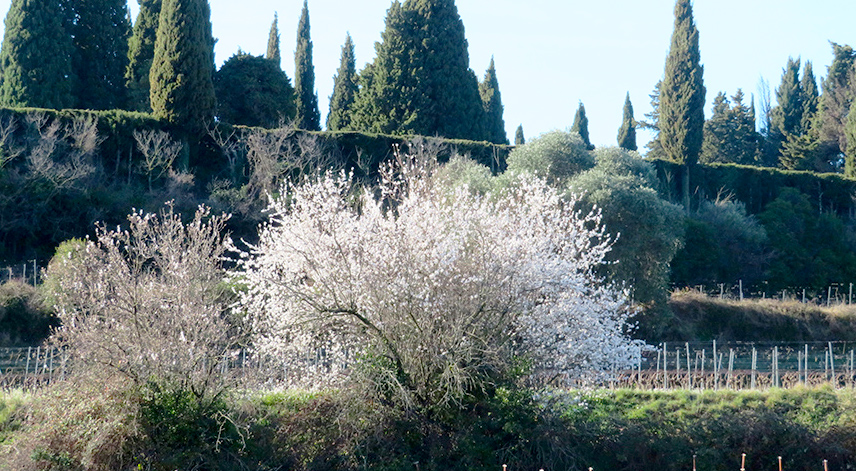
Spring comes in quietly here in the Languedoc and always makes us think that it is earlier than usual.
The first true signs we see are the almond trees starting to blossom - I am never sure whether it is the most beautiful of the fruit trees or if it is just so welcome as the first arrival after the winter.
In our department, the Herault, we are particularly well supplied with almonds which grow around the vineyards even though no one seems to pick them much anymore. It is hard to tell if they were deliberately planted or if they are more likely an escape from cultivation.
When the Almond blossom has fallen it is the cue for other plants which grow in the wild to start their own production.
One of the first is the figs, these are truly wonderful. As an Irishman they are very exotic, I have only seen expensive imports available in Ireland in the summertime. Here they literally grow on trees. Now these wild figs are not often left to rot on the branches. There is a particular beauty which we pass on our daily walk that we always keep an eye on, often picking the ripe fruit within our reach. We have been surprised on occasion to notice that the fruit higher up in the tree - unreachable without a ladder - would often disappear overnight. We assumed that it must be a fruit eating bird or bat which was taking its full of the ripe fruit.
One evening as we returned from our walk later than usual we found the fig eater. Coming against us, and heading towards the fig trees was a determined village housewife. She was carrying her fig picking machine, basically a small metal bucket on the end of a long pole. With this ingenious device she could knock the fruit into her bucket and take them home for jam.
For other products of the spring hedgerows and verges we are dependent on the thrifty French to give us notice that they are ready. Much prized, and rightly so, is the wild asparagus.
You need to watch carefully for this. The first indication of its imminent arrival is the fern, you have to look out for this and note well where you spotted it. The wild asparagus itself is very difficult to spot as it stands erect in the ditch looking for all the world like a fat blade of grass. Don’t be fooled. It is a real treat if boiled briefly and then eaten with plenty of butter.
At around the same time we will see some canny gourmets scrabbling about in the bottom of the ditches. They are it seems looking for one of two things; baby dandelion leaves for their salad or fat petit Gris (snails to you and me) to take home and purify before eating with plenty of garlic.
But for us perhaps the most exotic of the hedgerow treats is the pomegranate. This fruit is ready to steal from the trees in the height of the summer. Like the fig it amazes us that this rare and expensive fruit can be just there for the picking.
The autumn also has its fair share of food for free. You have to search them out a bit but there are wild quinces and walnuts growing around the roads and lanes of the Languedoc. I try and pick just a few walnuts every year in June to steep in alcohol to make some delicious Vin de Noix, and the quinces provide me with perhaps the best bounty of all. These I boil and sieve carefully and then reboil with sugar until it makes a firm well set jelly.
This is known as Membrillo in Portugal where it is much prized but here in the south of France it is called Cotignac. This I pour onto lined trays and then when set cut up into squares which I wrap individually. These little squares are totally delicious with the cheeses of the area- the goats cheese from the Garrigues and particularly with the sharp blue sheep’s cheese which they make in Roquefort.
The main difference between foraging here and in Ireland is, we feel, that in Ireland we are picking real wild fruit, like the sloe and the blackberry (they grow here too but don’t ripen like they do in Ireland because of the drier climate). Here the bounty of the hedges and ditches is principally fruits which were once cultivated by the smallholders but have now escaped back into the wild - and these are real prizes for us transplanted Irish folk.
Martin Dwyer started cooking professionally over 40 years ago in the legendary “Snaffles Restaurant” in Dublin. After a time in a Relais Chateau in Anjou and in “The Wife of Bath” in Kent, he opened his own acclaimed restaurant, “Dwyers”, in Waterford in 1989. In 2004 he sold this and moved south to France where he and his wife Síle bought and restored an old presbytery in a village in the Languedoc. They now run Le Presbytère as a French style Chambre d’Hôte. Martin however is far too passionate about food to give up cooking so they now enjoy serving dinner to their customers on the terrace of Le Presbytère on warm summer evenings. Martin runs occasional cookery courses in Le Presbytère and Síle’s brother Colm does week long Nature Strolls discovering the Flora and Fauna of the Languedoc.
Le Presbytère can be seen at: www.lepresbytere.net;
email: martin@lepresbytere.net.
An Irish Chef in France
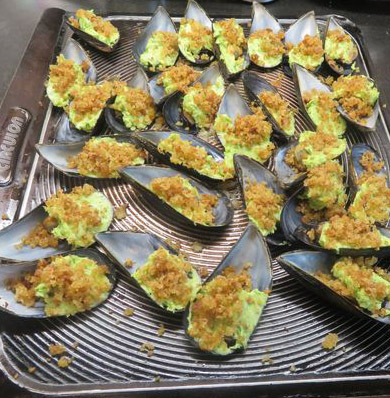
Martin and Sile Dwyer’s Chambre d’Hôte in the Languedoc has been closed by Covid for months on end and is likely to remain closed for the 2021 season. But they are finding lockdown less difficult as the spring comes in - and, as ever in the Dwyer household, tasty food is their main highlight (along with the daily walk).
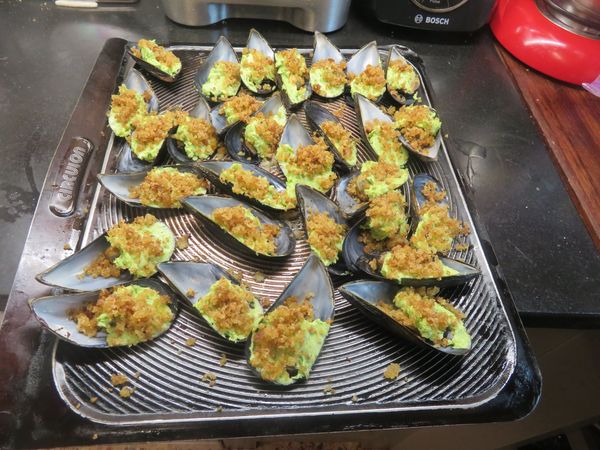 Myrtle Allen had a wonderful habit of falling on her feet and making the very best of local produce by doing the right thing almost by accident. In her “Ballymaloe Cookbook” she tells the story of Stuffed Mussels.
Myrtle Allen had a wonderful habit of falling on her feet and making the very best of local produce by doing the right thing almost by accident. In her “Ballymaloe Cookbook” she tells the story of Stuffed Mussels.
She hadn’t been long at Ballymaloe, where her husband Ivan was farming, when he told her he was bringing some French clients home to supper. Far from being phased Myrtle made a quick trip down to the nearby shoreline to pick some mussels, which she decided to stuff with butter and breadcrumbs.
When she produced this dish for the French men she was surprised when they called it “Moules Farcies “- this simple dish, which she thought she had put together on her own, appeared to be a French classic.
I was introduced to Mussels first as a teenager when my family brought me to a new restaurant which was causing a stir in Kinsale called “The Spinnaker”. This was run by a lady called Hedly McNiece, who had been married to the poet Louis. To my family’s surprise she was serving Mussels on the menu, mussels were not a fish that was in the Dwyer family repertoire. However I was the brave one and decided to risk them. I was an instant convert.
When I became a chef myself, many years later, I always contrived to add mussels somewhere in my menus. I discovered that the liquor that was produced by the mussels as you opened them was quite delicious also, and that dishes like “Moules Marinieres” or “Mussel Risotto” which used these juices in their composition were ideally suited to the delicate flavour of Irish Mussels.
When we moved to the Languedoc- about 12 years ago- I discovered that I was again in an area which prided itself in its mussels. We are not at all far from the Bassin de Thau, an inland sea, which has an extensive mussel farming industry.
Now these mussels are huge, much bigger than their Irish cousins, and have a more robust flavour. Basically, because of the high salinity of the Bassin- and indeed of the Mediterranean - these mussels are salty. That actually works well for the mussels, but to my Irish tastes makes the liquor almost inedible.
This brought me back to Les Moules Farcies and I discovered that the Moules de Thau were delicious stuffed. One further small refinement I discovered was that, because of the coarser quality of the average French breadcrumb ( made from baguette), I got a crispier result from the stuffing if I cooked these separately in olive oil.
Irish people will be pleased to know that I have tried this method of Moules Farcies with our more delicate Irish mussel - with delicious results.
Stuffed Mussels
(serves 6-8 as a starter, 4 as a main course)
2 kg mussels
175g butter
3 cloves garlic
Small bunch parsley
3 tbs. breadcrumbs.
Wash off the mussels and remove their beards (if they are farmed mussels they will have little or none).
Put the mussels into a large saucepan, with a cup of water.
Put the lid on and cook just until they open.
Take them out of the pot and discard the liquid (or freeze it for some mussel stock).
Remove the top shell, and lay the mussels out on a baking sheet in the half shells.
Soften the butter, chop the parsley and the garlic finely and mix together. (Or throw the whole lot into a food processor and process.)
Put the breadcrumbs into a pan and toss in a little oil on the heat until they become brown and crisp.
Cover each mussel in the half shell with the butter, sprinkle over the crisp crumbs and either put under a hot grill or in a hot oven until the butter melts and bubbles.
These are best eaten with lots of crisp bread to soak up the garlicy, mussely butter - and I must confess to loving the Belgian notion of eating them with hot chips.
Martin Dwyer started cooking professionally over 40 years ago in the legendary “Snaffles Restaurant” in Dublin. After a time in a Relais Chateau in Anjou and in “The Wife of Bath” in Kent, he opened his own acclaimed restaurant, “Dwyers”, in Waterford in 1989. In 2004 he sold this and moved south to France where he and his wife Síle bought and restored an old presbytery in a village in the Languedoc. They now run Le Presbytère as a French style Chambre d’Hôte. Martin however is far too passionate about food to give up cooking so they now enjoy serving dinner to their customers on the terrace of Le Presbytère on warm summer evenings. Martin runs occasional cookery courses in Le Presbytère and Síle’s brother Colm does week long Nature Strolls discovering the Flora and Fauna of the Languedoc.
Le Presbytère can be seen at: www.lepresbytere.net;
email: martin@lepresbytere.net.
An Irish Chef in France

Martin and Sile Dwyer’s Chambre d’Hôte in the Languedoc has been closed by Covid for months on end and is likely to remain closed for the 2021 season. But they're enjoying the summer coming in - and, with elderflower cordial in the making, Martin reflects on how the French and the Irish tend to respond to the foreswearing of alcohol ...

It will be five years next September when my GP here in France, looked at the results of my latest blood test and advised me, gently, that she thought that perhaps I would be better off if I gave up alcohol.
I had been toying with this notion for a while myself so it didn’t come as a total shock. Wine is so freely available, such excellent quality, and so reasonably priced here in France that I was finding it easier and easier to open the second bottle as I ate with my guests in the evening.
The reaction of my Irish friends was, I could see, to a man, to start adding up their own consumption and wonder should they do the same. The reaction of my French friends, also to a man, was that I should change my doctor.
To my surprise I found the foreswearing of alcohol quite easy and that the health benefits were quickly evident.( After my first alcohol free year my GP took me off my diabetes treatment telling me it was no longer needed.)
In fact my major battle with giving up the demon drink wasn’t so much my abstinence from alcohol as to what I was going to use as a substitute.
It won’t surprise you to learn I am sure that here in France that most social life circles around drinking alcohol. Even though the French, in my experience, don’t drink as much as we do in Ireland - nights in the pub don’t happen here - they do manage to down a fair amount of the hard stuff during the day. It is not at all unknown for them to have a glass or two of wine with lunch and the sacred hour of Aperitif, before dinner is always duly observed.
I am not a herbal tea person and soon found that this brew ( known as horrible tea chez moi) was being frequently offered to me. Most of the canon of “soft” drinks are incredibly sweet and to have more than one offends even my sweet tooth.
It was with some relief that I discovered non-alcoholic beer. This gave a fairly rough approximation of lager, was not overly sweet and didn’t proclaim to the world that Dwyer was off the drink. The obvious progression from that was towards alcohol free wine but, unfortunately, so far I have discovered that when you remove alcohol from wine you are left with a very different drink.
A couple of months ago I moaned on my face-book page about my difficulty of replacing wine in my life and I received a lot of helpful suggestions. When I sifted through these I did notice a certain thread, a lot of people were replacing wine with some concoction or other of Elderflower. It seems that the musky sweetness of this shrub acted as a possible wine substitute.
As luck would have it these advices happened just as the elder came into flower here in Languedoc so, armed with plastic bags, we headed off to gather elderflower for a cordial.
I am reasonably pleased with the end product. The resulting cordial is perhaps a little sweet - but that can be remedied - and is very good when diluted with sparkling water. My guess is that for you out there who are still drinking alcohol that mixed with a sparkling wine of your choice it would also slip down easily.
Here is the recipe.
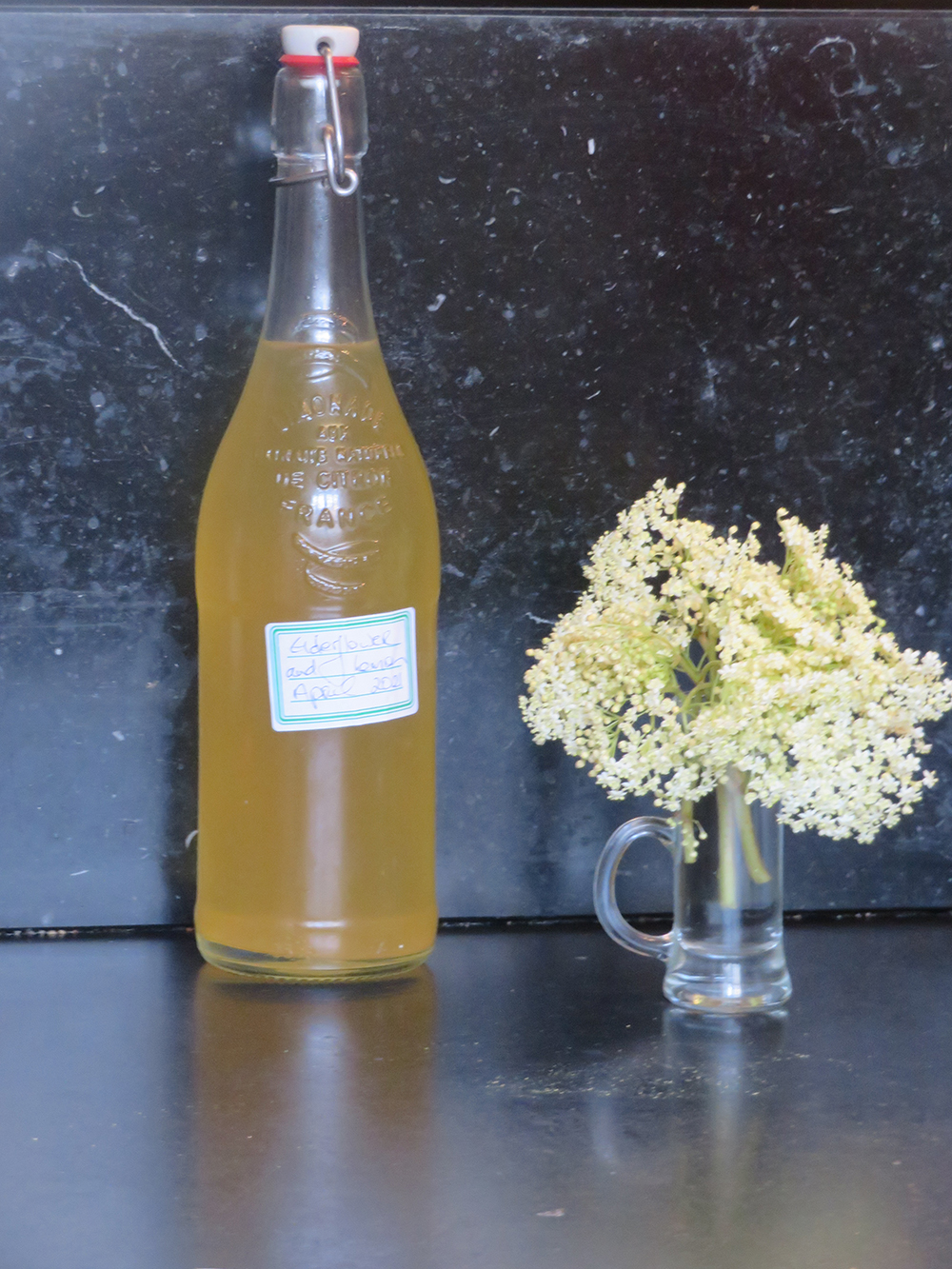
20 heads of elder flowers
1 ltr water
400g caster sugar
150 g honey
2 organic lemons
Bring the water to the boil with the sugar and honey and simmer until all the sugar has dissolved.
Grate the zest from the lemons (no pith) and then add this, with the juice of the lemons and the sliced lemons, along with the elderflowers to the hot syrup. Cover this and leave overnight to infuse. Sieve this through a cloth and bottle. It will keep bottled in a fridge for a week or two and will last much longer if you freeze it.
Martin Dwyer started cooking professionally over 40 years ago in the legendary “Snaffles Restaurant” in Dublin. After a time in a Relais Chateau in Anjou and in “The Wife of Bath” in Kent, he opened his own acclaimed restaurant, “Dwyers”, in Waterford in 1989. In 2004 he sold this and moved south to France where he and his wife Síle bought and restored an old presbytery in a village in the Languedoc. They now run Le Presbytère as a French style Chambre d’Hôte. Martin however is far too passionate about food to give up cooking so they now enjoy serving dinner to their customers on the terrace of Le Presbytère on warm summer evenings. Martin runs occasional cookery courses in Le Presbytère and Síle’s brother Colm does week long Nature Strolls discovering the Flora and Fauna of the Languedoc.
Le Presbytère can be seen at: www.lepresbytere.net;
email: martin@lepresbytere.net.
An Irish Chef in France

Martin and Sile Dwyer’s Chambre d’Hôte in the Languedoc will remain closed for the 2021 season. But, as ever in the Dwyrer household, delicious food is always a highlight - including this happy discovery, Martin’s wonderful (and gluten free) Boiled Lemon Cake.
As our quarantine rules start to relax here in France we have slowly started to - very cautiously - socialise again.
We are now allowed to have vaccinated friends visit, but only in the garden. As it is still too cold to eat our dinner on the terrace we decided that to break our isolation we would have to introduce our French friends to the concept of “Afternoon Tea”.
We all know that the one essential part of afternoon tea is cake so this was the perfect moment to brush up my cake making skills in an attempt to impress our French friends.
We invited some of the ladies from Sile’s choir over one afternoon and I decided to make them an old favourite of mine - originally from Claudia Roden - which is her Orange and Almond cake.
Now this cake is a real gift to modern restaurateurs. This cake is both fat- and gluten-free and yet wonderfully moist. It is made by boiling some oranges until totally tender and then mixing them with eggs, sugar and ground almonds making it suitable for nearly all modern dietary demands.
As I set forth to make this I discovered that we were without any oranges but had in fact a plentiful supply of large organic lemons. I guessed that with a bit of luck they might be a good substitute for the oranges so decided to substitute them for the oranges and spare myself a trip to the shops.
Well I am delighted to report that it was a great success. With the risk of being disloyal to Ms Roden I think it surely an equal to her Orange Cake.
Since that first time I have made quite a few of these lemon cakes and discovered that it a great cake for our quiet life as it keeps fresh and moist in a tin for a week, makes an excellent dessert with some summer fruits and Crème Fraiche and is the perfect cake to take on a picnic.
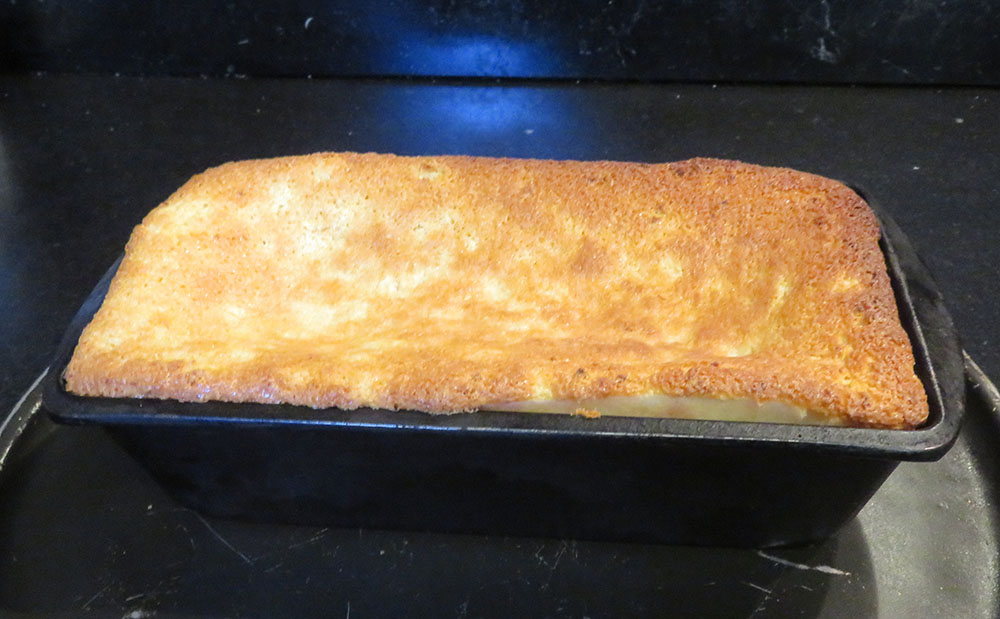
2 untreated lemons
3 large eggs
150g caster sugar
150g ground almonds 1 teaspoon baking powder.
Pre heat your oven to Gas 4, 175º C (165º C for a fan oven) 350º F.
Put the lemons in a small saucepan and cover completely with water.
Bring these up to the boil and then simmer gently, with a lid on, for about 90 minutes,topping up if needed, until they pierce easily with a knife.
Then take them out of the water and let them cool.
Cut the lemons in half and discard the pips and then tip all the rest of the lemon, flesh, skin and juice into a food processor and pulse it to a purée.
Beat up the eggs with the sugar in a large bowl (with an electric beater if possible) until they are pale and thick and then fold in first the pureed lemons then the ground almonds and the baking powder.
Line the base of a 1kg loaf tin with non stick paper and grease the sides.
Pour in the cake batter and bake at the pre-set temperature for one hour. (Test with a skewer after 45 minutes.)
• This cake remains very moist and it needs no icing.
• Also note it contains no flour so it is suitable for gluten free diets.
Martin Dwyer started cooking professionally over 40 years ago in the legendary “Snaffles Restaurant” in Dublin. After a time in a Relais Chateau in Anjou and in “The Wife of Bath” in Kent, he opened his own acclaimed restaurant, “Dwyers”, in Waterford in 1989. In 2004 he sold this and moved south to France where he and his wife Síle bought and restored an old presbytery in a village in the Languedoc. They now run Le Presbytère as a French style Chambre d’Hôte. Martin however is far too passionate about food to give up cooking so they now enjoy serving dinner to their customers on the terrace of Le Presbytère on warm summer evenings. Martin runs occasional cookery courses in Le Presbytère and Síle’s brother Colm does week long Nature Strolls discovering the Flora and Fauna of the Languedoc.
Le Presbytère can be seen at: www.lepresbytere.net;
email: martin@lepresbytere.net.
An Irish Chef in France
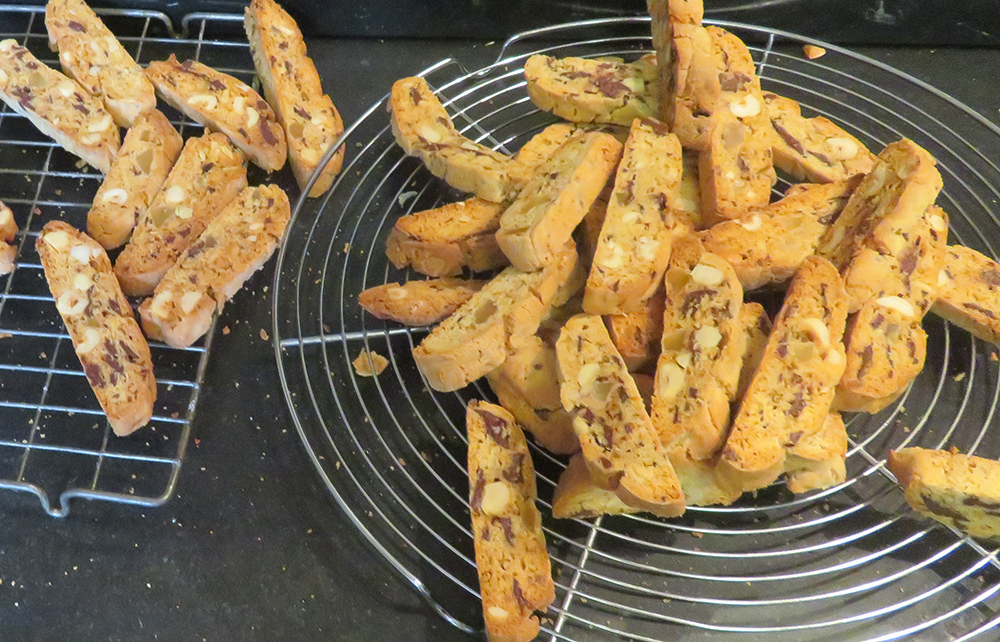
Martin and Sile Dwyer’s Chambre d’Hôte in the Languedoc will remain closed for the 2021 season. But delicious food is always a highlight in the Dwyer household and afternoon visitors may be lucky enough to be offered Martin’s own version of that crunchy classic, Biscotti, with their tea…
So life in France comes back together slowly, but our decision to remain closed until 2022 has given us a wonderful experience of freedom.
The trouble is that when one has spent most of one’s life catering for people’s dinner it is difficult to stop catering altogether - you come up against a sort of culinary cold turkey.
I have come up with a solution to this problem by resurrecting some of my simple confectionary skills which I can then offer my occasional afternoon callers.
Cakes, usually have a fairly limited shelf life so they need eating up fairly speedily and therefore if you want a little treat which will last well in a tin between callers ( without giving us the need to scoff them all) you cannot beat the Italian Biscotti.
Biscotti, (in French Bis Cuit) means twice cooked, but most of the French Petits Gateaux nowadays, like the ones we cook in Ireland, are only cooked once. The Italian version, still cooked twice, has the advantage of producing a biscuit which is very crisp and lasts a long time in a tin ( thus saving the hosts teeth and sugar levels.)
My version of the original Italian recipe calls for Dark Chocolate and Stem Ginger as well as the more usual Hazelnuts. I also prefer to chop the chocolate into rough chips myself, that way you can use much darker varieties than those kinds made into chips.( it is also nice to get a different sized piece in each biscuit)
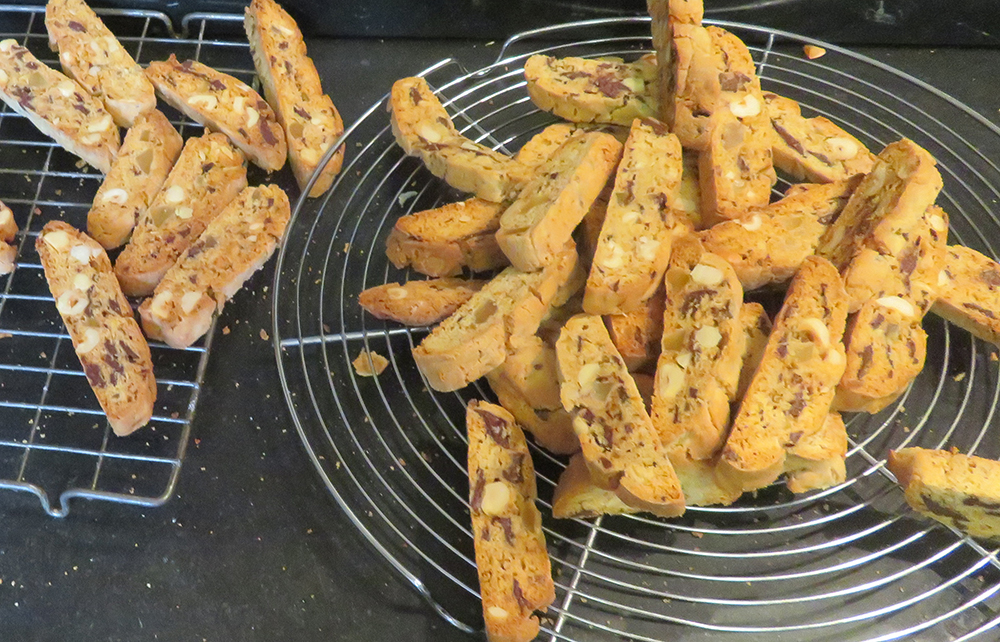
110g butter, at room temperature
180g soft light brown sugar
Grated zest of two oranges
2 eggs
320g plain flour
2 teaspoons baking powder
½ tsp salt
100g dark chocolate, chopped roughly into chips
100g peeled hazelnuts, halved
100g stem ginger in syrup, cubed
Set oven at 175 C.
Beat the butter and sugar and the orange zest together until light and creamy.
Add in the eggs, one at a time and beat well together.
Sieve the flour, the baking powder and the salt together and fold in thoroughly, and then fold in the chocolate chips, hazelnuts and the diced ginger.
Divide the mixture in two and, on a floured board, form two rolls roughly 30cm long and about 5cm diameter.
Put these onto a baking tray lined with baking paper and bake at the set temperature for 22 minutes.
Take out and leave to cool.
Cut these rolls into 1½ cm slices and again, put on baking paper on a tray (you will need a second lined tray now) and bake at the same temperature for 15 minutes - they should be golden brown.
Cool on a rack. They keep well in a tin - if you can persuade people not to steal them.
Martin Dwyer started cooking professionally over 40 years ago in the legendary “Snaffles Restaurant” in Dublin. After a time in a Relais Chateau in Anjou and in “The Wife of Bath” in Kent, he opened his own acclaimed restaurant, “Dwyers”, in Waterford in 1989. In 2004 he sold this and moved south to France where he and his wife Síle bought and restored an old presbytery in a village in the Languedoc. They now run Le Presbytère as a French style Chambre d’Hôte. Martin however is far too passionate about food to give up cooking so they now enjoy serving dinner to their customers on the terrace of Le Presbytère on warm summer evenings. Martin runs occasional cookery courses in Le Presbytère and Síle’s brother Colm does week long Nature Strolls discovering the Flora and Fauna of the Languedoc.
Le Presbytère can be seen at: www.lepresbytere.net;
email: martin@lepresbytere.net.
Show me all Article

